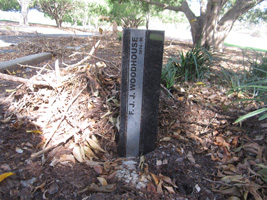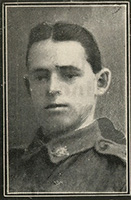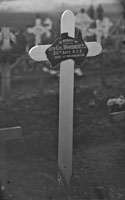Yeronga Memorial Park
Honour Avenue & The Cenotaph
There are two memorials in Yeronga Park (Brisbane, Australia) in honour of local soldiers who gave their lives during the Great War. They were constructed between 1917 and 1921 and funded by public subscription. One is "Honour Avenue" - a memorial to the soldiers from the Stephens Shire which began in 1917 as a row of 96 alternating weeping fig and flame trees that lined the newly-created avenue through the park. The second memorial is a concrete cenotaph, with the names of the 97 fallen inscribed on marble tablets. There is also a cenotaph garden and two sets of memorial gates. This webpage is a history of the memorials and contains the names and details of the men along with some photos of the memorial plaques and the trees.By Dr Richard Walding - Research Fellow, Griffith University, Brisbane, Australia.

THE CENOTAPH
|
The Cenotaph pavilion stands 13 m (44 ft) high. Inside there is a small central stone pillar (the "empty tomb") with a marble 'Entablature' on each side containing the names of 97 fallen soldiers, arranged alphabetically. There is a sandstone flaming urn on top of the column which replaced a small marble angel smashed in 1940. The original design had a eight-foot high porcelain crowned female angel with upswept wings and hands in a state of prayer standing on a globe. This was the design by Sgt Henry Hawyard Priest (9th Bn), winner of the design competition in 1918.
The cenotaph was constructed by A. Stonadge & Son at a price of £850 ($65000 in present terms). An amount of £650 had already been collected from the local community. The first attack by vandals on the cenotaph (the steps) was in November 1926. The construction and features of the Cenotaph appear later in this webpage.
THE FIRST REMEMBRANCE SERVICES
Prior to the establishment of the park and memorial the citizens of Stephens Shire (Yeronga, Annerley, South Brisbane) were keen to pay their respects to the soldiers who were fighting overseas in the Great War of 1914-1918. Some were their parents, some their relatives, some their friends but many more who were strangers keen to acknowledge their service.
The first Queenslander to register for enlistment into the Expeditionary Force was 47-year-old Lt Colonel Harry William Lee from Maryborough who became Officer Commanding 9th Battalion AIF. Second to enlist was Lt William John 'Jack' Rigby of Yeronga who registered on 15 August. This was just days after Australia had gone to war (5 August). In September thousands of such volunteers were off to Egypt for train for the war. But the strategy changed and they were sent to Gallipoli to begin the fight, arriving on 25 April 1915 - now famously known as Anzac Day.
As the casualty lists of British soldiers started appearing in the newspapers, private and public prayers for the men began. It came as a shock when the first Australian casualties were released - just after the landing at Gallipoli. The first Queenslanders included men from the Stephens Shire who were killed during the 9th Battalion's landing at Gallipoli on 25 April 1915: Lt William John 'Jack' Rigby, Pte George Cracey, and Pte James Fielding. The Brisbane Courier reported some deaths in the First Casualty List on 6th May. Their obituaries are presented later.
 |
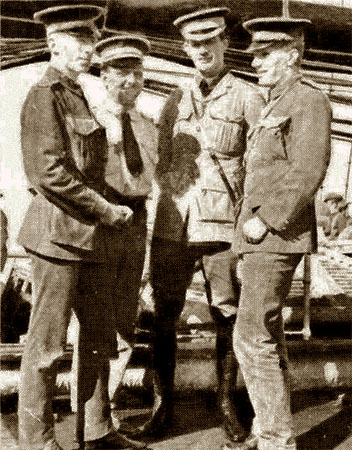 |
Brisbane Courier - 6 May 1915. Lt George Thomas did not die - it was a mistake (see below). |
Four officers from the 9th Battalion aboard a troopship heading for Gallipoli. The first three - Lt Rigby, Lt Haymen and Major Robertson died in the afternoon of the first day at Gallipoli. The fourth - Lt Jones was wounded. BC 7 May 1915. |
The first officer from the Stephens Shire (and one of the first Queenslanders) to die was Jack Rigby who was the first from Stephens Shire to enlist and the first to die. He was killed in action the day of the landing - 25 April 1915. His fellow officers - pictured above - were also killed or injured: Lt Frank Granville Haymen from Kangaroo Point, Brisbane (KIA, 25 April), Major Sydney Beresford Robertson, Ipswich (KIA, 25 April), Lt Lancelot Alban Jones, Sherwood, Brisbane (WIA 25 April 1915). Mistakes were often made. In the casualty list above Lt George Thomas was reported as being killed in action when in fact his shoulder was smashed by shrapnel while at 'The Cup' - a small gully near Owen's Post at Gallipoli - and he survived. His parents were dismayed to be told of his death but surprised to hear that he was just wounded. An extract from his letter to the army reads:

Over the next two years more local men enlisted, and more names of wounded, killed and missing appeared in the papers. Thus began services for the fallen and the construction of memorials in their honour. As soldiers returned home, local communities had public welcoming ceremonies in their honour. The first for Yeronga was held in the local hall on 11 July 1916. In November that same year another ceremony was held to "express appreciation to 53 soldiers who volunteered and to the 7 who returned home". Mrs Rigby, mother of the district's first casualty adorned the returned men with insignias. A further ceremony - prior to the construction of any official memorial - was held on 3 August 1917.
MAIN FEATURES OF THE PARK
There are five main elements to the Memorial Park:
1. The Cenotaph
2. Anzac Parade
3. Honour Avenue
4. The Cenotaph Gardens
5. The Memorial Gates
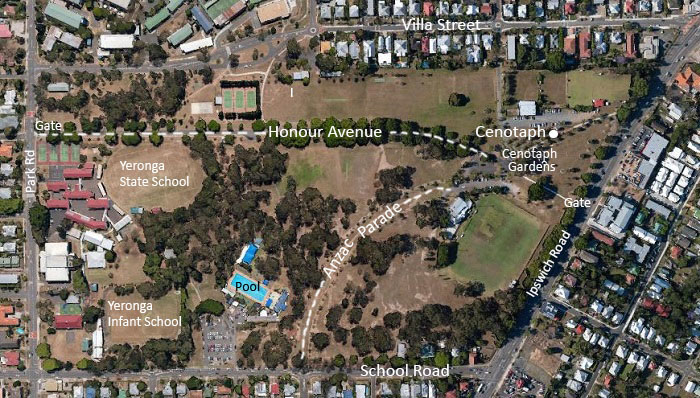 |
| Honour Avenue was intended as a straight memorial path from the Park Road gate to the Cenotaph. For some unknown reason, in the 1930s, a bend was put in the avenue to swing around to meet the Ipswich Road gate. Anzac Parade was a later addition. |
 |
| Aerial photo from 1943 of the park showing the US Army camp in the background. The final form of the Memorial Gardens can clearly be seen. They have since been removed and a small garden of duranta placed around the cenotaph. |
ANZAC PARADE
There is an arced pathway between the Ipswich Road gate and the old entrance in School Road (see above). It is known as Anzac Parade and is a narrow gravel path (although shown as being as wide as Honour Avenue on maps from 1918). Historian Rod Fisher said "There is no reason to doubt the second-generation anecdotal evidence of a School Rd resident in 1946 that a third set of memorial gates was intended in Park Road or that the original avenue of symbolic palms was seeded from Palestine and the Middle East by returned soldiers. This would have completed the park design nicely and may be supported by the newspaper letter of a visitor in early 1920 who deplored depredations upon the young palms, planted only several months before, by errant calves."
 |
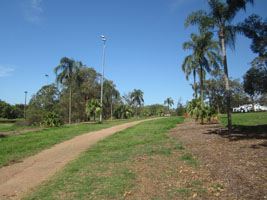 |
Looking down Anzac Avenue to School Road entrance. This area was used by the US Army in WW2. For years after the war white painted rings remained on the trees - evidence of the US Army's campsite. |
Looking back towards the Cenotaph. The gravel path is 2 m wide. |
HONOUR AVENUE
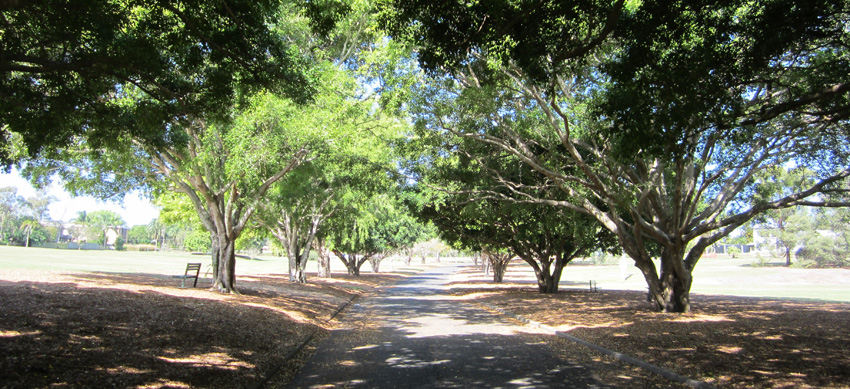 |
|---|
Looking up Honour Avenue towards the Cenotaph. This photograph was taken on 21 September 2011 before the new name plaques were installed. The tree (No. 90) on the left beside the seat commemorates David Ormiston and behind that trees for Harold Mitchell (#86) and Robert Hepworth (#82). On the right, the nearest tree (#89) is for for John Ormiston, and behind that trees for Walter Morgan (#85) and John Gilhespy (#81). |
The memorial at Yeronga consists of a avenue of trees and, later, a cenotaph. Whereas the cenotaph is a deeply imperial form, used throughout the British Empire to honour the war dead, the Avenue of Honour is indigenous. Its origin stems from a promise made at first to Victorian soldiers during recruiting drives in 1917 that their names would be memorialised in an Avenue of Honour. This then spread to other states. The biggest planting was in Ballarat, Victoria, where 4000 plaqued trees were planted in a 14 mile row by 1918. The use of native or exotic trees depended less on the planters' sense of appropriate symbolism than on what they thought would survive.
Yeronga's Honour Avenue was created in March 1917 when land was acquired from the Yeronga School Reserve for the purpose of a memorial avenues of trees to commemorate the sacrifice by soldiers of the local community (the Stevens Shire) in World War 1. A major proponent of the avenue was Mrs Julia Rigby - mother of fallen soldier Jack Rigby who died on the very first day of the Anzac landing at Gallipoli.
The choice of a site for a memorial was always going to be one that was prominent and accessible. The local park or a central intersection of roads were the most common locations in Australia. Ground outside public schools was the next most popular choice - and this is what we find at Yeronga. It is next to a school that a monument can perform one of its many duties: to instruct the young. As the chairman of one Anzac ceremony stated "[the memorial] is a constant reminder to the rising generation of the devotion and self-sacrifice of the brave lads of the district who heard their Country's call". As the Queensland Under-Secretary for Public Instruction remarked about the plaques attached to the trees "and the names thereon being mostly those soldiers who had passed through the school".
Planting of trees - alternating weeping fig (Ficus benjamina) and flame trees (Brachychiton acerifolus) - began on the 15th September 1917 (presided over by the chairman of Stephens Shire Council, Councillor Fred. Stimpson) with 41 trees planted and was followed by two more ceremonies: one on 20th July 1918 with a planting of 31 trees (attended by the Governor and former Irish soldier Major Sir Hamilton Goold-Adams) and finally on the 23rd August 1919 (500 people addressed by Home Secretary Mr John Huxham) when 21 trees were planted - making it a total of 93 trees. Later, two more trees were planted and plaques added. At the time metal name-plates inscribed with the names of the 95 soldiers were attached to small wooden white-painted posts. The plates were in the form of a shield and bore the inscription of the name and battalion of the soldier and the words "To Honour His Name". Vandalism began on the 28th October 1920 and a reward was offered by the Council for information leading to the conviction of the culprits. Over the years the name-plates were stolen and by 1960 none remained. For a full listing of the trees in numerical order please see my web page at Yeronga Memorial Park - Trees.
THE FIRST PLANTING - 15TH SEPTEMBER 1917
The Queenslander of 22 September 1917 reported that 'On Saturday afternoon at Yeronga Park, an impressive ceremony consisting of the planting of an avenue of trees was performed by the chairman of Stephens Shire Council, Councillor FA Stimpson. The idea was initiated by the Council, as an honour to the residents of the shire, who had paid the supreme sacrifice in the great world war.'
Many of the residents had to come to live in the area only recently and their sons had grown up and enlisted in towns far from Yeronga. Their deeds would be later listed in other memorials. Nevertheless, the parents were amongst the crowds attending these services. Deaths of their loved ones far away was particularly difficult to cope with. Unlike families whose menfolk had died in accidents at work and their bodies could be laid to rest nearby, the families of men killed in the Great War were deprived of the traditional mourning rituals of their culture. Their dead were overseas.
Not knowing the whereabouts of a soldier son, whether he was alive or dead, and if dead, where his body lay was particularly distressing. Though there is no way to judge anguish, the worst sufferers in Australia during and after the Great War may be those relatives who just did not know the answer to these questions.
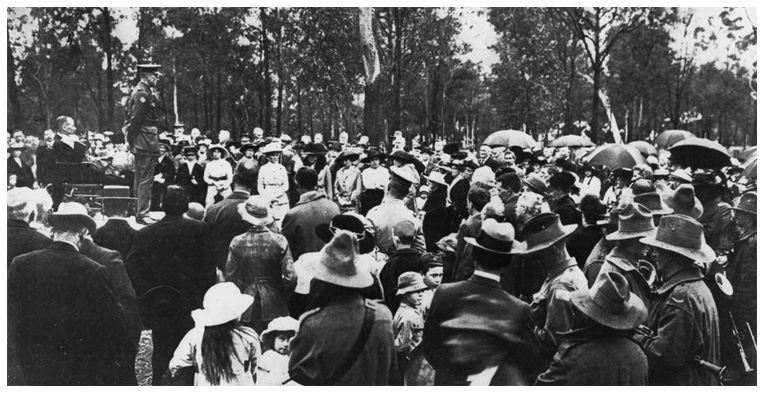 |
Lt Col George Arthur Ferguson addresses a gathering on Saturday the 15th September 1917 in Yeronga Park at the first planting of trees and mounting of inscribed plaques in memory of 41 fallen soldiers. |
Lt Col Ferguson was Director of the Queensland State Children's Department but also an officer in the 26th Battalion who rendered conspicuous service in Egypt, Gallipoli and France. He received severe gunshot wounds to his abdomen in the Battle of the Somme in France and almost didn't survive. He was later awarded the Distinguished Service Order (DSO) and Volunteer Officer's Decoration (VD) and was Mentioned in Despatches by General Douglas Haig for his gallantry. Ferguson, who represented the State Commandant, Brigadier-General Irving, spoke of the local men's gallantry.
Lieutenant-Colonel Ferguson said he considered it a great honour to be present at a function like this, having fought with most of these dead heroes, who before enlisting were nearly all in the training area now controlled by him. He had attended the funerals of some of them at the Front. "We should honour not only those men but the parents of the fallen, who have given their best in the cause of right and liberty."
After the speech the departed men's next of kin planted the 41 alternating weeping fig and flame trees both sides of Honour Avenue starting at the Park Road entrance. Lieutenant-Colonel Ferguson planted one in memory of James Fielding whose relatives were in England and Councillor Stimpson planted a tree in the memory of Robert Douglas whose relatives could not attend. This photo (above) was taken near the Park Road gates just prior to the first planting of trees. See Yeronga Memorial Park - Trees for the trees in order of planting.
THE SECOND PLANTING - 26 JULY 1918
From mid-1915 patriotic groups were formed to raise money for war loans and for comforts for the soldiers abroad, and to induce men to join the AIF. Fund-raising ceremonies were organised throughout Australia and on every anniversary of the Anzac landing ceremonies were held to celebrate these purposes. Sometimes it was just Honour Boards that were prepared and installed in buildings or public places, and sometimes monuments were set up just for the day and then taken down.
As time passed there was a conviction amongst the Australian public that permanent memorials were ritually needed, and that honour boards were not enough. What became apparent was that local people wanted to erect monuments to give public honour to local men. The first in Australia was unveiled at the inner suburb of Balmain, Sydney on 23 April 1916. However, the first soldier statue of the war was erected in front of the Post Office in central Newcastle and unveiled just three weeks before Anzac Day 1916. It was a gift from retired naval officer Commander Frank Gardner (the link takes you my webpage about him and the statue).
Memorials would have been more numerous had the Australian Government not prohibited appeals for any monument costing more than £25; that is, honour boards would have to do. The War Precautions Act was introduced in October 1916 to prevent so many memorials being erected. Its purpose seems to have been twofold: one was to prevent a drain on community resources in time of war, and the other was to prevent a negative effect on recruiting - at least until the war was won [Daily Telegraph, 6 July 1917].
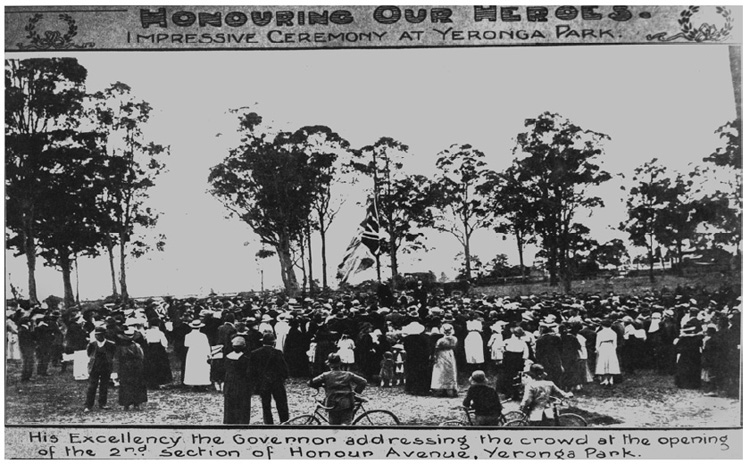 |
The second planting in Yeronga Park on Saturday 26 July 1918 was dedicated by the Governor General Major Sir Hamilton John Goold-Adams. Photo from The Queenslander 27 July 1918 (SLQ 69466.) |
Brisbane Courier, Monday 28 July 1918
HONOURING OUR HEROES. IMPRESSIVE CEREMONY AT YERONGA PARK. Another large gathering took place at Yeronga Park, in the Stephens shire, on Saturday, the occasion being the planting of a second lot of trees in Honour avenue in honour of the Stephens soldiers who have made the supreme sacrifice at the Front. He congratulated the Stephens shire on the good work it was doing. It was a charming idea that each tree should wave in the breeze and throw a shadow over the ground sanctified by the name of the man who had fallen. The gallantry shown by the sons of Australia on the battle front had won the admiration of the whole world. (Loud applause). |
Please see Yeronga Memorial Park - Trees for the listing of trees for the second planting.
THE THIRD PLANTING - 23RD AUGUST 1919
The Brisbane Courier of the Monday 25th August 1919 reported the ceremony thus:
The third and final tree planting ceremony under the direction of the Stephens Shire Council was held in Yeronga Park on Saturday afternoon, 500 persons being present, Councillor F. Stimpson, who presided, said that 581 men had enlisted from the district, and 93 had been killed. That afternoon they were planting 21 trees to the memory of those who had fallen. Previously they had planted 72 trees, making a total of 93 trees in all in the honour avenue. He also announced that a memorial was to be erected at the end of the avenue and he asked for public support. The shire clerk (Mr. Bale) read a list of the names of all who had fallen. Lieut. Colonel G. Hughes congratulated the shire on the way in which it was keeping green the memory of the lads who had fallen. Mr. Huxham (Home Secretary) also spoke, and hoped that the trees would remind them not only of the lads who had fallen, but also of their dependents. Others present included Mr. E. H. Macartney (Leader of the Opposition) and Mr. A. C. Elphinstone, M.L.A. The 1st District Military Band rendered selections during the afternoon. |
The crowds did grow bigger. The reason was simple. If we count as family a soldier's parents, children, brothers and sisters, aunts, uncles and cousins - then every second Australian family was bereaved by the war. It was no wonder the numbers grew. The news of a soldier's death was broken most often to mothers and fathers as more than 80% of the AIF soldiers who died were unmarried. But it was private grief they had to contend with. In public, grief was not as welcome.
Publicly, soldiers' deaths were deaths for the nation in defence of nothing less than civilization itself. In public one had to be stoic and there was a common belief that the private grief expressed at home should be repressed in public. This must have been so hard for mothers and wives attending these Anzac Day ceremonies (men had grown up with this repression in public). This was captured in a poignant introspective verse from a wife - Charlotte Rahilly - on the death of her husband Patrick - Headmaster at St John's School, Glenferrie, Victoria. He was killed at Poziers in July 1916:
I mourn for you in silence, but not with outward show. For those who mourn sincerely, mourn silently and low. |
 |
|---|
Looking down Honour Avenue to the main entrance in Park Road. Note the bend in the road. The trees down both sides are weeping figs, the flame trees having died many years ago. The trees you can see were not memorials to any particular soldier. The last tree with a plaque for a soldier is the sixth one down the right side (and that is tree No. 97 - Percy Ketteringham). The closest tree on the right would be number 117. |
As well as weeping figs and flame trees, additional plantings of more figs and some leopard trees (Ceasalpinea ferrea) have been made by the Parks Superintendent over the years to replace dead or vandalised trees. In 2007 the fig trees had to be pruned to ensure they survived drought conditions that were being experienced in Queensland at the time. The timing of the White Fig (Ficus virens) planting (see Doolan's tree #15) in the avenue is unknown. Avenues of Honour commemorating World War I were a memorial form unique to Australia and the Yeronga avenue is thought to be the second oldest memorial planting in Australia.
 |
 |
|---|---|
The design of the original plaques as shown on the Stephens RSL Sub-Branch honour board. |
The last post. By 2014, just two of the original posts remained of the 93 erected between 1917 and 1919. This one carried the plaque for Charles Ruff (Tree 69). Originally a metal plaque was mounted on every post but by 1960 most had been stolen, removed or damaged. If you know of one, then a donation to the RSL would be welcomed. |
 |
|---|
Weeping fig in Honour Avenue. This is Martin Nolan's tree (#88). The size of the fig can be judged by the table and chairs to the left. It has a height of about 13 m and a canopy of 30m diameter. |
 |
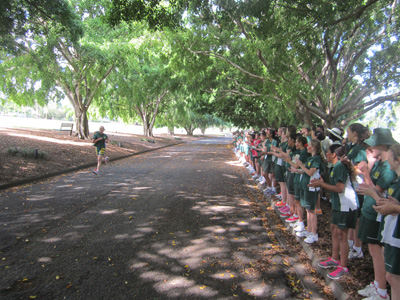 |
| These photos show the size of the trees better. They were taken during the annual Inter-house Cross Country held by Our Lady's Catholic College at Annerley. This weeping fig (#80) is dedicated to the memory of Pte John Henry Gnatz who died on 6 July 1918. | The Brisbane City Council maintains the grounds of the park and Honour Avenue in top condition. Here the students of Our Lady's College line Honour Avenue to cheer on their Cross Country runners (29 April 2014). |
THE CONSTRUCTION OF THE CENOTAPH
Various 'Patriotic Leagues' were set up after the war to raise funds for the building of war memorials in towns all over Australia. They had to decide on the nature of the memorial: either a monument or a utilitarian memorial of some sort (such as a hall, bridge, or park). They also had to decide the catchment from which to solicit donations and names of the dead. In some parts of Australia competing groups fought for donations and the right to build these monuments; often separated on religious line (Protestants vs Roman Catholics).
The Stephens Shire Council had to settle on the form of the memorial, so they looked at what was being done elsewhere. It seems that the idea of a utilitarian building had been ruled out early. However, among purely monumental forms no single type predominated. Already in sites around Australia there were memorials in cemeteries and park commemorating the South African (Boer) War so they were also used for the men of the AIF from the Great War: an arch, obelisk, column, pillar, cross, and statue. The newly popular word 'cenotaph' was used for monuments like the one at Whitehall in London - a tomb on a pylon. The word 'cenotaph' means literally 'empty tomb' and this seemed particularly apt as the local soldiers were buried far away in a foreign land. The broadening understanding of the actual form of a memorial meant that it was always going to represent an 'empty tomb'. The Council decided on a cenotaph with a pedastal inside. Within the pedastal was the empty 'surrogate' tomb of the soldiers and their names were to be inscribed on the sides. In 1918, they announced a competition for the design.
DESIGN OF THE CENOTAPH
In February 1919, the winner of the design competition was announced: Sgt Henry Hayward Priest, former soldier with the AIF. Henry Priest was born in London in 1871 and came to Australia in the 1880s and married Isabella Hunter in 1888. They lived in Palmerston St, just off Ipswich Road (Annerley) where they had three sons and a daughter. When Henry Priest joined the AIF in 1915, two of his sons - Walter and Arthur - joined up as well. Son Arthur died in Cairo from enteric fever in February 1916 at the age of 32. Henry returned to Australia in 1917 with heart disease preventing him from active service and was discharged upon arrival. Son Walter returned in 1919. Henry entered the memorial design competition run by the Stephens Shire Council in 1918 and was announced the winner in February 1919.
STEPHENS SHIRE
|
The apex of the roof supports a sphere 5 ft in diameter, with a map of Australia, upon which is alighted the 'Messenger of Light'. This figure is 11ft in height, and carries a flare in the right hand. The completed memorial will stand some 40 ft high, and will stand in orientation with the bearings of the line of Honor-avenue. The memorial will be surrounded by a ground plot design representing the zodiacal sign. The greater part of the work is to be constructed of reinforced concrete, giving durability and strength. |
Brisbane Courier 19 February 1919 |
|
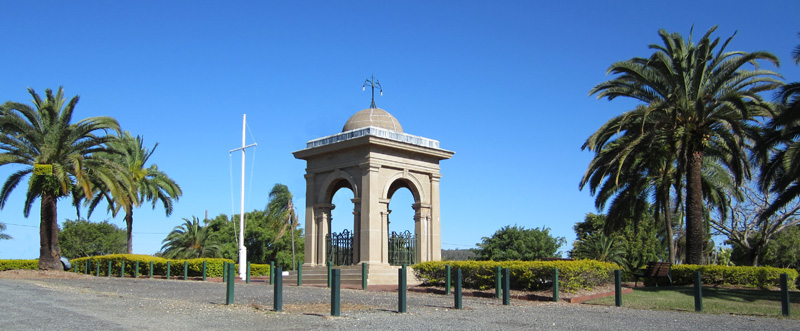 |
The Cenotaph was changed from its original design. There was evidently some problem with the plans, as tenders were called twice, in 1920 and the next year, and presented in their final form by a qualified architect George Trotter Jr. It was completed in July 1921. |
Opening of the Cenotaph
The Cenotaph was officially opened by Major General Julius Henry Bruche, General Officer Commanding, Field Troops Queensland, on Saturday 8th October 1921.
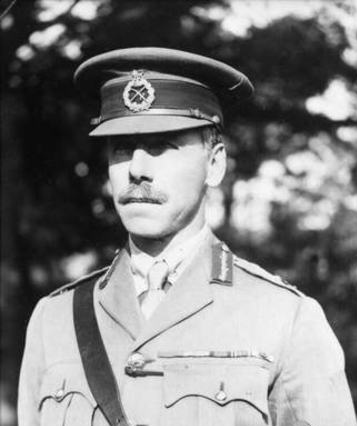 |
| Major-General J. H. Bruche (AWM) |
The Courier Mail wrote: Pretty, and commodious Yeronga Park, at the terminus of the Ipswich road tram-line was the scene of an impressive ceremony on Saturday when Major-General J. H. Bruche, G.O.C. Field Troops, Queensland, unveiled a handsome memorial, erected by residents of tho Stephens Shire in honour of the 96 men from that area (out of a total of 539 who enlisted) who laid down their lives In tho Great War. A large crowd of residents and visitors was enjoying tho bright sunshine when the general arrived. Ho was accompanied by Lieutenant-Colonel Gehrmann, and was received by a guard of houour from the 7th Infantry Brigade, commanded by Major Richardson and Lieutenants Clark and Smutter. Tho band of the 25th Infantry was also in attendance.
[CM Monday 10 October 1921, page 9].
Cenotaph Detail
The Cenotaph is a square pavilion rendered in concrete. The corner pilasters have ornamental capitals which carries a thin encircling entablature with a heavy projecting cornice above. Note the low parapet which conceals a gutter for the domed roof.
To see an enlarged view of each of these features of the Cenotaph, click on the image.
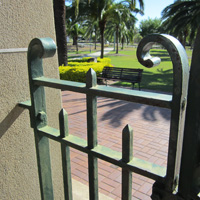 |
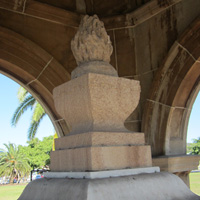 |
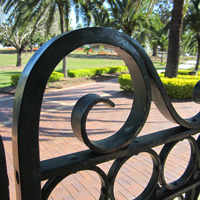 |
|---|---|---|
Fence detail |
Flaming Urn |
Gate detail |
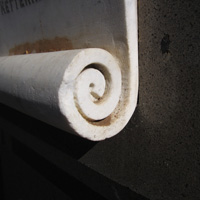 |
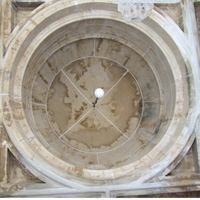 |
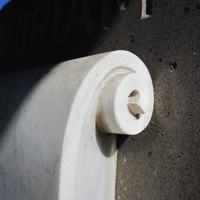 |
Memorial Scroll |
Ceiling |
Dedication Scroll |
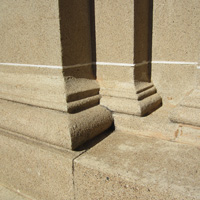 |
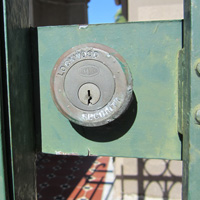 |
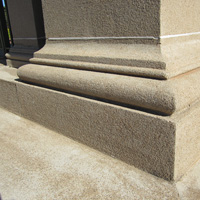 |
Arch pillar detail |
Gate Lock |
Corner pillar detail |
AN ARCHITECT'S VIEW OF THE DESIGN
I consulted two expert architects for a comment on Priest's design of the Cenotaph and asked what may have influenced the design by Sgt Henry Hayward Priest in 1918. This is their view:
 Professor John Macarthur, Dean and Head of the School of Architecture at the University of Queensland:
Professor John Macarthur, Dean and Head of the School of Architecture at the University of Queensland:
"The dominant form is what is called the Serlian or Palladian motif. This describes the arch resting on small columns, inside are recesses within larger columns supporting a flat lintel. This is high renaissance in its stylistic sources. A famous precedent would be Bramante's cortile at Saint Maria della Pace in Rome [see below]. Sgt Priest might more likely have seen it on the Queensland Parliament. It is certainly not based on an open Greek temple as some have suggested as they didn't have arches or domes."
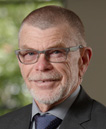 Professor John Stephens, School of Built Environment, Curtin University, Perth, Australia; specialist in War Commemoration, Architectural History, Architecture and Culture, Heritage and the Architecture of Commemoration.
Professor John Stephens, School of Built Environment, Curtin University, Perth, Australia; specialist in War Commemoration, Architectural History, Architecture and Culture, Heritage and the Architecture of Commemoration.
"The Yeronga Cenotaph is certainly classically inspired like most memorials built after the First World War - both Greek and Roman (and Egyptian if you count obelisks) were used - often eclectically. Classical architecture and art was used as it aligned the warrior dead with the nobility and deeds of the Greeks Romans. The ancientness of classical forms also aligned the fallen with ancient warriors. The language of classicism was generally understood by the public at large - modernism was not understood and did not have the symbolic power to carry the message of Anzac to future generations. The form of the cenotaph could probably be described as a rotunda or pavilion. Not unique in Australia but a little unusual - it would have been very expensive for a small community. Its a fine piece of work. Its very similar in style and intent to to the Narrogin War Memorial in Western Australia which is a rectangular pavilion with a small pillar inside with the names of the dead."
 |
 |
 |
Bramante's cortile at Saint Maria della Pace in Rome. |
The rectangular pavilion of Narrogin War Memorial in Western Australia. (J. Stephens) |
Inside is the small pillar with the names of the dead. (J. Stephens) |
THE ORIGINAL DRAWINGS
 |
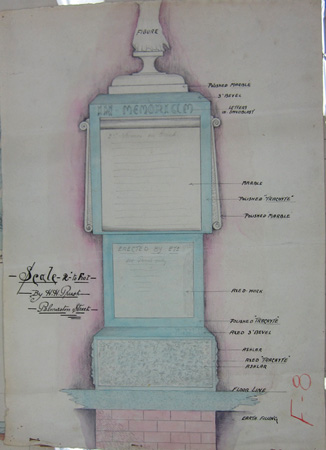 |
Original drawing from the Brisbane City Council archives. Click image to enlarge. |
Original drawing of the stone pillar. Click to enlarge. |
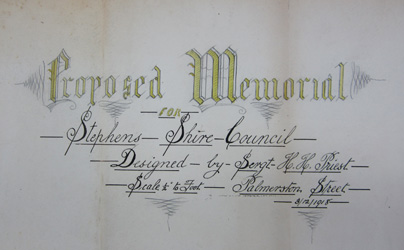 |
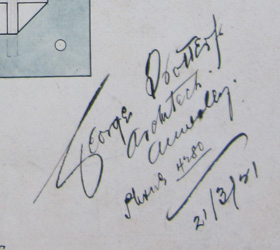 |
Details of the drawing by Sgt Henry Hawyard Priest. Detailed drawings were completed by the more qualified architect George Trotter Jr. |
George Trotter Jr's signature on the final plans. He, along with Cr Stimson and A. Stonage, signed the plans in March 1921 indicating agreement. |
 |
 |
Each corner of the cenotaph was to have an Acanthus Leaf. |
Detail of the base of the column. The final building was slightly more elaborate than Priest had planned. |
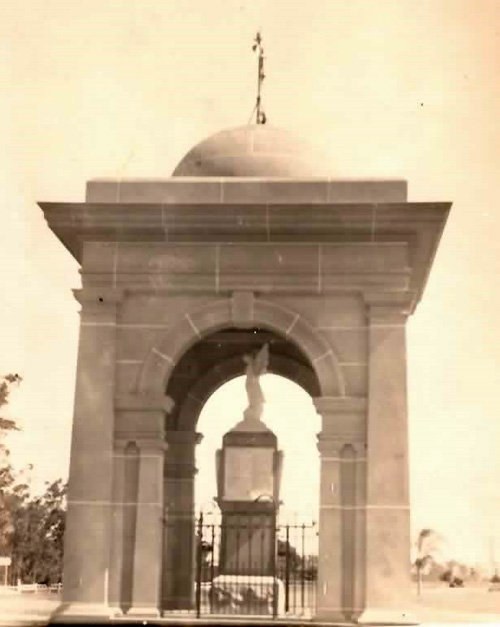 |
A postcard from the early 1930s showing the angel inside the cenotaph. (Photo courtesy of Alan McNaughton, Queensland Card Collectors Society) |
MEMORIAL ENTABLATURES IN THE CENOTAPH
(Click on the image to see an enlargement)
 |
|---|
Memorial TabletThis is the tablet mounted on the polished trachyte pillar on a sandstone plinth inside the cenotaph facing the gate. In 1922, when it was made, it contained the names of the Chairman of the Stephens Shire Council (Cr Frederick Stimpson), eight councillors, Shire Clerk, the builder and the architect as envisaged in Priest's original design. This caused a huge controversy in the local community who saw the councillors' names as self-serving and an insult to "our boys" who died in war. The debate raged at public meetings and in the Brisbane Courier newspaper from May to November 1922. Eventually the council acceded to the unsubtle comment of the Governor (who told the audience at the opening of the gates that the councillors' services were not comparable to those of the men who fought" and hoped they would be removed). This was done hence the conspicuously blank unmatching piece of marble on the bottom half of the tablet. The story of the sorry saga is below. |
Sgt William Percival Sparkes and the fuss about the Memorial Tablet
The fight to have one soldier's name added to the Memorial Tablet was orchestrated by the mother and sister of Sgt William Percival Sparkes - a Gallipoli veteran and original Anzac who returned incapacitated to Brisbane towards war's end and died of a war-related heart condition a few years later. The Stephens Shire Council rejected his name for inclusion on the Memorial Tablet as he did not "die overseas during the war", but neither did the other dozen people whose names were on the tablet - the Chairman and members of the Stephens Council, the Shire Clerk, the builder and the architect.
Thus began the campaign by Mrs Sparkes and her daughter Eunice Lelia Jewell (née Sparkes) to have these names removed. Cr Stimpson publicly railed against the pressure of the two women but when the Governor dropped a less-than-subtle hint, Stimpson - unrepentantly - acceeded. "As a loyal subject I will do what the representative of the King requires". The marble plaque was removed in the first week of November 1922 (see photo above). Click here to read the text of the Governor's comment.
William Percival Jackson Sparkes was the 32 year old advertising manager for the Allan & Stark department store who enlisted as a gunner in the 3rd Bde Field Artillery the 20th August 1914 at the start of the war. At the time he was well known in musical, sporting and horticultural circles from his home "Glen View" in Annerley Road, South Brisbane (Shire of Stephens). Within months of enlisting (No. 1654) he arrived in Egypt to serve with the Mediterranean Expeditionary Force (MEF) and was soon promoted to bombardier after receiving the highest marks for his accuracy in the Egyptian desert. Sparkes landed at Gallipoli with the first Anzacs in April 1915 and was soon Mentioned in Despatches for acts of gallantry under fire and working to exhaustion in the trenches. On 6th May 1915 received gunshot wounds to his back, foot and leg and was invalided out to Alexandria for six weeks and then returned to Gallipoli as a Corporal and then promoted to Quartermaster-Sergeant of the 41st Battery.
After Gallipoli was evacuated he served several months on the Suez Canal and then took to the field in France. Here he was recommended for a commission (to become an officer) and was sent in December 1916 to the Horse Artillery School in St John's Wood, London. His health however had been affected by the strain of his campaigns and on 15th June 1917 he was diagnosed with a heart murmur "due to war service" (his doctor wrote on his record) and was certified permanently unfit for service. Sgt Sparkes was invalided home in August 1917 and discharged in Australia on 17th October 1917. He rejoined his old firm of Allan & Stark in the city.
In 1918 he stood for the Buranda seat in the State Legislative Assembly but was slurred by his opponent - the sitting member John Saunders Huxham - who accused Sparkes of being a "supposed soldier" not a real one. This, really, is the one blemish on Huxham's otherwise charitable and noble character. After losing to Huxham, Sparkes took up farming at Kuraby where his lived with his widowed mother Mrs Mary Ann Sparkes. His health did not improve and he died on 15th December 1921 from an aortic aneurism which, in the opinion of the doctors at the Rosemount Repatriation General Hospital, "was considered as largely attributable to war service conditions". His personal war diaries and papers were purchased by the State Library of New South Wales in 1919 and they are now available to the public.
REPAIRS TO THE CENOTAPH
 |
The Brisbane City Council refurbished the cenotaph prior to Anzac Day 2015. (Jim Hawker, March 1915) |
THE CENOTAPH GARDENS
 |
This is an early plan which predates the Cenotaph - so is probably 1917 or so. Speculation has it that it was drawn by Harry Moore, the superintendent of Brisbane's parks (1913-40) [BCC Archives] |
The original design of the Cenotaph by Sgt Priest called for a surrounding ring of garden beds, with inspiring words carved into a zodiacal design in the paving (see below). The Cenotaph was to be mounted in a ring of blue couch grass 20 foot in diameter. Surrounding this was another concentric ring 20 foot wide consisting of white gravel. Surrounding this was another 20 foot wide ring in which seven triangles of concrete paving were to be evenly spaced. They were to display the words: Power, Riches, Wisdom, Strength, Honor, Glory and Blessing. In between the triangles were flower beds of white and red azaleas, erica, bouvardia, rhynchostylus, roses, and jasmin. On the outside of this, and sprawling into the rest of the park, were beds of lagerstroemia, fracisea (?), hydrangeas and spirea in a lawn of blue couch.
 |
A section of the Memorial Gardens plan. The shape of the triangular zodiacal plan is clear, and you can see the end of Honour Avenue to the right. The cross-path on the right running top to bottom takes you to other areas of the Park. These plans are available for public viewing at the Brisbane City Council archives at Moorooka, Brisbane. |
It is not certain who drew these plans or when they were made. The second plan (shown above) incorporates the Cenotaph and is probably a later design (1917-1919). They are both written in the same hand. Historian Rod Fisher speculates that it might have been Harry Moore, the enterprising superintendent of Brisbane's parks (1913-40), or Ernest W Bick, curator of the Botanic Gardens (1917-40), or "some other exponent such as Alexander Jolly who was becoming known for his innovative landscaping in Ithaca Shire (c1917-25)". [Rod Fisher, 2010, Yeronga Memorial Park, p9].
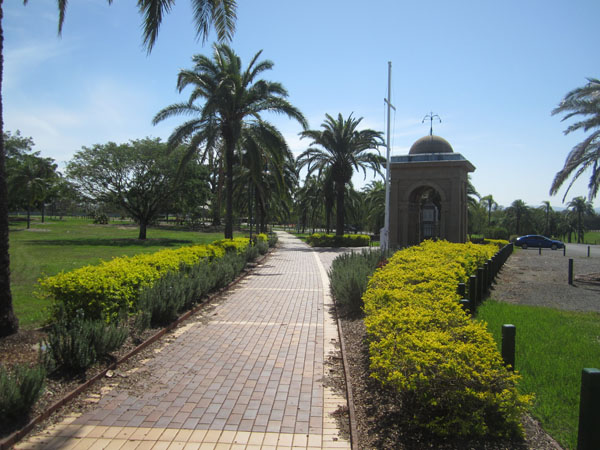 |
The path through the Cenotaph Gardens. They are no longer called the "Memorial Gardens" as no soldiers were commemorated here. A few name plaques were added in 1993 but have largely been removed. Note the date palms (Phoenix dactylifera) that line the path. |
|
The designer envisiged Honour Avenue coming straight up from the Park Road gates (as it does now) and heading directly to the Cenotaph (which it doesn't do). For the last section into the Memorial Gardens, a 20 foot wide gravel path was to join Honour Avenue to the Cenotaph. As well, off to the other side would be a 10 foot wide white gravel path leading off to Ipswich Road. There was also to be another path leading off towards School Road. Ultimately, none of the gardens were built to this design. A bend was put in Honour Avenue to make it head towards the School Road/Ipswich Road corner but stopping short. A plantation of trees was envisaged to fill the area between the bent road and Ipswich Road gates. It is not know why a bend was put in the road.
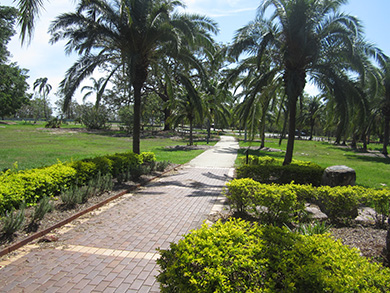 |
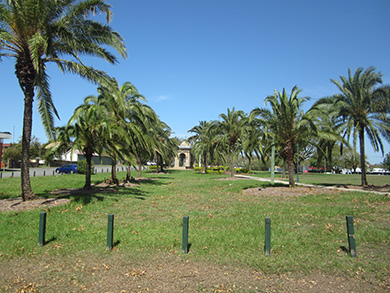 |
The path from the Cenotaph Gardens to Ipswich Road gate (not the main one). Date palms (Phoenix dactylifera) have been used to line the path. |
This is the original extension of Honour Avenue to the Cenotaph. Note the date palms (Phoenix dactylifera) either side of the proposed road. |
United States Army Units in Yeronga Park WWII
In recognition of the use of Yeronga Park by the Armed Forces of the United States of America during the Second World War a large sandstone boulder was set into a paved commemorative precinct, and displays a large dedication plaque. A smaller donation plaque was inserted into the front of the stone. The plaques and memorial were installed by the American Legion.
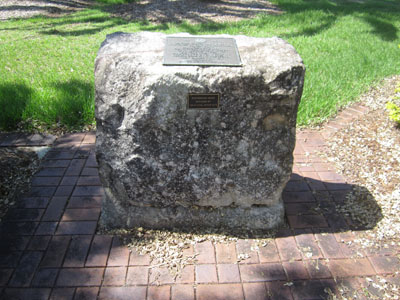 |
 |
Sandstone cairn and US Army plaque next to the Cenotaph |
The park was allocated to the US Army during WW2. It was known as Camp Yeronga |
 |
 |
Retired Major Bill Bentson of the American Legion Douglas MacAuthur Post AU03 in 1996 addressing guests in Yeronga Memorial Park at the commemoration of US troops being stationed there in WWII. Bill was stationed in Brisbane from July 1942. In 1943 he spent 3 months at Camp Columbia, Wacol, Officers' Training School before being sent to Port Moresby. Bill was aide-de-camp to General MacArthur. To his right is Commander (Ret.) Andy Anderson. |
American Legion Adjutant Chris Boen at unveiling of the foundation stone and plaque in 1996 commemorating the US army presence in Yeronga Memorial Park. He is presenting a certificate of appreciation to Claire Crowther who was instrumental in having the memorial installed. Between them is Legionnaire Gus Eddie. |
 |
| U. S. servicemen in front of their barracks at Camp Yeronga. These small huts were constructed of pressed sheeting material (fibro), with smooth wooden floors, and slept three men to a hut. On the right is Ken Osterberg - Detachment 3 of the 832nd Signal Service Company U. S. Army Services of Supply. |
Dutch Women's Army Corps stationed in Yeronga Park
The Women’s Army Corps (WAC) of the Royal Netherlands East Indies Army (KNIL) joined the Americans at Camp Yeronga in September 1944.
 |
| Dutch WACs being welcomed by American WACs at Camp Yeronga on 26 September 1944 |
 |
| US and Dutch Service Women at Yeronga Park 1944 |
Stephens RSL All Conflicts Memorial Wall
A Memorial wall in memory of the soldiers from the Stephens Shire who served their country was unveiled on 31 July 2021. The "All Conflicts" Memorial Wall, is a symbol of the journey of the two million Australian men and women who wear and have worn our uniform, their selfless commitment, and the impact that its had upon them and their families. [Lt Col Ross Thomas - from his address, 31 July 2021].
To read more please go to Stephens RSL All Conflicts Memorial Wall webpage
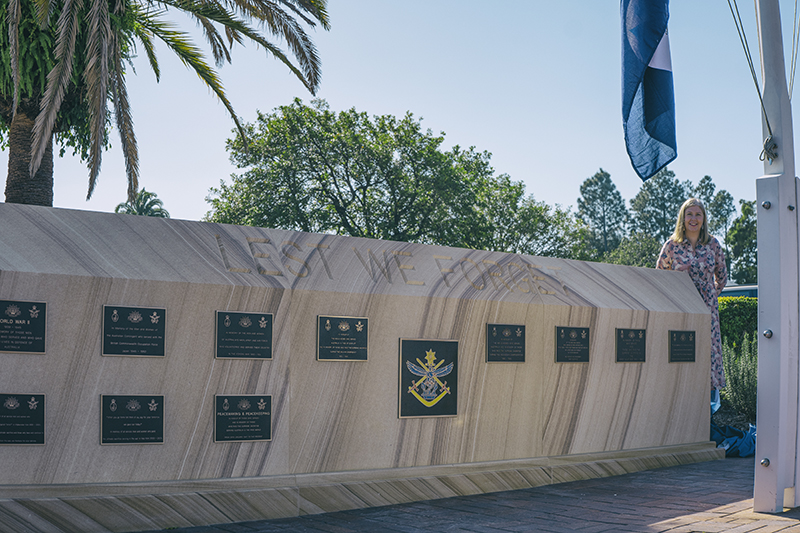 |
| Councillor Nicole Johnston at the unveiling of the Memorial Wall 31 July 2021. |
FREDERICK STREET ENTRANCE
There is a short road joining Villa Street to Honour Avenue up near the Cenotaph. It is lined with Date Palms and Queen Palms. Some plaques to soldiers were installed under these trees in 1993 but they were never in the original design.
 |
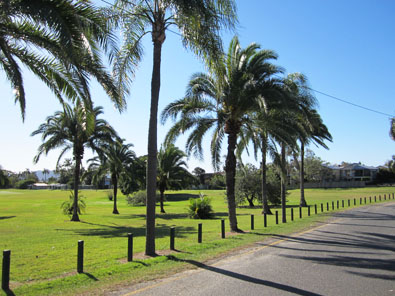 |
Palms lining Frederick Street with the Rugby League Football Club in the background. The middle tree is a Queen Palm (Sygarus romanzoffina) and the other two are Date Palms. There are plaques at the base of these trees. Just near the football club is a stand of Tallowood. |
The palms trees of Frederick Street looking towards Villa Street entrance. As well as the Queen Palm and Date Palms lining the street, you can see some more date palms behind them interspersed with some low Chinese Fan Palms (Livistonia chinesis). |
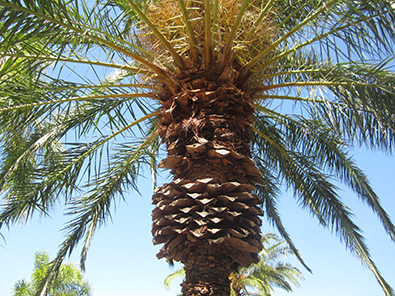 |
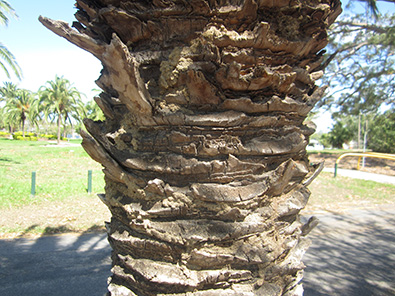 |
Queen Palm (Sygarus romanzoffina) in Frederick Street. |
Trunk of the Queen Palm in Frederick Street. |
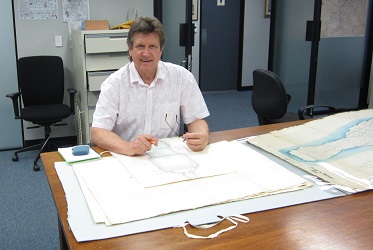 |
The author at the Brisbane City Council archives looking over the plans of the Cenotaph (2012). |
YERONGA MEMORIAL PARK GATES
PARK ROAD ENTRANCE
 |
The new Park Road gates at the entrance to Honour Avenue ready for the opening by the Governor Sir Matthew Nathan on Saturday 14th May 1921. The white posts that carried the plaques for each soldier can be seen on the left hand side. (photo T. Dunn). My thanks to John Huth for securing permission from the University of Queensland Fryer Library to reproduce this print. |
 |
|---|
Honour Avenue - Park Road Gates. The weeping fig to the left is the No. 2 tree and was planted in memory of Leslie Arthur Kenyon duirng the first planting on 15 September 1917. It still stands after nearlly a century. |
In the original plans for the park in 1918, there was no mention of gates to mark the formal entrances to Honour Avenue. A resident of the area - Thomas F. Overden - was head carpenter for Burke's Shipping Line at South Brisbane when their premises were being renovated. There were two sets of gates surplus to their needs and these were donated to the Council as imposing entrances to the park. Gates have often been used in memorials such as this. They are a powerful symbol which stand for dead soldiers' passage to whatever lies beyond.
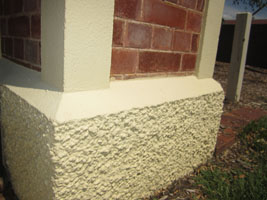 |
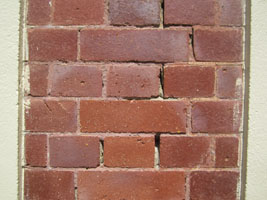 |
The base of the pier. In the Manly War Memorial rough hewn granite looks like this and was used to symbolise the daunting cliffs of Gallipoli. Note the smooth rendered cornices. |
Smooth brick piers. Bricks used in the early 1900s were usually red in colour for the front and brown coloured "common" brick for the rear. Soft lime mortar was common, hence the need for repointing. |
 |
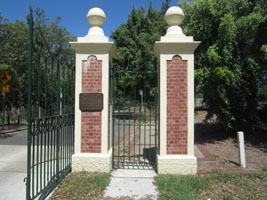 |
The Sovereign's Orb (globus crucifer) dates from 1661 and symbolises kingly Power and Justice. Note the projecting cornices. |
The gates' architect John Cohen Richards lived nearby at Waterton Street, Annerley. |
The gates comprise four brick piers with stone trimmings and wrought-iron gates designed by architect John Cohen Richards in September 1920. The Park Road gates (pictured above) were opened by the Governor Sir Matthew Nathan on Saturday 14th May 1921. The Ipswich Road gates were opened in October that year. The gates received little maintenance over the next 90 years but in late 2010 the Brisbane City Council spent $85000 to restore the gates, with a heritage restoration specialist engaged to help undertake the project. The restoration work involved repairing broken welds, straightening bent sections, repairing brickwork, restoring plaques, and applying fresh paint. The weeping fig on the left originally commemorated the service and sacrifice of Leslie Kenyon - but the plaque (like all the plaques) has been stolen or lost (but since replaced).
Brisbane City Council Information Board
The Plaques
On the gates of the memorial park are tributes to World War 2 soldiers. The general public after WW2 was wary of purely commemorative memorials (as a Gallup poll found at the time). The post war period saw a triumph of utility. Local communities still wanted to remember their fallen but in ways that served the living: memorial libraries, swimming pools, halls, hospitals and parks instead of cenotaphs or obelisks. In Queensland - like the rest of Australia - it was not as common to erect memorials to WW2 fallen but rather to add their names to the WW1 memorials offered by the previous generation. This was an expedient solution that also avoided adding to the post-war housing shortage where precious bricks and mortar could be used on something (people said) was more useful. At Yeronga the solution was the bronze plaque.
 |
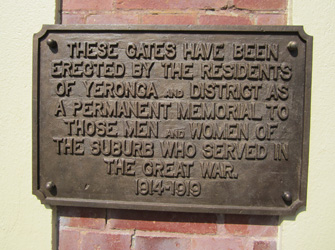 |
|---|---|
The left plaque commemorates the service of men and women in later wars. It was added by the RSL in 1979. |
The right plaque on the Park Road gates commemorates not only the men who served in World War 1 but also the women. For example, the Rigby family of Yeronga saw the service of their three sons and daughter in the war (see below). |
Women of Yeronga in the Great War
It was rather unusual for women to be commemorated for their efforts in the Great War. Admittedly, these plaques on the main gates and Ipswich Road gates were installed in the 1970s but nevertheless do recognise the contribution of women in what was fought as essentially a man's war. One to be commemorated is Julia Lyllis Rigby, eldest sister of Jack Rigby - one of the first Queenslanders to die. She became a staff nurse and departed Yeronga for military service in India on the 2nd June 1917. She was farewelled by a party of 80 people at the Yeronga Hall and headed for the Colaba War Hospital in Bombay. Here she tended to the injured from the Mesopotamian conflict - mainly around Basra (now southern Iraq) where the British and Turkish soldiers were fighting. She reluctantly resigned in July 1918 when she became married.
Besides Julia Lyllis Rigby, two other local women who served their country in the Great War need recognising. Madeline and Marjorie Wilson were sisters who attended Yeronga State School and their names are on the school's Honour Board for service as nurses in the war. Nurse Madeline Alice Kendall Wilson joined the Australian Army Nursing Service (AANS) in November 1914 at the age of 26. She had finished three years of nurse training at the (Royal) Brisbane Hospital and had worked for the next eight months as a general medicala nd surgical nurse. She was sent to the Middle East where she boarded the hospital ship Neuralia on 8th July 1915 bound for Gallipoli. On the way the Neuralia picked up surviving troops (21st Bn) from the Southland torpedoed by a German submarine on 2nd September.
Madeline served aboard the hospital ship for six months transferring the wounded, sick and dead to Alexandria before she herself became sick. When recovered, she worked as a nurse in Cairo before returning to Australia. Her sister Marjorie Jane Gilmore Wilson joined the AANS on 1 May 1917 at the age of 26. She was sent to the Croydon War Hospital in London and in January 1918 joined the 1st Australian General Hospital in France. After three months service she too became sick and was sent back to England. When recovered she went back to France until June 1919 and then to Australia six months later. It is also of interest that their brother Frederic David Gilmore Wilson joined the 15th Bn AIF in July 1915 and received a severe gunshot wound in France in August 1916 requiring a long convalescence. He returned to Australia to be discharged in July 1917.
IPSWICH ROAD GATES
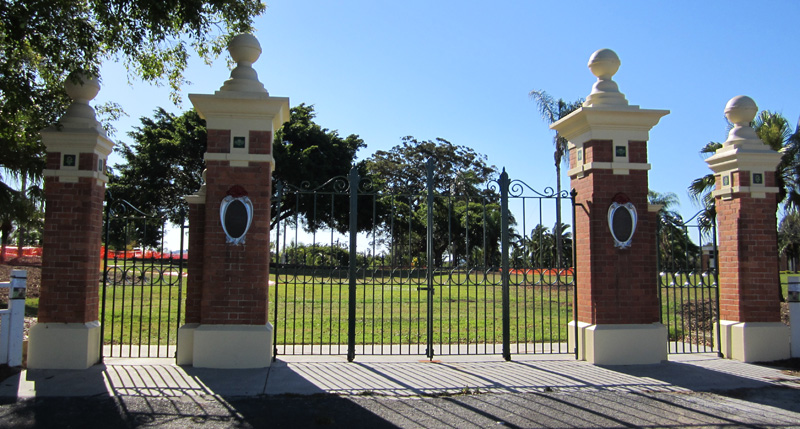 |
|---|
Honour Avenue - Ipswich Road Gates These gates at the middle of the Ipswich Road frontage displayed two bronze tablets (see below). The gates were opened on 8th October 1920 by Major General S H Bruche. These gates are more ornate than the Park Road gates. Note that the piers stand on a smooth rendered plinth, unlike the Park Road plinths which are rough. In a preliminary ceremony Major General Bruce unveiled the Cenotaph. |
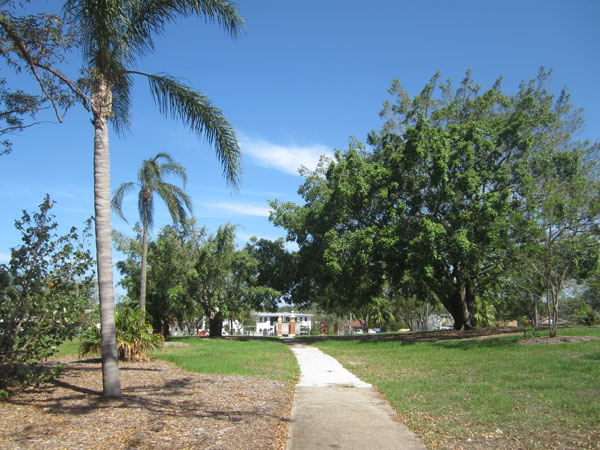 |
Looking up towards the Ipswich Road Gates. No plaques were mounted beside these trees - they were planted for shade and decoration, not commemoration. Note the alternating palms along the path. The closest palm is a queen palm (Syagrus romanzoffina) and these alternate with chinese fan palms (Livistonia chinesis). My thanks to Mike Gray from the Palm and Cycad Societies of Australia for help with identifying these palms. |
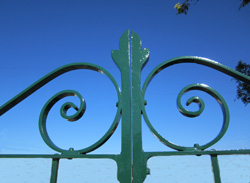 |
 |
 |
|---|---|---|
Beautiful wrought iron scroll. |
The pillars are slightly different to the Park Road gates in that they have decorative tiles on each side. |
The decorative tile on the posts. |
 |
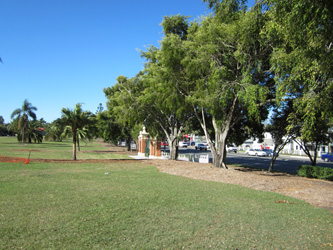 |
 |
|---|---|---|
The left-most reads that the gates were "dedicated to the women of Stephens Shire" - an unusual public recognition of women's role in World War One. |
There are 18 weeping figs in a row along Ipswich Road but there is no evidence that these trees were commemorative and no plaques have been installed near any of them. |
The right-most tablet tells us that "These gates were erected by the women of the Stephens Shire in honour of the men who fought for them". |
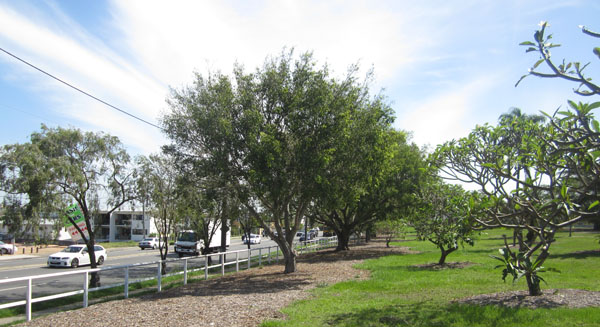 |
Another photo of the trees along Ipswich Road. No plaques are present or were ever present. The trees were purely for decoration. |
 |
|---|
A photo of the Ipswich Road gates taken from inside the park. |
OPENING OF THE IPSWICH ROAD GATES 1921
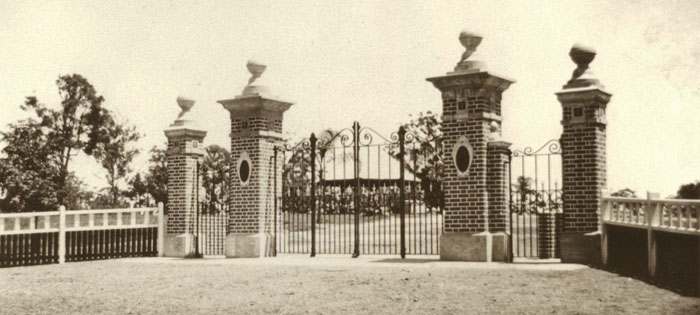 |
The Ipswich Road gates - ready for the official opening in 1921. Note the band pavilion in the background. (SLQ) |
 |
The gates were declared open by Major-General J. H. Bruche on Saturday 8th October 1921. The Stephens Shire war memorial, which was unveiled in the park at the same time. Source The Brisbane Courier, Saturday 15 October 1921. (T. Dunn) |
The Stephens RSL Sub-branch intended to rededicate the gates on Saturday 8th October 2011 - exactly 90 years to the day after the original opening of the gates. This co-incided with the regular monthly meeting of the Stephens RSL. However, the weather was so bad it was postponed until Remembrance Day a month later. It seems the weather was bad at the opening (photo above) and 90 years later. The sub-branch's first-known early morning Anzac service took place at the park gates on 25 April 1928.
 |
 |
Rev Roy Wakeling rededicating the Yeronga Memorial Park gates on Remembrance Day 2011. Beside him at the Cenotaph is Stephens RSL President John Strachan. Photo: Ken Smith. |
A photo of the gates taken on Remembrance Day (11 November) 2011 from the same position as tken 90 years earlier for the opening. Photo: Ken Smith. |
STONE WALL ALONG THE IPSWICH ROAD BOUNDARY
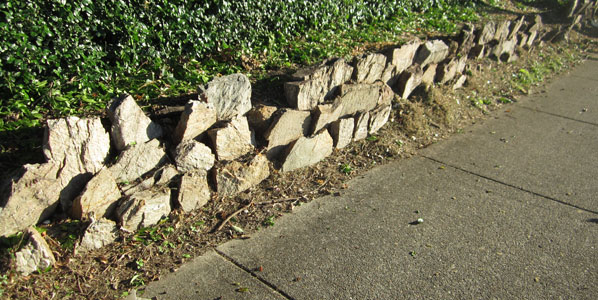 |
Along the Ipswich Road boundary of the park (near the gates) is a stone retaining wall built by ex-servicemen from WW1 during the 1930's depression. Servicemen often found it hard to get jobs as they suffered from war-related disabilities both physical and mental. |
HONOUR BOARDS - STEPHENS RSL
FARAWAY GRIEF
From the moment people first received information of the death of their loved ones in war overseas, Australians sought knowledge of what exactly happened and what became of them. They needed that knowledge to give substance to the images they had in their minds about their soldier's last moments. They needed to know - was it painless, and did they get blessings of their faith. Mothers wished they had been there to hold their son in their arms to palliate their suffering.
It was important that if they were to come to terms with the death they needed detail. There was a therapeutic value knowing that the death was honourable. Every grain of news of a beloved son was a comfort. It became important to know if prayers were recited over that sacred spot where they died. Even if a body was not found it was a comfort to parents and wives to know that a virtual site for their grief had been sanctified by their comrades to whom the care of the dead had been assigned. Even if there was no grave then the position of where they were last seen was important.
In the obituaries below there is enough detail to show that fellow soldiers did look after their mates; that their loved ones were given religious rites, and that their deaths were honourable. I have included a letter from Queenslander Corporal Denis Rowden Ward - 9th Battalion - who wrote to a friend while he was convalescing in hospital from a wound received at Gallipoli. Letters such as these gave comfort to the families of dead soldiers. This letter had information that was vital to two families - information about the burial of a Lance Corporal Philip de Quetteville Robin 638, 10th Battalion, who was killed at Gallipoli on 28 April 1915.
On the Thursday 20 May 100 men were sent up to Quinn's Post to act as supports and fill up gaps in the firing line. We were told we should be relieved by tea time, and so left our packs with the men staying behind. Capt. Dougall took the party up, and I went with Lieut. Ross to the left, at Quinn's Post, also with about 15 men. On the side of the communication trench was a body which no one had had time to bury, so 'Dad' Hume [ Sgt James Edward Hume, 592] and I took the dead soldier down tho gully a little way and buried him. It turned out to Lance-corporal Robin, of the good old 10th Battalion, who was married at Mena, you will remember. I took his disc, pay book, and letters, and handed them later to Major Brand. It turned out afterwards that Hume had noticed his wristlet watch, but did not say anything at the time and we buried it with Robins. He had been shot through the skull, and death must have been instantaneous. |
His features were too disfigured for him to be identified so he couldn't be buried in a named grave. Nevertheless, he was buried in a religious service on sanctified ground at the Lone Pine Memorial, Gallipoli. His belongings were returned to his mother Mrs Mary Robin in South Australia and a small sum of money to his new wife Nellie Irene Robin (née Honeywell) in Kensington, London (they were married in late January 1915 at Mena, the Anzac Camp about 45km south west of Alexandria in Egypt, and Nellie gave birth to a son Robin in November in Kensington but she died in birth).
Philip Robin and his 'old tent mate' Private Arthur Blackburn distinguished themselves on the first day of the landing by penetrating further inland and coming closer to the objective of the Gallipoli expedition than any other Australian or Allied troops throughout the entire campaign. The pair were with the battalion scouts and after transferring from the Prince of Wales were in the prow of one of the early boats to land. Their orders were simple but very clear 'When you get out of the boat, go like hell for Third Ridge'. To read more about Lance-corporal Philip Robin click here.
MEMORIAL TO THE MISSING
Every Australian who dies during war is officially commemorated, and those with no known grave are commemorated on a Memorial to the Missing. There are four WW1 Anzacs from Stephens Shire who have unknown graves. They are John Blake, James Fielding, George Gracey and Roy Wilson.
YERONGA STATE SCHOOL
HONOUR BOARD
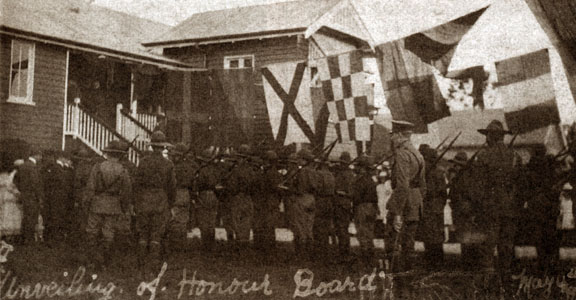 |
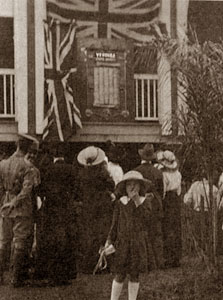 |
The caption reads "Unveiling the Honour Board, May 4th 1918. The steps lead up to the Headmaster's Office which is the small ante-room in the middle of the photo. (YSS P&C) |
Unveiling of the Honour Board at Yeronga State School - 4th May 1918 (YSS P&C) |
On Anzac Day 1918, the Yeronga State School Honour Board Committee commissioned a memorial to the old boys of the school who enlisted in WW1, many of whom died while serving. The honour board was made of iron with brass mountings. The names of over 100 boys were etched in black letters on the brass plates on the board. On the top of the names was a British lion and a kangaroo resting on and protecting the Union Jack, and on each side of this was the Australian Army insignia of a "Rising Sun". A model of an Australian soldier appeared on each side.
The honour board was placed on display in the window of John Clarke Kenyon's menswear shop at 170 Queen Street for all of May. Mr Kenyon and his wife Isabella lived at "Hillcrest" at 81 Park Road Yeronga on the corner of Christensen St and Park Road directly opposite the school. They lost their son Les at Gallipoli on 8th August 1915 during an action against Turkish forces. The honour board was unveiled by the Governor on Saturday 4th May, at the school. It was mounted in the foyer of School's office.
ANZAC DAY WREATHS
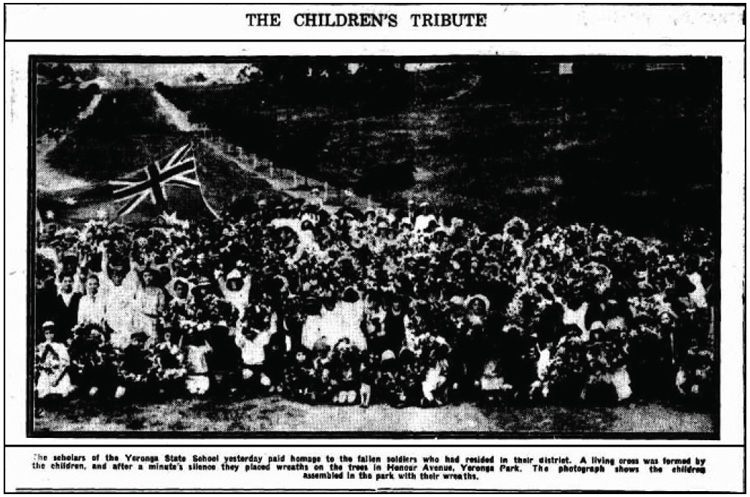 |
Yeronga State School children marking Anzac day with wreaths along Honour Ave to the memorial on the hill, Thursday 24th April 1924. The following day was a public holiday. Source: Brisbane Courier Friday 25th April 1924, page 8. |
This ceremony has been going on since then and continues today. I [RW] recall when I was a student at Yeronga State School from 1955 to 1962, every year (from Grades 3 to 8) we would bring to school wreaths in the form of circles, crosses or the letter "A" and they would be displayed outside our classrooms for everyone to see. Students were allowed to visit each other's rooms to admire the various designs (some home-made, some shop-bought). After morning tea we would march through the side gate to 'our' tree in Honour Avenue. Generally we kept the same tree each year. We would lay our wreaths beside the tree and observe a minute's silence before admiring everyone else's arrangements and returning to school.
The Brisbane City Council would come around the next morning to remove all the wreaths and cards - and incinerate them. I would sometimes sneak up early and take mine home. Once, when I was in Grade 4, I had a particularly good wreath. It wasn't the usual sort my mum made from our own garden; it was fancy red crepe paper one she brought home from her work at James Campbell & Sons. It had a purple ribbon with yellow writing. I thought it was so marvellous I wanted to keep it from the fire. I was caught by a teacher who sent a Grade 8 boy to grab me but I struggled free and ran home along Park Road with my wreath.
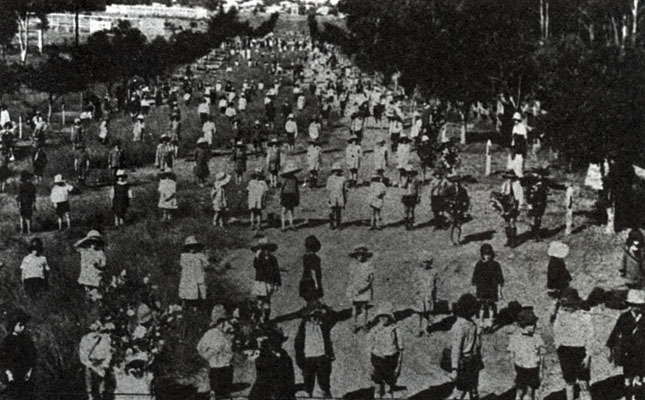 |
Wreath-laying by Yeronga State School students - Friday 24th April 1925. The cenotaph is clearly visible at the end of the straight road that is Honour Avenue. This photo was taken from outside the Park Road gates. You can see the wreath around the Sovereign's Orb that adorned the top of the left gate post. The first row of children (between weeping figs) marks soldiers Les Kenyon (left) and Jack Rigby (right). The second row (flame trees) is for John Fairlie and Marshall Jury, and so on up the Avenue. This photo clearly establishes that the Avenue was straight and that the curve was put in it after 1925. (YSS P&F) |
and 90 years to the day later............
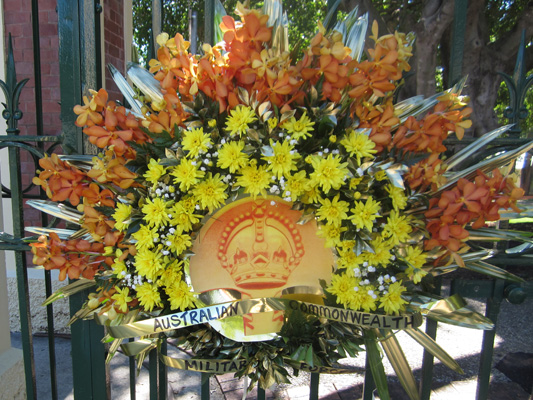 |
At the Centenary of Anzac service at Yeronga State School on Friday 24 April 2015, a wreath was placed on the Park Road gates. |
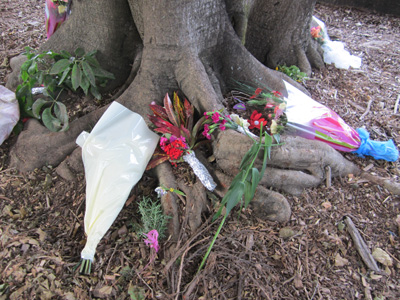 |
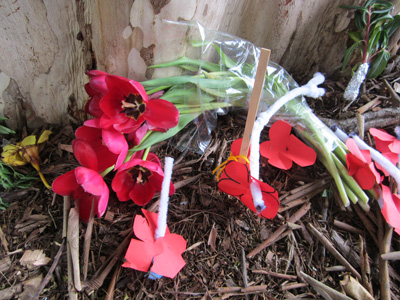 |
| In 2012, students of Yeronga State School placed flowers beside the trees in Honour Avenue as they have done yearly since 1924. | They were placed here during their Anzac Day service on Tuesday 24th April 2012 and were still there the following day during the public Anzac Day service in the park. |
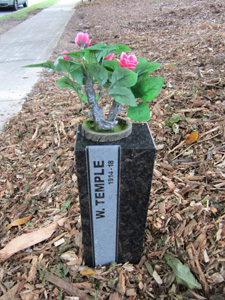 |
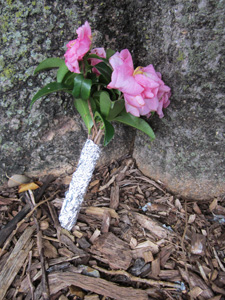 |
 |
| A student has placed flowers on the granite plaque commemorating Pte William Temple of the 3rd Bn Pioneers who died in Belgium on 23 July 1917 aged 22. | Simple offerings of flowers by each student has been a hallmark of the Yeronga State School commemoration. | Most of the flowers come from the students' home garden. Rarely do you find any elaborate wreaths or flower arrangements. |
 |
 |
| Students from Yeronga State School Year 2M class place flowers around a weeping fig (tree #18) in Honour Avenue on Tuesday 24th April 2012. | Accompanied by their teacher Ms Kerri McGuire, the students bow their heads in memory of Private Norman Freeman, 55th Batallion, who died in France on 22nd July 1916, age 25. |
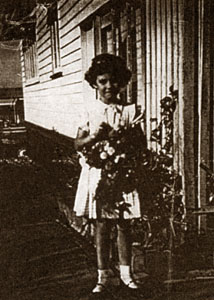 |
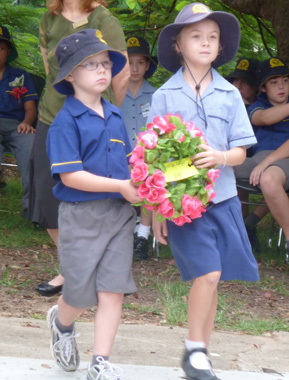 |
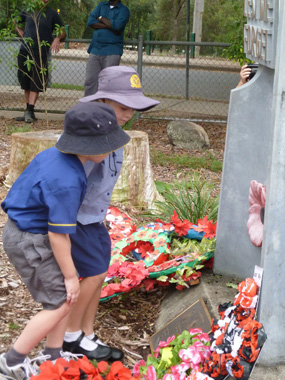 |
A student from 1925 with her wreath ready to lay in Honour Avenue. (YSS P&C) |
Year 2M students carry a wreath to the memorial in Yeronga Park - 24 April 2012. |
Here they are placing the wreath at the school memorial. |
YERONGA STATE SCHOOL MEMORIAL
 |
This memorial is in the grounds of Yeronga State School - just beside Honour Avenue |
CHRIST CHURCH - YERONGA
 |
Christ Church - the Anglican Church at Yeronga |
Christ Church in Cork Street Yeronga was an important part of family life to the families of soldiers serving overseas. It gave them a place to meet, to pray for their loved ones and recieve solace when bad news arrived. Although the Rectory was completed in 1917, the church itself was not completed until 1922. It is interesting to note the names of the fallen soldiers inscribed on a memorial tablet on the church's west wall inside. Three of the names do not appear on the memorial scrolls in the Cenotaph, namely: TH Feeney, JB Haskins and RCS Douglas. The reasons relate to the conditions for inclusion on the memorial as laid down the the Stephens Shire Council, namely to have died overseas while serving in the armed forces, and to have an association with the Shire.
| Memorial tablet - Christ Church |
John Bower Haskins (8915) died on 22 August 1917 in Belgium. He was a warehouse assistant who lived at Gloucester St, Spring Hill with his parents and siblings. While serving with the 8th Australian Field Ambulance he and four others were struck by a German shell in their dugout and all died instantly. His wounds apeared superficial but it was the violent concussion that killed him. John was buried at Vlamertyaghe in Ypres, Belgium.
By the time names were being sought for the memorial scroll his parents Sushannah and John had shifted to the cnr of George and Francis St Annerley and attended the Christ Church in Cork St. His name duly appeared on the Memorial Stone but was perhaps too late to be included in the Stephens' list as the roll closed just before they arrived.
Thomas Harold Feeney (20892) was a cordial maker who lived at Clifford Street Yeronga and joined the army in 1913 but suffered from pre-existing chronic rheumatism so was discharged 'medically unfit 'in 1916 after 26 months service. He re-enlisted in 1918, travelled to England for duty with the Sea Transport Service but returned to Australia and discharged in 1919, again 'medically unfit'. Tom died on 29 January 1921 in Yeronga and was buried at the South Brisbane Cemetery. Because he didn't die in service overseas he would be ineligible for recognition on the memorial plaques. Secondly, as his rheumatism was a pre-existing condition it was unlikely to have been recognised as war related.
Reginald Clive Slater Douglas was born on the 1th November 1895, to parents Alice and William Douglas. They lived at a grand colonial home called "Masterton", on the corner of Dublin and Belfast streets, Yeronga, just a few doors from the church. The house was purchased in 1908 by Clara Elson, who bought it for her sisters, Emily and Alice Douglas and Alice's four children, Horace, Reginald, Gordon and Graham.
While working as a draftsman, Reginald enlisted in January 1916, aged 20 and served in France as a 2nd Lieutenant with the 9th Infantry. Reginal disembarked in Plymouth in July 1916, and after four months training travelled to France and was promoted to Lieutenant. Three months later, at Armentieres, France, on the 11th February 1917 he suffered a severe gunshot wound to his left hip and knee and was transferred to a hospital in Boulogne. In March that year he was reported as being dangerously ill, but slowly recovered and was taken off the seriously ill list in July. In May of that year he was mentioned in despatches for "conspicuous services".
He returned to Australia in November 1917 in the Hospital ship Karoola and was transferred to the Kangaroo Point Military hospital where he spent 6 months being treated. Medical records state that he had 13 operations and suffered from "flail hip joint", before being discharged from the army in July 1918. Reginald died in Brisbane on 13 May 1921, aged 25. If nothing else, this may have been after the closing date for inclusion on the Stephens Shire memorial roll, and it was not a death occurring overseas during service, and it may not have been war-related. The foundation stone for the Church was laid the following year, on the 25th November 1922 and that's where Reginald's service has been acknowledged.
The Priest's Warden of Christchurch, Yeronga, James Stephen has produced a booklet with the histories of the soldiers named on the tablet above. The histories are largely taken from this webage but the booklet brings them all together. Click here to download a copy.
OBITUARIES
of Soldiers who Gave their Lives in the First World War
Please contact me if you have photos, corrections or additional information.
The following obituaries have been pieced together from the official Brigade and Battalion war diaries, from the soldiers' army records, and from newspaper clippings, BMD records, ancestry files and from relatives of the deceased.
In the tables below the number in the first column is not official but merely represents the order in which the names have been recorded on the plaques in the Cenotaph. The records of First World War soldiers have all been digitised and are available free on the website: National Archives of Australia.
Of the 97 men honoured, 71 were born in Australia (73%), 14 in England, 6 in Scotland, 1 in Wales, 2 in Ireland, 2 in Holland and 1 in South Africa.
PANEL 1
| No. | Surname | Given Names | Date of Death | Unit | Service No. | Age | Place |
| 1 | Ansell | Alfred Erold | 4/10/1917 | 42nd Bn | 2707 | 25 | Belgium |
| 2 | Barrie | John | 7/07/1917 | 41st Bn | 5033 | 29 | France |
| 3 | Beaman | Charles Edward | 4/10/1917 | 25th Bn | 6031 | 42 | Belgium |
| 4 | Behan | William Charles | 25/05/1918 | 25th Bn | 6033 | 38 | France |
| 5 | Bess | Leslie Norman | 3/05/1918 | 9th Bn. | 775B | 19 | England |
| 6 | Binnie | Daniel Mcnee | 6/07/1918 | 3rd Coy | 322 | 25 | France |
| 7 | Blake* (not Black) | John Thomas | 7/06/1917 | 49th Bn | 2143A | 24 | Belgium |
| 8 | Bradshaw | John | 5/08/1916 | 25th Bn | 4087 | 18 | France |
| 9 | Brodie | Gilbert Campbell | 26/08/1918 | 11th Field Coy Eng. | 9438 | 25 | France |
| 10 | Caldwell | Frederick | 20/09/1917 | 9th Bn | 4743 | 26 | France |
| 11 | Capern | Jack Cummings | 8/08/1918 | 4th Div MG Corps | 432 | 20 | France |
| 12 | Carey | Thomas James | 9/05/1915 | 15th Bn | 866 | 34 | Gallipoli |
| 13 | Carter | Daniel | 20/02/1918 | 32nd Bn | 2406A | 23 | France |
| 14 | Clark | Andrew | 18/03/1918 | 9th Bn | 2605A | 23 | France |
| 15 | Clark | John | 5/08/1916 | 25th Bn | 1789 | 44 | France |
| 16 | Clarke | Fergus John | 12/10/1917 | 49th Bn | 1945 | 20 | France |
| 17 | Clifford | Christopher Arthur | 2/09/1918 | 25th Bn | 6791 | 22 | France |
| 18 | Cloughley | Joseph Horace | 7/06/1917 | 49th Bn | 5063 | 20 | Belgium |
| 19 | Colefax | Bazil Hope | 9/08/1916 | 47th Bn | 3714 | 24 | France |
| 20 | Hooper (not Cooper) | John Henry | 19/06/1917 | 47th Bn | 3761 | 19 | France |
| 21 | Doolan | Lionel Stuart | 5/01/1917 | 9th Bn | 6341 | 25 | France |
| 22 | Douglas | Robert | 7/06/1917 | 47th Bn | 1892 | 24 | Belgium |
| 23 | Dutney | Harry | 30/09/1918 | 49th Bn | 4977 | 22 | France |
| 24 | Fairlie | John Raymond | 13/02/1916 | 25th Bn | 8 (Lt) | 20 | Egypt |
*John Blake is misspelt as Black, and John Cooper is actually John Hooper.
PANEL 2
| No. | Surname | Given Names | Date of Death | Unit | Service No. | Age | Place |
| 25 | Fielding | James | 25/04/1915 | 9th Bn | 150 | 27 | Gallipoli |
| 26 | Flay | Eric Chapple | 4/10/1917 | 11th Field Coy | 9447 | 22 | Belgium |
| 27 | Forbes | Thomas Laidlaw | 25/07/1918 | 1st Bn | 6534 | 23 | France |
| 28 | Francis | William Shaw | 16/10/1917 | 47th Bn | 2425A | 19 | Belgium |
| 29 | Fraser | Edward Charles | 25/09/1918 | 11th Bn | 1320A | 20 | Israel |
| 30 | Freeman | Norman Lister | 22/07/1916 | 55th Bn | 3051 | 25 | France |
| 31 | Fuller | Alan Somerset Orde | 19/08/1916 | 3rd Field Amb. | 1672 | 21 | France |
| 32 | George | Edwin | 15/10/1916 | 15th Bn | 4802 | 29 | Belgium |
| 33 | Gilhespy | John William | 12/11/1918 | 5th Bn | 1404 | 29 | Egypt |
| 34 | Gilhespy | Robert | 29/06/1918 | 25th Bn | 4707 | 39 | France |
| 35 | Gnatz | John Henry | 6/07/1918 | 15th Bn | 2314 | 31 | France |
| 36 | Gracey | George Charles | 25/04/1915 | 9th Bn | 306 | 29 | Gallipoli |
| 37 | Grant | George Malcolm | 29/09/1917 | 31st Bn | 4065 | 23 | Belgium |
| 38 | Grant | Hugh | 14/07/1917 | 3rd Pioneer Bn | 793 | 26 | France |
| 39 | Hepworth | Robert Wilkinson | 11/08/1918 | 9th Field Coy | 16798 | 20 | France |
| 40 | Higgs | Roland Charles | 8/07/1917 | 41st Bn | 388 | 22 | Belgium |
| 41 | Hill | Samuel John | 18/09/1918 | 47th Bn | 2225 | 21 | France |
| 42 | Irwin | Thomas Robert | 8/08/1918 | 13th MG Bn | Lt | 23 | France |
| 43 | Johnson | Alfred Olof | 23/09/1917 | 52nd Bn | 3376 | 20 | Belgium |
| 44 | Jury | Marshall Vivian Henry | 25/08/1915 | 2nd Bn | 169 | 29 | Gallipoli |
| 45 | Juster | Leslie Manson | 16/07/1917 | 12th Bde. | 20810 | 20 | France |
| 46 | Kenyon | Arthur Leslie | 8/08/1915 | 15th Bn | 2227 | 22 | Gallipoli |
| 47 | Kerby | Thomas Joseph | 26/09/1917 | 49th Bn | 3203 | 42 | Belgium |
| 48 | Larsen | Walter | 5/04/1918 | 52nd Bn | 2786 | 22 | France |
| 49 | Ketteringham | Percy Nelson | 1970 aged 72 | Aust Flying Corps | Q22198 | see notes | see notes |
PANEL 3
| No. | Surname | Given Names | Date of Death | Unit | Service No. | Age | Place |
| 50 | Lightbody | Joseph | 14/11/1916 | 26th Bn | 4356 | 41 | France |
| 51 | Lindsay | Albert | 29/07/2016 | 25th Bn | 671 | 28 | France |
| 52 | Love | Paul Thomas Henry | 14/11/1916 | 25th Bn | 1548 | 22 | France |
| 53 | Markham | Roland George | 10/08/1918 | 9th Bn | 7016 | 31 | France |
| 54 | Matherson | James Leonard | RTA 17/06/1918 | 4th Bn | 3886 | see note | Return to Aus. |
| 55 | Maxwell | Arthur Reginald | 20/07/1916 | 30th Bn | 3557 | 20 | France |
| 56 | Meiling | John Alexander | 11/10/1917 | 9th Bn | 1087 | 20 | France |
| 57 | Michel (Mitchell) | Harold | 7/06/1917 | 47th Bn | 3011A | 24 | France |
| 58 | Morgan | Walter | 10/08/18 | 9th Bn | Z2434 | 27 | France |
| 59 | Morse | Vernon Eustace | 4/10/1917 | 42nd Bn | 2706 | 25 | Belgium |
| 60 | McCabe | Joseph | 5/08/2016 | 26th Bn | 1692 | 37 | France |
| 61 | McWade | Allen George Marcus | 11/08/1918 | 15th Bn | 7744A | 19 | France |
| 62 | Nalder | Stanley Edward Burrell | 12/06/1918 | 26th Bn | 6762 | 23 | France |
| 63 | Neil | John | 4/10/1915 | 7th Field Amb. | 3523 | 24 | Gallipoli |
| 64 | Nolan | Martin John | 9/08/1918 | 25th Bn | 5837 | 22 | France |
| 65 | Ormiston | Andrew Graham | 27/05/1918 | 25th Bn | 714 | 20 | France |
| 66 | Ormiston | David | 5/04/1919 | 49th Bn | 141 | 23 | France |
| 67 | Ormiston | John Wightman | 17/07/1918 | 25th Bn | 1092 | 25 | France |
| 68 | Orth | Henry Ernest | 9/10/1917 | 9th Bn | 3091 | 23 | Belgium |
| 69 | Orton | Arthur | 17/10/1916 | 47th Bn | 4571 | 27 | London |
| 70 | Otterspoor | Francis Jacob | 19/07/1916 | 31st Bn | 464 | 20 | France |
| 71 | Otterspoor | Servanus "John" | 22/05/1918 | 4th Pioneer Bn | 3900 | 25 | France |
| 72 | Oxford | Arthur Robert French | 6/11/1917 | 3rd Bn | 223A | 35 | Palestine |
| 73 | Packman | William Lumsden | 15/11/1916 | 4th Bde. | Lt | 21 | France |
PANEL 4
| No. | Surname | Given Names | Date of Death | Unit | Service No. | Age | Place |
| 74 | Paxton | Andrew | 7/10/1917 | 25th Bn | 5390 | 20 | Belgium |
| 75 | Pillinger | Harry | 7/11/1916 | 6th Field Amb | 10453 | 21 | France |
| 76 | Reedman | Victor Allan Claude | 14/01/1917 | 52nd Bn | 2725 | 19 | France |
| 77 | Reedman | Wilfred Norman Leslie | 5/11/1917 | 9th Bn | 5456 | 22 | Belgium |
| 78 | Rigby | William John ('Jack') | 25/04/1915 | 9th Bn | Lt | 23 | Gallipoli |
| 79 | Robson | Llewelyn | 13/10/1917 | 7th Coy | 246 | 26 | Belgium |
| 80 | Ruff | Charles David | 10/06/1918 | 25th Bn | 5400 | 26 | France |
| 81 | Rush | Olly Carl | 6/08/1916 | 12th Coy | 3834 | 22 | France |
| 82 | Seabrook | George Charles | 5/04/1918 | 49th Btn | 3727 | 27 | France |
| 83 | Sheppard | Roy William | 23/10/1916 | 31st Bn | 1561 | 21 | France |
| 84 | Spiers | James | 15/04/1917 | 11th FA Bde | 2801 | 25 | France |
| 85 | Straiton | Frank | 2/09/1918 | 26thBn | 6170 | 23 | France |
| 86 | Sunners | Jack Edward | 8/12/1918 | 3rd Div Amm Col | 21279 | 23 | France |
| 87 | Taylor | John Paterson | 21/11/1918 | 38th Coy | 14921 | 41 | Egypt |
| 88 | Temple | William | 23/07/1917 | 3rd Bn | 914 | 22 | Belgium |
| 89 | Thomason | James | 26/03/1917 | 7th Coy | 1618 | 28 | France |
| 90 | Turner | Thomas William | 29/07/1916 | 26th Bn | 3147 | 20 | France |
| 91 | Uncoq (Ulcoq) | Jeffrey Frederick Raoul | 5/03/1917 | 5th Bde | 7295 | 21 | France |
| 92 | Whitton | Robert Alfred | 25/10/1918 | AMC Reinf | 18994 | 38 | London |
| 93 | Wilson | Harry Gilmore | 23/07/1916 | 1st Field Amb. | 8677 | 24 | France |
| 94 | Wilson | Roy Alexander | 14/10/1917 | 41st Bn | 794 | 23 | Belgium |
| 95 | Woodhouse | Frederick John Joice | 18/04/1918 | 25th Bn | 279 | 23 | France |
| 96 | Wriggles | Henry Femister | 27/02/1917 | 41st Bn | 548 | 22 | France |
| 97 | Wright | Henry George (Harry) | 14/08/1916 | 49th Bn | 3528 | 25 | France |
FAB = Field Artillery Brigade; Amm Col = Ammunition Column
THE PLAQUES
The original metal plaques had all been stolen or badly damaged by 1960 and only some of the white posts remained. In the early 1990s the Stephens RSL Sub-Branch took on the major task of replacing lost or damaged plaques with the polished stone plaques which are now in place (see photos below). The idea to replace the plaques came from Joe Kelly, the then Vice-President who, along with other members of the Sub-Branch, including Norm Ballard and Jim Clarkson, placed the plaques in concrete blocks under the trees in Honour Avenue. These were rededicated by the RSL on Remembrance Day (11th November) 1993. About 32 remain visible and the remaining plaques are buried under the mulch around the trees or have been accidentally removed during maintenance of the park. The placement of the new plaques did not match the original order from 1922. I've obtained the tree-planting plan and naming order from the Brisbane City Council archives and this is shown below:
 |
The plan showing the location and type of trees and the corresponding name plaques for the 95 fallen men as recorded in 1922. Number 1 (Rigby) and Number 2 (Kenyon) are to the far right at the Park Road entrance. There are two trees numbered 80; the tree for Robert Hepworth should be No. 82. Click the image to enlarge. Another 33 places were marked (to the left), but yet not named, indicating that this plan was drawn in late 1919 with an expectation of more soldiers' deaths. Note that the road is straight (as an Honour Avenue was intended to be) - unlike the curve that finally appeared. Click here you can see an A4 version of the plan. |
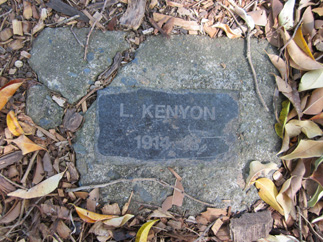 |
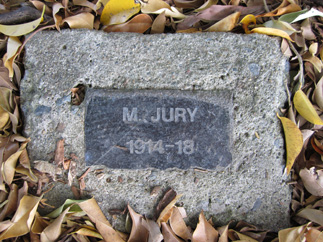 |
|---|---|
| The old plaques have served well from 1993 to 2012. They have been rescued and now are stored with RSL Secretary Ron Viles. Some of these plaques were not recovered and lie under grass and bark chips near the palms lining the Villa Street entrance to the park (Frederick Street). They should be removed in due course. | |
In mid-April 2012 the Brisbane City Council installed the new plaques ready for the Anzac Day service in the park on 25th April. They have been placed in the original order along Honour Avenue. The renovation of Yeronga Memorial Park and Honour Avenue was a committment made by BCC Councillor Ms Nicole Johnston in her maiden speech on 29th April 2008. A Land and Conservation Management Plan was drawn up by the Council and in August 2011 this plan won a Queensland Heritage Council award for excellence in heritage conservation. The $500,000 program of works included the replacement of the name plaques to those shown below.
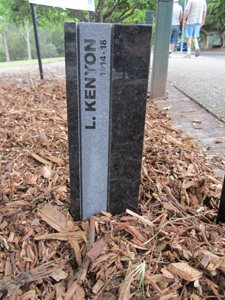 |
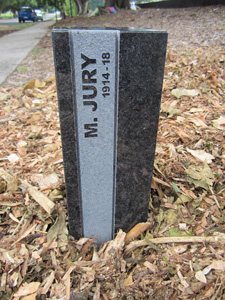 |
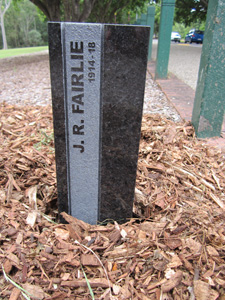 |
| The new granite plaques (spikes) are reinforced with stainless steel rods fixed to concrete underground. | ||
 |
 |
| People have been allowing dogs to unfortunately desecrate the memorial spikes. 16 April 2025 | Signs in the park. 17 June 2025 |
Alfred Erold Ansell - KIA, Belgium
 |
 |
 |
Alfred Ansell's plaque remains at the park. In 1993 the one above was placed beside a tree leading from the Cenotaph to the Ipswich Road entrance and has yet to be removed. |
Anzac Day 2014. A wreath brought by Yeronga State School studemts. |
The new plaque installed by the Brisbane City Council in 2012. This marks Tree 42 which is just outside the school oval. |
 |
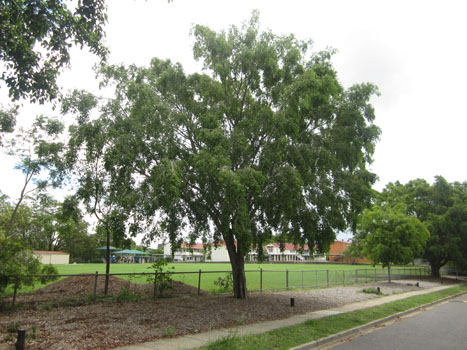 |
Alfred Erold Ansell |
Tree 42 - a weeping fig - in memory of Alfred Ansell. This new tree replaced the original one some time ago. Cuttings from the original figs were used to propagate the new ones.
|
Alfred Erold Ansell, the youngest child of his parents, Alfred and Mary Ellen Ansell (née Sidey) was born in Brisbane on 12 May 1892 and was barely 18 months old when his father died. They lived at Browns Plains - an outer suburb to the south of Brisbane. Alfred (Jnr) attended Coopers Plains State School along with his friends, the twins Oswald and Vernon Morse. On the 1st October 1905 the three boys were playing in the nearby Oxley Creek when they saw a snake and tried to kill it. The snake bit Vernon on the thumb and left two puncture wounds. Alfred, knowing that it was venomous, and remembering what he had been taught at school about snake bites, put a torniquet around Vern's thumb and wrist and cut the wound with a piece of sharp glass to let the poison out. They went home but Vern was scared that he would have to go to hospital if he told his parents so he went straight to bed. In the morning he was okay. Alfred was regaled as a hero and his first aid efforts written up in papers all over Queensland (see, for example, Rockhampton Morning Bulletin 9th October 1905).
In 1911, at the age of 18, Alfred joined the Field Artillery Brigade of the Queensland militia stationed in Brisbane and trained for 13 months before he resigned. He passed the entrance exams for Queensland Railways and became a porter. He left the railways and took up a job as a carter for a bakery. On 25 June 1913 he married Ethel Tilly Morse, the daughter of Ernest Tilly and Mary (née Brogden) Morse, in Brisbane. The young couple set up house at 'Eroldvale', Princess Street, off Fairfield Road, close to the South Brisbane Cemetery. They welcomed their only child Alfred Ernest Ansell on 1 May 1914.
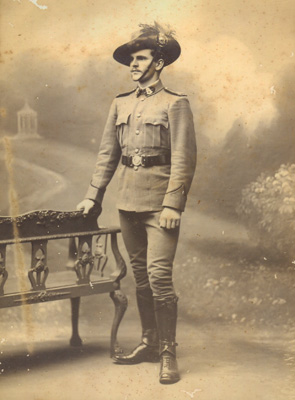 |
 |
Pte Ansell (B. Lanham) |
Alfred Ansell with his mother Mary (B. Lanham) |
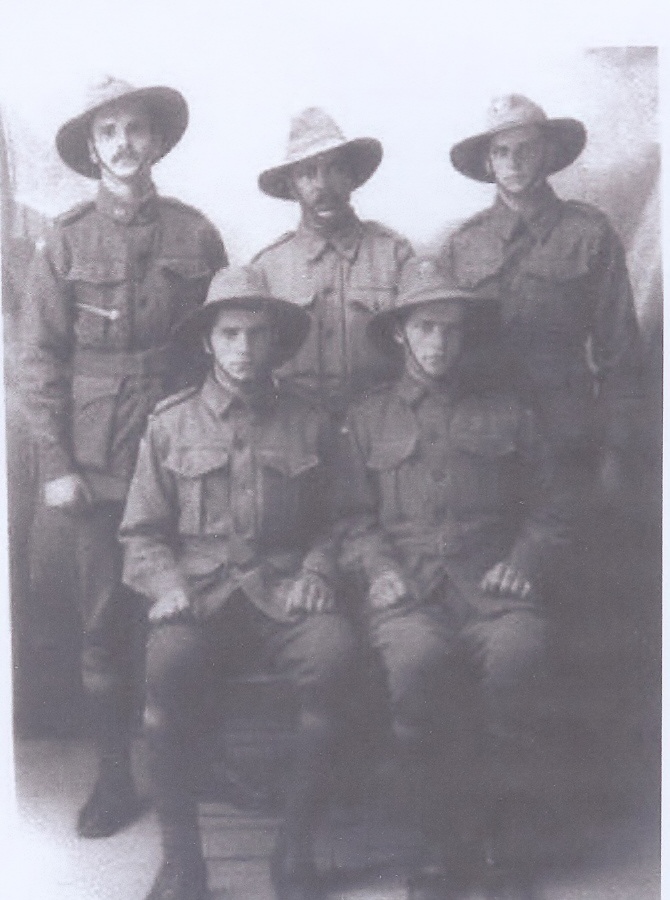 |
| The three childhood friends sign up - 1916. Back row: Alfred Ansell (left). Front row: Alfred's brothers-in-law, the twins Oswald and Vernon Morse. (Jason Barber) |
The three young men decided to enlist in the Army and attended the recruiting office together on 14 September 1916. They were all marked down as 5th Reinforcements for the 42nd Batallion AIF currently fighting in France and given consecutive Regimental Numbers: Oswald 2705, Vernon 2706 and Alfred 2707. The men applied for 4 days leave from 2-6 November - which was granted - so they could bid farewell to their parents. The young soldiers left for overseas aboard the transport ship HMAT A55 Kyarra on 17th November 1916 and arrived at Plymouth 10 weeks later. They all trained at Sutton Mandeville in Wiltshire with the 11th Training Brigade and left for France together on 2 July 1917. As part of the 3rd Division AIF, the 42nd Batallion was focussed on the Ypres sector of Belgium.
The three soldiers had joined the 42nd "in the field" after the major battle at Messines on 7 June 1917, but they were soon involved in the Warneton battle on 31 July. They were allocated to "C" Company. At the start of October 1917, the 42nd was at the Belgian town of Poperinglie. The weather was cold, but fine and clear, on the 1st October and the batallion prepared for a major operation to the east of Ypres. The Germans planes were bombing the 3rd Division but there was just the one casualty in the 42nd's camp. The next day - 2nd October - the 42nd's war diary records that there were 43 officers and 977 ORs (other ranks) present for the battle. The batallion was entrained at Poperinglie and soon arrived at Ypres where they bivouaced to the east, near the cemetery. The 3rd October passed with little incident. The battle was about to take place the next morning - the 4th October 1917. The 3rd October passed with little incident but the battle was about to take place on the morning of the 4th.
At 5.16 am the batallion's artillery put down a fearsome barrage which moved forward until 6 am. It was met with an equally fearsome barrage from the Germans. At 6am, the attack on the German lines began. The 42nd's barrage fell like a"wall of flames" on the appointed line (The Red Line). The rear troops sustained a fair number of casualties and to avoid more they moved forward up Hill 40 until the whole brigade was crowded into an area of 100 yards. An enemy machine gun kept firing for 5 minutes. Unknown to Alfred, Vernon had just gone over the top and had been struck by one of their own shells that had fallen short. His leg was almost completely severed from his body and the stretcher bearers took him away to the Dressing Station. This was 6.30 am. At 6.41 am, the 42nd leap-frogged the 43rd batallion and continued the attack. Alfred Ansell was in a trench in Thames Wood - about 50 yards on the eastern side of the railway line from Zonnebeke going towards Passchendaele (see map below). He leapt from his trench and "went over the top". At that very moment a German shell landed in the trench and struck Ansell with full force. One soldier said "he was badly knocked about" but it is evident from other eye-witness accounts that Ansell was torn apart by the bomb.
The 42nd batallion took their objective (The Red Line) by 8am. One hundred German prisoners were taken and nine machine guns captured. However, the 42nd batallion lost 3 officers killed, 2 officers died of wounds and 6 officers wounded. As for the "ORs", 220 were killed or wounded - including Pte Alfred Ansell. Most of the casualties were in this Thames Wood area.That same afternoon his platoon mate, Pte James Sheridan (713) - a miner from Gympie - buried what they could of Albert. He was buried where he fell and a rough cross was erected to mark his presence. Sheridan was helped by fellow soldier L/Cpl John Wilson Thomson (726) a fettler from Scotland who had enlisted with the 42nd in Brisbane. Thomson was wounded in action the very next day.
 |
The approximate position of Albert Ansell's grave is marked on this map from the 42nd's War Diary. The railway line is the dashed line running north-south in the centre. The 42nd Bn approached from the south and achieved their objective - the "Red Line" - by 8 am. |
Sadly, Alfred's brother-in-law Vernon never survived. He is thought to have died of wounds in the Dressing Station that same day - 4 October 1917. Ossie Morse survived the war and returned to Australia. The names of Alfred Erold Ansell and Vernon Eustace Morse are inscribed on the Ypres (Menin Gate) Memorial in Belgium. Sheridan visited Albert's widow Ethel in Brisbane after the war and told her the story. He said that he packaged up Albert's belongings and sent them to her - but they never arrived. On the anniversary of her husband's death in 1921, Ethel inserted a notice into the Brisbane Courier:
Dearer to memory than words can tell |
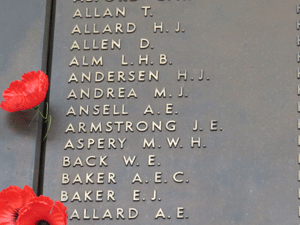 |
Australian War Memorial Roll of Honour October 2018 (J Hawker) |
Ethel died in Brisbane in 1969. Their only son Alfred married in 1935 and died in 1980.
John Barrie
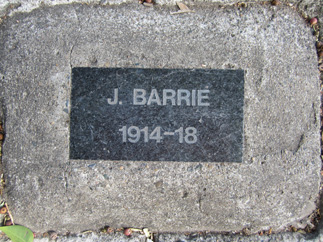 |
 |
From 1993 |
Replacement from 2012 |
.jpg) |
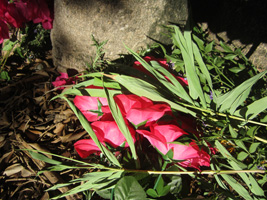 |
Tree 10 - a huge original weeping fig down near the school. You can just make out the Park Road gates in the distance. |
Anzac Day 2014. Flowers about the base of Barrie's tree. |
John Harrison Barrie was born in 1889 at Kangaroo Point (Brisbane) to Alexander and Isabella Barrie (née Harrison). He had an older brother Herbert Horace and a younger one Charles Henry. The boys attended East Brisbane State School and Maryborough SS.
Herbert (4090) and John (5033) both enlisted in the army in October 1915 in Brisbane. Herbert was sent to England with the 26 Bn aboard the HMAT Commonwealth and John was sent to Egypt aboard HMAT Star of Victoria arriving in May 1916. John eventually ended up in France and was wounded in the hip by enemy fire. He was taken to the XI Casualty Clearing Station at Bailleul and was injured again when the CCS was bombed during a German air raid on 8 July 1917. He suffered multiple wounds and died and was buried the same day. He was 28 years old.
His brother Herbert was killed in action at Villers Bretonneux on 17 July 1918. Herbert is not listed in the Yeronga Memorial. It is not certain why as he had the same address for next-of-kin as John (their brother Charles Henry Barrie of Henson Road, Salisbury).
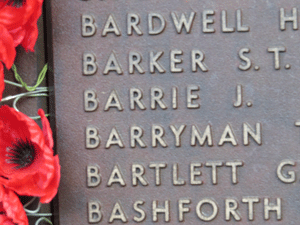 |
Australian War Memorial Roll of Honour October 2018 (J Hawker) |
Charles Edward Beamen
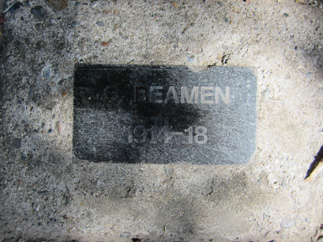 |
.jpg) |
 |
Beaman's plaque surrounded by clumps of Dianella caerulea Lucia ornamental grass. |
Tree 75 - Was a flame tree |
Charles Edward Beaman was born in Sydenham, Kent, England in October 1874 to Charles and Emma Beaman (née Sinnott). He attended St Philip School in that town. Charles later took on a job as caterer for the military in South Africa in The Boer War. Charles married back in Kent and set up a greengrocer's shop with his wife Ellen (b1881) and they lived at 7 Kelvin Tce, Sydenham. The family of Charles, his wife Ellen and their two-year-old son Charles Brighton Beaman emigrated to Australia aboard the Osterley arriving in Brisbane on 25 November 1912. He obtained work as a caterer and waiter. His wife Ellen died on 25 December 1914.
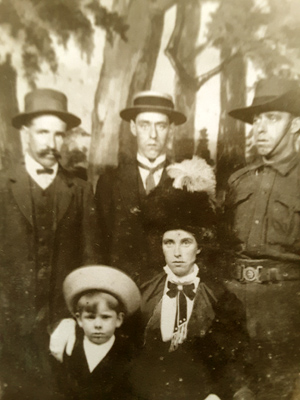 |
Photo taken in England in 1912 before the family emigrated to Australia. Back row from left: Charles Edward Beaman, Percival Wells (half brother to Ellen and Thomas Wells), Thomas Wells (British army, buried somewhere around Ypres, Belgium). Front row, Charles Brighton Beaman aged 2 years and Ellen Maud Beaman (nee Wells). |
On 11 August 1916 he enlisted in the army (Reg. No. 6031). At the time he and his son Charles Brighton Beamen were living at Mabel Villa, Clara Sttreet (off Venner Road) Fairfield. He sent his son up to live with Florence Wells (his wife's sister) and her husband Percy at Crestbrook Station, Toogoolawah, Queensland.
The 25th Bn (17th Reinforcements) embarked Brisbane aboard HMAT Marathon and arrived in Plymouth on 9 January 1917. After six months training in England, Charles was off to France where he joined the 25Bn. During the Battle of Zonnebeke in Belgium Charles was killed in action on 4 October 1917 aged 43.
My thanks to Julie Brown (nee Beaman) for the photo of her grandfather Charles Edward (above). She wrote: "Uncle Percy's daughter implied that rumour said there was five Beaman boys".
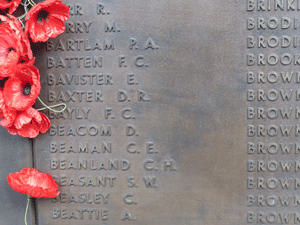 |
Australian War Memorial Roll of Honour October 2018 (J Hawker) |
William Charles Behan
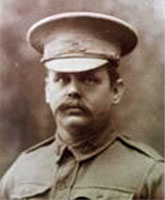 |
 |
William Behan (Faithe Jones 2013, WWI Pictorial Honour Roll of Queenslanders) |
Tree 44 - Originally a flame tree was here. Beahan's plaque is accompanied by clumps of Dianella caerulea Lucia ornamental grass. |
William Charles Behan was born in Brisbane 1881 to parents Michael Behan and Anne Jane Behan (née Glancy). His father Michael was a butcher and manager of Graziers' Butchering Coy at Wooloongabba, Brisbane.
William had many siblings: the oldest son was Thomas born in 1879, then a Michael was born in 1880 but died a year later. After William was born in 1881 there came Margaret, Elizabeth, Edward, Michael Edward, Mary, Michael James, Ann, Jane, Edward, and lastly in 1887, Agnes. The father Michael had just died (9th December 1896) before she was born. The mother, Mrs Jane Behan died in 1902 (15 August). Their orphaned daughter Agnes was enrolled at Yeronga State School in June 1908 at the age of 11 years.
William followed in his father's footsteps and became a butcher, eventually opening retail butcher shops at Moorooka and Yeronga. He married Prudence Glancy in 1903 and they established themselves at the home "Macclesfield" in Yeronga Street, Yeronga, just over the train line towards the river from Yeronga Park. In 1906 their first child - William James - was born, followed in 1914 by Norman Edwin. Son William James was enrolled at Yeronga State School in 1911 at the age of 5 years. William Charles Behan was a member of the International Order of Oddfellows (MUIOOF) like his father before him. He attended the Loyal Pride of Rocklea Lodge in the Oddfellows Hall near his butcher shop at Moorooka.
William joined the army on 11 September 1916 (R.6033), already having sold his butcher shops and equipment (and horse and cart) the previous December (1915). He embarked Brisbane aboard HMAT A74 Marathon as a member of the 17th Reinforcements, 25th Battalion. They arrived in Plymouth in January 1917 and were sent to training camp east of London. William was sent to France on 25 June 1917 and taken on strength in the 25th Bn three weeks later. He served his time with the 25th Bn as D-Company cook, given his extensive knowledge and skills in butchering.
1918 was an exhausting year for the 25th Battalion. It fought to exhaustion to turn back the German spring offensive in April. At the beginning of May 1918, the battalion was billeted at Rivery on the Amiens-Albert Road in northern France. A total of 45 officers and 979 Other Ranks (OR) were assembled. They were training for a major offensive later that month, preparing to attack the German front line and take their trenches. On the night of 22/23 May it was estimated that 4000 German shells fell, including large numbers of gas shells.
On the 24th May the 25th Battalion moved from its billet to relieve the 28th Battalion on the front line. In the evening during 4 hours of bombardment of the batallion's trenches by the Germans, Behan had taken refuge in a cellar of an abandoned house in Maricourt, Lambourne. His cooker was outside the building and he was able to wait in safety ready to feed his men. However, two gas shells fell directly on the house and exploded in the cellar. Beahan was half buried with dirt and severely gassed. A shell fragment penetrated just above his knee and and he had a slight wound on his head.
He dug himself out and made it back to the cooker where he was immediately picked up and carried by stretcher bearers back to the RAP (Regimental Aid Post). From here he was taken to the 20th Casualty Clearing Station but died on the way. Three other men were gassed: Fred Harling (4450), Jim Taylor (526A) and Tom Ruddell (57667). Another cook was killed but his name is not known. William was buried at Vignacourt about 8 miles NNW of Amiens. Mrs Behan received a letter dated 6 June advising of his death.
A pension was paid to Mrs Behan and her two sons but she remarried in 1921 (to John Scott) and forfeited her £2 per fortnight pension.
2015 Queensland Premier's Anzac Prize winner Renee Drury, a Year 11 student at Clairvaux Mackillop College, Brisbane, attended the Anzac Centenary commemorations in Vignacourt and Gallipoli. She commemorated the life of William Behan and prepared a eulogy which she read at his grave site (see below):
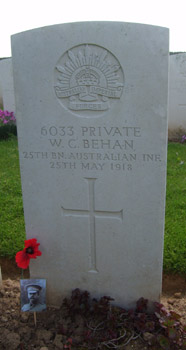 |
William Charles Behan A man I've never met And a face I'll never see, For a life too great and long to say That he rest beneath my feet, I'm sure you've heard this story A thousand times before, The man who fought so bravely, never a flaw, But this one is so different And I have had the privilege To know how a man so bold and brave can answer his nation's call And in his final resting place I have come to say hello. |
Grave of William Behan (Isabelle Godard, April 2015) |
Introduction to the Eulogy for William Behan |
Please note: The webmaster of the British cemetery Vignacourt historical website (http://www.vignacourt.free.fr/) - Isabelle Godard from Paris - wrote to say she would like to make contact with any relatives of William Charles Behan. She has photgraphed all of the graves at Vignacourt and is seeking photos of the soldiers buried there. If you can help her please contact Isabelle at <isabelle.godard5@free.fr>
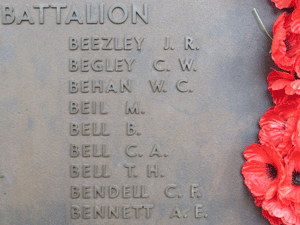 |
Australian War Memorial Roll of Honour October 2018 (J Hawker) |
Leslie Norman Bess
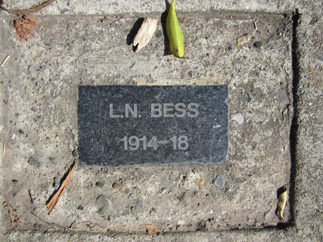 |
 |
 |
Tree 43 - Was a flame tree |
Leslie Norman Bess was born to Albert Bess and Sarah Ann Bess (née Hall) in Brisbane in 1900. He was one of 14 children (six girls - Alice, Florence, Sarah, Amelia, Martha and Violet) and eight boys (William, John, Alfred, James, Joseph, Thomas, Leslie and George). His great-grandmother Mrs M. Hall arrived in Brisbane from Torquay, Devonshire, in 1882 and was one of the first residents of Thompson Estate (now Annerley and Wooloongabba). She married William Hale Hall and they had 12 children; and her eldest daughter Sarah Bess had the 14 mentioned above. Sarah and Albert lived in Horatio Street, Annerley. Albert was a butcher. The children attended Yeronga State School. His enrolment record is shown below:
This extract from Queensland State Archives [ID 868280] shows that Leslie Bess was enrolled as Number 2167 on 3 February 1905 at the age of 5 years 0 months. The last column shows that he left school in February 1914. |
Leslie Norman Bess was the second youngest child in the family. He enlisted on 17 March 1917 as soon as he turned 18. The army placed him in the 13th Machine Gun Company for training and sent him off from Brisbane aboard A71 HMAT Nestor on 21 November 1917. Les disembarked Suez on 15 December and made it to Southampton on 24 January 1918. He began his training at Sutton Very and was ready for France on 23 April 1918.
Les joined the 9th Battalion Reinforcements from the 13 MG Coy in the field at Ypres. He was in the Meteren-Becque sector suffering heavy bombardment from the instant he arrived. The men had been taking all precautions against ill-health, particularly trench foot which was having a significant effect on the men. Les came down with a lung infection which saw him sent back to England after just a day or two at the front line. He was at the 24th General Hospital (London) when he died of disease. It was lobar pneumonia - an infection that had found its way in to the lobes of his lungs. He was buried in England.
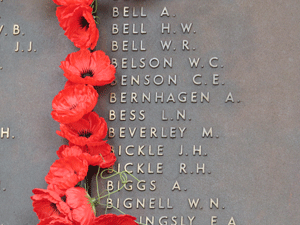 |
Australian War Memorial Roll of Honour October 2018 (J Hawker) |
Daniel McNie Binnie
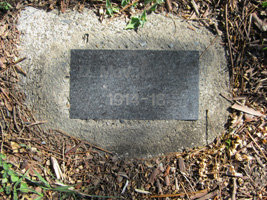 |
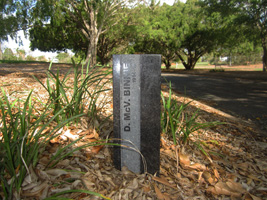 |
.jpg) |
Binnie's plaque is surrounded by clumps of Dianella caerulea Lucia ornamental grass. |
Tree 73 - A big old weeping fig still marks this memorial. Looking up towards the Cenotaph from Binnie's tree on left. |
Daniel McNie Binnie was born in the town of Beith just to the south of Glasgow, Scotland, in 1893. His parents were William Binnie, a wholesale confectioner, and Elizabeth Binnie (née Hutchison). Daniel had older brothers William Dunn Binnie and John Eagleshaw Binnie (b1891), and younger siblings Thomas Smith Christie Binnie (b1896), and Andrew Christie Binnie. They attended the local school - Beith Academy (now Garnock Academy) - a mile north of their home in Dalry Rd.
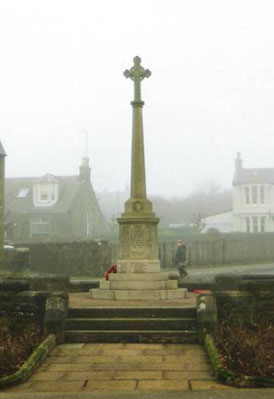 |
 |
The Beith War Memorial commemorates the service and death of soldiers from Beith in WW1 and WW2. |
The name sof the Beith WW1 soldiers are inscribed around the base. Daniel Binnie's is the 11th down in the centre. |
Beith is the most important furniture manufacturing town in Scotland so it is not unexpected to find that Daniel and William completed apprenticeships there (with William Walker, Cabinetmaker). Daniel was with Mr Walker for five years when he decided to emigrate to Australia. At the age of 19, Daniel, and Thomas (aged 17), boarded the Ayreshire in Liverpool on 26 April 1913 and arrived in Brisbane on 30 June 1913. Daniel's oldest brother, William, was already in Brisbane working as a cabinetmaker and soon to be married to Agnes Marguerite Searle (12 Sept 1914). Daniel and Thomas lived with William at "Agnesville", Horatio Street, Annerley (hence the connection to the Stephens Shire).
Daniel enlisted in the AIF on 16 November 1915 and was placed with the 4th Reinforcements of 12th Battalion Machine Gun Company. He embarked aboard RMS Orontes in Melbourne on 16 August 1916 and arrived in Plymouth six-weeks later. Daniel was sent for training in England and departed for France on 13 November 1916, but was now with the 3rd MG Battalion's 1th MG Coy (as of 7 November).
In October of the following year (1917) he was wounded by the gas from a German shell. He was off to Reading Military Hospital in England to recuperate. After recovering, instead of sending him back to France, he was sent to Hurdcott Training Camp on 21 November 1917 for more training. This he did until 30 April 1918 when he was sent back to join the 3rd Machine Gun Battalion, 11th MG Coy in France.
On the 2nd July 1918 the Battalion was at Villers-Bretonneux in northern France. The Company was camped in the woods and had just finished making their quarters comfortable. They were preparing for the "Hamel Offensive" whereby the machine gunners were to harass enemy works and roads. They marched out at 3.30pm on Tuesday the 2nd July and headed for the front line behind the advancing infantry. They proceeded without difficulty. On the night of Thursday 4th, the machine gunners went forward at 10.17pm and fired 12000 rounds during the night. The German were quick to come up from deep dugouts and getting their gun active. The Germans responded with 5000 rounds. During the engagement over the next night Daniel Binnie was killed (Saturday 6th July 1918) along with two other ORs. Ten ORs were wounded. He was buried at Neuville.
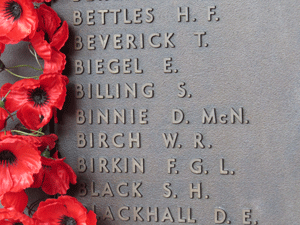 |
Australian War Memorial Roll of Honour October 2018 (J Hawker) |
John Thomas "Jack" Blake
John Thomas "Jack" Blake in his 49th Battalion AIF uniform, taken in England 1916.
Photo courtesy of his granddaughter Janette Nathan (nee Blake) |
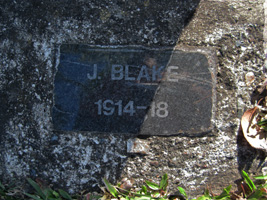 |
 |
Beside a tree in Frederick Street, lining the Villa Street Entrance (see next photo) |
John Blake's plaque was placed beside the middle palm tree in 1993 and has not been removed. These are Date Palms (Phoenix dactylifera). |
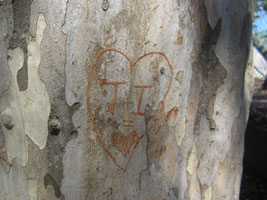 |
.jpg) |
 |
Pte Blake's tree was originally a flame tree but the Council planted a more hardy Leopard Tree many years ago. |
Tree 11 - Blakes's Leopard Tree just outside the Yeronga State School tennis courts. |
Blake's tree again. There are just three Leopard Trees marking soldiers' names in Honour Avenue: J T Blake, J McCabe and J Neil. |
John Thomas "Jack" Blake was born in Liverpool, England, in March 1893 to parents John Thomas Blake and Ann Mary Blake (nee Furlong). He had a sister and two brothers. John migrated to Australia at age 17, arriving aboard the SS Whakatane on 21 January 1910. He joined the Moreton Regiment in Brisbane and was promoted to Lieutenant during his five-year's service.
John returned home to Liverpool in 1914 to see his family and when the war broke out he returned to Australia. John married Doris Ellen Dodd, from Saltley, Birmingham, in Brisbane on 24 July 1915 and they set up home in "Tanathea" at Marquis Street, Thompson's Estate, now Greenslopes. He was working as a labourer in a fruit cannery. Their only child, Eric John, was born in March 1916.
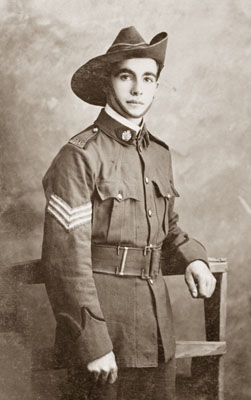 |
John Thomas Blake, pre-war, with the Moreton Regiment. AWM P06412.001. |
John enlisted in the AIF in Brisbane on 29 January 1916 and was placed with the Training Battalion at Enoggera Barracks, Brisbane. In March he was assigned to the 4th Reinforcements, 49th Battalion AIF and, because of his rank with the Citizens Forces (Lt), he was made acting Sergeant (in May 1916). He departed Brisbane aboard HMAT Boorara on 16 August 1916 as part of 49th Battalion and arrived in Plymouth in October. John was sent to 13th Training Battalion at Codford where he reverted to ranks on 18th November (reverted from Sergeant to Private). They soon cancelled that and promoted him to Acting Corporal before heading to France where he reverted to Private when officially taken on strength with the 49th Battalion in late December 1916. He became known as "Jack", or "Blakey".
The 49th Battalion had finished that year alternating between front-line duty, and training and labouring behind the line. When Jack joined them this routine continued through the winter of 1916-17. Early in 1917, the battalion participated in the advance that followed the German retreat to the Hindenburg Line, supporting the 13th Brigade's attack at Noreuil on 2nd April. In May the focus of the AIF's operations moved to the Ypres sector in Belgium.
The battalion was about to fight in the battle of Messines on 7th June. The objective for the 13th Brigade was to capture two lines of trenches. Of this the objective for the 49th Battalion was to take right side trenches from O28.d.23 to O34.b.35 (the red line labelled "Second Objective" drawn in the map below):
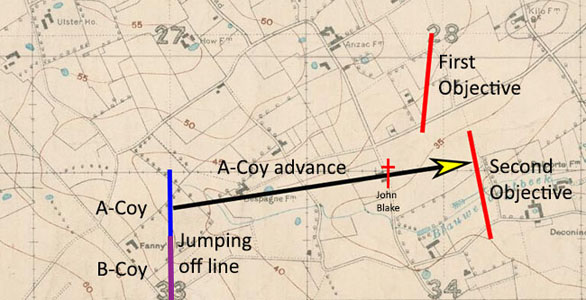 |
Caption: Trench map from the 13th Brigade's War Diary. This map is dated 8th June 1917 and has the various trenches marked on it as they stood after the battle on the 7th June when Jack died. The town of Messines is about 1000 yards below the bottom left square. I have added a blue and purple line (on the left) to show the "jumping off" point for the advance. The dark blue shows the position of C-Coy and A-Coy (Jack's), and purple for D-Coy and B-Coy. The black arrow shows the direction of the advance of A-Coy at about 2.20pm. The red lines on the right shows the two objectives of the battle. Jack was killed about 200-300 yards from the objective and a red cross marks the approximate spot. He was buried here but this temporary grave was never again found. |
Zero hour at Messines was 2am on the 7th June 1917. The men steadied themselves for the assault at 11.30am. The time arrived and a creeping barrage of artillery shells began about 150 yards on their side of the objective. This curtain of falling shells moved forward at 30 yards a minute until it reached the green line. There it continued for 15 minutes and then was raised (started rolling past the line) and continued moving forward. This was the cue to begin the assault. Their jumping off line was O27.d.00 to O33.d.06 (see map) and they were here ready to go at 2.20pm - a bit later than planned.
C-Coy and D-Coy were the first to go but they noticed that the barrage was falling short and some of their own men were getting hit. Nevertheless, the barrage was keeping the Germans pinned down, and with the support of the battalion's Lewis guns and machine guns were able to capture the line of trenches. Then A-Coy (on the left side of the jumping-off line, and B-Coy on the right), began their advance. The first wave (C and D Coys) had made it to the line and the second wave (Jack's) was following behind. When he was about 200-300 yards from the line he was in a shell hole wounded. He was being bandaged-up and a sniper's bullet got him in the head. Jack was killed instantly. Some men said that he was just unconscious and was swaying back and forth. However, one of the stretcher bearers, and a mate, Bill Brazier said that he was beside Jack when he was hit and he died immediately.
Jack was believed to have been buried where he lay - in the shell hole - but it is not certain. Bodies were collected from the battlefield but some were badly torn apart by constant bombing. No known grave exists for Jack but his is memorialised at The Ypres (Menin Gate) Memorial (Panel 29), Belgium. Jack's wife Doris and son John Eric were provided for by way of his pension and they moved to the suburb of Deagon.
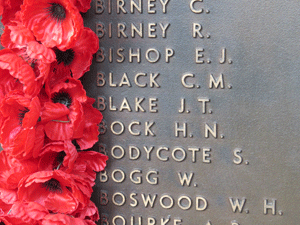 |
Australian War Memorial Roll of Honour October 2018 (J Hawker) |
John Bradshaw
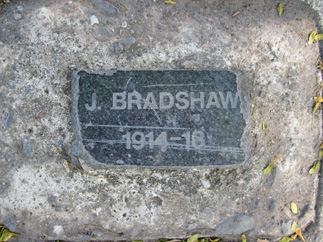 |
 |
 |
The replacement plaque installed by the Stephens RSL in 1993. |
|
Tree 12 was a flame tree but has long since gone and was replaced by this plaque and ornamental grass in 2012. |
John "Jack" Bradshaw was born in Brisbane on 7 March 1898 to William Bradshaw and Marion Bradshaw (nee McElroy). He had three brothers and three sisters: Thomas (born 1891), Samuel (1892), Mary (1896) Elizabeth (1899), Jane (1902) and David (1904). H was known to all and sundry as "Jack". The family lived in Ekibin Road, Annerley, and the children attended the nearby Junction Park State School. Jack undertook compulsory cadets (part time) for four years with Area 9A and trained at Fort Lytton. He had work as a grocer.
On 21 September 1915, at the age of 18½ years Jack joined the AIF in Brisbane. He trained and was taken on strength with the 25th Battalion (10th Reinforcements) on 17 December 1915, Reg. No. 4087. On the 28th March 1916 he departed Brisbane aboard HMAT Commonwealth A73 for the Middle East. After some training there he was sent to France with the 25th Battalion but upon arrival was stricken with tonsillitis and hospitalised. He rejoined his unit at Tara Hill near Albert in northern France on the 2nd August 1916. The Brigade was being reorganised after a major attack on 28/29 July. In the morning of the 2nd August the battalion left for Pozieres to relieve the 19th Battalion in the front line. Their job was to dig out a "Jumping Off" trench (shown as a thick red line in the map below) and to deepen communications trenches and improving the fire trench.
On the 3rd August the battalion experienced heavy shelling by the enemy. Thirteen of the men were killed and 20 others wounded. The shelling continued all through the night and into the morning of the 4th of August. That day, shelling remained heavy. At 11am 7th Brigade Headquarters ordered an attack on the Pozieres Ridge enemy trenches with the objective of capturing them. At 8.10pm the Brigade began artillery bombardment of these trenches. This lasted one hour and then - silence for five minutes. Then the main barrage began with the men advancing behind the protective curtain of falling shells. They quickly captured the closest German trench OG1 and started for the second trench - OG2 - but by now the Germans were aware of the attack and began returning fire. The Brigade captured the trench but the enemy counter-attacked with a very heavy barrage of shells on both trenches - mainly the devestating 9.2 inch high explosive (HE) shells. It was now impossible to get supplies forward to the OG2 trench.
The men held their position until 6pm when they were relieved by the 28th Battalion - which had been held in reserve. In all, 24 ORs (Other Ranks) had been killed. This included Jack Bradshaw who would have been killed somewhere between the OG1 and OG 2 trenches most likely. I have marked the likely spot on the map below. As well, 9 officers and 126 ORs were wounded, and 1 officer and 178 ORs were missing in action. The enemy casualties were also very high, mostly by being bayonetted in their trenches by the men of the 25th Battalion. Pozieres Ridge was now in the hand of the British.
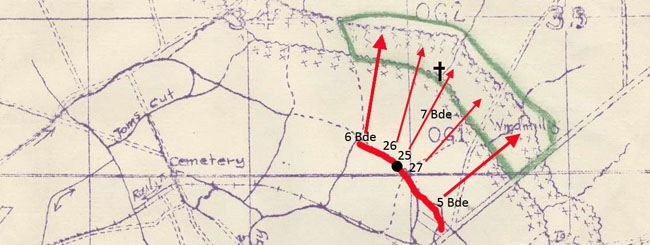 |
An image of the actual map of Pozieres used by 25th Battalion HQ during the Poziers offensive in which Jack Bradshaw died. The green pencil line is from the original and shows the two German trenches (OG1 and OG2) that were the objective. The straigh line to the right (at 45 degrees) is Bapaume Road. I have added the red lines based on the reports in the War Diary. The 7th Brigade was in the centre between the 6th Bde and the 5th Bde. The three battalions of the 7th Bde had dispositions as shown above, with the 25th Bn in the centre of the action. The thick red line towards the bottom is the allied "Jumping Off" trench for the action. The heavy black dot on this line is the point (R34 d 9.1) on which the Germans concentrated their heaviest shelling. The black cross on the OG1 trench is a likely spot that John Bradshaw was killed. |
The carnage was so great that men's bodies were unidentifiable. The shells dismembered the bodies and then dismembered them again and again. Jack was buried at the Courcellette British Cemetery in France that same day but he remained unidentified. He was posted as "Missing in Action" (MIA) along with 177 other ORs. A Court of Enquiry reported almost a year later (on 5 July 1917) that Jack was no longer MIA on the 5th but "Killed in Action" that day - 5th August 1916. Jack's father wrote on March 1918 asking if any of Jack's effects were recovered. The army replied that none were recovered. It is not hard to envisage why.
Around the anniversary of Jack's death that year (1918) his family inserted a notice in the local paper:
Brisbane Courier 18 August 1917
He died for his country. |
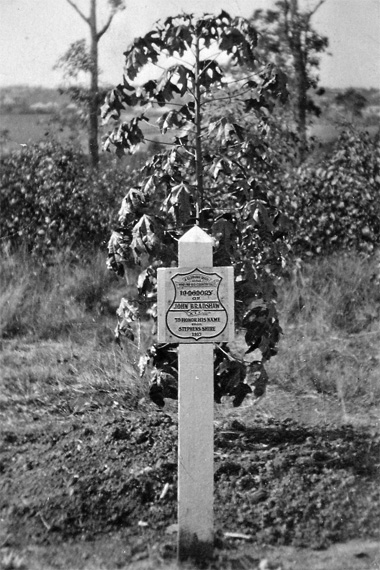 |
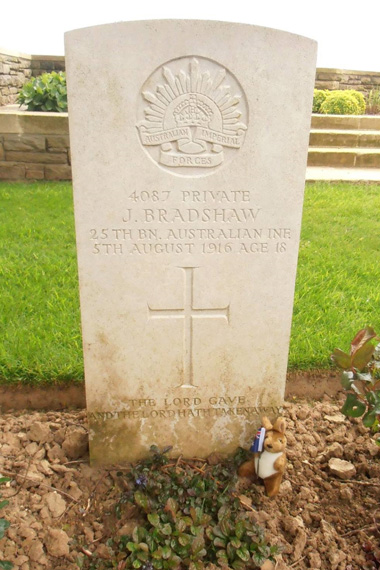 |
| Jack Bradshaw's memorial plaque in Honour Avenue. This plaque, like all plaques in the park, was stolen and has never been found again. The Flame Tree looks unhealthy and did not survive. (Leonie Neil) | Jack Bradshaw's gravestone at Pozieres. Photo supplied by his great niece Leonie Neil: "I was lucky enough to visit a few years ago. A very sobering experience". [22 Feb 2016] |
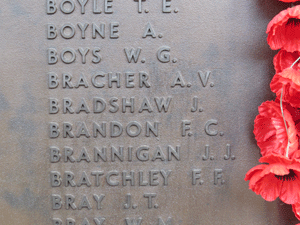 |
Australian War Memorial Roll of Honour October 2018 (J Hawker) |
Gilbert Campbell Brodie
.jpg) |
 |
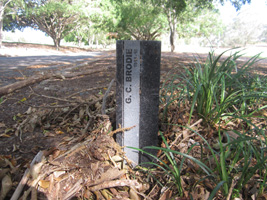 |
Tree 74 - A big old weeping fig (centre) originally planted in 1919 is still there today. |
Sgt Maj "Gib" Brodie |
Plaque from 2012. Note the clumps of Dianella caerulea Lucia ornamental grass. |
Gilbert Campbell Brodie was born 17 April 1893 at Mt Gravatt, Brisbane, to John Brodie and Charlotte Annie Brodie (nee Walden). He had older brothers John Edward and Robert, and younger siblings Francis and Margaret (who died at 7 weeks). They lived at Riverview Terrace, Fairfield.
Gilbert attended the local State School and became a whipmaker by trade. He joined Junior Cadets and became a Sergeant, then Company Sergeant with Senior Cadets and then a Sergeant with the Voluntary Engineers. His father John died in January 1914. Gilbert enlisted on 10 January 1916 and began training in Brisbane. His best mate, Albert Burton (10882), also a whipmaker with the same employer, decided to enlist at the same time. They were both placed with the 11th Field Coy Engineers and took a train to South Australia to depart for England on 31 May 1916 aboard HMAT A29 Suevic out of Adelaide.
After training in England, Gilbert (or "Gib" as he was known) having progressed from Private to Sapper to Corporal, was off to France in November 1916. His brother Robert Arthur, back in Brisbane, had enlisted in the 4th Pioneers Battalion in September 1916.
In France, Gilbert and the 11th Field Coy Engineers had taken a train to Amiens and then on to Armentieres where they were providing support for the 3rd Division AIF around the Somme in Northern France. The task of an engineer is to build, install or repair the supporting requirements of battle. At the Somme for most of 1917 they were building or repairing stables, billets, bridges, gun pits, hospitals, camouflage, wells, barbed-wire fences and roads. In October 1917 they had arrived at Ypres and were billeted in cellars and shelters while awaiting the 3rd Division's next move. It was to be soon.
On the 4th October 1917, the 3rd Division attacked the Germans on two fronts. Under the command of Lt Henry St Aubyn Murray (9431), Sgt Gilbert Brodie and party left Ypres and moved to the newly captured "Green" line on the 11th Brigade front in order to repair the damaged roads for their own troops. They also constructed and wired (barbed-wire) two "strong points". This was all done under furious enemy bombardment from the southern side of the Somme. Their mission was a success. Gilbert Brodie was awarded a Distinguished Conduct Medal, and Lt Henry Murray - who brought all of the scattered forces together after the bombardment - was awarded a Military Cross. They were both injured. Gilbert had three days in hospital with a bullet wound graze to the right knee. Lt Murray had a similar injury which was dealt with at the hospital but required no admission. Thirty-eight men were wounded and two killed in action. In October 1917 his brother Robert was wounded at Ypres.
Gilbert Brodie was promoted to Sergeant (1 December 1917) and was presented with a DCM Ribbon in the field at the Somme and the citation read [London Gazette, 3 June 1918, page 6484]:

His brother Robert never quite recovered from his injuries and returned to Australia in April 1918 no longer fit for service. In April, Gilbert was promoted to Company Sergeant Major (CSM).
On 26 August 1918 the 11th Field Coy Engineers was near the town of Bray just to the south of Albert on the banks of the Somme. About midday Gilbert borrowed a horse from Lance Corporal Clem Smith (9671) and headed up the hill to see how the different sections were progressing, and to look for a suitable site for Company HQ. At 2 pm an enemy shell landed beside him, exploding and killed the horse. Gilbert received a severe wound in the right leg above the knee. It was a compound fracture of the femur and was bleeding profusely. He was also wounded in the groin and buttock. His leg was dressed by the Field Ambulance at the Dressing Station but he died there at 7pm that night from loss of blood. The extract from the War Diary for the month of October 1918 reads:

Gilbert was buried at the Chipilly Communal Cemetery about 7 km SW of the Bray battlefield. His mate L/Cpl Gustav Blaser (9593), a carpenter from Adelaide, made a lovely cross and it was taken to his grave two weeks later by several of his mates including his best friend Albert Burton (10882), his whipmaking workmate from Brisbane. They dressed the grave with the cross and flowers.
His Commanding Officer, Major Robert J. Donaldson, wrote to Mrs Brodie in early September 1918 with his condolences. He wrote:
3rd Sept. It is with great sorrow that I write to tell you of the death of your son, who had been with the 11th Field Company through all its experiences. He had risen to the position of company sergeant-major, and his loss was a severe blow to the company. One of the bravest men I ever knew, he always put duty and the care of those under him first, and was thus a splendid example to all his comrades. He died as the result of wounds in the leg received from a shell while super vising the arrangements at a new forward camp, which we were forming during the victorious fighting on the Somme. He recovered conscious ness in hospital when he was taken there, and we all hoped that he would pull through, but the shock was too great, and he quietly passed away. He is buried in the cemetery at the little French village of Chipilly, on the Somme. His comrades are now engaged on making a handsome carved wooden cross to mark the spot. I hope it may be some little consolation to know that your brave boy shone out as a particularly fearless, capable, and conscientious soldier, and that his memory will always live in the affectionate remembrance of both officers and men of his company. Sincerely, |
Mrs Brodie received her son's effects the next year. This included his Distinguished Conduct Medal ribbon. The medal itself - which was yet to be presented to Gilbert - was presented to Mrs Brodie at a public ceremony in Brisbane later on.
For many years from 1919 onwards, Gilbert's family inserted a memorial notice in the Brisbane Courier. The first one on 26 August 1919 had the words:
One of the best, a loving son, |
 |
Australian War Memorial Roll of Honour October 2018 (J Hawker) |
Frederick Eric Caldwell
 |
.jpg) |
 |
The new memorial plaque for Frederick (Eric) Caldwell - 2012. |
Tree 45 - A big old weeping fig was planted on 20 July 1918 in memory of Eric Caldwell and is still there today - but rather oddly pruned. |
Flowers from Yeronga State School students after their Anzac Service - 24 April 2014 |
Frederick Eric Caldwell was born in Brisbane on 21 June 1891 to William Alfred Caldwell and Mary Elizabeth (nee Wilcox). His siblings were Gertrude (b 1880), William David (b 1884), Cecil and Reginald (b 1889). He was known to everyone as Eric. The family lived in Francis Street, Annerley, off Ipswich Road.
Eric attended the Brisbane Normal School (meaning non-denominational) on the corner of Adelaide and Edward Street in Brisbane. After that he attended the Central Technical College (on the Queensland University of Technology site) and completed a carpentry apprenticeship.
In September 1915 Eric joined the army and was placed with the 9th Battalion AIF (15th Reinforcements). He departed Brisbane aboard HMAT Commonwealth (A73) on 28 March 1916 bound for the Middle East. After several months of training in Egypt he left for England for more training, finally departing for France in October 1916.
Eric was taken on strength with the 9th Battalion at Fricourt, on the Somme, while heavy bombardment by the enemy was in progress. He was in and out of the front line and varied this with training and fixing trenches. On 15th February 1917 wounded in the left elbow that required hospitalisation. This was only a wound from friendly fire while training and he was soon back in action. From April to September Eric was training, working and fighting in France. On 19th September the 9th Battalion was sent into the front line at Vieux Berquin - 8 kilometres south-east of Hazebrouck in northern France - on the Belgian border.
They departed their camp at Chateau Segard in Belgium and marched through Shrapnel Corner to arrive at their assembly point on the morning of the 20th. Their progress was slowed by a heavy enemy barrage. Zero hour was 5.40am and they advanced to their first objective which was achieved by 6.25am. At 10.15am the green line was also captured and, as the war diarist for the 3rd Brigade noted "everything occurred as planned". However, Eric was killed during this action. The exact point is unknown but we can work out an approximate location based on the forward position achieved by the Battalion that morning. It was noted in the war diary for the 9th Battalion that the barrage was too slow between objectives and should have been shortened by one hour.
 |
Australian War Memorial Roll of Honour October 2018 (J Hawker) |
Jack Cummings Capern
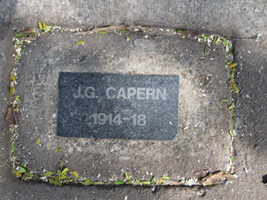 |
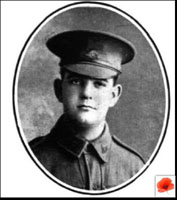 |
 |
The 1993 plaque |
Jack Capern 1916 |
Originally marked by a flame tree #76 (to be replaced). Note that Capern's plaque is surrounded by clumps of Dianella caerulea Lucia ornamental grass. |
Jack Cummings Capern was born in Watson's Bay, Vaucluse, Sydney on 29 November 1899 to Reverend Cummings Air Capern (formerly of Kent, England) and Lizzy Varis Capern (née Austin). He had an older brother Percy, a twin Henry, and later had siblings Frank, William, Euphan ("Effie") Mary and Frederick. The family shifted to Maryborough (Queensland) for Rev. Capern to take up a position as Congregational Minister. They subsequently moved to Rosewood.
Jack became a linotype mechanic working for a newspaper business. He was employed with the Wide Bay Burnett News at Maryborough and subsequently at the Brisbane Newspaper Company (Brisbane Courier). He enlisted with the army on 11 January 1916 at the tender age of 18 years 2 months and was placed with the 3rd Machine Gun Company.
Jack travelled by train to Melbourne where he embarked for England aboard A35 Ulysses. It reached Sierra Leone on 5 December 1916 and he changed ships to arrive in England on 28 December 1916. Jack was transferred to the 4th Division Machine Gun Coy in February 1917 and began training at Durrington Camp, Wiltshire.
The 4th MG Coy left for France on 7 September 1917 and arrived France the day after. Illness (tonsillitis) forced Jack back to England but he was back with his mates in early March 1918 (and being promoted to Lance Corporal). They were quickly reminded of home when they were able to vote in the Queensland election on 8 March 1918 at Neuve Eglise, Belgium. In late March the Fourth Division was rushed to the Somme region to stem the German Offensive. There it repulsed the advancing Germans in hard fought battles at Hebuterne and Dernancourt.
In August 1918 the Battalion was in Cachy (on the Somme, France) firing the howitzers at the enemy and receiving shrapnel and gas in retaliation. For much of early August it was rainy and boggy with few suitable targets so the guns were pretty silent. On the 6th they were back at billets and details of a "big operation" became known. The War Diary records "If good weather lasts, success is assured for the stunt".
At midnight on the 7th/8th August the Battalion started moving toward Hamel. Ten guns of 4 MG-Coy went forward in Mark V Star tanks to the "blue line". The remaining six guns of the Company went forward at 2.30 am with the Reserve Battalion for defence of ground between red and blue lines. It was very boggy and difficult to move the guns. Half the tanks broke down and the Company received considerable casualties late the morning of the 8th. There were many more casualties from the German 0.77 field guns. Jack was killed during this tank advance (8 August 1918). The Company lost 2 killed, 17 wounded. On the 11th, the Company moved back to their billets.
Jack was buried the next day at the Memorial Plot Heath Cemetery but was later reinterred at the Cerisy-Gailly New French Military Cemetery.
 |
Australian War Memorial Roll of Honour October 2018 (J Hawker) |
Daniel Carter - Junction Park State School - KIA, France
Arthur and Anne Carter (née Fitzgerald), married in Brisbane in 1891 and had four children: Fanny (b 1992), Daniel (born 15 December 1894), Thomas William (b 1897) and Elizabeth Martha (b 1899) - all born at Milton, Brisbane. The family shifted to Herbert Street, Annerley, Brisbane where the children attended Junction Park State School. Daniel had been a member of the cadets - C Coy, 9th Bn - and he enlisted in the army on 15 April 1916 at the age of 21 years. His Regimental Number was 2406. At the time he had been working as a gardner and also as a steward aboard a dredge in Moreton Bay.
Daniel proceeded to England aboard the Saang Choon from Brisbane on 19 September 1916 and arrived in Plymouth 10 weeks later. After some training in England, he departed for France on 15th March 1917 as part of the 49th Bn Reserves aboard the S/S Victoria from Folkestone. His Regimental Number was changed from 2406 to 2406A. He was taken in to the 32nd Bn (of the 8th Brigade, 5th Division) at Bernafay in France on 19th March as part of a large number of reinforcements.
The German Army had already withdrawn to the Hindenburg Line allowing the British front to be advanced and the 32nd Battalion participated in the follow-up operations. The 32nd battalion subsequently missed the heavy fighting to breach the Hindenburg Line during the second battle of Bullecourt as the 8th Brigade was deployed to protect the division's flank.
Much of the next 7 months was spent in training, patrolling, bayonet practice, gas training, musketry, building roads, and more roads, and building pontoons. They had some contact with the enemy at Bapaume in May while patrolling but that was an exception.
The only large battle in 1917 in which the 32nd Battalion played a major role was Polygon Wood, fought in the Ypres sector in Belgium on 26 September. On September 25th 1917, the 32nd Bn had moved to the front at Ypres. At that stage the Batallion had 48 officers and 945 ORs (Other Ranks). There were some casualties and as men were killed, wounded or fell to illness, reinforcements were sent in. November and December saw them in trenches at the front where they experienced heavy shelling, enemy raids on posts and even spotted enemy aircraft. By mid-December they were out of the trenches and in reserve back in Boulogne. On Christmas Eve, they prepared for a big day and their commanding officer reported that "All companies had a splendid Christmas Day. Nearlly £250 was spent from Regimental Funds for poultry etc etc. GOC 8th Bde [Lt Col Charles Davies] visited. Games were played and concerts were held after dinner". New Year's Day was a day of rest and the Batallion photo was taken on 2nd February 1918. For the rest of the month the batallion trained, had competitions, awards, and games of football. The 32nd v 29th Australian Rules was won by 32nd by 7 points "an excellent game".
The 32nd Bn was to march from Desevres on 31st January to the front at Messines and relieve the 11th Bn. Men had to carry an overcoat, waterproof sheet, iron rations, towel, shaving gear and dry rations for 1st February. They also had to carry 21 magazines per gun. The men began moving forward at 4pm with 5 minute intervals between companies. Daniel Carter was in A Coy - the Reserve Company. They relieved the 11th Bn at Gapaard near Warneton (Belgium) on the 1st February as planned but it was surprisingly quiet. "The weather was good and the men were in excellent heath and good spirits".
For the next two weeks the enemy was not sighted although there was heavy artillery fire and trench mortars received. The men felt stale after such a long time in the trenches, especially when it was so oddly quiet. However, that was about to change for Daniel. He was a part of a raid by troops on the enemy line but the barbed wire had been insufficiently cut by artillery and the troops could make no progress. They had to turn back. Daniel was hit by gunshot in the back and side. He and four men and one officer were wounded and quickly taken to the 53rd Casualty Clearing Station at Bailleul. Daniel died of wounds the next day (20 February 1918). The day after that the 32nd Bn was relieved by the 58th Bn and headed back to safety. They had just 21 days in the front. It was relatively quiet but Pte Daniel Carter was one of the men who gave his life in those 21 days. He was buried in the Bailleul Communal Cemetery Extension, Nord, France.
Four weeks later the casualty list appeared in the Brisbane Courier. It was Casualty List 386 and gave the circumstances for 119 Queenslanders. It began with a poem by John Oxenham:
They died that we might live- Hail!- and Farewell!- |
In 1923 Daniel's mother wrote to the army requesting his medals (Victory Medal and British War Medal) but Mr and Mrss Carter had shifted from Herbert St Annerley to Soden Street Yeronga and after Daniel's death on to Brookfield (near Indooroopilly) without notifying the army. The parcel was sent back from Soden Street to the army but eventually found its way to Daniel's parents. These medals and a photo of Daniel in uniform (shown above) were presented to the Stephens Sub-Branch of the RSL by the family and they now adorn the wall in the foyer.
 |
The author taking notes at Daniel Carter's weeping fig (June 2015). "When I was at Yeronga State School in Grade 7 and 8, we had our Christmas break-up parties under this tree.
Our teacher, Miss Trickey, would organise games after we'd eaten a mountain of watermelon and cake. I always brought cherries. Always the cherries. I remember it fondly". [Richard Walding] |
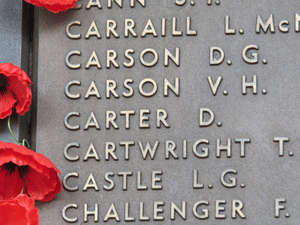 |
Australian War Memorial Roll of Honour October 2018 (J Hawker) |
Thomas James Carey - KIA Gallipoli
 |
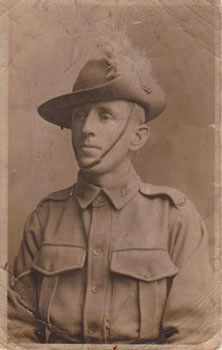 |
Thomas James 'Jim' Carey - December 1914. (June Carey) |
|
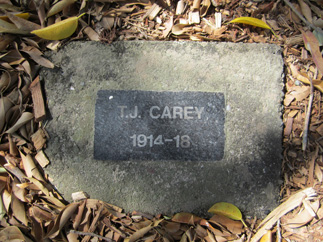 |
.jpg) |
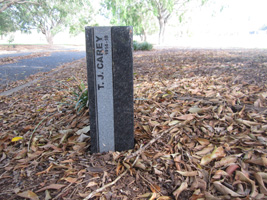 |
Replacement plaque installed in 1993 |
Tree 94 - A big old weeping fig that has survived to this day. |
The current plaque installed in 2012 |
Thomas James "Jim" Carey was born in Lisburn, County Antrim, Northern Ireland on 1st July 1881 to parents William and Anna Eliza Carey (nee Lowry). His father was tailor at 9 Lombard Street Belfast in a partnership trading as McCartney and Carey Merchant Tailors. His siblings - all born in Belfast too - were Arthur (b 1883), Annie (b 1888), Maud (b 1890) and William (b 1896). The family home was 251 Albertbridge Road, Belfast. It was a very handsome bay-fronted house on one of the main roads of East Belfast. It was in a very well-to-do area of Belfast in those days and is a largish house. Jim, in fact, was the 8th great grandson of Mary Boleyn (mistress of King Henry VIII) and her husband Sir William Carey.
Jim, as he was known to all and sundry, attended the local public school but had a private tutor for his later studies. He left Ireland in about 1900 and seems to have become a merchant sailor working aboard the Cumbrian destined for South Africa. Here he deserted ship on 11th July 1902 and on 4th October that year joined the Cape Mounted Police in Natal, South Africa, stationed at Durban. After two years he decided to quit and was 'discharged by purchase' (that is, he paid to get out of the army; about £18 at the time). This was quite a sum for that time, equivalent to several months' pay, and designed to stop men leaving.
Jim became a seaman and in 1907 (10 August) in Belfast at the age of 26 qualified as a 2nd Mate for foreign-going ships. He married Gertrude 'Gerty' Louisa Heaney (b 4 Dec 1880) on Thursday, 25th June, 1908, at the Belfast Registry Office. Jim then completed his 1st Mate's ticket on 23 December 1909. He was now qualified to be 1st Mate on foreign-going ships or 2nd mate on square-rigged sailing ships. Jim came to Australia on board the Bremen leaving Antwerp on Sunday, 2nd October, 1910 and arrived in Brisbane on Monday, 21st November 1910 (51 days). His name is not on the passenger list but is thought he worked his passage on the Bremen considering he was a Merchant Seaman.
Jim and Gertrude took up residence in Raymond Terrace South Brisbane, not far from the Ship Inn Hotel. Jim continued to work as a marine officer and they had a son Edric Cecil Carey who was born in Brisbane on 3rd April 1911. He was known as "Cecil". Gertrude stayed home to raise him, their only child. On the 9th May 1914 Gertrude died of tuberculosis and was buried at the Toowong Cemetery. Cecil went to live with his aunt Florence Keown (Gertrude's sister) and uncle Richard Keown in Yeronga. They became Edric's guardians as Jim was away so often.
On 1st October 1914, at the age of 33, Jim joined the army in Brisbane and was sent to the Exhibition Grounds for training. He was placed in the 15th Battalion (Reg. No. 866). Few of the men had military training - in fact 85% had none - so Jim's experience was invaluable. He was promoted to Lance Corporal on 14th October in D-Coy with 115 other men and 3 officers. They continued training at Enoggera and headed off by train for Sydney in mid-December. Then it was off to Melbourne again by train where they boarded HMAT A40 Ceramic on 22 December bound for the Middle East.
The ship arrived on 3rd February 1915 and the Battalion trained at Aerodrome Camp at Heliopolis until 11th April. It was then they found out they were not going to France but to Gallipoli. They embarked the Seang Bee on 12th April arriving at Lemnos on the 15th. Jim's Company (now F-Coy) witnessed the British landing at Cape Helles as they passed by and anchored off Anzac Cove at 4.30pm that same day. Two companies were disembarked under heavy shrapnel fire. It is not known if Jim landed in this first wave or in the second one at 12.30am the next morning. Nevertheless, all companies were ordered to occupy a position between the 1st and 2nd Brigades up on the ridges until 30th April.
Jim kept a diary of the events. It is now in the possession of his grand-daughter June Carey. June let me photograph the diary:
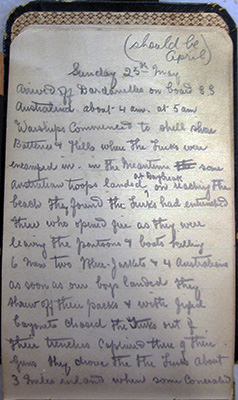 |
Sunday 25th April Arrived off Dardanelles on board SS Australind about 4am. At 5am warships commenced to shell shore Batteries and Hills where the Turks were encamped in. In the meantime some Australian troops landed at daybreak on reaching the beach they found the Turks had entrenched there who opened fire as they were leaving the pontoons & boats killing 6 men two Blue-Jackets & 4 Australians. As soon as our boys landed they shrew off their packs & with fixed bayonets closed the Turks out of their trenches. Captured three of their guns. They drove the Turks about 3 miles inland when some concealed Maxims and artillery opened fire on them mowing them down in dozens. The shrapnel from the Turkish artillery doing great execution. Most of the officers being shot down. 11-0 pm Landed and went into trenches. |
| Jim's Diary for the 25th April 1915 | Click on this link to see the full transcription |
Following this, the Battalion was sent up to Monash Valley where they inflicted severe casualties on the enemy at Pope's Hill for the next two days. They earned a rest so they were bivouacked in Monash Valley for the 4th and 5th May and were joined by Captain Quinn and party. It was then time to rejoin the fight.
Jim wrote more in his diary:
Monday 26th [April] Thursday 29th [April] Friday 30th [April] Saturday [1st May 1915] |
Sunday [2nd May 1915] Monday [3rd May 1915] Tuesday [4th May 1915] Wednesday [5th May 1915]. [This was the last entry in Jim's diary]. |
Half the battalion (not including Jim) was sent back to Quinn's Hill to relieve Captain Pope. Enemy snipers were causing heavy casualties. Then on the 7th the other half of the battalion (including Jim) relieved their first half at Quinn's Post. Jim left his diary behind in his kit (and his last entry is shown above).
On May 9th the Commanding Officer Major Godley decided to attack the enemy trenches in front of Quinn's Post - a distance of between 25 to 100 yards away. This was planned for 9pm but was postponed until 10.30pm when the assault was made and the Turkish trenches taken. However, the trenches couldn't be held and the men were instructed to withdraw to their original position at 6am the next day (10 May). The word to evacuate was not passed to all of the men in the trench Jim was in. Five men at one end didn't get the message so they stayed - unaware of the evacuation. The enemy made a determined counter attack and entered the trench from both ends. The five men made a dash for a small unfinished communications trench opening out of the trench proper. Two men got away but three were shot. Jim was one of the three shot and killed, as was Pte Ernest Sidney (863). Ernest was shot as he scrambled up the side of the unfinished sap. There were heavy casualties -160 killed or wounded during the withdrawal. The names Monash, Quinn and Pope would go down in history.
 |
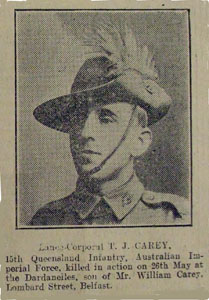 |
The Queenslander |
The Belfast Evening Telegraph |
Jim was buried at Anzac Cove, Gaba Tepe that same day with Rev. C. W. Moore officiating. His death was reported in Australian papers (31st Casualty List) on 5 June 1915. The photo from The Queenslander is shown above. The Belfast Evening Telegraph also carried his name and photo although the date is wrong [please see credit and note at the end of this entry].
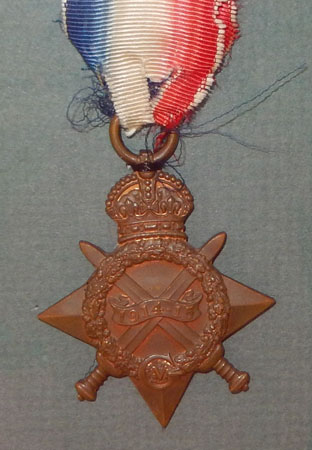 |
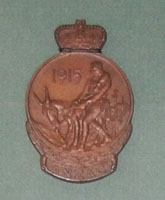 |
This Anzac Commemorative Medallion was issued to Jim's family in March 1967 for service in WW1. |
|
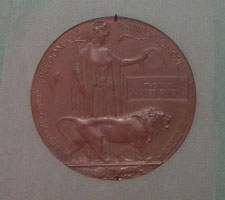 |
|
Jim Carey's "1914/15 Star" No. 14214 was issued to his son Cecil on 27 August 1920. Over 2 million of these were issued individually to soldiers of The Great War. Jim was also honoured with a "Victory Medal" (No. 6540 on 12 September 1922) and a "British War Medal" No 6565 on 6 May 1921. (June Carey) |
This is the "Memorial Plaque" issued to Jim's son in 1920. It reads "Died for Freedom and Honour" and has his name "Thomas Carey" engraved on the obverse. These were commonly known as "The Dead Man's Penny". (June Carey) |
In January 1916 Jim's son Cecil and his guardians Florence and Richard Keown shifted to Buderim just to the north of Brisbane. Cecil eventually married (to Carrie Campbell 1918-1964) and they had two girls and a boy. Cecil died in 1977.
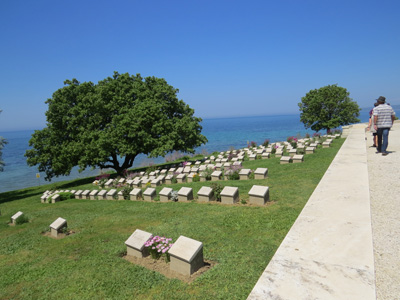 |
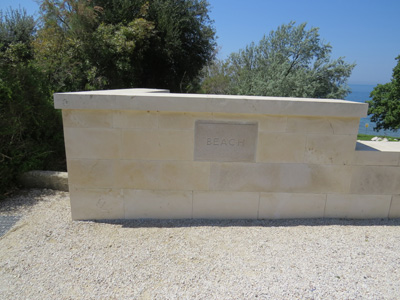 |
Thomas James Carey was buried at Beach Cemetery to the southern end of Anzac Cove. Jim Carey's headstone is to the left as you look at the photo. (Jim Hawker) |
Beach Memorial at Anzac Cove. (Jim Hawker) |
 |
 |
| Jim Hawker placed a poppy on Jim Carey's grave during a visit on Anzac Day 2013. He said "before I departed Australia, I collected six small stones from the grounds of Yeronga State School with the view of leaving them in Gallipoli beside the name of each of the Stephens diggers". You can see the Yeronga stone on Jim Carey's grave. | A group of Australian diggers are memorialised at Beach cemetery. Jim Carey is at top left. Note the ornamental grass. (Jim Hawker) |
The photo of Tom 'Jim' Carey in the Belfast Evening Telegraph was supplied by Nigel Henderson info@greatwarbelfastclippings.com. He has over 100 newspaper photos of Australian service personnel of Irish origin who died in WW1 and were pictured in the paper. Nigel is happy to be contacted by relatives in Australia for copies. Firstly, have look at his Belfast Evening Telegraph webpage at www.greatwarbelfastclippings.com
MIRANDA ROBON'S VISIT - APRIL 2015
As part of the Anzac Centenary in April 2015, Year 10 school student Miranda Robson from Moreton Bay College, Brisbane, visited Pte Thomas Carey's grave at the Beach Cemetery, Gallipoli, to pay her respects. She never knew 'Jim' Carey, nor is she related, but was inspired by the life of this soldier from south Brisbane. Here are a few photos from Miranda:
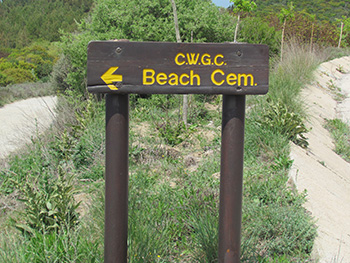 |
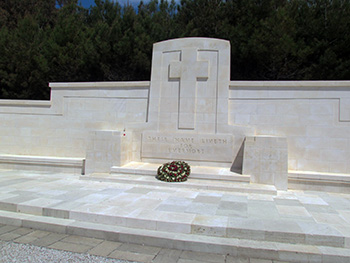 |
Beach Cemetery is on the left hand side of the coast road, situated on what was known as Hell Spit, at the Southern point of Anzac Cove. (Miranda Robson) |
It was used right from the day of the landing at Anzac. There are 391 Commonwealth servicemen of WWI buried or commemorated in this cemetery. (Miranda Robson) |
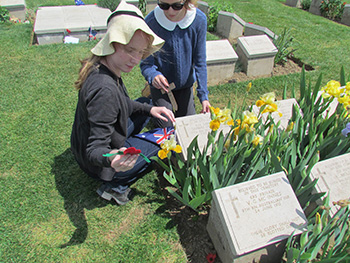 |
 |
Miranda and friend Caitlin Ramsay - also from Moreton Bay College, Brisbane - place the flower, flag and cross on Jim Carey's grave - 30 April 2015. (Miranda Robson) |
A few words finished Miranda's visit. (Miranda Robson) |
I asked Miranda what it was like visiting his grave. She said:
It was a bit of a walk from the bus I guess, but took only a few minutes. It was a warm day, but there was a lovely cool breeze and blue skies. It took a few minutes to find the grave, but when I did, there was a short feeling of triumph and excitement, but then I only felt incredibly sad. I placed the little knick-knacks I had collected - a flag, a little wooden cross that an Australian primary student wrote a thank you on, and a felt poppy - around the grave. Everyone else was moving around, mostly looking at Simpson's grave nearby, but I stayed there. I had planned words on the bus, however, when I got there they simply left my mind. I read the words on his grave, but all I could think of was words from another grave from a few days earlier, with a name at the time I had memorized. I remember the words inscribed on his grave: 'Well done my darling. Sleep on.', and when I read them at the time they were sad, and I just wanted to cry. We left shortly after, but that feeling didn't leave me for the rest of the day. |
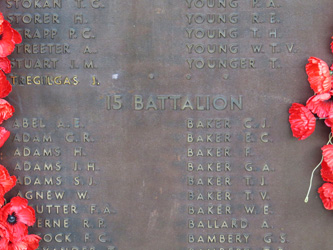 |
 |
Australian War Memorial - Canberra. Here begins the names of the fallen from the 15th Battalion. (Jim Hawker) |
Australian War Memorial. Thomas 'Jim' Carey - 15 Bn. (Jim Hawker) |
Andrew Clark
 |
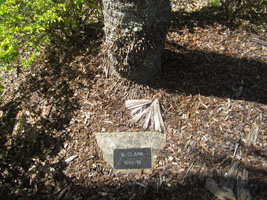 |
 |
The 1993 plaque still remains in the ground near the Cenotaph. |
You can see Andrew Clark's plaque in front of this palm tree. |
Tree 47 - flame tree (since died) |
Andrew Clark was born at his mother's home at 314 Great Eastern Road, Parkhead, Glasgow on 17 March 1892. His parents were Andrew Clark (Snr) and Joanne Clark, nee Dunn. They were married in June 1891 but his father was working as a warehouse packer and lived at 96 Gray Street, Glasgow at the time of Andrew's birth. His mother was a mantle worker and lived in her family home with her parents. They had a second son James. The boys attended school at Strathclyde, Glasgow.
In 1910 the family emigrated to Australia. They boarded the Everton Grange in Glasgow and arrived in Brisbane on 30 January 1911. Mr and Mrs Clark were aged 47 and 41 respectively, and Andrew was 18, and James 13.
Andrew obtained a job at the Ross River Abattoir in Townsville. In May 1915 there was a dispute at the abattoir about the employment of German nationals - given the war with Germany had been going for 10 months. There was more trouble at the Council quarry and the local newspaper (Townsville Daily Bulletin) stirred up nationalistic feelings with its headline "Call to Queenslanders" in June calling for all able-bodied men to volunteer for the army. The Council renamed German Gardens as Belgian Gardens to make their opposition to all things German clear. Andrew heeded the call and was in Brisbane the next month signing up for the duration of the war. It was 23rd July 1915 when he joined and he was placed with the 25th Battalion for training at Enoggera.
With him at enlistment was best mate Henry 'Harry' Burns of similar age. They met at enlistment and became firm friends - discovering they were both from Glasgow and that Harry lived at Hozier St, Glasgow just 13 miles east of Andrew's family home. Harry was also placed with the 25th Battalion.
After two months training the two mates were ready to head off overseas with the AIF. Andrew's parents organised a 'farewell gathering' at their home at Sandy Creek in Brisbane. This is the old name for the suburb of Tarragindi. It was a big event; all residents of the district and other friends attended a big party on Saturday 2nd October 1915 at which 'many handsome and useful presents' were presented to Andrew and Harry. Musical items were provided by Messrs and Mesdames Pollock, Anderson and Ross, and Messrs Anderson, Mc Culloch and Brown-Miller. [Brisbane Courier 5 Oct 1915, p19].
Andrew and Harry departed Brisbane aboard HMAT Seang Bee on 21 October 1915 for the Middle East. In Cairo, Andrew was transferred from the 25th Bn to the 9th Bn (4 March 1916) and after some more training headed off to France arriving in April 1916. His mate Harry was sent to England where his found out about his mother's death and that his sister was left to fend for herself in Glasgow. He went absent without leave (AWL) for three months as he returned to Glasgow to look after his now-unemployed sister Deborah in Bridgetown, Scotland. He was tracked down by the police, arrested, court martialled and given 6 months jail. This was commuted to 60 days forfeited pay and he was sent off to France to fight.
Andrew, meanwhile, was fighting in France but had become sick. He was sent back to England in May 1916 for treatment of a hernia, nevertheless he was back in France to rejoin the 9th Bn in September 1916.
Throughout 1917, the 9th Battalion was engaged in operations against the Hindenberg Line. Andrew became sick with scabies in July but was back in France in August. A month later - in Belgium - he was eligible for a fortnight's leave in England and he took advantage of it. It is not certain where he went but it would be likely that he headed up to Glasgow to see his grandparents (Andrew and Margaret Clarke, and James and Ellen Dunn).
When he returned to Belgium in September 1917 the 9th Bn was in the Steenvorde area doing training, although they were in and out of the Dominion trenches as well. Artillery shelling was very heavy on both sides but there were moments of silence. In December they were in the Passchendaele-Zonnebeke area and then in the new year they were in Messines - in the front line.
In early 1918, the capitulation of Tsarist Russia allowed the Germans to concentrate their strength on the Western Front, and they subsequently planned for a major offensive in March. So in February the 9th Bn was training for this action and by the end of the month were working in the Support Lines in the Crater Dugouts in Hollebeke, Belgium.
Early March 1918 saw the 9th Battalion in the front line, relieving the 16th Bn. On the 5th March, at about 6pm, they suffered heavy gas shell bombardments from the Germans in the area of Fusilier Walk and the valley nearby. It lasted about 3 hours but the gas hung around all night. The use of gas shells by the enemy was very troubling. On the 6th, there was more heavy gas shelling from 4pm and lasting 4 hours. In the diary of Lt Ernest Henry William Meyers (C-Coy, 9 Bn) there is reference to this gassing. Ernie wrote that he had been in the front line for seven days:
 |
27 th Wednesday left Neuve |
| Lt Ernest Meyers - 1917 | This extract from Lt Meyers' diary is the essence of brevity: he merely noted "gassed by Hunn". It shows how commonplace these events had become. (Courtesy of grandson Roger Sak) |
Twelve officers (including Lt Meyers) and 150 Other Ranks had been evacuated "gassed" on the morning of the 7th. Many died before they made it to hospital, others died in hospital, and many more were sent home to Australia unfit for service. Ernie Meyers made a full recovery only to be blown up by another gas shell in August that year. He was awarded a Military Cross with two bars for his bravery, and returned home safely to Australia in 1919.
Andrew had escaped harm as his company was on front line scouting duties at the time of the gassing and not in the trenches. From the 8th March onwards Andrew's Company (B-Coy) was providing a working party to fix trenches and barbed wire.
On the 10th March, B-Coy was shifted from their billets in the Tournai Camp to Victoria Dugouts so they would be nearer their daily work. They were doing work on the embankments on the northern edge of the Ypres-Comines Canal and railway excavations. Andrew was popular with the men in his platoon (6th). A mate said "he was fond of a drop and when he was tight he would say I'm not drunk, I'm poisoned".
On 19th March 1918 Andrew was working on the canal bank in the Spoil Bank area when a German gas shell came in and exploded near him. His mate Pat Doyle (6011) was second next to him and saw Andrew hit. There was a lot of gas hanging around at the time. Shell fragments wounded Andrew in the arm, thigh and knee. His mate in the same platoon (VI Platoon) - Bert Daley - dressed his wounds and the Field Ambulance stretchered him out to the Casualty Clearing Station (CCS). The combination of the gas and wounds were too much. Andrew died at the CCS the same day and was buried at the Outtersteine Communal Cemetery Extension, Balleul also on the same day. The CCS Chaplain Rev. G. Harding officiated. This was important for his Free Church (Presbyterian) parents who were keen to know that he was buried in consecrated ground (as were most parents).
Two memorials were proposed to recognise Andrew's supreme sacrifice. One was in Honour Avenue at Yeronga (see photos at top) organised by the Stephens Council. The other was a cairn, a flagpole and a crow's ash tree (Flindersia australis) erected in a small area of parkland at the intersection of Fernvale Road and Andrew Avenue, Tarragindi. Andrew Clark was believed to be the only person from the Sandy Creek district who was killed in the war. The memorial was paid for by the local Sandy Creek Progress Association at a cost of £30 ($1200 in today's money), and a crow's ash was planted there in 1925. An adjacent area of land beside the avenue, donated by local families, was also dedicated to the memory of Andrew Clark.
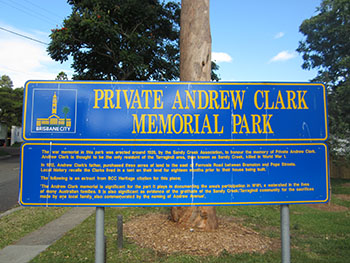 |
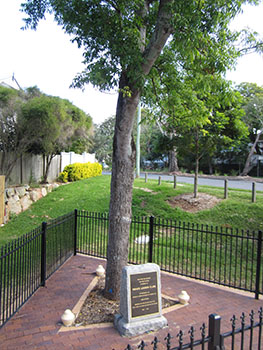 |
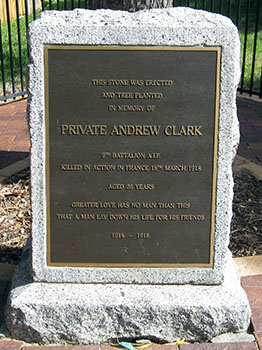 |
The tree was originally enclosed by concrete kerbing, with ornamental stops at the three corners. |
Brisbane City Council restored the memorial by replacing the original cairn with a new plaque set in stone, as well as installing paving and fencing. |
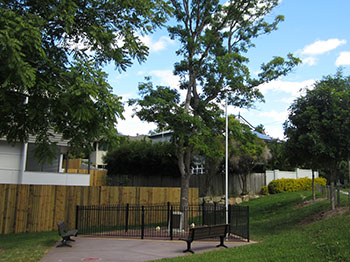 |
 |
| In 2004, the site where the memorial stands was transferred from a road reserve to parkland. |
Hence the street name. |
Private Andrew Clark's father - Andrew Clark (Snr) - died in 1949, his mother Joanna died in 1952, and brother James in 1964.
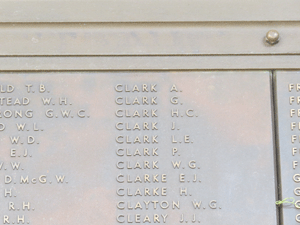 |
Australian War Memorial Roll of Honour October 2018 (J Hawker) |
John Clark - wounded, missing, mistaken, and KIA
 |
 |
|
Flowers from Yeronga State School students near John Clark's tree after their Anzac Service - 24 April 2014 |
Pte Clark's plaque was placed beside a weeping fig (#13) in 1918 but it has since died and yet to be replaced. |
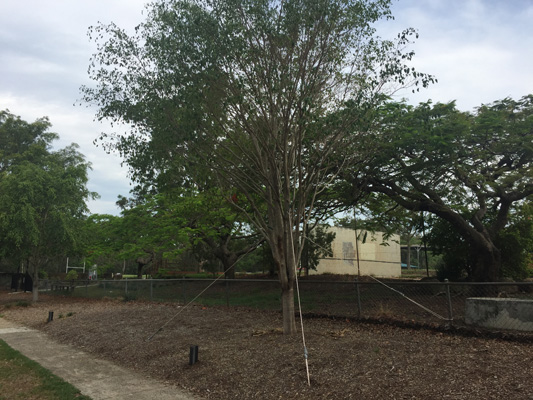 |
| In 2016 a weeping fig was planted beside John Clark's plaque. This replaced the original fig. Well done to everyone involved. Let's hope it survives this time. (R. Walding 7 December 2016) |
All the men commemorated here deserve their story to be told but some stories seem a tale of extra lonliness. John Clarke was one of eleven children of James and Winifred Clarke of Wagga Wagga New South Wales. When he joined the army in July 1915 he claimed to have been just 43 years 8 months old but it seems more likely that he was really about 48 and concerned about being too old to enlist. John was a shearer and engine driver who had come to Queensland with two of his brothers - Thomas and James - in the late 1800s but had lost contact with them. Their parents were both dead; his mother in 1886 and his father in 1915. John joined the 25th Battalion in Brisbane and embarked 2nd Reinforcements aboard HMAT Shropshire on 17 August 1915. While the rest of his battalion headed to Egypt for training, John became ill with influenza and was transferred to hospital in Malta. He rejoined the unit on 17 October 1915 at Gallipoli and was soon manning the trenches.
The 25th Battalion, however, had a relatively quiet time because the last major Allied offensive had been launched, and turned back, in the previous month. Again he suffered from influenza and was sent to hospital in Alexandria while the rest of the 25th stayed on until evacuation of the peninsular on 18 December 1915 thence returned to Egypt. John rejoined his unit in Tel-el-Kebir (Egypt) and travelled by ship to Marseilles in March 1916. The 25th was the first AIF battalion to arrive there. Now fighting as part of the 2nd Division, it took part in its first major battle at Pozieres between 25 July and 7 August 1916. Daily, waves of men - John Clarke included - tried moving forwards across the trenches but were constantly repulsed by the barrage of shells - and thus met with little success.
On the 5th August John was caught in a massive counter attack by the enemy and was supposedly "evacuated wounded" along with nine officers and 126 ORs (other ranks). On that day 24 ORs died and one officer and 178 ORs were missing. In the course of this two week battle the 25th Battalion suffered 785 casualties. At first John was recorded as "wounded" but when they could find no trace of him changed this to "wounded or missing" on 11 October (1916). His next-of-kin brother Thomas could not be tracked down and it was discovered he had died so it was up to his sister Sarah Winifred Gunnell - now in Sydney - to deal with the army. She wrote in March 1917 inquiring of his condition and they replied in May that year that they had yet to locate him. When still no trace of him could be found a Court of Enquiry by the CO of the 25th that year (25 July 1917) changed his status to KIA - killed in action. The Red Cross reported that after a search of all French hospitals they could find no trace of him either. It would seem from reading his files in the National Archives that the army may have brought some of this upon themselves.
The medical file of another Private John Clark - a 33 year old butcher from Victoria with a Service No. of 1780 - has been inserted into the file of Pte John Clark from Brisbane (No. 1789). The names are identical and the numbers, sometimes written in thick pencil in a field hospital, look alike. They both left Australia in mid-1915, were sick upon arrival in the Middle East, recovered and went to Gallipoli together, and were sent back to Egypt ill. John Clark from Victoria was recommended for discharge as medically unfit in August 1916 and sent back to Australia. John Clark from Brisbane was sent to France and went "missing" at the same time (5 August 1916). It is not hard to believe that the John Clark from Brisbane was thought to have been sent home. That is what is in his medical file. He, however, is not lost - he rests in the fields of Rue Marle near Armentieres in France. His medals and personal effects were sent to his sister after the war.
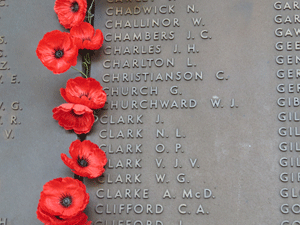 |
Australian War Memorial Roll of Honour October 2018 (J Hawker) |
Fergus John Clarke
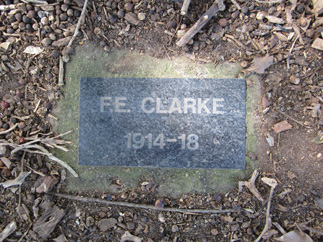 |
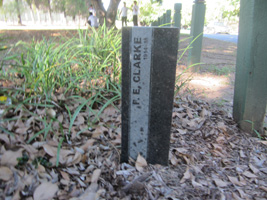 |
49th Bn - died in France in 1917. |
Clarke's tree (#48) was originally a flame tree but it has since died and not been replaced. Note the Dianella caerulea Lucia ornamental grass. |
Fergus John Clarke was born on 15th August 1898 in South Brisbane but lived in the small town of Taroom in the Banana Shire of Queensland, about 400 km NW of Brisbane. His father Charles Clarke was born in London in 1851 and married Elizabeth Baird (aka Bird) and had three children: Charles Edward (1890), Sidney (1892), and Fergus John (1898). Charles (Snr) owned the Taroom Hotel on the corner of Dawson and Yalwynd Streets and it was where the family of five resided. In 1902 the hotel burnt down and Charles (Snr) separated and left Queensland for Auckland in New Zealand. Mrs Clarke rebuilt the hotel, and in 1906 applied for, and received, a Licensed Victualler's License. Mr Clarke, it seems, left New Zealand for San Francisco in 1909.
Fergus attended boarding school at The Southport School (TSS) on the Gold Coast south of Brisbane. Here he was a Senior Cadet for two years. After school, in 1912, Fergus moved to South Brisbane where he became a barman, no doubt having skills he developed as a child at the Taroom Hotel. Brother Charles returned to Taroom to manage his mother's hotel. Sidney took the plunge and married Lilian Violet Williams in 1913 and had a son Charles Fergus Clarke the following year. They lived in cattle country in central Queensland.
Fergus enlisted in the AIF on 30 August 1915 and was placed with the 13th Reinforcements of the 2nd Light Horse Regiment. He embarked HMAT A36 Boonah and departed Sydney on 22 January 1916 arriving in Egypt in March where he joined his unit.
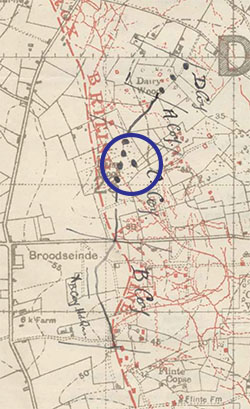 |
Trench map showing where Fergus Clarke was killed (blue circle). The map has been taken from the War Diary of the 49th Bn. (Sheet 28NW D23.b.1.3). |
Once in Egypt Fergus undertook some training and was seconded to the 1st Light Horse Regiment for six weeks. He patrolled and scouted on the western side of the Nile mainly around the town of el-Bahnasa, protecting the Nile valley from bands of pro-Turkish Senussi Arabs. A the end of April 1916 Fergus rejoined the 2nd Light Horse Regiment and continued patrolling in the same area - near towns such as Sohag, Kantara and Romani. This continued for many months. On 18 May, as part of its parent brigade, it joined the forces defending the Suez Canal. Brother Charles had enlisted in the 14th Light Horse Regiment (A-Squadron) in the previous November (1915) in Brisbane and he had arrived in Egypt in May 1916.
Fergus and Charles were sent to England in August and September, respectively, for training. Fergus was then off to France at the end of December 1916 and joined the 49th Battalion in the field at Flers. The battalion participated in the advance that followed the German retreat to the Hindenburg Line and supported the 13th Brigade's attack at Noreuil on 2 April 1917. Later in the year, the focus of the AIFF's operations moved to the Ypres sector in Belgium. There the 49th fought in the battle of Messines on 9th June and the battle of Polygon Wood on 26th September. Another winter of trench routine followed. Apart from a couple of weeks in hospital with an abscess Fergus had now spent the past five months in and out of the trenches of France. Charles meanwhile had been transferred from the 14th Light Horse to the 49th Battalion but had spent most of 1917 in England either sick or in training.
In October 1917 the 49th Battalion was still at Ypres. On the 9th the Brigade took over the front line relieving the 6th Brigade. During the advance Fergus was wounded in the leg by an enemy shell and taken to Bn HQ to have it dressed. On his way to the major Dressing Station he died. By then it was 12th October 1917.
By now Mrs Elizabeth Clarke appears to also have died, so it was just the two sons left: Sidney, who was in Queensland, and Charles (Jnr) in France. Both brothers were beneficiaries of Fergus's will but Sidney, even though younger than Charles, acted as Next of Kin. Charles continued in France before being repatriated to Australia in April 1919.
Fergus is remembered on the Taroom War Memorial, The Southport School Honour Board, and of course in Honour Avenue at Yeronga.
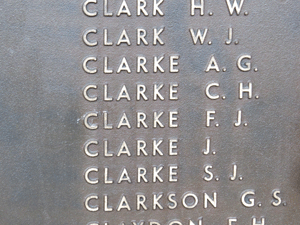 |
Australian War Memorial Roll of Honour October 2018 (J Hawker) |
Christopher Arthur Clifford
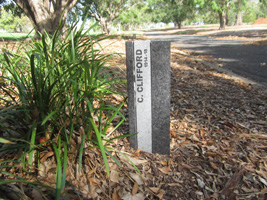 |
.jpg) |
Tree 95 was a flame tree but it died and has not been replaced. |
Clifford's ornamental grasses are growing well in the shade unlike teh Flame Tree. |
Christopher Arthur Clifford was born in Paddington, Sydney, to parents Christopher Clifford and Ellen Clifford (nee Irwin). They had married in Sydney in 1899 and had three children: Sarah Jane (1899), Elizabeth Elsie (b1893) and Christopher Arthur (b1896). Mother Ellen ("Nellie") died in 1904 when the family was still in Sydney. After her death they came to Brisbane where the father worked as a Horse Hair Drafter (collects and grades horse hair for use in leather upholstery). They lived at Thompson's Estate at Annerley.
The children attended Junction Park State School but Mr Clifford (Snr) went insolvent in 1909. Christopher (Jnr) did his three years of compulsory Senior Cadet training with Military Area 9A (includes Annerley) followed by two years with the Citizens Forces (9th Infantry and Artillery) while became, and worked as, a school teacher. He tried to join the army but was rejected because he was under-standard for chest size (was 32.34", a half-inch too small).
Christopher enlisted in the AIF in Brisbane on 25 January 1917 - with his father's written permission. He became known as "Charlie" and was called up on 27 March 1917. He took a train to Sydney and embarked on the HMAT Hororata A20 for England, arriving in August. Charlie was placed with the 7th Training Battalion at Rollestone on the Salisbury Plain for four months and then headed off to France.
He caught up with the 25th Battalion (B-Coy) in January 1918 when they were at Warneton on the Belgian border. The batallion fought to turn back the German spring offensive in April, and then participated in battles at Morlancourt, Hamel, Amiens and along the Somme Valley and having a great deal of success.
At the start of August 1918 the 25th Battalion was at Blangy-Tronville on the eastern outskirts of Amiens. They relieved the 19th Battalion at Villers Bretonneaux about 6km to the south where they prepared for an attack in the 8th August. They did this successfully but sustained a number of casualties. From the 10th to the 31st August 1918 they had rest, drill and practice in anticipation of a big advance on the 2nd September - The Battle of Mont St Quentin.
On the 1st September the Battalion was held up on the banks of the Somme River. It was raining and they had to be ready to move at 15 minutes notice. By noon it was fine. At 5.40pm they moved to their overnight bivouac positions and were there at 8pm. It was time for a sleep and then be ready for the attack. Zero hour on Monday the 2nd of September was 5.30am so at 5.00am they moved to their jumping-off positions. The objective was a section of German-held trench to the east about two miles away (see the red line on the right in the map below). A-Coy was to the left, C-Coy to the right, and D-Coy was in the middle but 100 yards further behind. Charlie Clifford's platoon was in B-Coy and they were 100 yards behind D-Coy.
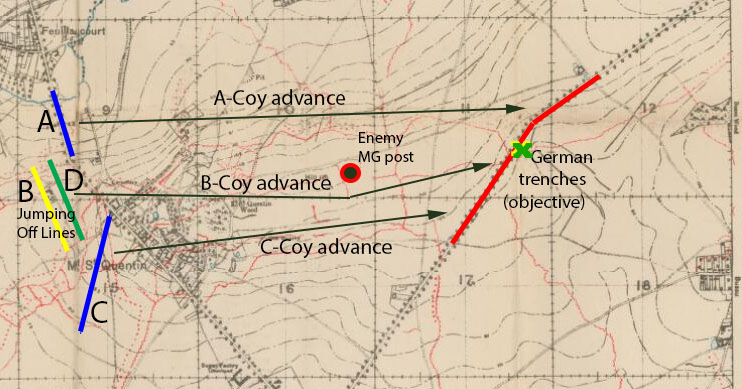 |
This map has been taken from the C63 NW Trench Map (1:20000) as used by the 2nd Division AIF in their planning. I have added the coloured lines to show the advance of the troops on the 2nd August 1918. The green cross to the right is where Christopher "Charlie" Clifford was killed and where he was buried. You can see the town of Mont St Quentin 2000 yards to the left. Each of the big squares is 1000 yds x 1000 yds. |
At Zero Hour the men advanced in artillery formation consisting of a line that followed a rolling barrage of shells from their artillery. As A-Coy and C-Coys advanced they moved apart to leave a gap in the centre. D-Coy came up to fill that gap. However, the German machine guns were so "hot" that the men became pinned down as the artillery barrage kept advancing towards the Germans. It meant that the enemy machine gunners able to fire at the advancing Australians. The battalion rushed the trenches and silenced all of the MGs except one (see big red dot on map above). The Australians went around the sides to get at it from the back but by then the Germans had retreated.
The German trenches were taken at 7.20am and the objected achieved (the red line in the above map). The men started digging-in and cleaning out the trenches. Charlie Clifford was doing just that when a German "whizz bang" (a high velocity shell fired from a German 70mm cannon) came in and exploded beside him. It literally blew him to pieces and he died instantly. The green cross on the map above shows the position of where he was killed and buried. It was 8.15am on 2nd September 1918 and he was just 22. One officer and 28 other ORs (Other Ranks) were also killed.
The 26th Battalion relieved them that afternoon and his mates from 26Bn Frank Graham (5013) and Bill Uhr (5759) buried him that night. A grave was dug 25 yards behind the trenches and Chaplain Rev. Gregor McGregor from Fitzroy, Melbourne, said a prayer and consecrated the ground. A simple wooden cross was erected and Charlie's ID disc and name were attached.
The next year his body was reinterred into the Peronne Communal Cemetery a mile to the south.
 |
A plaque mounted in the road beside Clifford's plaque. The text is shown below. The original design for Honour Avenue was a straight line to the Cenotaph (Memorial). This avenue runs east to west. This is the only place where the land flattens out enough to see from one side of the park to the other. During the Great Depression of the 1930s, unemployed men were given the work curving this memorial avenue to meet the gates on Ipswich Road. Why Honour Avenue was curved remains a mystery. Perhaps it was changed to connect both entrance gates. |
 |
Australian War Memorial Roll of Honour October 2018 (J Hawker) |
Joseph Horace Cloughley
 |
 |
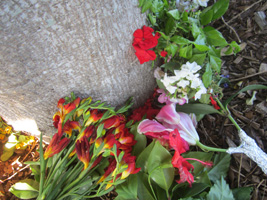 |
|---|---|---|
Joseph Cloughley's tree (#14) was originally a weeping fig planted in September 1917 but it died. In 2015 it was replaced with a new weeping fig grown from cuttings of the original figs. |
|
Flowers from Yeronga State School students on a nearby tree after their Anzac Service - 24 April 2014 |
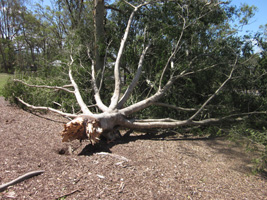 |
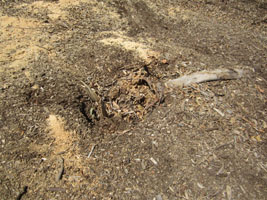 |
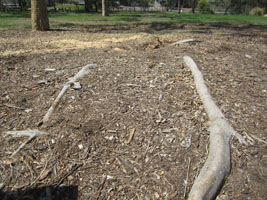 |
The weeping fig blew down in the storms of November 2014 (John Huth, 29 Nov 2014) |
The Council removed the tree and all that remains is the rotted stump... |
..and the aerial roots. (Richard Walding 16 December 2014) |
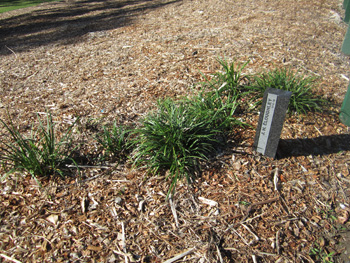 |
 |
The ornamental grass is growing well (June 2015). |
The replacement weeping fig was planted on 24 April 2015 during the Yeronga State School Anzac Ceremony. However it is about 5 m from the name plaque. |
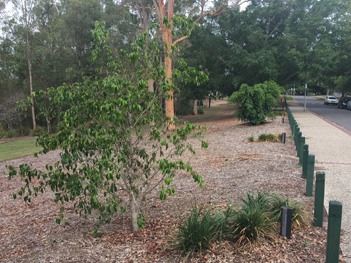 |
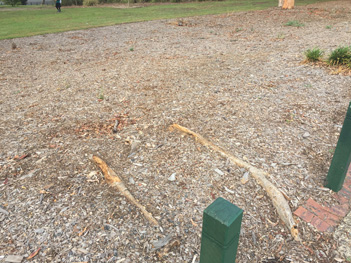 |
| Good news - the weeping fig planted on Anzac Day 2015 has been shifted to the correct position. Bad news: it doesn't look very healthy (7 Dec 2016). R. Walding. | Some of the aerial roots from Cloughley's original (1917) tree remain. Nice bit of history. |
Joseph Horace Cloughley was born in Brisbane in 1898 to William Cloughley and Annie Hannah Marie Cloughley (nee O'Neill). They were married in Brisbane in 1891 and had six children: Mary, William John, Albert Sidney, Joseph, Annie Daisy and Lawrence Bryan. The first daughter Mary died at a few days old, and first son William died as a six-month old.
The children attended Junction Park State School and afterwards Joseph obtained work as a jeweller's apprentice. He was also in Cadets for four years. Mr Cloughley was an instructor in carpentry at the Blind, Deaf and Dumb Institute in Cornwall Street, Annerley. The family lived in Prince Street, a few doors away from the Mitchell family, whose son Harold, would also be off to war.
First to enlist was younger son Albert, a carpenter like his father, who joined in March 1915 at the age of almost 20. They put him in the 6th Reinforcements 9th Battalion and sent him off on 12 June 1915 aboard HMAT A63 Karoola and was in Egypt before Joseph enlisted. But then he got sick and couldn't do much until he was out of hospital in November.
Back in Brisbane in the meantime, Joseph enlisted in the AIF on 17 September 1915 at the age of 18 (Regimental No. 4472) as part of the 14th Reinforcements, 9th Battalion. He was due to sail with the rest of this group on HMAT Wandilla in 30 January 1916 but this was cancelled, and he was transferred to the 16th Reinforcements in February and finally sailed out with them aboard HMAT A16 Star of Victoria in March 1916. They arrived at Port Said in Egypt in May and he was transferred again, this time to the 49th Battalion while in camp.
His brother Albert had already been transferred to the 49th Battalion (in March). Joseph met up with him in camp in Cairo and they both and left for France in June (1916) with the rest of the 49th. They began their training at Pernois, about 25 km North of Amiens, then route marching practice, drill and after more training at Rubempre 20 km to the east. The 49th moved into the trenches of the Western Front for the first time on 21 June. It fought in its first major battle at Mouquet Farm in August and suffered heavily, particularly in the assault launched on 3 September 1916. The battalion saw out the rest of the year alternating between front-line duty, and training, and labouring behind the line.
Joseph showed promise as a gunner and was sent to England to attend a four-week Lewis Gun training school at Enfield. He was incapacitated with illness for some months but finally rejoined his unit at Buire in March 1917 where they headed north and participated in the advance that followed the German retreat to the Hindenburg Line, supporting the 13th Brigade's attack at Noreuil on 2 April. In April and May, the focus of the AIF's operations moved to the Ypres sector in Belgium. Albert rejoined the unit on 30 May 1917 after a long stint in hospital with tuberculosis. The battalion was about to fight in the battle of Messines on 7 June. The objective for the 13th Brigade was to capture two lines of trenches. Of this the objective for the 49th Battalion was to take right side trenches from O28.d.23 to O34.b.35 (the red line drawn I've drawn in the map below):
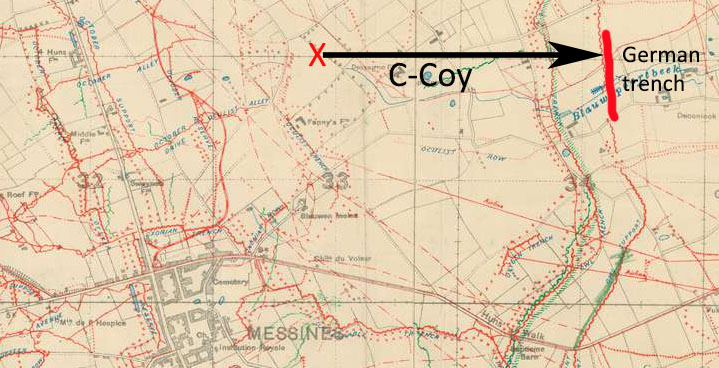 |
Trench map from the 13th Brigade's War Diary. This map is dated 8th June 1917 and has the various trenches marked on it as they stood after the battle on the 7th June when Joseph died. I have added a red cross to show the "jumping off" point for the advance, a black arrow to show the direction of the advance, and a red line showing the section of the German trenches captured on the 7th. Joseph was killed somewhere near the head of the arrow. |
Zero hour at Messines was 2am on the 7th June 1917. The men steadied themselves for the assault at 11.30am. The time arrived and a creeping barrage of artillery shells began about 150 yards on their side of the objective. This curtain of falling shells moved forward at 30 yards a minute until it reached the green line. There it continued for 15 minutes and then was raised (started rolling past the line) and continued moving forward. This was the cue to begin the assault. Their jumping off point was O27.d.00.
C-Coy was on the right, with D-Coy on the left but they noticed that the barrage was falling short and some of their own men were getting hit. They finally made their objective but with terrible losses. Only two of the 12 officers that started made it; the rest were casualties. The four company commanders were killed: Captains Francis Harvey "Frank" Bridgman (A-Coy), Herbert Walter "Reedy" Rhead (B-Coy), Francis Bert "Frank" Kay (C-Coy) and Hubert George Selwyn-Smith (D-Coy). Joseph was killed during the advance. He got a bullet in the head. Pte John Manuel (5125) was beside him when he was shot and said the men of C-Coy couldn't stop to help; they had to continue their advance so they left him there. On the way back they saw him lying at the bottom of Messines Ridge near the New Zealander's trench and buried him nearby. They put a marker on the grave with his name, number and battalion. He was buried by the men of C-Coy.
Mr Cloughley wrote to the army asking that all correspondence be sent to his work address, no doubt as Mrs Cloughley was not dealing well with the stress on one dead son and another stricken down with TB.
His brother Albert made it through the war unscathed (apart from TB) and returned to Australia in 1919. Harold Mitchell, the Cloughley's neighbour in Prince Street was killed in action on the same day at the same place. Harold was in the 47th Battalion.
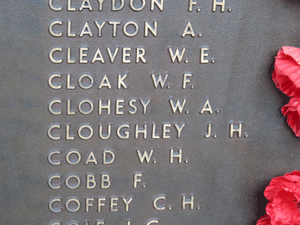 |
Australian War Memorial Roll of Honour October 2018 (J Hawker) |
Basil Hope Colefax
 |
.jpg) |
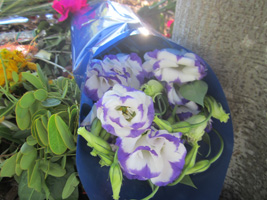 |
Bazil Colefax's wife Vera and her mother Emily were present for the planting of his tree on 15th September 1917. |
Bazil Colefax's tree (#6) is a weeping fig and the original still stands: big and quite majestic. | Flowers - 24 April 2014 |
Bazil Hope Colefax was born in May 1892 at Maclean, on the north coast of New South Wales, about 200km south of Brisbane. His parents were James Colefax and Elizabeth Baipton Colefax (née Trape). They married there in 1875 and had six children: William, Albert, Lilian, Alice, Cecil and Bazil.
Bazil shifted to Brisbane and lived in the Stephens Shire but it is uncertain where, but probably Yeronga. He became good friends with Olley Carl Rush as they were in the same athletic club - the East Brisbane Harriers. The Harriers would compete in various carnivals but the main one was the Queensland Amateur Athletics Association annual competition. Both Bazil and Olley competed with distinction. Bazil worked as a labourer. Olley was a railway porter who lived with his parents at Hyde Road, Yeronga.
On 14 August 1915 Bazil enlisted in the army in Brisbane (No. 3714). He was placed with the 12th Reinforcements, 15th Battalion. As a matter of interest Olley Rush had also enlisted a few days earlier (Reg. No. 3834, 12 August) and was in the same batallion. The other runner from their club to enlist was Charles Cantrell (3311). The Chairman of the East Brisbane Harriers was forced to close the athletics season early as three of his top runners were off to the war. In September the Club had a farewell evening for the three soldiers and presented them each with a 'wristlet watch'. By this stage Bazil had become a close friend of Olley's sister, 19-year-old Vera Ivy Rush, and they were married on 6th November. It was a rush as Bazil was about to head off to war (in just over 2 weeks in fact). So quick, in fact, Bazil's mother Elizabeth didn't get time to come up from Tweed Heads (northern NSW) for the wedding.
Bazil Colefax and Olley Rush took a train to Sydney and embarked aboard HMAT Suffolk on 23 November 1915 for the Middle East. Upon arrival at the Tel-el-Kebir Training Camp (100km north of Cairo) he joined the rest of the 15th Battalion and was immediately transferred to the newly-formed 47th Battalion. After three months training, particularly with the Lewis Gun, Bazil and the 47th were off to France (2 June 1916) aboard HMT Caledonia along with 27 Officers and 980 ORs (including Olley). They arrived Marseilles a week later ready to head north to the Western Front.
On 1st August 1916 the battalion began to take up positions near Pozieres. They became the reserve for the front line troops of the 48th Batallion. On the 7th August the four companies of the battalion were called up to reinforce the front line. The A, C and D-Coys went ahead and B-Coy followed in close support. Bazil Colefax was the Lewis Gunner for B-Coy. During this "stunt" (as the soldiers called it) Bazil received a shell wound to the head, with concussion, and less serious wounds to his body. He was taken to the 13th Field Ambulance Hospital to the south but died of his wounds on 9th August (1916) and was buried the next day at Warloy-Baillon Cemetery, Somme. He was 24. His friend Olley Rush had been killed by a shell three days earlier (6 August) in a trench a mile south at Contalmaison.
Of the three athletes from the East Brisbane Harriers, Olley Rush and Bazil Colefax were now dead, and Charles Frederick Cantrell (3311, 49th Bn) would last four more weeks when he was shot in the head on 4th September while crossing No-Man's Land at Moquet Farm on the Somme.
The army notified Bazil's mother Elizabeth of his death as she was listed as the next of kin on his enlistment. Bazil had not notified the army that he married after enlisting. His widow Vera heard about the death of her brother (Olley) before she found out about the death of her husband Bazil. The army explained that it was Bazil's mother that they had as a contact. Bazil's father was to die in 1918.
In the years that followed there was dispute about where Bazil's belongings should be sent. His mother asked for his Victory Medal but the army explained that the order of precedence was: widow, eldest surviving son, eldest surviving daughter, father, mother. Vera was sent the medals. She remarried in 1921 to Herbert Hartley and shifted to Casino, NSW.
A notice in The Queenslander Saturday 23 September 1916, page 9, read:
COLEFAX. Died of wounds received in France, August 9th, Basil Hope Colefax, third dearly beloved son of J. and E. Colefax, Tweed Heads, and loving husband of Vera Colefax, and loved son-in-law of E. S. and E. J. Rush, Hyde-road, Yeronga, a true Australian, aged 24 years. In loving memory of the above two Magpies, who have had their last fly. |
The "two magpies" were probably Bazil Colefax and Olley Carl Rush.
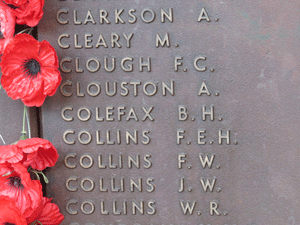 |
Australian War Memorial Roll of Honour October 2018 (J Hawker) |
John Henry Cooper
See John Henry Hooper (misspelt as Cooper on the Cenotaph).Lionel Stuart Doolan
 |
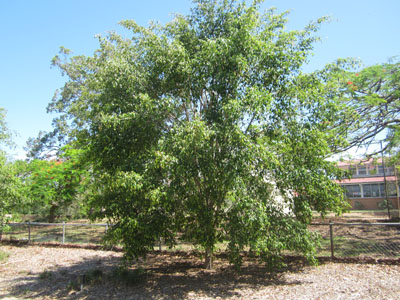 |
Pte Lionel Doolan - 9 Bn. He died in France on 5 January 1917. |
Doolan's tree (#15) was originally a flame tree planted in September 1917 but has since been replaced by this white fig (Ficus virens). |
 |
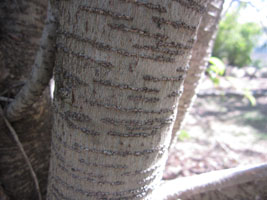 |
 |
Pte Doolan's white fig: dark green leaves andlight green underneath. |
The bark is light to medium grey with some bumps and ridges. |
The tree is also known as a curtain fig or banyan tree. |
Lionel Stuart Doolan was born in Brisbane in 1892
to parents William John Doolan and Florence Mercy Doolan (née Porter). He had two older sisters Vere and Ina, and later, a younger brother Colin and two sisters Hilda and Marie. Lionel was a commercial traveller and by the time he came to enlist three of his siblings had died (Hilda 1899, Colin 1905, and Vere 1914).
Lionel enlisted in Brisbane on 3 January 1916 at the age of 24 and was placed with the 20th Reinforcements, 9th Battalion. He embarked HMAT Clan McGillivray on 7 September 1916 and arrived in Plymouth, England, 2 November 1916. Lionel undertook training and then was sent to France (as an Acting Corporal). He joined his 9 Bn unit in France on 1 January 1917. Lionel's task was to help lay cable from various posts to Battalion HQ at Fleurs, France.
On the 5th January 1917, at about 5pm, the day was drawing to a close. The (A-Coy) men had finished laying cable for the day and were walking single-file along a trench making their way back to their billets. They were about 150 yards away from HQ. A German shell landed in the trench and killed four men and wounded three. Lionel Doolan was killed "on the spot" [as the War Diary records] along with his friends George Stenhouse (6317), Herbert Ball (6222), and Harry Bradshaw (6223). Other friends came to bury Lionel and the other men. The four men were buried that night alongside one another at a rough grave about 20-30 yards from where they fell. It became consecrated ground and a small wooden cross was placed in the graves by one of their mates - Pte Arthur McNab (6336).
 |
Australian War Memorial Roll of Honour October 2018 (J Hawker) |
Robert Douglas
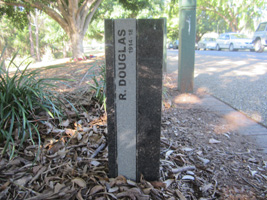 |
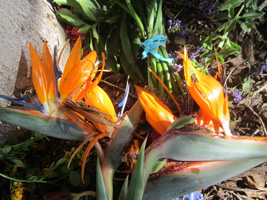 |
Douglas's tree (#16) was originally a flame tree but was replaced with ornamental grass in 2012. |
Flowers from Yeronga State School students after their Anzac Service - 24 April 2014 |
 |
 |
| On Anzac Day 2015 this weeping fig was planted next to Douglas's plaque. However, originally it was a flame tree that marked the spot. After representations by John Huth to the BCC, the tree was removed and the grass left to commemorate the original planting. Good work everyone as it preserves the original layot. | This photo shows Douglas's name plaque in the middle distance on the right. The tree closest is Cloughley's weeping fig and ornamental grass, followed by Douglas's ornamental grass and the small bushy green tree after that is Freeman's replacement weeping fig (planted Anzac Day 2015). This photo was taken 7 December 2016. |
Robert Charles Douglas came out to Australia from Ireland in 1914 when he was 21. He was born in the town of Lurgan, County Amargh, (Northern) Ireland in February 1893 to James Douglas and Mary Douglas (née McCollum). His sister Minnie Douglas stayed in Ireland and was his next-of-kin.
Robert enlisted in the 3rd Reinforcements, 47 Bn, in Brisbane on 10 January 1916. He was working as a tailor at that time. He departed Brisbane on 1 May 1916 aboard HMAT A46 Clan McGillivray and arrived for training in England in August 1916.Two months later he was off to France to join the 47 Bn. Robert was sick for a considerable time and had to recuperate in England. Eventually, he rejoined his unit in May 1917 at Messines. A major offensive was about to take place beginning on the 1st June. The me were ready. The War Diary reads (6 June 1917): "Never before in the history of the Bn was so much preliminary work bestowed on a Bn and never was it more fitted for adventure such as this." On the 7 June the operation began. They moved out of their camp at Bulford at 7am and by 11:10 am they moved forward into attack, heading for Wytschaeff Ridge near Messines. Robert was killed that day in action from enemy fire. For the operation carried ou on 7 June, 74 were killed (including Robert), 326 wounded, 2 gassed and 37 were missing.
Robert was buried 750 yards east of the Messines battlefield. He left his belongings and most of his pension to his sister and grandmother in Ireland. A small part of the pension was left "to another alottee" in Australia. We may not know who this was and whether he was in Brisbane in 1916 to be with this person.
 |
Australian War Memorial Roll of Honour October 2018 (J Hawker) |
Note: There is another soldier with the name "R. Douglas" associated with Yeronga - but not the same one memorialised in Honour Avenue as he surviuved the war and returned to Yeronga in 1917. He was Reginald Clive Slater Douglas born on the 11th November 1895, to parents Alice and William Douglas. Click the name to see his entry under Christ Church.
Harry "Snow" Dutney
.jpg) |
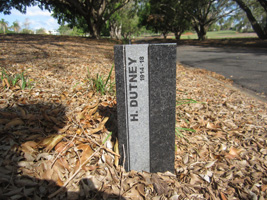 |
Harry Dutney's tree (#77) was a weeping fig planted on 23 August 1919. It is still there today: big and majestic. |
Memorial plaque installed in 2012. |
Harry Dutney was born on 30 May 1897 at Rosewood - a small township about 60 km to the west of Brisbane - to parents George Herbert Dutney and Elizabeth Clarke Dutney (née Elder). When Harry was born he had two younger brothers -Herbert and Charles - and two younger sisters - Emma and Jessie. Subsequently George, Barbara, David and Florence were born. George (the father) was a grazier.
They attended Rosewood State School and when Harry was just 13 years and 2 months old he was appointed a pupil-teacher at the school. He was subsequently appointed a teacher and at the time of enlisting was so employed. Harry became very well known and well respected in the Rosewood district, not only as a teacher, but as a talented horseman. He became known as "Snow" Dutney. Harry spent five years with the Colonial Forces (Militia) and then spent 1½ years on the Instructional Staff training Senior Cadets. His parents moved to "Hardeen" in Park Road abutting the Yeronga School and park, and the latter children attended Yeronga State School.
On 1 March 1917 Harry enlisted in the 14th Reinforcements of the 31st Battalion in Brisbane. He travelled by train to Sydney where he embarked HMAT Hororata for Liverpool, England, on 14 June 1917. Harry arrived in England on 26 August and was sent to the Training Depot at Hurdcott. After training for many months Harry was ready for the Western Front and left Southampton on 12 February 1918 to join the 31Bn, and was promoted to the rank of Sergeant. After six weeks of poor conditions and sanitation Harry developed Trench Foot and was sent back to England (Ontario Military Hospital) for treatment.
Sgt Harry Dutney returned to the 49Bn at the front in France on 19 June 1918 and was immediately detatched to support the 11th American Corps on the Hindenburg Line. On 30 September, Harry took his platoon "over the top" at Bullecort and was killed by enemy fire. He was buried that evening at a makeshift grave on the top of a ridge near Strongport. It was consecrated ground.
His brother George Frederick enlisted in the AIF upon turning 18 but was demobilised when the armistice was signed.
In the Courier Mail on 29 September 1922, Harry's parents commemorated his death in France with the words:
Beloved son, |
 |
Australian War Memorial Roll of Honour October 2018 (J Hawker) |
Lt John Raymond Fairlie - Gallipoli then meningitis.
 |
Fairlie's tree (#4) - was a flame tree that died and has not been replaced. |
John Raymond Fairlie was born in Goulburn NSW on 20 September 1895 - although his birth certificate records him as being a Fairle. His middle name comes from his mother Kathleen Mary Raymond, daughter of Samuel and Catherine Raymond of Goulburn. His father was Leslie William Julian Fairlie, a British subject, born in Dinan, a town near the Brittany coast of north-west France in 1859. He was a mate aboard the (British) Orient Line merchant ships Austral, Ormuz and Lusitania sailing the Sydney-London route and from 1891 the second officer then Captain aboard The Ophia - a new steel twin screw steamship of the Line. John's family on his mother's side were highly respected and influential settlers in Australia in the 1800s.
His mother Kathleen was daughter of Samuel Raymond BA, LLB, a barrister in Goulburn - who arrived in Australia from Ireland in 1837 to become Deputy Sheriff of Port Philip in 1841 and Magistrate for NSW in 1838. Kathleen's mother was Catherine Sophia (née Bull) eldest daughter of Captain John Bull a graduate of the Military College, Sandhurst, and an officer in the 78th Highlanders who exchanged into the 99th Regiment, then under orders for New South Wales. He is most remembered in John Fairlie's family for three things: being a NSW magistrate (like Samuel Raymond); a civil engineer in charge of the western road from Penrith to Bathurst; and son of Colonel Bull CB, KH, Royal Horse Artillery, who fought at Waterloo.
John Fairlie had a younger brother, Percy, and two younger sisters, Nesta and Nerina. He grew up in Goulburn and to complete his education he moved to Brisbane and enrolled at Yeronga State School:
This extract from Queensland State Archives Enrolment Register [ID 868280] shows that John Fairlie was enrolled as Number 2127 on 9 March 1904 at the age of 8 years 6 months. Father's occupation is "sailor". The column headings shows that he left school in June 1907 (for Brisbane Grammar in 1908) but returned in April 1911. |
On departing Yeronga State School he was enrolled at the prestigious Brisbane Grammar School in 1908 at the age of 13 years 6 months but may have returned to Yeronga State School. In Brisbane he lived with his uncle Edward Denny Day Jnr and aunt (Fanny Louisa Day, née Oram) at their home "Avoca" in Yeronga, near the Brisbane River. Day was the son of Edward Denny Day Snr, of Maitland NSW who was married to John's great aunt Margaret Raymond. Day (Jnr) had come from the village of Avoca in County Wicklow, Ireland, hence the name of his home in Yeronga. The home has become famous in the area, giving its name to the street and to one of the "Houses" at the nearby Yeronga State High School. Day was the manager of the Royal Bank of Queensland and gave John a job as a clerk. John also had become a Captain (part-time) in the 9th Infantry Battalion, Queensland Defence Force.
With such an illustrious background, John was quick to enlist in the army at the start of the war and did so on 27 March 1915 at the age of 29 years 7 months. He was placed as a sergeant in the 25th Battalion, Machine Gun Section. He undertook training in Brisbane and eventually left Australia aboard A60 HMAS Aeneas on 29th June 1915 bound for Gallipoli. He arrived in Suez on 2nd August and trained at Cairo for the next month being promoted to 2nd Lt on 3rd September. He left for Gallipoli the next day and arrived at Anzac Cove a week later. Within 6 weeks he had become jaundiced and was looked after at the 7th Field Ambulance Station on the Anzac beach. He recovered enough to join his battalion two weeks later. He became sick again as the troops pulled out of Gallipoli and was sent to Alexandria for treatment. This time it was for meningitis. Meningitis was running rampant amongst the troops and in about 38% of cases it was fatal. He died on 13th February 1916 and was buried at the Ismalia War Cemetery the next day. In 1918 both Mr and Mrs Day died, whereas his father lasted until 1923, and his mother until 1936.
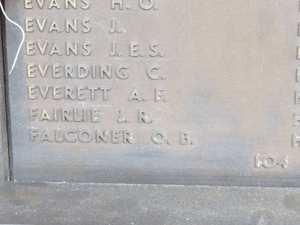 |
Australian War Memorial Roll of Honour October 2018 (J Hawker) |
James Fielding - one of the first to fall at Gallipoli
 |
.jpg) |
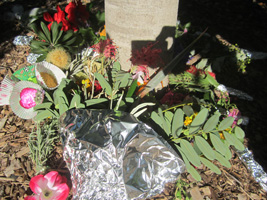 |
Love the ornamental grass. |
Tree 17 - a small weeping fig has replaced the original planted on 15 September 1917 that died many years ago. The Brisbane City Council takes cuttings from the original figs to propagate the new ones. |
When you look up close, many of these flowers from Yeronga State School students come from their own gardens (24 April 2014) |
 |
 |
| On Anzac Day 2013, Jim Hawker, the Secretary of Stephen's RSL, visited Gallipoli. At Lone Pine Cemetery to the southern end of Anzac Cove on 26th April he placed a poppy beside the name of James Fielding in the memorial for the men with no known grave. (Jim Hawker) | Here we see Lone Pine Cemetery the day after Anzac Day 2013. Jim Hawker collected six small stones from the grounds of Yeronga State (Primary) School and left them in Gallipoli near/on the name of each of the Stephens diggers. (Jim Hawker) |
James Fielding was a butcher from England. He grew up with his family in Sheffield and attended Pye Bank School in Pitsmore, Sheffield under the tutelage of Mr Atkinson the School Master from Birley Carr in Sheffield. Upon finishing school James became a butcher at the local Oughtibridge abattoir. At the age of 20 or so he headed off to Australia and then Fiji where he stayed for 16 months. But a bad case of dysentery there forced him back to Brisbane and eventually to enlist at the outbreak of the war. It was just two weeks after Britain went to war that he enlisted in the 26 Battalion.
James embarked Brisbane, 24 September 1914 aboard HMAT Omrah for the Middle East. He became close friends with Bill Lewis (172) who was in in the same Company (A-Coy) as him. The Company Commander was Lt John Perrier from Melbourne. After a few months training in Cairo James then embarked Alexandria aboard the Ionian 2 March 1915 to join the Mediterranean Expeditionary Force (Anzac) at Gallipoli.
A-Coy and B-Coy were the first two companies of 9 Bn to land on the beach at Anzac. The two companies landed at 4.30am on 25 April 1915 (Anzac Day) just to the south Gaba Tepe. They made a dash for cover under Turkish rifle and machine gun fire, but had to press on so as not to hinder the advance of the main body that was to follow. Sometime that morning James was shot through the heart and died. His best friend Bill Lewis saw it happen and helped bury him where he lay. His officer, Lt J. M. Perrier did not see him shot but heard about it from other Company members later.
In the hectic first day of Anzac, no record of his grave was kept and he was duly reported missing in action, Gaba Tepe, 25 April 1915. A Court of Inquiry was held in the field France, 5 June 1916, to decide his fate. After interviewing Bill Lewis and Lt Perrier the army pronounced James's fate as 'killed in action, Gallipoli, 25 April 1915'. He is memorialised at The Lone Pine Memorial (Panel 31), Gallipoli.
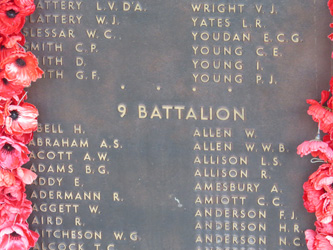 |
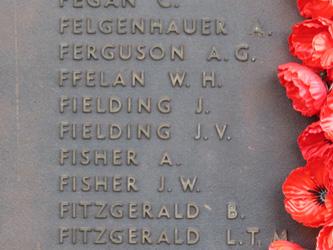 |
Australian War Memorial - Canberra. Here begins the names of the fallen from the 9th Battalion. (Jim Hawker) |
Australian War Memorial. James Fielding "J. Fielding" - 9 Bn. (Jim Hawker) |
Trees were generally planted in Honour Avenue by relatives of the fallen. In the case of James Fielding, his relatives were overseas and the tree was planted in September 1917 by Lt Col Ferguson DSO, MID, an officer in the 26th Battalion. James's mother Alice Fielding in Sheffield England used her contacts to ensure her son was honoured in this way. Lt Col Ferguson was a good choice as he had rendered conspicuous service in Egypt, Gallipoli and France, and represented the State Commandant, Brigadier-General Irving.
Eric Chapple Flay
 |
.jpg) |
 |
Dianella caerulea Lucia ornamental grass is used to accompany the plaque. The plaque should read "E. C" Flay not "E. G" Flay. |
Flay's tree (#49) was weeping fig that died and has been replaced by a smaller weeping fig. The Council takes cuttings from the original figs to propagate the new ones. |
Flowers from Yeronga State School students after their Anzac Service - 24 April 2014 |
Eric Chapple Flay was born on 3rd March 1895 in Gympie, a small town to the north of Brisbane. His parents were George Sturgess Flay and Julia Flay (nee Chapple). His father, George, was born in Wiltshire England in 1861 and migrated to Queensland aboard the Scottish Knight in June 1881. Eric's mother Julia was the daughter of Gympie hotelier James Chapple and she had emigrated to Queensland with her parents and brother as a 9 month old in 1870. The Gympie gold rush was in full swing so the family headed for Gympie where Mr Chapple took over the Gympie Times newspaper.
Eric's parents - George and Julia - married in Gympie in 1887 and George became proprietor of the Freemason's Hotel there. They had six children: Elsie, Roy, Ivy, Eric, Guy and Myra.
The family moved around and the children attended various schools. Eric attended Fortitude Valley State School and Southport State High School and became a talented sportsman - mainly in football and cricket. He became a blacksmith and had worked for over four years with Joseph Woodhouse, engineer and toolmaker, at his general blacksmith shop in Boggo Road (Ipswich Road) South Brisbane.
By now (1912) the Flay family had shifted to Annerley where Mr Flay was proprietor of the Junction Hotel (where the Stephens RSL now meets). Their son Roy had died in 1898, Elsie and Ivy had married and left home, and Eric was working. That left the youngest children Guy and Myra at home and they attended Junction Park State School next door. The Flays became heavily involved in the school: Mr Flay was a committee member of the school's Parents & Citizens Committee and Mrs Flay would donate drinks for the fete. They also donated a flag and flagpole to the school. Mrs Flay became a committee member of the Stephens' Red Cross. Eric became well-known as an all-round sportsman and squeezed in 4 years with the Citizens Forces (probably Area 9A, training at Junction Park State School). Eric was with Queensland Railways when he decided to enlist in the army.
On 10 Jan 1916 he was accepted into the 11th Field Company Engineers with the AIF (Reg. No. 9447). For Anzac Day that year (25 April) he was given a flag by his parents and he carried it in the Anzac March through town. He was to take the flag with him overseas. Eric departed Australia in May and arrived in England in July 1916. His engineering skills saw him being promoted to Lance Corporal the following month.
In October 1916 Eric had leave in London. He wrote to his parents "By jove, we are well-liked over here and everyone looks after us and treats us well. We walked past Andie Fisher (Australian Prime Minister Andrew Fisher) in London. He saw the plumes in our hats and said 'Hello there, good old Queensland'". Eric also visited Buckingham Palace and watched the changing of the guard.
Eric departed for France in November but was infested with scabies for a second time and spent a few weeks in hospital, eventually rejoining his unit in February 1917. In June the unit moved Messines with the 11th Brigade and worked on shelters, trenches, wells, dugouts and so on. The continued with this until September 25 when they headed for Ypres.
In October 1917 Eric's unit had just arrived at Ypres and placed in billets. Their job was to lay tapes for jump-off points for a forthcoming attack (3rd Battle of Ypres). On the 4th October the 3rd Division was to attack on a two Brigade front of 1100 yards with the 11th Brigade on the right and 10th Brigade on the right. At 7am Lt Henry St Aubyn Murray (CO, 3rd Section, 11th Field Coy) - an Adelaide architect - gathered a party of men to advance behind the infantry. The party included half of No. 3 Section (including Eric), two surveyors, half of No. 4 Section, 41st Artillery Battery, 50 attached infantry and four pack mules.
The party pushed forward to the top of Broodseinde Ridge immediately behind the attacking infantry and reached the newly captured Green Line on the 11th Brigade front at midday. The party constructed and wired three strong points (see map below). A 9.2 inch high explosive (HE) German shell came in and exploded near Eric. He was killed instantly as was a second sapper. His mate Percy Burbidge (375) from Gympie was with him when he died. Stretcher bearers were called and Lt Murray returned to HQ at 5pm.
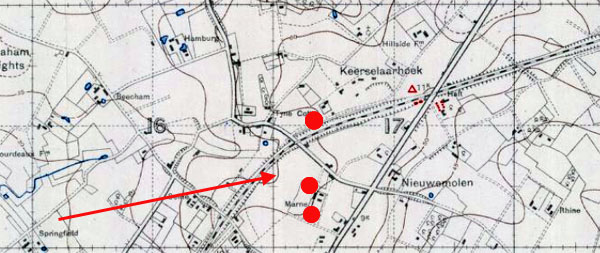 |
This section of the Gravenstafel Trench Map (28 D on the 1/10000 map) shows the location of the three 'strong points' established by the working party on the 4th October 1918. From all accounts it seems that Sapper Eric Flay was struck by a German shell while working at the strong point (28 D 17: a 4.0, c 3.6, c 3.3). Zonnebeke is 2 km SW and Ypres a further 5 km past that. Paschendaele is 2km NW. |
The next day Eric and his mate were buried in a nearby field. Fine crosses were made and names and date of death (4 October 1918) were added by Sapper Clarke Thompson (9683) a painter and signwriter from Adelaide. The crosses were erected on the graves. Lt Murray was awarded a Military Cross and five of the party received Military Medals.
Lt Murray wrote a sympathetic letter to Eric's parents and said how much he was admired and would be missed by the unit. Eric's possessions - including the flag he took overseas - were returned to his parents. His wristlet watch, as with nearly all watches returned to parents of dead soldiers, was damaged. His body was not recoverable from the battlefield site so he became memorialised on the wall at Menin Gate, Ypres, Belgium (Panel 7).
Eric's family had moved to suburban Ascot in Brisbane in 1917 - on the other side of the river. But in memory of their son Mr and Mrs Flay established an "Eric Flay Memorial Gold Medal" for the Junction Park State School athletics competition.
Every year, to mark the anniversary of Eric's death, the family would insert a tribute in the Brisbane Courier along with a poem. The one on 4th October 1923 made reference to his sporting awards and the flag he carried into battle:
A little old prize on the bookshelf,
A little old broken toy.
And a flag be carried in battle,
Are memories of Eric, our boy.
He was only just a youngster, Brisbane Courier 4 Oct 1924 |
The flag he carried shoulder high
Brisbane Courier 4 Oct 1926 |
Eric's parents moved to Sydney after the war. Mrs Flay died in 1938, and Mr Flay in 1945.
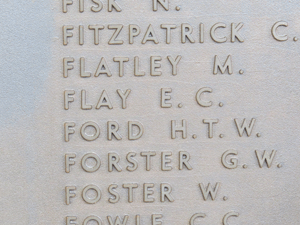 |
Australian War Memorial Roll of Honour October 2018 (J Hawker) |
Thomas Laidlaw Forbes
 |
 |
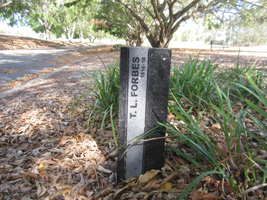 |
| The plaque from 1993 |
.jpg) |
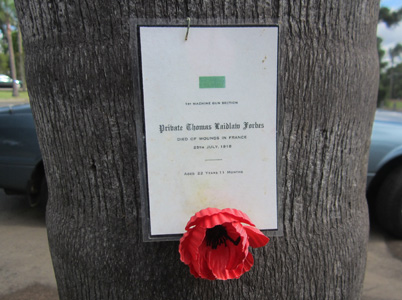 |
Tree 78 - is small weeping fig that was planted when the original one from 1918 died. The Brisbane City Council took a cutting from the original tree to propagate the new ones. |
A poppy and card pinned to a tree by an anonymous relative on Anzac Day 2014 honours the service of Thomas Laidlaw Forbes who died of wounds on 25 July 1918 in France. He was a gunner with the 1st Machine Gun Battalion. |
Thomas Laidlaw Forbes was born in Brisbane on 23 August 1895 to parents James Forbes and Sarah Forbes (née Marston). He had an older sister Ethel and a younger sister Elsie. Tom grew up in the area of Brisbane now known as Greenslopes but at the time was called Dunellan Estate, South Brisbane. He lived at 32 Dunellan Street and attended Dunellan State School. He was a popular boy: in Class VI (Year 10) he was awarded the "most popular boy" at the annual Awards Night in December 1909. Tom was a keen cricketer, playing for the nearby Cooparoo Cricket Club.
After leaving school he obtained a job as a clerk with Sturmfels Ltd - a woolbroking company that also sold stock, hides and tallow. His employer, Frederick B. Sturmfels, was a native of Alsace-Lorraine, but had been in Australia for many years, about 20 years being spent in Brisbane. His wife Mrs. Emily Sturmfels was born in France and had become a very prominent war worker, being President of the Red Cross Society and a patron of the Belgian Relief Fund. They were both passionate supporters of the allied cause.
In September 1915, the Sturmfels' oldest son George - a stockman - joined the 2nd Pioneer Battalion and headed off overseas to France. Their second son Frederick - also a stockman - joined the army too. He enlisted on 18 April 1916 and was also off to France but with the 49th Battalion. George was soon to receive a severe gunshot wound to the right knee and was invalided back to Australia, arriving 31 August 1916. It was that very day that Thomas Laidlaw Forbes joined the army. It is not inconceivable that the Sturmfels encouraged and supported Tom in his enlistment. Their daughter joined the cause as a nurse.
Tom did have some experience with the army. He spent two years as a senior cadet and a further three years with the 9th Infantry of the Citizens Military Forces (Moreton Regiment). His army life began on 25 September 1916 where he undertook training in Brisbane before being placed with the 15th Battalion to travel overseas aboard HMAT Wiltshire (departing 7 February 1917) as part of the 22nd Reinforcements (Reg. No. 6534). Upon arriving at Devonport, England, in April 1917, he joined the 7th Training Battalion to undergo further work prior to leaving for the front in France.
In June 1917 he was assigned to the 1st Machine Gun Company of the 26th Battalion and was sent to northern France in October 1917. In March the next year the various Battalion machine gun companies were brought together as the 1st Machine Gun Battalion and assigned four machine gun companies: 1st 2nd, 3rd and 21st. Private Tom Forbes was placed with the 1st MG Coy of the 1st MG Battalion (of the 1st Division AIF) and sent up to Ypres near the French-Belgian border to hold the line.
He was in a region that saw major action for the Australian forces against the Germans; namely the Hazebrouck Region. The 4th Battle of Ypres has become quite famous for its ferocity and success in halting a German advance. From 12th to 15th April 1918 Germany attack with the intention of capturing Hazebrouck but was stopped by the Australian 1st Division. During this action - on 13 April 1918 - Tom was shot in the throat and face by enemy fire and was sent to hospital. The Australians were given French reinforcements, specifically the Kemmel sector south of Ypres, to help stem the German advance. Upon recovering from his wound, Tom Forbes rejoined his battalion at the front in Hazebrouck.
It is also interesting to note that the other Sturmfels son - Frederick - received a gunshot wound to the left leg in France just the week before Tom's injury. However, worse was yet to come for Tom Forbes. The 1st Division continued to hold the line in the Hazebrouk area. The men of the 1st Machine Gun Battalion spent their days repairing and strengthening their fortifications while engaging the enemy with harrassing fire at night.
On the 1st July, as well as doing their normal work, the men of the 1st Machine Gun Company (Tom's MG Coy) played cricket against the 4th Battalion "and won". The YMCA opened a cinema, and the weather was fine. On the 3th July 1918, harrassing fire continued after nightfall and Pte Richard Anderson (661) was wounded and evacuated. The next night - at 9.20pm - the enemy put down a heavy barrage along the whole of the Divisional Front for about an hour. Tom Forbes and Pte Fernand Barnett (594A) were hit by gunshot and had to be evacuated. The Company delivered a total of 11000 rounds of small arms ammunition (SAA - 0.303 calibre) from their 16 Vickers machine guns that night.
Tom received penetrating wounds of the head, thigh and right arm. He was taken to the 7th Stationary Hospital at Boulogne but never recovered. A telegram was sent to his parents on the 25th July saying that his situation was "dangerous"; but that very same day he died. Privates Anderson and Barnett were the only other casualties for the Company that month but they recovered and returned to the front and survived the war. Tom was buried at Terlincthun British cemetery 3 miles north of Boulogne (Plot 1, Row F, Grave 32) on consecrated ground. He was just 22 years and 11 months old. His belongings were sent home and amongst them was his gold wristlet watch - damaged as one might expect given his injuries. On the first anniversary of his death - 25 July 1919 - a number of memorial notices were placed in the Brisbane Courier:
| FORBES, - In loving memory of my dear cousin, Private Thomas Laidlaw Forbes, died of wounds in France, 25th July, 1918 We missed him the day he left us, With his smile and his loving way, We will miss him more as the years go by, As we miss him more to-day. Inserted by his loving cousin T. W. Hill |
| FORBES, - In loving memory of our dear nephew, Private Thomas Laidlaw Forbes, died of wounds in France, 25th July, 1918 We pictured his safe returning, We longed to clasp his hand, God has postponed the meeting, 'Twill be in a better land. Inserted by his loving aunt and uncle, M. A. and J. A. Thom |
| FORBES, - In loving memory of our dear nephew, Thomas Laidlaw, who died of wounds in France, 25th July, 1918 May the heavenly winds blow softly O'er that sweet and hallowed spot Though the sea divides his grave from us He will never be forgot. Inserted by his loving aunt and uncle, E. and C. W. Yarrow. |
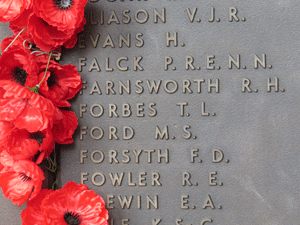 |
Australian War Memorial Roll of Honour October 2018 (J Hawker) |
William Shaw Francis
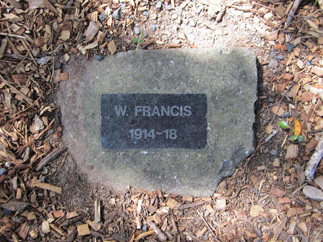 |
.jpg) |
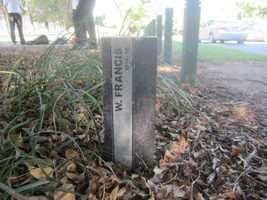 |
The plaque from 1993 |
Billy Francis's tree (#50) was weeping fig planted in 1918. |
William Shaw Francis was born in the small town of Bothwell in Lanarkshire, Scotland - about 20 km south of Glasgow - in 1898. His parents were John Francis and Mary Francis, nee Shaw. They married in Bothwell in 1891 and had seven children and lived in inner-city Glasgow at 41 St Marnock Street.
When William - or "Billy" as he was known throughout his life - was 14 years old, the family emigrated to Australia. They departed London in March 1912 and arrived in Brisbane on 2nd June 1912 aboard the Perthshire. The family consisted of John Snr (43), Mary (39), George (20), Gavin (18), John (16), William (14), Elizabeth (12), Joseph (10), and Mary (3).
The family soon set up home in Rochdale Street, off Ekibin Road, Annerley. It is not known which school the children attended but as they lived just a few streets away from Junction Park State School it can be safely assumed they went there. As military Cadets was compulsory after 1911 for all boys over the age of 12, Billy was required to do two years of Senior Cadets, as did his brother John (forever known as "Jack"). The other boys were either too old if over 18, or too young if under 14. John (Snr) was a tailor, George a labourer, and Jack and Billy became apprenticed to plumbers, having completed two years and four years respectively when they decided to join the army.
Billy and his brother Jack enlisted on the same day - 11 December 1915 - and were given successive Regimental Numbers 2424 (Jack) and 2425 (Billy). They were both placed in the 10th Depot Battalion in Brisbane for nine months. Billy and Jack trained together, transferred into the 35th Bn, the 41st Bn and then 52nd Bn before travelling overseas together aboard the HMAT A49 Seang Choon, departing Brisbane in September 1916.
They arrived in England in December 1916 and began training as Signallers before being placed in the newly created Anzac Battalion - the 47th. Billy and Jack were sent to France with the 47th and arrived there in March 1917. The 47th had been taking duty in the trenches and resting behind the line when they arrived. In April 1916, they attacked the Hindenburg Line at Bullecort but failed to gain ground. In mid-1916, the focus of the AIF turned to the Ypres sector of Belgium where the 47th prepared for battles at Messines and then Passchendaele in October as part of the Australian 3rd Division. New Zealand was also providing a division, and the Australian 4th Division acted in support.
Billy was a Signaller in D-Coy, 14th Platoon, of the 47th Bn. On 12th October 1917, the battle began at dawn. At 5.45am several German high explosive (HE) shells struck Battalion HQ and killed 24 and wounding 10. As Billy and Jack were Signallers attached to Bn HQ they spent much time there but were lucky this time. All of the casualties at HQ were Signallers, Runners or Scouts. By mid-morning the battalion had just finished an attack on Passchendaele Ridge and managed to hold the new line. It was ferocious fighting that took place and the enemy barrage had littered the area with deep shell holes and bodies.
 |
| Section of the trench map for the D-Coy's advance on 12th October 1917. The line shows where the men got to that day advancing from the south. William Francis died somewhere along this line. |
The Commanding Officer of D-Coy was Captain Alexander Milne Anderson who had set up Company HQ in a deep shell hole on the front line. D-Coy had taken the line and was attempting to hold it. Billy was in the shell hole awaiting instructions when, at 11.00am, Captain Anderson called him over to take a message to Battalion HQ. Billy was just bending to speak to Capt. Anderson and waiting to "hop over" the top when a sniper's bullet struck him in the mouth and exited through the back of his neck. He was severely wounded but remained conscious and jokingly said to Anderson "Will they send me to Blighty?" (back to England to hospital). The shell bombardment and sniper fire was so intense that they couldn't get him out until late that night - over 12 hours later. His mate Pte Arthur Hayes (4520) and Sergeant John Keenan (2668) both from the same platoon as Billy, did their best but they too were fighting for their lives. But his best mate of all - his brother - couldn't be there; he was in another shell hole also fighting for his life. He didn't know about Billy for some time.
The Australian 3rd Division suffered 3199 casualties that day; 4th Division - 1000 casualties and the NZ Division 3000 casualties - for no valuable gains.
Billy was taken to the 11th Field Ambulance station (RAP) and then transferred to the 3rd Australian Casualty Clearing Station. Here he died of his wounds on 16th October 1917. Jack survived the war, although badly wounded by shrapnel in April 1918, and returned to Australia in 1919.
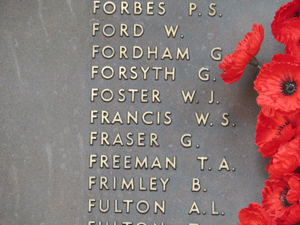 |
Australian War Memorial Roll of Honour October 2018 (J Hawker) |
Edward Charles Fraser
 |
| Edward Fraser's tree (#79) was flame tree that died and was never replaced. |
Edward Charles Fraser was born on 8th August 1898 to David Fraser and Christina Renton Fraser (nee Kelly). His mother had migrated to Brisbane in September 1893 at the age of 8 from Ratho, Scotland with her parents Thomas and Janet. David was from Greenwich, England and he migrated (it would seem) at a similar time. They married in Brisbane in 1885.
Edward was a middle child in a family of ten children: Frances (b1886), Janet, David, Maria, Florence, Arthur, Edward, Robert, Herbert and Walter (b 1904). The family lived at "Inglenook", Peach Street, Dunellan Estate, now called Greenslopes. The children attended Junction Park State School.
In 1909, when Edward was 11 years old his father had what seemed a minor accident at work. His father, David, was a painter working for the Brisbane builder R. S. Exton and Co. He was painting a property at Hamilton when he scratched his ankle on a piece of metal. He died several weeks later (23 April) from blood poisoning. Edward's mother took the builder to court claiming compensation for lead poisoning from the "white-lead" in paint (known as Painter's Colic) and won a settlement to support the children. We know that white lead (lead hydroxide/carbonate) can cause seizures, coma, and death, it is most likely he died of septicaemia. Of their 10 children, only four were still alive. The other 6 died either at childbirth or before 12 months old. The three boys were awarded £288 and the remaining girl Janet, who was aged 22, missed out as she was now an adult.
At 14 Edward was sent to Kelly's Training College on the corner of Albert and Adelaide Streets, Brisbane, to learn secretarial skills and become a clerk. This obviously did not suit him so he became a butcher.
Edward was so anxious to join the army that on 13 September 1915 at the age of 17 years 1 month he enlisted. He managed to do 4½ months training with 14th Battalion (9th Reinforcements) AIF before it was discovered he was underage. Not daunted, he did 16 days with the 9th Battalion Citizens Forces at Junction Park Drill Hall but then waited until 30 September 1916 when he was 18 years old and enlisted in the 11th Light Horse Regiment - legally. His cousin Renton Moffatt Kelly had joined the AIF and departed Brisbane two weeks earlier.
On 31st January 1916 Trooper Edward Fraser departed Brisbane for Melbourne aboard HMAT Wandilla A62 for training and finally left for the Middle East aboard HMAT Vestralia A44 in December 1916 arriving at Suez six weeks later. He managed to irritate the army by overstaying his time in town and was given 48 hours detention. He spent most of 1917 with the Light Horse Training Regiment in Egypt. Not that he knew, but his cousin Renton Moffatt Kelly was killed in action on 7th July 1917 at Messines, Belgium.
The 1st Light Horse Training Regiment was formed in Egypt during March 1916, tasked with training incoming reinforcements while allowing the wounded and sick a place to recover before returning to active service. Back in Brisbane, his cousin Renton Moffat Kelly joined the AIF and left for the Middle East too.
After Gaza fell on 7 November 1917, Turkish resistance in southern Palestine collapsed. The 11th Light Horse participated in the pursuit that followed, and then spent the first months of 1918 resting and training. Edward was supposed to join them in March 1918 but he was stricken with appendicitis and spent the next 5 months in hospital and rest camp.
The 11th Light Horse moved into the Jordan Valley in time to participate in the Es Salt raid between 29 April and 4 May 1918 while Edward was recovering. The regiment subsequently defended the crossing points over the Jordan, and helped to repulse heavy Turkish and German attacks on 14 and 15 July. Edward recovered and left the Rest Camp in Moascar (Egypt) on 17th August 1918 to rejoin his unit.
On the 24th August Edward arrived to find his unit was in training and patrolling around the Auja bridgehead in the Jordan Valley. The enemy was firing high explosive shells and snipers were active both sides. The temperatures on the Jericho Plain were an unbearable 100-105°F (38-40°C) and even hotter by 10°F in the bed of the Jordan River. Edward was issued with a traditional cavalry sabre and trained in traditional cavalry tactics in preparation for the next offensive against the Turks. The rest of the unit had been trained likewise. The practiced their swordsmanship in early September, had cholera injections, sharpened their swords and took off. The attack was launched along the Palestine coast on 19th September 1918. The roads were terrible and many wagons were abandoned. The bridges were worse and more wagons and horses fell over the sides. They passed Birket Ramadan, Iskernduneh and finally Kerkuh for a rest.
The 11th Light Horse Regiment was ordered to advance to the little mud village of Semakh, at the southern end of Lake Tiberias in northern Palestine on the 24th September 1918. The aim was to fight a mixed forced of Turks and Germans.
They marched by the settlement of Beisan on the afternoon of the 24th, and reached Jisr el Mejamie in the evening. They were ordered to attack Semakh at dawn on the following morning.
Two squadrons of the 11th LHR were detailed to make the attack mounted. Edward Fraser was amongst them. They moved along the road from Mejamie to Semakh when the enemy opened fire at close range. After charging through the village the horsemen dismounted and attacked the railway station under a bayonet charge. The enemy had overwhelming odds in their favour, in addition to outnumbering the attacking party they were securely barricaded behind stone walls and were armed with machine guns, automatic rifles and bombs.
Once it was over at 5.30 am, 100 of the town's defenders were dead and 365 captured - mostly German. The Australians suffered 14 killed - among them was Edward Fraser: KIA 26 September 1918. As well there was 65 other casualties. They also lost 61 animals killed, 37 wounded and a further two had to be destroyed and had nearly half their horses hit.
From the commencement of the mounted charge to the actual surrender of the town was exactly two hours.
The 19 men of the 4th Australian Light Horse Brigade were buried on the shores of the Sea of Galilee in the Semakk Military Cemetery - Grave 7 - the same day.
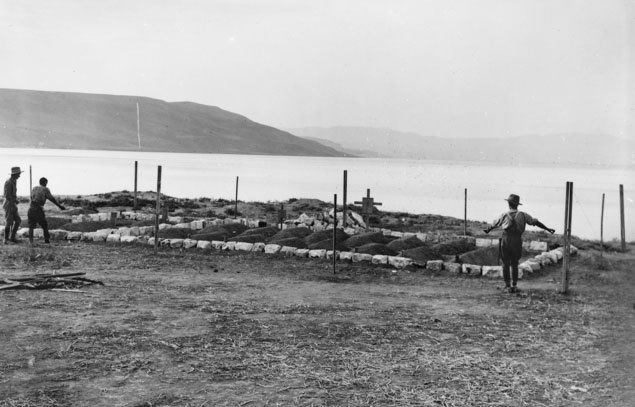 |
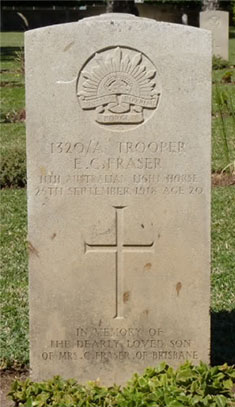 |
Edward Fraser's grave (No. 7 - on the right) on consecrated ground in the Semakk Military Cemetery - Sea of Galilee. Chaplain J. Bests officiated. AWM |
His headstone at the Haifa Beach Military Cemetery, Israel. |
In late 1919 the bodies of the men were reinterred in the Haifa Beach Military Cemetery in the presence of a chaplain. A wristlet watch that he was given when he left Brisbane was never recovered. Edward refused to make a will (even when pressed by the Army) but his goods and chattels eventually found their way to his mother. She died in 1949 and his brothers Robert and Arthur died in 1963.
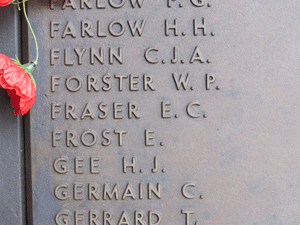 |
Australian War Memorial Roll of Honour October 2018 (J Hawker) |
Norman Lister Freeman
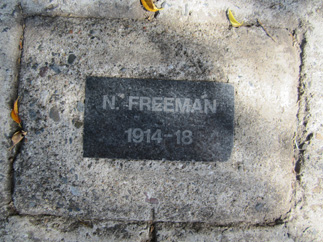 |
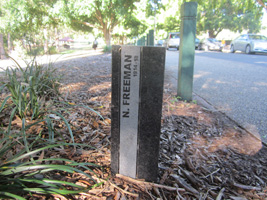 |
Pte Freeman - 55th Bn. This commemorative plaque was installed in 1993 and since replaced (see opposite). |
In 2012 these handsome signs were mounted beside all of the trees. |
 |
 |
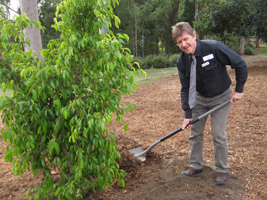 |
Yeronga State School childrens' tributes - Anzac Day 2012. Norm Freeman's tree (#18) was weeping fig that died and was replaced, and then blown down and replaced again. |
Freeman's weeping fig was destroyed in the storms of late November 2014. It had to be cut off at the base. The Brisbane City Council has taken cuttings from the original fig to propagate a new one (see right). (photo John Huth) |
The new tree being planted by the author Dr Richard Walding at the invitation of Yeronga State School during their Anzac Ceremony 24th April 2015. |
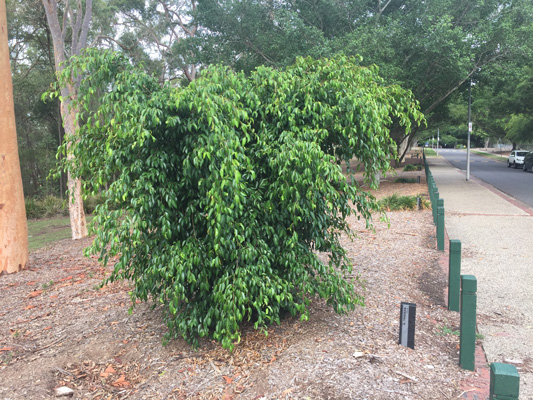 |
Freeman's tree is growing well. This photo was taken on 7 December 2017. |
 |
| Freeman's tree is certainly growing well. Here it is on 16 April 2025 |
Norman Lister Freeman was born in 1891 in Townsville, Queensland, to Walter Alfred Freeman and Emma Freeman (nee Tomkinson). The 'Lister' part of his name is his maternal grandmother's maiden name (Mary Lister). He had five siblings: Emily, Jane, Walter (d 1893, aged 5), Arthur (b 1893, d aged 2), Nellie, Myrtle and Daisy.
Norman was educated at Liverpool State School in Sydney before the family moved to 'Excelsior' in Riverview Tce, Fairfield, Brisbane. Norman remained in Sydney (Darlinghurst) and became a jeweller by trade. He enlisted in the army at Warwick Farm in Sydney in August 1915 (Reg. No. 3051).
After basic training Norman headed off to the Middle East on aboard HMAT Warilda A69 in October 1915 as part of the 3rd Battalion 10th Reinforcements. He arrived in Cairo in February 1916 and transferred to the newly formed 55th Battalion - a part of the 14th Brigade, 5th Division, along with the 53rd and 54th Battalions. Norman was promoted to Lance Corporal the following month.
The 55th Bn departed Alexandria aboard HMT Caledonia in June 1916 and disembarked in France on 29 June. They headed north to Belgium and by the 11th July were in the front line trenches a few miles south of Armentieres near the border. They were exchanging artillery and rifle fire with the enemy as well as being poisoned with German gas shells.
On the 16th the 14th Brigade billeted at Bac St Maur (near Saillysur la Lys) a few miles from the trenches. They began preparing for a major attack on the Germans on the 19th. The aim was to keep the Germans occupied so that they wouldn't transfer elwhere.
The 55th Bn left their billets and at 6pm on the evening of the 19th July were in the front line trenches just 3se00 yards of No Man's Land between them and the Germans in their trenches. The attack began with a barrage of artillery and at 6pm the 53rd and 54th Battalions went over the parapets in attack. There were severe casualties as the enemy was well prepared, but they managed to take the German trenches. Holding them was another thing. The Germans shelled the men relentlessly. To bolster the troops, at 7.36 pm two companies of the 55th Battalion were selected to form working parties to advance across No Man's Land and into the German trenches. Norman Freeman was in C-Coy and was now in a German trench.
 |
Part of a map used by Australian 14th Brigade during attack on German front line near Fleurbaix (which is 2 miles north). The 55th Bn advanced from the (blue dashed) front line over the 300 yards of No Man's Land to the German trenches. Freeman was wounded and taken prisoner when the Germans recaptured their trenches (red dashes). |
On the morning of the 20th July - 1.56am - the Australians were under prolonged attack from the Germans. A rumour went around that the men should withdraw and many headed back to their old front line. The Germans noticed this and closed in. Many Australians were killed or wounded in the German trenches from artillery shells, rifle fire and bayonets. Norman was struck in the left side of his head by a shell. He was badly wounded and when the Germans re-entered their trench, he was taken prisoner. The CO of the 55th Bn said that "Those wounded in the trenches are doubtless POWs".
Norman was indeed taken as a POW to the Number 8 Field Lazarette (hospital) in Haubourdin, near Lille, about 10 km SE into occupied France. It is here that he died on the 24th July (1916). The Germans, meticulous as ever, published his name in the German Death List dated 9 September 1916. He was buried in the Haubourdin Communal Cemetery German Extension (about 2¼ miles SW of Lille) with Christian rites. The Australian record says he died on the 22nd.
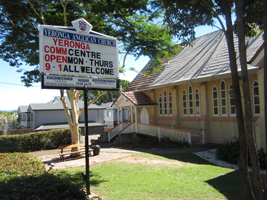
Christ Church today
Back in Brisbane, on the 7th November 1916, Rev. William Worley of the Church of England 'Christ Church' in Yeronga (then a cottage near the railway line end of what is now Christensen Street) visited Mrs Freeman at her home nearby in Riverview Tce. He broke the news that her son Norman was missing in action in France. Mr and Mrs Freeman's anxious wait was broken when Rev. Worley visited again some month's later to inform them that he was now known to have died as a POW of the Germans. No doubt, they would have been somewhat relieved to know that he was given a proper burial in consecrated ground with Christian rites.
After the war (1919), Norman was reinterred in the Cabaret-Rouge British Cemetery in Souchez, France. The officer in change, Capt. Mills, recovered Norman's Identity Disc and forwarded it to AIF HQ and thence to Mr Freeman. Norman's personal effects were also sent home. The consignment note listed a 'ring' and Mrs Freeman was anxious to find out more. Perhaps she thought he may have married overseas. The army wrote back to say they had made a mistake and that no ring was included.
Mr Freeman died in 1920, their daughter Emily died in 1925, and Mrs Freeman in 1936.
On the 24th April 2015, Yeronga State School held a special 100th Anniversary Anzac Service at which some of the trees damaged by the November 2014 storms were to be replaced. The Brisbane City Council had previously taken cuttings from the original weeping figs and had propagated healthy specimens ready for planting. This was done as part of the Anzac Service that morning.
 |
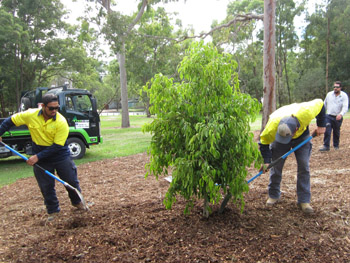 |
Three of the trees were destroyed in storms in November 2014 and were replaced on 24 April 2015. Norm Freeman's tree is the third tree on the distant right. |
Brisbane City Council finish off planting the three replacement trees in Honour Avenue - 24 April 2015 |
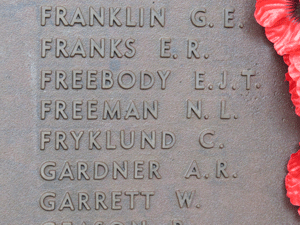 |
Australian War Memorial Roll of Honour October 2018 (J Hawker) |
Alan Somerset Orde Fuller
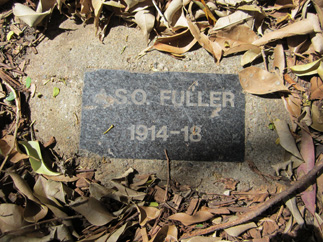 |
 |
 |
Pte Fuller - 3rd Field Ambulance |
Alan Fuller's tree (#19) was a flame tree that died and was never replaced. |
Nearby flowers after Anzac Day. |
Alan Somerset Orde Fuller was born in Wellington, a small town in central west New South Wales, in 1895. His parents were William Henry Fuller and Lucy Edith Fuller (nee Poile). Both his mother and father's families were from well-known grazier dynasties of NSW: Lucy's father established his business in Wellington in 1855 and that is where Lucy was born (in 1889). William's family - the Fullers - had been there equally as long. Alan's rather grand middle-names are ancestral: his paternal grandmother was Elizabeth Somerset Orde Waldren.
Alan's parents married in 1889 and before Alan there was just the one other - a daughter, Edith Orde, born in 1891. They lived as a family at "Redbank", Burrendong, not far from Wellington. Alan's father William left the family home and took a job with the railways in Perth, Western Australia. He died of typhoid in November 1901, so the family home was sold and Mrs Lucy Fuller, with Edith and Alan in tow, moved to Guilford House, Sydney. She became a nurse, possibly around this time. She and the two children shifted to Brisbane and set up home in Avondale Avenue, Annerley.
Alan, became an ambulance officer in Brisbane. There he had two good mates: Bill Cumberland, and John Lisson. The three of them decided to enlist in the AIF in the Medical Corps. Alan (1672) and Bill (6339) went first: enlisting on 28 June 1915, followed by John Lisson (6339) on 31 July. They were all placed with the Field Ambulance as stretcher bearers. Alan and Bill embarked for England aboard HMAT A55 Kyarra on 16 August 1915 and arrived in the Middle East for training. At the Tel-el-Kebir Camp near Cairo, Alan and Bill were transferred from the 4th Light Horse Field Ambulance to the 3rd Australian Field Ambulance. This unit came under the control of the 3rd Brigade, 1st Division AIF.
The entire AIF, including Alan and the 3rd AFA, departed Alexandria for France on 27 March 1916. Much of the following time was spent training and moving up to northern France. On 23 July 1916, the 3rd Brigade took part in its first major battle when it was committed to the fighting on the Somme at Pozieres, where the Australian 1st Division was hopeful of advancing 1000 yards, and capturing the village.
During the battle (28 July 1916) a request came through for 20 stretcher bearers to go to the No. 44 Casualty Clearing Station at Puchevillers (about 20km north of Amiens) to cope with the huge number of casualties from the Pozieres battle. This was a chance for something different so Alan volunteered and was driven there in a Sunbeam car. What made it difficult was that the soldiers were going into battle without blankets and overcoats (given it was summer) so there was little covering for the wounded. His time at No. 44 CCS wasn't to last: he was back at Berteaucourt on 6 August ready for the next 'stunt'. A week later the Stretcher Bearer Division marched out of Bertaucort for Vadencourt. From there they were ready to move to Contalmaison near Albert on the 19th August.
On the 19th Alan was posted to the Aid Post at the Chalk Pit but they called for more stretcher bearers. Alan volunteered for this more dangerous job even though they were behind the front lines. He was out in the open when a shell burst and killed him instantly. His mate Bill Cumberland was with him and carried him off to see him buried in the open country at Chalk Pit. It wasn't a real cemetery but many other soldiers were buried there. They were lucky that Captain Frederick James Miles was present. He was Chaplain with the AIF and the only Senior Chaplain on the Western Front. Captain Miles was a Church of Christ pastor from Perth, Western Australia who felt that he could best serve God by being with the men on the front rather than back in London behind a desk. Reverend Miles consecrated the ground at Chalk Pit (500 yards WNW of Contalmaison, 13½ miles ENE of Albert) and officiated at Alan's burial. Bill Cumberland wrote to Lucy Fuller giving details of Alan's last weeks.
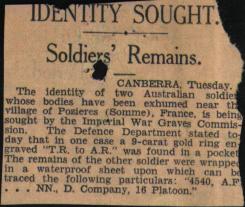 In 1924 Alan's body was reinterred at Pozieres British Cemetery (Plot 3, Row N, Grave 6) and they advised Mrs Fuller. However, she had shifted from Brisbane to Petersham, Sydney and had shifted again to Blackheath. She left a forwarding address at the Petersham Post Office but the army's letter was returned unopened.
In 1924 Alan's body was reinterred at Pozieres British Cemetery (Plot 3, Row N, Grave 6) and they advised Mrs Fuller. However, she had shifted from Brisbane to Petersham, Sydney and had shifted again to Blackheath. She left a forwarding address at the Petersham Post Office but the army's letter was returned unopened.
In 1937, Mrs Fuller saw an article in a newspaper asking if anyone could identify two bodies found in a grave at Pozieres to contact the army (see image to the left).
Mrs Fuller contacted them but they said they had identified Alan's grave and sent her a letter in 1924. They sent it again and she was relieved to know he ("his bones") were in consecrated ground.
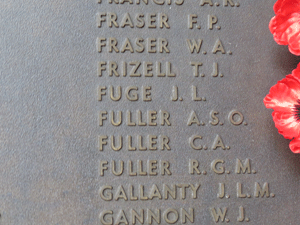 |
Australian War Memorial Roll of Honour October 2018 (J Hawker) |
Edwin George
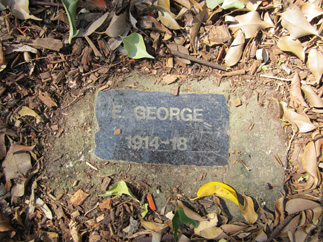 |
.jpg) |
 |
Pte George - 15th Bn |
Edwin George's tree (# 53) is a big old majestic weeping fig that - still there today. |
Edwin George was born in Leytonstone, Essex, England on 3 July 1887 to parents Frederick George and Alice Maria George (nee Stockdale). He was the third youngest of 11 children (Oldest to youngest: Alice, Minnie, Annie, Flora, Frederick, Sarah, George, Rose, Edwin, Adelaide and Benjamin).
Little is known of his life in England other than he became a salesman and migrated to Australia at the age of 23. He departed Kent on 16 February 1911 aboard SS Themistocles and arrived in Sydney on 3rd April and continued on to Brisbane in the ship, arriving 10th April.
Edwin became a carpenter's off-sider and enlisted in the AIF on 4 September 1915. Edwin (Ted) was placed with the 15th Battalion Infantry, 15th Reinforcements, with Regimental No. 4802. After training in Brisbane he was off to the Middle East aboard HMAT Commonwealth A73 in March 1916, arriving there in early August. Six weeks later Ted was off to France, landing in Etaples on the northern coast in late September thence joining his battalion on 4th October 1916.
Since June 1916 when they arrived in France the battalion had been engaged in bloody trench warfare, and Ted George was to find this was still the case. The battalion had just finished its first major action in France at Pozieres (August 1916) where they suffered heavy losses.
The 15th Bn were now in the trenches in St Eloi near the Belgian border. They were improving the trenches and taking turns in the front line trenches (as were the Germans). There were snipers about (on both sides) but the battalion had the enemy snipers well in hand. On the 13th October (1916) the battalion relieved the 4th Battalion in the trenches at Zillebeke (see map). There was artillery fire that night, but it was light. However, trench mortars were active on both sides.
 |
| A section of the trench map from 1916 [Zillebeke 1/10000, NW4]. I have added a red cross to show where Ted George was critically wounded. The blue line marks the British trenches; the red is the German trench line. No Man's Land (between them) is only a few hundred yards wide here. The width of the segment of the map above is 1800 yards. |
On the 15th October, the battalion sent out their nightly patrol to scout around No Man's Land for enemy activity. No Man's Land is particularly dangerous as it is the area between the front trenches of both sides. The area the 15th battalion were patrolling was near a hillock called "The Bluff" and thus the British trench there was known as Bluff Trench. It was about a mile SW of Ypres and an equal distance from Zillebeke (to the north) and the same distance to Hill 60 to the NW. The German trenches ran north towards Hill 60 and these are shown in red.
No Man's Land at The Bluff was only a few hundred yards wide. It shows how close the opposing trenches were. Only a few nights earlier a patrol into No Man's Land lead by Lt Cyril de Winton of the 4th Battalion was caught and de Winter was badly wounded. The rest of the patrol made it back to the lines but de Winter was reported as missing. He lay there in a crater before the next patrol found him and by this time he was dead. Now it was Ted's turn to venture into the dreaded No Man's Land. The patrol waited until dark.
It was all over for Ted that night. He suffered the same fate as de Winton and countless men before him, but it seems death came quickly. German shell fire killed two men that night. Ted was reported as KIA by the patrol on returning. His war from the moment he first entered action in France was just 11 days; start to finish - 11 days.
Ted's Next of Kin - his sister Adelaide (since married in Brisbane and now Mrs Adelaide Worthington) - received the terrible news a few weeks later (and published in the Brisbane Courier on 21 November). She was living with her husband James in a house she named "Sulby" - the last house on the right in Junction Terrace, Annerley. Only Adelaide and her sister Sarah migrated to Australia (Sarah was in Perth, Western Australia). The rest of Ted's siblings (the other 8) stayed in England. Ted made them all beneficiaries of his will although it would seem that his older sister Annie may have passed away.
Ted's oldest brother Frederick Harry was living in London and he was the recipient of Ted's three medals - as is the rule for the Army. Adelaide however received Ted's personal effects that he had when he died: a few coins, a purse and a Bible. They were sent home to Australia in August 1917 aboard the SS Themistocles, the very same ship that had brought Ted out to Australia as an adventurous 23 year old migrant six years earlier.
 |
Australian War Memorial Roll of Honour October 2018 (J Hawker) |
John and Robert Gilhespy - brothers from Annerley
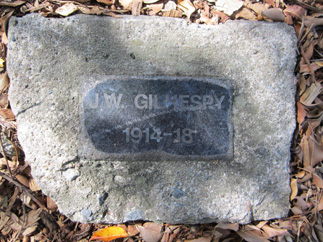 |
 |
John Gilhespy - 5th Light Horse. |
Robert's tree (Tree 51) was a flame tree that died and néeds to be replaced. |
.jpg) |
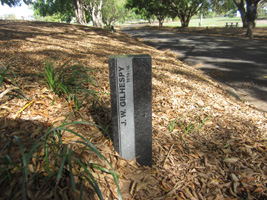 |
Tree 81 - a magnificent old weeping fig that is still alive today. Planted for J. W. Gilhespy. |
The Gilhespy family lived at 4 Torrens Street Annerley in Brisbane. George Newton Gilhespy - a blacksmith - and his wife Margaret (née Harrison) had five boys: Robert, George, Thomas, John and John William) and four girls (Elizabeth, Sarah, another Elizabeth and Annie) although the spelling of their surname had three variants: Gillespy (before 1881), Gillespie (1884) and Gilhespy (1886 onwards). All were born in Brisbane. Only two brothers went to war and both died overseas: they were Robert and John William Gilhespy. The first to enlist (on 22 July 1915) was 26 year-old John, a baker, who was assigned to the 5th Light Horse Regiment mostly for his good working knowledge of horses being a bread carter in Brisbane.
He embarked from Sydney for the Middle East aboard HMAT 47 Mashobra on 4 October 1915. The next day his older brother Robert - a labourer, aged 36 - joined the 25th Battalion in Brisbane, did training in Australia and embarked aboard RMS Mooltan from Sydney on 12 April 1916 and arrived at Suez a month or so later. He then joined the 7th Training Battalion for the next seven months and was off to the front line in France in December 1916. William had arrived earlier and became a driver for the staff, initially at Cairo but over the following year travelled to Port Said, Tel al Fara (the Mound of the Pharaohs), Marakeb, Dueidar and other exotic places in Egypt. Brother Robert meanwhile had become sick with severe trench fever in France and was transferred to England for treatment.
By March 1918 Robert was back in France and within three months was dead. On 29th June 1916 at Villers Brettoneaux he received gunshot wounds that shattered both feet and he died the same day. He was buried in the Longueau Military Cemetery, Picardie, France. About this time younger brother William decided to relinquish his position as driver and become a shoesmith to the horses instead. By November 1918 he was sick with pneumonia and typhoid and was admitted to hospital in Abbassia (Egypt) dangerously ill. He died - on 12th November 1918 - of pneumonia and was buried at the British Cemetery in Cairo. Their parents erected monuments to them at the South Brisbane Cemetery.
 |
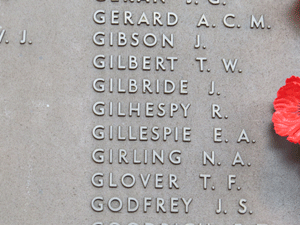 |
Australian War Memorial Roll of Honour - October 2018 (J Hawker) |
|
John Henry Gnatz
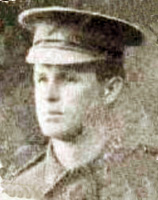 |
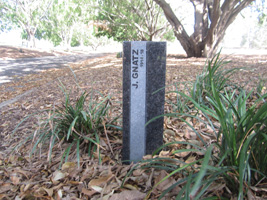 |
John Gnatz |
Tree 80 - the flame tree - is no longer there, being replaced with ornamental grass. |
John Henry Gnatz was born in 1886 at Yeerongpilly, Brisbane, to Johann (John) Gnatz and Maria Augusta Gnatz (nee Engfer). His parents knew him as Johann Heinrich but they anglicised his name for the birth registration in Queensland. He became known as "Jack" all the same. He had four siblings all born in Brisbane: Amelia "Millie", Wilhelm "William", Ivy and Lucy. Jack's father Johann ("John")was born in Hamburg Germany in 1856 and came to Brisbane as a six-year old boy aboard the Roddenau out of Hessen, Germany, arriving in Moreton Bay in July 1862. Johann had emigrated from Hamburg with his parents Heinrich and Henriette Gnatz who were German nationals and this was to cause Jack some problems.
Jack attempted to join the army but was refused because of his German ancestry. Never being one to give up, Jack tried again and on 8 June 1916 was accepted into the AIF (4th Reinforcements, 41st Battalion). His brother William (a hairdresser from Tennyson) enlisted on 9th August and placed with the 31st Battalion. One condition before they left for war against Germany though: Grandmother Henriette had to register as an alien, which she did in October 1916 at Moorooka. Jack and William's mother Maria was also from Germany and of German parents - Herman and Wilhelmine Engfer.
Prior to Jack and William embarking, the mayor and councillors of the Stephens Shire hosted a farewell party on Wednesday 13th September at Moorooka for departing troops, and a welcome home to those who served abroad and had returned safely. Councillor G. K. Seabrook farewelled the men, 14 in all, including brothers William and Jack Gnatz. Little did he realise that four of them would be killed in action: Bob Douglas, Bill Temple, Lew Robson and Jack Gnatz.
Jack embarked from Brisbane on 21 October 1916 aboard HMAT A36 Boonah and arrived in England in mid January 1917. Brother Robert (4312) was in the 31st Battalion and he departed in November. Jack undertook training at Larkhill and finally headed off to France on 19 April 1917. He was transferred to 15th Battalion in France but suffered from a variety of illnesses and for the next year was in and out of hospital in England and France.
Eventually he was declared fit for service and rejoined the 15th Battalion on 19 May 1918 in the Villers-Bretonneux area. Brother William had received a severe gunshot wound to the arm a week earlier and was still in hospital when Jack left for France. Jack's 49th Battalion were acting in support and doing work on trenches and barbed wire. After a few uneventful days in the front line they were back repairing more trenches and undertaking training and shifting camp. At the end of the month they were in the front line at Hamel having relieved the 55th Battalion. Most of June 1918 was spent doing "works". They felt like the Germans were alert but not offensive: they were not patrolling and fire was widely dispersed and not targeting any particular objective. No-man's-land was quite wide here so the men of the 15th Battalion hardly ever encountered German troops. The weather was generally fine, the men's health good, except for the boils and sore from lack of green vegetables, but there was some influenza and trench fever. They were allowed a swim in the canal.
On 1st July 1918, the troops began to organise for a major offensive. Each man had to carry a shovel, extra water bottle, three bombs, 220 small arms ammunition and four sandbags. Jack Gnatz was a runner for his platoon (4th Platoon, A-Coy, 15 AIF). He was to accompany his Platoon Commander Lt Eric W. Simon during the attack so messages could be passed back and forth. And he didn't have to carry all the extra equipment. On the 2nd July Australian Prime Minister Billy Hughes visited the troops to rally them on. On the 3rd July the Battalion moved into line.
The next day (4th), at daybreak, about 4.30am, 4th Platoon waited in their line as the artillery barrage softened up a section of the German line known as Pear Tree trench in front of Accroche Wood. After eight minutes of artillery fire the men went "over the bags" and headed for the trench under the cover of a rolling barrage. It seemed as if the bombs were missing their target and falling too short wounding their own men. No bombs had hit the trench so Germans were still able to put up resistance with MG fire and "giving a certain amount of work for the SBs [stretcher bearers]". Nevertheless, the tanks that proceeded the men were doing a better job. Germans were being bayonetted or surrendering. It was fortunate that earlier drills using German machine guns enabled the men to turn these guns on the enemy.
During the attack, Platoon Commander, Lt Eric Simon, was using Jack Gnatz and Jim McBryde as runners to take messages back and forth. While they were advancing in the open, Jack was struck by a machine gun bullet. He was standing beside Lt Simon and Jack said "in my stomach". He fell to the ground beside Lt Simon and stretcher bearers quickly took him away to the Dressing Station. Jim McBryde was also hit by bullets and he too was taken away to the same station. Both men were so severely wounded that they were evacuated to the No. 5 Casualty Clearing Station at Crouy (near Amiens). Jim died that same day. Jack Gnatz held on for two days and died of wounds on 6th July 1918.
Lt Eric Simon was a schoolteacher from Toowong in Brisbane. He wrote to Mrs Gnatz with particulars of her son's death. Jack was buried at Crouy Cemetery, as was Jim and most others of the 15th Battalion who died at Hamel. Mrs Gnatz renamed their family home at Holme St Moorooka as "Hamel".
Jack's brother William was unable to return to active service after his severe gunshot wound to the left arm and he returned to Australia in January 1919.
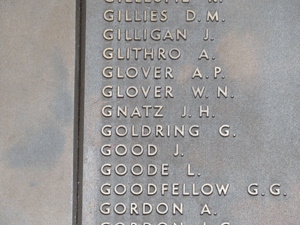 |
Australian War Memorial Roll of Honour October 2018 (J Hawker) |
George Charles Gracey
 |
 |
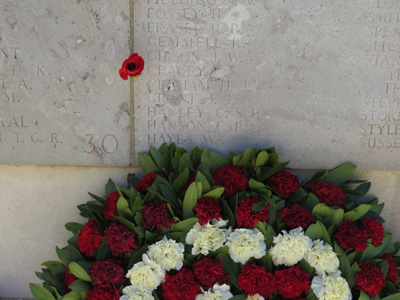 |
| Tree 52 - A flame tree that died and needs to be replaced. | George Gracey |
At Lone Pine Cemetery to the southern end of Anzac Cove George Gracey is remembered in the memorial for the men with no known grave. (Poppy and photo by Jim Hawker - 26 April 2014) |
George Charles Gracey was born in Collingwood, Melbourne, in February 1886. His mother was Rosa Anna (or sometimes 'Roseanna') Gracey nee Cadd (1863-1914) who married Robert William Gracey (1867-1913) in 1890 and had the the children George Charles and Henry 'Harry' Norman Ross (1900-1970). Rosa Anna had a son Horei John Douthwaite (b 1905 in Dunedin, NZ) possibly to Robert Henry Bailey (1870-1960) - although if they were married no record can be found. The birth certificate lists the father as 'Harry' and it may, or may not, have been Robert Henry. Horei John Douthwaite was thus a half-brother to George and Harry and was known by both surnames 'Gracey' and 'Bailey'.
In mid-1914 as war with Germany approached Australia pledged its support. Even before Britain declared war on Germany on 4 August 1914, Australia began preparations to send forces overseas to participate in the conflict. Volunteers were being accepted and training began in earnest. George enlisted in the AIF on 20th August 1914 while working as a tram driver in Brisbane. He was placed with the 9th Battalion and given Regimental No. 306. George's parents, Robert and Roseanna died in 1913 and 1914 respectively so Charles had to list another person as next-of-kin. He chose his oldest half-brother Henry Norman Ross Bailey who was a fireman at South Brisbane Fire Station. The birth registrations are a bit confused so you can imagine the problems the army had dealing with this.
This 9th Battalion was raised in Queensland in mid-August 1914 initially from men training at a camp in Maryborough. Over the next month they had sufficient recruits from Queensland to bring the battalion up to full strength of about 1000 men, 35 officers (and 15 horses). They undertook a short period of training and departed Brisbane on 25th September 1914 aboard the transport HMAT A5 SS Omrah headed for England. George was amongst this first deployment.
The 9th Battalion first stopped at Melbourne for three weeks training at Albert Park (in tents) followed by another week of training at Albany in Western Australia. They finally departed Australia on 1st November 1914.
While at sea - on 28th November 1914 - they received a message that they were to be diverted to Egypt instead of going to England as planned. They arrived at Port Said in Egypt on 2 December 1914, after which they undertook a period of intense training at Mena Camp at Cairo before being sent to Gallipoli. They departed Alexandria on 1st March 1915 and anchored beside the Greek island of Lemnos for a few hours until 21st April when Brigade orders were received.
George Gracey was in A-Company of the 25th Battalion. They headed off for Gallipoli, transferred to a small ship Queen and at 11pm on the night of the 24th April steamed for Gaba Tepe, arriving at midnight. At 1.00 am on the morning of the 25th, A-Coy and B-Coy transferred to lifeboats and landed on the right flank of Gaba Tepe under intense rifle fire. They waded ashore, ran across the narrow beach and scrambled up the steep cliffs. Some of A-Coy made it to the top and headed for Plugges Plateau where hand-to-hand fighting with the Turkish forces ensued. Many of A-Coy died that day, including George Gracey. It is not known where or when he died but by the next morning there was no sign of him so he was reported "Missing"and then "Killed in Action" 25 April 1915. That was the end of George's war. It lasted just a few hours after contact with the enemy.
He is one of the seven soldiers from Stephens who died at Gallipoli and remembered in Honour Avenue. The others are: Jack Rigby, Les Kenyon, Marshall Jury, Jim Fielding, Tom Carey and John Neil.
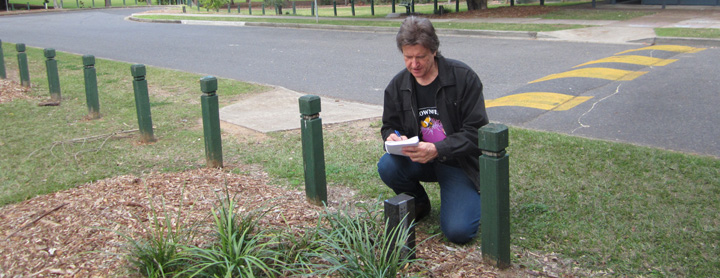 |
The author recording details at George Gracey's memorial plaque (June 2015). "I was a student at Yeronga State School from 1955 to 1962 and we would bring our wreaths and lay them beside the trees in Honour Avenue. The upper grades would get trees furthest away from the school. This spot where I am kneeling would be for the Grade 7s. In Grade 8 I remember putting a wreath under the huge 'Andrew Ormiston' tree further up the hill." [Richard Walding] |
 |
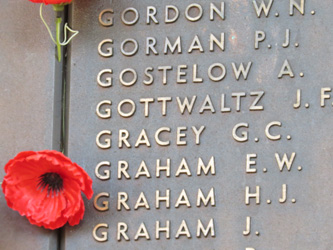 |
Australian War Memorial - Canberra. Here begins the names of the fallen from the 9th Battalion. (Jim Hawker) |
Australian War Memorial. George Gracey - 9 Bn. (Jim Hawker) |
George Malcolm Grant & Hugh Grant
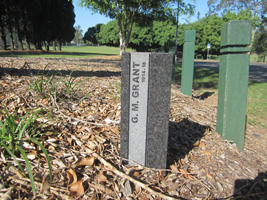 |
.jpg) |
The memorial plaque installed in 2012 to replace an earlier one stolen decades ago. |
G. M. Grant's Tree 54 - A new weeping fig was planted to replace the old one that died. The Brisbane City Council takes cuttings from the original figs to propagate the new ones. |
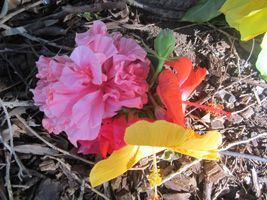 |
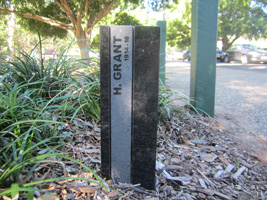 |
Flowers from Yeronga students. |
Tree 20 - for Hugh Grant. A flame tree was here but died many years ago. |
Hugh Grant was born in Ipswich in October 1890 to Thomas and Elizabeth Grant. His brother George Malcolm Grant was born in Sydney in January 1894. There was a third son, Thomas. The family lived "Bonnie Doon" - Earl Street, Thompson Estate, Annerley.
Hugh enlisted on 2 February 1916 and was placed with the 3rd Australian Pioneers Battalion (Reg. No. 793). He departed Melbourne on 6 June 1916 and travelled by HMAT A62 Whyalla for England and arrived in Plymouth on 26 July. He was sent to France in October but suffered from trench foot and was off to hospital (with mumps as well). Meanwhile, George (who had already spend 4 years with the Citizens Military Force) enlisted 14 July 1916 and was off to Plymouth on 21 October 1916 aboard HMAT Boonah. He arrived in England on 10 January 1917 and began training at Hurdcott. He had a short stint in hospital from sickness but was back with his unit in February 1917.
George was off to France in April 1917 and was soon placed with the 31 Battalion (C-Coy). He was back in hospital with a septic leg. Once recovered he was off to Polygon Wood for a major offensive. On 29 September 1917 George was in a dug-out awaiting the relieving party. There were six men in the trench and they were to be relieved three at a time. George had just stepped from the dugout into the relieving point in the support trench when a 9.2" shell struck the trench. It hit a 5.2" dud shell and the both exploded together. It buried them all. Nine men were killed. When the next relief party came they didn't know men were buried under the dirt in the collapsed trench. George had died instantly.
Around this time Hugh Grant had rejoined his unit in France but had come down with another fever. It was 5 July 1917. While in hospital a German air raid saw the hospital bombed and Hugh received wounds to his head and right arm. He became unconscious and was transferred to Hazebrouck Hopital but never regained consciousness. The base of his skull was fractured and he died at 11:30 am on 14 July 1917. Hugh was buried on consecrated ground at the Military Cemetery at Hazebrouck. His mate, Pte James Phillip Kelly (R. 818) from C-Coy, 9 Platoon, erected a cross and helped bury him. Jim Kelly lived at Peach Street, Dunellan Estate (Greenslopes).
The third son Thomas, a fireman, had joined in May 1917 (52 Bn) and was gassed at Rouen in May 1918. He returned safely to Australia on 23 September 1918.
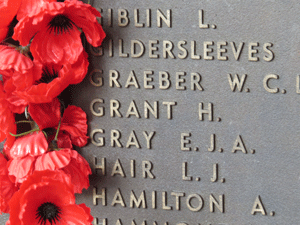 |
Australian War Memorial Roll of Honour October 2018 (J Hawker) |
Robert Wilkinson Hepworth
 |
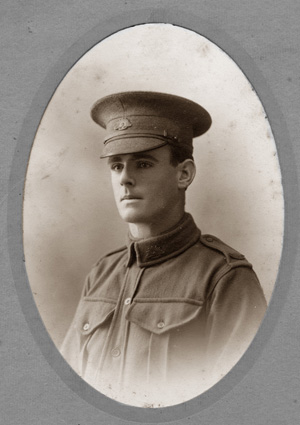 |
Sapper Robert Wilkinson Hepworth - d 11 August 1918, Vaire, France - aged 26 |
|
 |
.jpg) |
The Hepworth plaque - that mistakenly has his second initial as "R" instead of "W". This mistake was made when preparing the names for the honour board in 1918. All army files correctly record him as R W Hepworth. |
The Hepworth Tree (#82) is an old weeping fig planted in 1919. |
Robert 'Bob' Wilkinson Hepworth was born in Southport, Queensland, in 1892 to parents George Robert Hepworth, a carpenter, and Mary Hepworth (nee Wilkinson). They married in Bolton-by-Boland in Yorkshire in 1880. A son Harold was born in July 1881 and died a few days later. The family moved to Blackburn, Lancashire, where they had a son Tom in 1882 and a daughter May in 1885. The family of four left Blackburn in 1887 aboard SS Roma bound for Australia, arriving in Brisbane on 3 May 1888.
They headed straight for Southport, about 70km south of Brisbane where Mr Hepworth - as a carpenter/joiner - set up a building business with a partner Thomas Moorman in about 1890. Much of the early construction around Southport was done by G. R. Hepworth & T. Moorman, Builders (the Presbyterian Church at Mudgeeraba is an example). Four daughters were added to the family in this time: Georgina, Teresa, Julia and Dorothy. In 1909 the family moved to Brisbane and set up home in Fanny Street Fairfield. Bob took an apprentice clerk's position with the Queensland Railways, as did brother Tom. As well, he spent four years as a Senior Cadet with Area 9A (Annerley area).
His brother and sisters married at this time and he became an uncle many, many times over: his brother Tom married Martha May Russell in 1911 and had a daughter Muriel Patricia May Hepworth in 1914 and a son Tom Stanley Hepworth in 1916; Julia married Arthur Burge in 1911 and had Arthur Jnr in 1912 and Lulu in 1914; and Georgina married Henry Markwell in 1913 and had children Fred (1913) and Henry (1915).
Bob enlisted in the army on 3rd June 1916 and began training in Brisbane. He had some home leave to farewell his family and then was off to Sydney by train to embark RMS Osterley on 10th February 1917. Bob was part of the January Reinforcements with the 9th Field Company Engineers (Reg. No. 16798).
Bob arrived at Plymouth in April 1917 and was sent to the Parkhouse Camp for training. The role of a field engineer was to construct and improve trenches (also called 'saps'), build bridges and so on. Such a person is thus called a 'sapper'. This should not be confused with the Signals Engineers who looked after wires and communications. Bob must have showed promise as a field engineer so it was off to the Sapper Engineering Training Depot at Brighlingsea in Essex for advanced training. In late June 1917 Bob was sent to France to join the 9th Field Company Engineers in the field.
They were at Messines (as part of the 3rd Division AIF) having just finished their first major engagement of the war - the Battle of Messines. Bob's job was to improve existing trenches and dig new Reserve Line trenches. Following this, the division's next major engagement came in October 1917 when it took part in the Battle of Broodseinde Ridge. The fighting around Passchendaele proved to be the division's last offensive actions for 1917. Bob spent the winter months in the rear training, or undertaking repair duties in reasonably quiet sectors of the line. The next year, 1918, in March the Germans launched their successful Spring Offensive and advanced swiftly into the Somme valley.
On 8 August 1918, the 3rd Division was tasked with leading the Australian Corps part in the attack known as the Hundred Days Offensive around Amiens, just to the south of the Somme valley. Bob was in for the fight of his life.
The attack began at 4:20 am on the 8th. The weight of the Allied artillery was intense as over 2000 guns opened up on the German defences. The assaulting infantry battalions were each assigned a frontage of about 1000 yards. The 9th Field Coy Engineers also advanced with the infantry. Two sections, including Bob's No. 3 Section, advanced at the same time and crossed the old front line 25 minutes later. They began re-making forward roads (see map) for the Field Artillery. The roads were made passable by 5.50am - just 90 minutes after zero hour. However, three sappers were wounded, one of whom was Bob Hepworth.
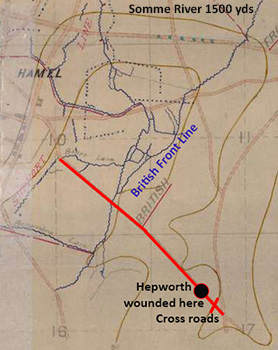 |
Section of the trench map taken from the Appendix of the 9th Field Engineers War Diary for August 1918. Bob was about where I have placed the black dot when he was hit. This was as far as they had to go with their road repairs (red line) that morning. The road from Le Hamel to the crossroads is about 2.5km. Villers-Bretonneux is 10km SW of the crossroads. |
Bob had been fixing the roads by filling in shell holes with soil or chalk, and laying down a good thickness of crushed rock to harden up the road surface. He was with a few mates including his friend Sapper Albert Fuller (R.2612) a carpenter from Brisbane. While doing this a German shell landed about 8 yards away from their party. Three were injured. Bob was struck in the back, leg and arm. Word quickly made it up the line and front line troops heard the news. Another mate - Tom Le Clere (R.9902) - was in No Man's Land about 300 yards ahead of Bob and heard the bad news. Tom Le Clere, himself, was hit the next day.
Bob was carried the mile back to the Field Dressing Station by stretcher bearers who were German prisoners of war. While he was in the dressing station another mate, Pte Percy Jones from Sydney (R.9894), spoke to him and could see that he had six severe wounds. The wounds were too bad for treatment there so he was sent to the Casualty Clearance Station in Vaire-sous-Corbie, about 3 km NW of Le Hamel.
The attack neverthelsss proved successful, as the Australians overwhelmed the German defenders and by the end of the day the division had achieved all of its objectives. Two days later, in the Casualty Clearing Station in Vaire, Bob died. It was 11th August 1918. His friend Tom Drew (R.N2796) said of Bob: "he was a very good man" and that he was good in trouble.
The Queensland newspapers carried a notice of Bob's death in Casualty List 427 on 7 September 1918. The family notice carried the epitaph "When God calls. He will answer". On subsequent anniversaries, a memorial notice was placed in the paper: "Peace, perfect peace" one read.
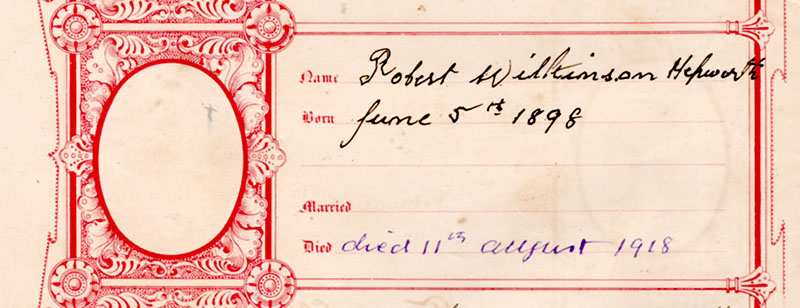 |
| The details of births, deaths and marriages from the Family Register are recorded in the family bible. Here we see the entry for Robert Hepworth. |
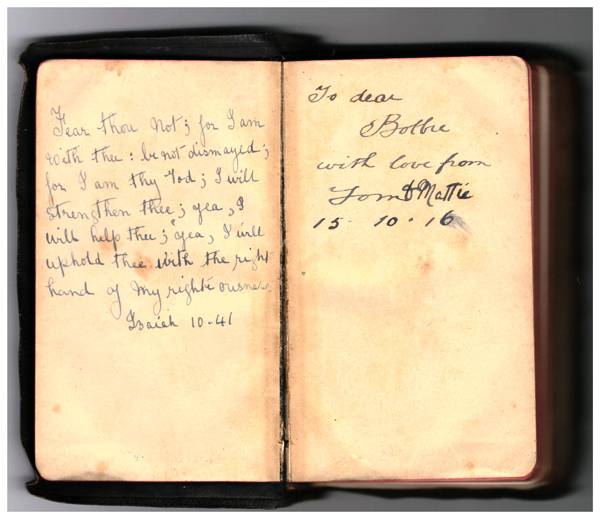 |
Bob Hepworth's bible that he carried this with him during his army service in France 1916-1918. On the left side the message is: Fear thou not; for I am with thee: be not dismayed; for I am thy rod; I will strengthen thee; yea, I will help thee; yea, I will uphold thee with the right hand of my righteousness. Isaiah 10.41 On the right side the message is "To dear Bobbie with love from Tom & Mattie 15.10.16". 'Tom' is Tom Hepworth - Bob Hepworth's brother, and 'Mattie' is Martha May Russell (Tom's wife, Bob's sister in law) |
 |
Bob's bible - that stayed with him until his death in France on 11 August 1918 |
Bob's father George and brother Tom both died in Brisbane in 1923. His mother Mary moved to Woollahra, Sydney, to live with daughter Dorothy and her husband. Mary died in October 1935.
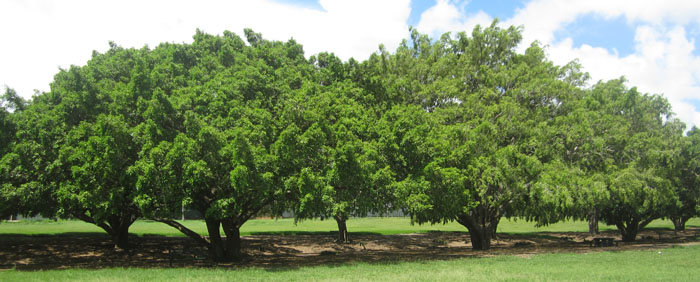 |
The two biggest weeping figs in Honour Avenue commemorate the service of Robert Hepworth (Tree 82 on left) and Harold Mitchell (Tree 86 on right). They were both planted on 23 August 1919. In between them was a flame tree (#84) in honour of Roland Markham died in France in August 1918. The tree on the left (Hepworth) is the biggest in Yeronga Park. I measured it to be 13 m high and a canopy diameter of 30 m. There is a seat underneath it as well. These trees have provided shade to countless school students and visitors to the park. |
My thanks to John Hepworth <john.hepworth@gmail.com> for photos of his great-uncle Robert Wilkinson Hepworth. John is the son of Tom Stanley Hepworth.
 |
Australian War Memorial Roll of Honour October 2018 (J Hawker) |
Roland Charles Higgs
 |
.jpg) |
 |
Plaque |
Tree 21 - a majestic old weeping fig near the school gate in Honour Avenue. |
Flowers after Anzac Day |
Roland Charles Higgs was born in Heneleaze, a suburb in the north of Bristol, England in 1896. His parents were Albert Edward Higgs and Emily Higgs, nee Ashley, and he had a younger sister Eveline Ashley (b 1898). Roland attended North Street School and The Higher Grade Boys School - in Heneleaze.
The family departed London on 30 September 1911 aboard the Moravian and arrived in Brisbane on 27 November. Albert was 38, Emily 34 and the children Roland 14 and Eveline (Eve) just 12. They bought a home which they called "Heneleigh" at Prince Street, South Brisbane (now Greenslopes). The name was derived from that of their home town.
Roland became a motor mechanic and worked for The Evers Motor Co. Ltd on the corner of Ivory and Boundary streets, Fortitude Valley in Brisbane city. He served 3½ years with the 9th Battalion, Citizens Forces, and trained at the drill hall in Dudley Street, Annerley. He enlisted in the army on 7 March 1916 and was placed with the 41st Battalion AIF - 4th and 5th Division Cyclist Company (2nd Reinforcements).
He embarked Brisbane for the Middle East aboard HMAT Clan McGillivray A46 on 1st May 1916 and after a short stop in Egypt departed for London in August 1916. He was placed with HQ Staff (B-Coy) and sent off to France on 24 November 1916. In January 1917 he was promoted to Lance Corporal.
As with many soldiers in the trenches, he developed scabies (mites) and was in hospital for a few weeks, then back to the front, then back to hospital with a sebaceous cyst and then back to the front to rejoin his battalion on 2 May 1917. At this stage they were near Messines in Belgium training and labouring in the rear areas.
The 1st to 5th July saw the battalion in the front line (see map below) where they relieved the 43rd Battalion. Men were being killed by shells but often by sniper fire. For example, on the 6th July 2 ORs were killed in action and 15 wounded. The next day four officers and four ORs were wounded. One was their Platoon Commander Lt George Colin Wilson from New Farm Brisbane. He was making a final tour of the front line when he heard an enemy aeroplane overhead. It was about 10am. Lt Wilson stood up on the fire step in the trench to get a better view through his field glasses and exposed his head above the parapet. A German sniper from No Man's Land shot him just above the eye. His wounds were dressed and he was taken to the Ambulance station but he died soon after.
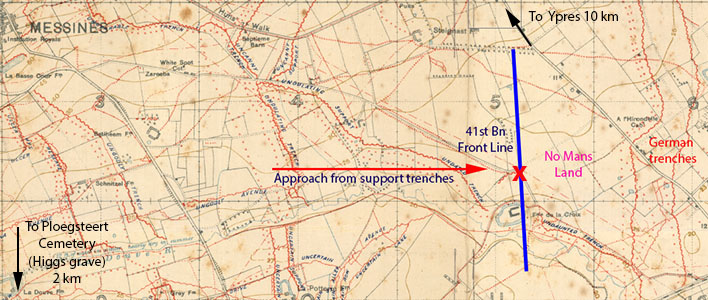 |
Trench map of the Messines area July 1917 (Map 28). The German trenches are drawn in red and are to the east (right). I have added the blue line in to show the location of the British/Australian trenches that the 41st Battalion AIF manned from the 1st - 9th July 1917 (28U.11b.3.3 to 28U.5b.5.5) The distance to the German trenches is just 1100 yards. The red arrow shows the direction from which the men approached the front line. I have marked the approximate position that Roland Higgs was killed with a big red cross. To the left I have shown where he was buried. |
On the 8th July the engagement with the enemy continued. The German front line was just 1100 yards to the east (see above). Just before midnight one of the men - Pte Henry Carrall - passed Roland Higgs in the trench and when he returned 10 minutes later Higgs was dead. Carrall said that he had been killed instantly by a shell. Higgs' mate mate Frank Hames (440) was also killed that night by the same shell. The 41st Battalion lost 9 ORs KIA (killed in action) and 11 wounded that night.
The next day Higgs was buried in open ground in the makeshift 'Queensland Cemetery' in Ploegsteert Woods (called Plug Street by the men). It was behind the lines (near Orchard and Sunken Road) and shown on the map above. The two men were so badly 'smashed' by the high explosive shells that they couldn't take the men's equipment off so they were buried with it on. The funeral service was conducted by Presbyterian Padre Captain Mills. Roland's best mate L/Cpl Michael Egan (1815) attended the funeral. It was left to Lt Colin H. Butler to write to their parents.
The next year their remains were reinterred in the Messines Ridge British Cemetery.
Roland's father Albert died in 1942 and his mother in 1945. Roland's sister Eve married Wallace 'Wally' Webb and died in 1969. They had a son Keith.
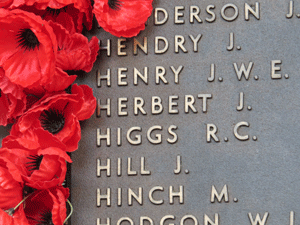 |
Australian War Memorial Roll of Honour October 2018 (J Hawker) |
A World War 2 Memory
 |
 |
| A small tribute of flowers was left beside a tree on Anzac Day 2014 by a proud great-grand-daughter from Yeronga State School. She remembered Lenard Felix Hingston B3709 (photo above) who was a seaman aboard HMAS Bowen in the Royal Australian Navy during WW2. She also remembered "Great Poppy Futcher and Great Poppy Yates (English Army)" also from WW2. | |
Samuel John Hill
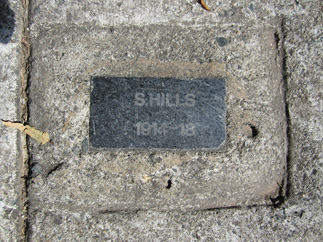 |
 |
Tree 83 - a flame tree was originally planted here but died and has not been replaced. |
Samuel John Hill was born in 1897 in Brisbane to John Hill and Mary Hill (nee Read) of School Road, Yeronga. He was the only boy amongst four sisters: Florence, Kittie, Madeline, and Nellie. They attended Junction Park State School, which might seem surprising seeing their home "Brentwood" was across the road from Yeronga State School.
Samuel was a member of Senior Cadets and completed his training at Southport in 1913, for which he was awarded his Proficiency Certificate. He used to train at the Junction Park Drill Hall as part of the HQ Training Area 9A, Australian Military Forces, 1st Military District. Samuel became a warehouse assistant for a stationer after leaving school.
On 11 May 1915 he enlisted in the AIF and was placed with the 6th Reinforcements, 15th Battalion. They departed Brisbane aboard HMAT A63 Karoola on June 1915 and arrived in Egypt for training, thence Gallipoli. He fought at Gallipoli (apart for a short stint at the hospital in Mudros for the dreaded diarhorrea) until the final evacuation on 25 December 1915. Back in Egypt, at the Tel-el-Kebir Camp, Samuel was transferred out of the 15th Battalion into the 47th Battalion and promoted to Lance Corporal.
He arrived in France on 9 June 1916 with the 47th Batallion and headed for the trenches of the Western Front, arriving on 3rd July. They participated in their first major battle at Pozieres. Initially, the battalion provided working parties during the 2nd Division's attack on 4th August, and then, with its own division (1st Division), defended the ground that had been captured. The 47th endured two stints in the heavily-contested trenches of Pozieres, as well as a period in reserve. Samuel waa promoted to Sergeant in November 1916.
After Pozieres, the battalion spent the period up until March 1917 alternating between duty in the trenches and training and rest behind the lines. In April it took part in the attack mounted against the heavily defended village of Bullecourt - part of the formidable Hindenburg Line to which the Germans had retreated during February and March. But the attack failed! Samuel, an Assistant Signaller, was awarded a Military Medal (in June) for conspicuous service during the battle.

47Bn Officers 1918
In July 1917, Samuel was promoted to 2nd Lieutenant and transferred to the Signal Corps of the 47th. At the end of the month he was sent back to England for nine weeks specialist training at the Signal School at Dunstable, then back to the 47th in France as a Signals Officer. The following February (1918) he was sent to the 4th Division Pigeon School in England for four days training. He rejoined the 47th in France and was given commission as a Lieutenant. The photo below shows the officers of the 47 Battalion in July 1918. Samuel is back row, 2nd from left.
Meanwhile, the German offensive had been defeated but it had come at a cost. Due to heavy casualties and a lack of reinforcements from Australia, three brigades were directed to disband one of their battalions to reinforce the other three. The 12th Brigade was one of these, and on 31 May 1918 the 47th Battalion was disbanded. Samuel was transferred from the 47th to the 45th Battalion. He had three weeks' leave in England and then was back into the thick of it on 24 August 1918. He began with a long march to Villers-Bretonneux followed by training and more training.
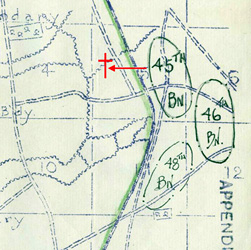
Where Samuel Hill died
The 45th Battalion was preparing for a major action in mid-September so they moved to Stable Wood in the Cartigny area. It was cold, showery, with violent winds one day and the sunny and warm the next. On 14th September Lt Hill went forward to reconnoitre the ground in preparation for their advance. Germans bombed the troops and, in fact, bombs almost wiped out HQ. On the 17th their objective was revealed - to capture Le Verquier and seize the "outpost line" that guarded the approaches to the main defences. Tapes were laid to guide forming of the line for the next day's attack.
The next morning, 18th September (1918), the men had breakfast early (3.30am) and moved out at 4.20am in artillery formation. Their artillery barrage began at 5.20am and the men followed this rolling barrage out. Samuel lead his Company (as part of A, B, and D Companys' advance) but heavy shelling was experienced as the three companies crossed the forming-up line. Samuel was hit by fragments of an exploding shell that penetrated his left leg and thigh. His 2nd Lieutenant bound up his leg with bandages and waited with him for the stretcher bearers to arrive. When they arrived Samuel was dead - from loss of blood. He was carried back by two of his men and buried nearby (at R14.b.5.7, Jeancourt 1/20000) and a wooden cross used to mark his resting place. To the extract from the War Diary map to the left I have added an arrow to show the movement of Samuel's company across the line and a cross to show where he fell. This extract from the War Diary mentions his death.
 |
Extract from the 47 Bn War Diary for 18th September 1918 |
Back in Brisbane, Samuel's parents heard the dreadful news almost straight away, although they were not told where he died. In the Brisbane Courier on 2 Oct 1918 they paid tribute to their only son, noting that he was "KIA - Somewhere in France". It read:
Life's highest mission he fulfilled |
Yearly, Mrs Hill would pay tribute to her dear son: "Loved in life, cherished in memory". (BC, 1933).
 |
Australian War Memorial Roll of Honour October 2018 (J Hawker) |
John Henry Hooper
Misspelt as "Cooper" on the Cenotaph |
Hooper's tree (#40) was originally a flame tree but it died and has not been replaced. |
John Henry Hooper was born in Brisbane on 5th March 1898 to Charles Hooper and Johanna Hooper (nee Martins). His parents had married in Brisbane the year before and his mother died when he was just 6 months old. John was an only child. He had been living with his father at Buderim, just to the north of Brisbane but did his schooling in Brisbane.
At school, John had compulsory training with the Junior Cadets, and Senior Cadets (8th Bn, South Brisbane). This consisted of four days camp, 12 half-days and 21 night drills. His sergeant at the 8th Battalion Training Area was Richard Picking, his cousin (his aunt Renie's son). John, a waiter, enlisted in the army on 17 August 1915 when he was 18. He was given Regimental No. 3761 and placed with the 15th Battalion, 12th Reinforcements and took a train to Sydney to depart for the Middle East aboard HMAT Suffolk A23 on 30 November 1915. He arrived in Egypt in early January 1916 and began training at the Tel-el-Kebir camp at Cairo.
The 15th Battalion was split and provided experienced soldiers for the 47th Battalion. John was transferred to the 47th Battalion, made a Driver, and sent off to France in June 1916.
Here they entered the trenches of the Western Front for the first time on 3rd July 1916 and participated in their first major battle at Pozieres. As a driver with the Transport Section, it was John's job to take goods from the supply area up towards the front. The battalion provided working parties during the second attack on Pozieres in August, and then helped defend the ground that had been captured.
John became sick in November 1916 and was sent to hospital in Rouen, France, thence to England where he spent the next four months in hospital. In May 1917 he was back with his Battalion in Belgium. They were at a place called Lavieville, midway between Amiens and Pozieres in France, and the health of the men there was good; morale was said to be excellent. John arrived on the 4th May with 52 other soldiers. The Commanding Officer said that the men were "good looking type of Queenslanders - fairly matured". John was also reminded that he was a Queenslander when he was required to vote in the referendum for the abolition of the State's Upper House. The vote was 311 for abolition and 265 against.
In mid-March the battalion entrained for Flanders and busied themselves with training and marching. Once they reached Steenwerck, they were told of an impending assault on the German lines at Messines, over the border in Belgium. The objective of the 47th Battalion, as part of the 13th Brigade's overall objective, was to capture two trenches near Huns' Walk (road) on the eastern side of the town of Messines. They were approaching the town from their camp to the south-east.
At 7am the battalion moved out of Bulford Camp and passed, fully laden, through Messines to their jump off area just beyond the town. John's job was to bring up all of the officers' gear to Battalion HQ, as well as bringing supplies. Water was of particular importance and the drivers had to bring a lot of it up to the "Dump" at HQ.
At 11.30am there was a heavy enemy barrage and a few casualties experienced. The Brigade's attack was supposed to begin with a rolling artillery barrage starting at the same time, but this was postponed until 3.10pm. When the Brigade's barrage began, the soldiers had to advance behind the barrage, using the curtain of shells as protection. This is shown on the map below.
 |
Map of the Messines area the day after the main battle (see date on map - 8th June 1917). I have shown the direction of the advance by the 47th Infantry as a green arrow; and the two German trenches captured as green lines. The Transport Section brought goods up as shown by the dark blue line. The Battalion Dump is marked with a red dot. I suspect that John Hooper died somewhere between the red dot and the black cross. |
As well, this marked the time for the Transport Drivers to go forward as far as possible with water. Their aim was to take supplies from the dump at the Camp forward to the location U.3.b.19 on the trench map (above) as shown by the red dot. If they could advance past this point it would be of further benefit.
Sometime during this advance by the drivers, John was wounded; a bomb wound to the left lumbar region (lower back). It is likely he made it to the forward dump but then hit either there or when trying to advance further. The time would have been probably between 4pm and 5pm on 7 June 1917. He was taken to the Casualty Clearing Station and then to hospital in Etaples, northern France. John lasted 11 days and finally died of his wounds on 19th June 1917.
Charles Hoooper was notified of his son's death and announced it in the newspapers soon after. He moved from Woombye to North Queensland.
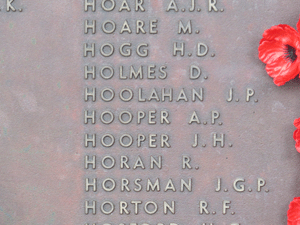 |
Australian War Memorial Roll of Honour October 2018 (J Hawker) |
Thomas Robert Irwin
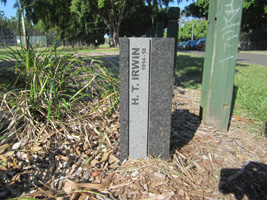 |
.jpg) |
|
The new Memorial Plaque from 2012. |
Tree 41 - a new weeping fig was planted after the old one died. Cuttings from the original figs are used to propagate the new ones. |
Yeronga State School flowers - 2014. |
Thomas Robert Irwin was born in Bundaberg, Queensland, on 2nd October 1896 to Robert Irwin and Gertrude Ellen 'Nellie' Irwin (nee Thompson). He had an older sister Mary, and younger siblings Daisy, William, Walter and Annie. To avoid confusion with his father, he became known as 'Robbie'. His parents had married in 1893 and they had taken up residence on a sugarcane farm - Kenilworth Farm -the same year at the little town of Cordalba about 40 km south of Bundaberg. The farm was managed by Thomas and his brothers - known as 'Irwin Bros'.
Robbie attended school in Bundaberg and one of his classmates was Archibald 'Archie' Wallace Christie, a person who would re-enter his life later during the war. Robbie worked on the family farm as a farm labourer but was well known in the district as a champion shot with the local Cordalba Rifle Team. His father Robert Irwin was in bad health: he had been paralysed on his left side since 1905 and suffered bad health for the year up until June 1913 when he tragically died.
Robbie enlisted in the AIF on 11th February 1916 in Brisbane. He was placed with the 11th Machine Gun Company (11 MG-Coy), given the Regimental No. 79 and embarked aboard HMAT Borda from Sydney in June 1916. He became known as "Bob".
He arrived in Egypt six-weeks later and then travelled on to England for training. In November 1916 he was sent to France to catch up with the rest of the 11 MG-Coy. However, he fell sick with mumps and spent some time in the hospital in St Omer, France. Bob was sent back to England where he was transferred to the 3rd Division MG Company and with a promotion to Sergeant (13 Feb 1917).
After more training in England he was finally off to France again to join up with the 23rd MG Coy (a unit within the 3rd Div MG Coy) and caught up with them in November 1917. Robbie was promoted to 2nd Lt at the battle front at Ploegsteert Wood (or Plug Street as they called it). He was known to the men as Bob or "Toc R" or just "Toc". It was a play on words they explained: "T (for Thomas) for Toc-Tel" - a rather imponderable nickname.
By now Bob was due for a fortnight's leave - which he took in England - and most likely visited his grandfather Robert Thompson at Ropley Deans in Hampshire. After that he was back to his unit in France at the end of February 1918. He was promoted again and was now Lt T. Robert Irwin of the 3rd MG Battalion.
In May 1918 Bob was wounded while at the front and while recovering caught bronchitis and was sent to England for six-weeks treatment. He finally rejoined his unit on 3rd July 1918. They were at Hamel in northern France near the Belgian border. The enemy was bombing the Divisional front day and night with all calibre shells, high explosive and gas. The MG battalion was firing 40000 rounds per day (mostly at night, just 2000 in the daytime).
On the 8th August Bob's 23rd Battery of 16 guns was moved into position in a front line trench facing the Germans for the barrage. It was only a few hundred yards separating them. At 4.20am a rolling barrage provided a curtain of shells for the troops to advance. Bob 'hopped over' the parapet at about 4.45am just before the barrage lifted and was struck by an enemy shell in the stomach. His old school mate Arch Christie was near him and saw him struck. Gunner George Baylis (6221) called for stretcher bearers.
Bob was being carried out by two stretcher bearers and was about a half-mile from the trench when another shell exploded nearby. It was about 8 am by this time. He was struck by shrapnel and critically wounded. His stretcher bearers were also struck. Bearer Cpl Frank Ogg (426) died straight away with shell wounds to both legs. The other bearer (Hicks) lay on the ground, and Lt Bob Irwin lay there seriously wounded - still on the stretcher.
 |
The trench map shows the location of the guns of the 23rd MG Coy as at 8th August 1916. The grid reference for the guns (see black dot labelled 23 Bty) is P 10 b 8.1 firing out towards the German trenches at P 13 a 5.0. They fired their guns at 120 rounds/minute from 4.27am until 5.08am, then moved forward with the 10th and 11th Infantry Battalions to capture the German trenches. This is where Lt Irwin was wounded as he left the trench (shown as a red cross) and died middle bottom. At 10.30am the 23rd MG Coy became Divisional Reserve near forward Battalion HQ at the black dot labelled HQ as shown on map. |
Back at the Casualty Dressing Station the medics were waiting for the bearers Ogg and Hicks to bring Lt Irwin in. But no-one had noticed that they hadn't arrived. Gunner Lewis Neville (6594) from the 3rd MG-Coy was sent out to look for them. He was told where to look and found the both of them. Bearers were sent out again and brought Hicks in. He died at the CDS that afternoon.
The next day Bob Irwin was buried where he was killed. Members of the 55th Battalion buried him in front of Accroche Wood (near Hun's Walk). A cross was placed on the grave. Sgt Claude Cocks (2785) put a bayonet in each corner of the grave and wound barbed wire around it.
Mrs Irwin was notified (on 17 August 1918) that he was wounded (but unbeknownst to her he had died on the 8th August). This was subsequently amended to DOW (died of wounds). His gun club in Cordalba announced their deep regret at his death, and also noted the death of a fellow member Ernie Reiman (2645A) of the 49th Battalion. They died 3 days apart in France.
In April 1920 Bob was reinterred at Villers-Bretonneaux Military Cemetery, about 1½ miles north of Villers-Bretonneaux. Back in Australia, Mrs Irwin moved to Annerley, Brisbane, to a house at 16 Prince Street she named "Glen Robbie" in his memory.
Bob's grandfather Robert Thompson called him "Risen from the Ranks Robbie" to acknowledge his achievement of being promoted from Sergeant (an NCO) to an officer. In a memorial notice in The Queenslander on 9th August 1922, Thompson wrote:
Until Resurrection, Reveille. |
 |
| The tree near Robbie Irwin was decorated with wreaths from Year 5H students from Yeronga State School. Jessica Boyd left a nice card. Thanks Jess. |
 |
Australian War Memorial Roll of Honour October 2018 (J Hawker) |
Alfred Olof Johnson
 |
Tree 55 - A flame tree was originally here but died and has been replaced with ornamental grass.
|
Alfred Olaf Johnson was born in Mackay, Queensland, on 19 July 1898 to parents Jens Peter Jensen and his wife Marie Antonette Jensen (nee Tronsen). Jens it appears, migrated to Brisbane in about 1880 from Denmark, and Marie (a Norwegian, aged 20) from Hamburg aboard the ship Humboldt. Jens anglicised his name soon after and became known as John Peter Johnson. Alfred had older siblings Peter Marius, Lillie Rose, Aagot Antoinetta, Charles, Severen Brooklyn, and Ellen Antonette. The change from Jensen to Johnson, and the six different ways of spelling Tronsen has lead to many transcription errors in the Government records.
Alfred was educated at West End State School and became a Cadet, Junior Cadet, Senior Cadet and finally joined the Citizens Forces (Militia). His father, John Peter Johnson, was a Leading Seaman, Royal Australian Navy Reserve, in the Naval Guard Section at the Naval Depot, Kangaroo Point, Brisbane.
Alf became a canister-maker (making tin cans for food) and sheet iron worker in Brisbane. He was not a tall man, measuring in at 5' 4½" with a chest measurement just a half an inch under the army's requirement for entry. He had already offered his services to the army four times but they had rejected him because of his chest size. To meet the standard, Alf undertook a vigorous training program and finally made it. On 18 December 1916 he presented himself at the recruiting office and was accepted. He was 19 years 6 months old and placed with the 9th Reinforcements, 52 Battalion.
Alf took a train to Sydney and departed aboard A33 HMAT Ayreshire on 24 January 1917 arriving in England on 12 April 1917. He was sent to Codford for training and left for France in August that year. On the 24th August he was taken on strength with the main body of the 52nd Battalion.
By this time the focus of AIF operations had moved to the Ypres sector in Belgium. There the battalion had been involved in the battle of Messines between 7 and 12 June and was about to participate in the battle of Polygon Wood. In early September the Battalion undertook training and drill including some specialist training. It was here that Alf practiced use of the Lewis Gun. The battalion had a practice attack on the 19th and by the 23rd September they were in a supporting role charged with the task of reconnoitring the German front line. In the evening of the 23rd they replaced the 21st Battalion at the front. Battalion HQ was at "Anzac" Redoubt (Pillbox) near Garter Point, and Alf's company (A-Coy, 3rd Platoon, Machine Gun Section) was 150yds to the south at Polygon Wood (so named for its shape). The map below shows the position:
 |
This is a copy of the actual map used by the 52nd Battalion in September 1917. The red cross marks the point at which Alfred Johnson died. You can see the words "Garter Point" directly above it, and the 5-sided Polygon Wood below. The HQ was in the structure to the left labelled "Anzac". The map is "Westhoek 1/10000" and the location of his death is J3.a.6.3. This is the "J" sector of the map although the letter is not visible. The "3" refers to the four squares around the numeral "3". The "a" is quadrant "a" which is top left (with Garter Point in the centre). The 5.1 refers to the horizontal and vertical measurements on a 10 point scale starting at the bottom left of the quadrant. |
It was Sunday afternoon, about 5 pm on 23rd September. The section was still in Polygon Wood and getting ready to move out of the support line. A German shell exploded and the machine gunners were buried. Two of Alf's mates - Eddie Burow (2136) and George Steemson (3498) - were just 20 yards away and raced to help. When the men were dug out it was found that four were dead and two wounded. Alf was one of the dead. It was 23 September 1917. The other dead were Richard "Curly" Johnson (1540), Eric Stewart (3590), and Fred Wells (2270). The bodies were badly mutilated from the shellburst.
Stretcher bearer Doug Banks (2826A) arrived about 6pm to collect the wounded. The four dead men were lying together. Cpl Charles Tayler (1750) was charged with burying the men. They dug dirt out a shell hole on the ridge and covered the men. Fierce bombardment continued and Tayler decided it was best to seek cover. He found it impossible to mark the graves; and if Tayler found it impossible then no one else would be able to manage. Tayler, a very modest man, was to be awarded a Distinguished Conduct Medal and a Military Medal for his bravery under fire a year later (he crossed no-man's land under fire to capture a German machine gun which he then used on the retreating enemy). A week after burying Alf, he, himself was wounded and sent to hospital.
Mrs Johnson renamed her home in Ridge Street, City View Estate (Greenslopes) as "Garter Point" in memory of her son.
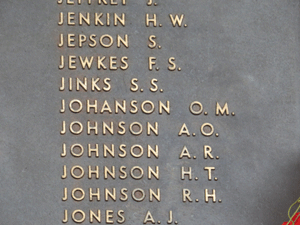 |
Australian War Memorial Roll of Honour October 2018 (J Hawker) |
Marshall Vivian Henry Jury - Yeronga State School, wounded Galliopli, DOW
 |
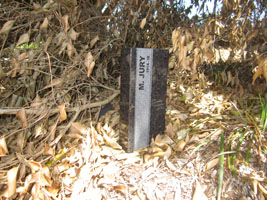 |
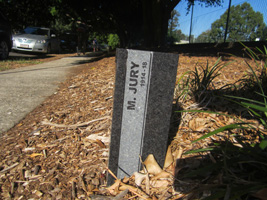 |
Pte Jury - 2nd Light Horse |
The storms of November 2014 broke branches of the neighbouring weeping fig of Pte Olly Rush. |
Jury's tree (# 3, see below) was a flame tree that has since died. |
Marshall Jury was born on 6th June 1886 at Rose Park, Adelaide, the first child of Frank and Elizabeth Jane Jury (née Francis) - also Adelaide-born. He came with his parents and settled in to a home in Killarney Street Yeronga, just opposite Yeronga State School where he enrolled. Killarney Street is an extension of Honour Avenue and he lived here with his brother George and sister Gladys (his other siblings Myrtle and Harold had died previously). The younger children were enrolled at Yeronga State School. The father, Frank, was a butcher in Yeronga.
Marshall was an experienced stockman so when he enlisted in the army on 1 September 1914 - less than a month after war was declared - he was placed as a trooper with the newly raised 2nd Light Horse Regiment. Marshall sailed from Brisbane on 25th September aboard A15 Star of England and disembarked in Egypt on 9 December. Here he trained at Heliopolis until the 9th May 1915 when they sailed - dismounted - for Gallipoli, arriving there on 12 May joining the Anzacs already present. For the next three months they manned the trenches at Pope's Hill and Quinn's Post in Monash Valley where every day men from the 2nd Light Horse were being killed and wounded.
An offensive planned for 7th August (1915) had as its main objective the strategic position on the hill known as Baby 700. It was recognized that an unaided attack across the Nek against Baby 700 was almost impossible. The plan involved a simultaneous attack from the heights of Chunuk Bair and a simultaneous feint attack from Quinn's Post. However, the Turkish machine-guns covering No-Man's Land between Quinn's and the Turkish trenches facing it were not destroyed or neutralized. The first assault wave was mown down and the officer commanding the attack decided to call it off, but not before Marshall Jury was struck by a Turkish bomb and severely wounded.
The Regiment lost 16 killed and 37 wounded of the 56 who charged in this first wave. Marshall was taken by ship to hospital in Malta and his father was telegrammed on the 13th of August that his son was "dangerously ill". It was all over for Marshall on the 25th August where he succumbed to his injuries and death supervened. He was buried the next day at the Pieta Military Cemetery at Valetta on Malta. His father wrote to the army asking for more news of his son's health and was finally told the devestating news. The 2nd was withdrawn from the front line in September and left the peninsula on 18 December.
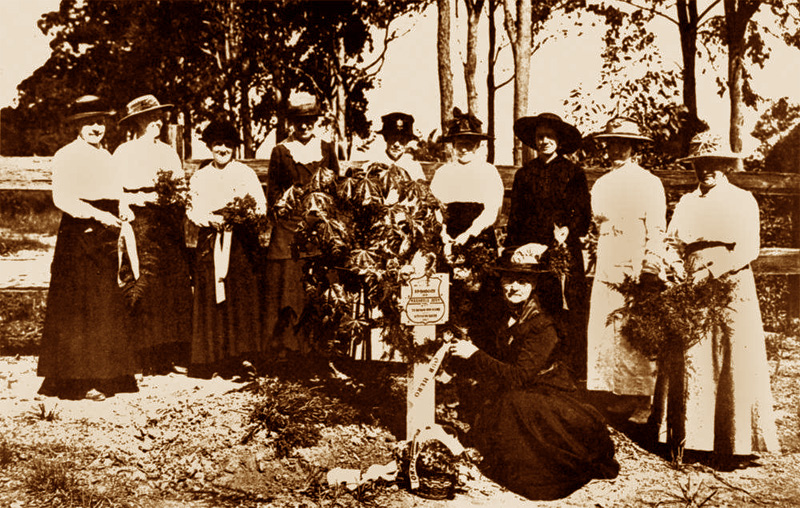 |
Councillors' wives gathered around the No. 3 memorial tree dedicated to Marshall Jury, Yeronga Park, 26 July 1918. The plaque and flame tree were placed there during the first ceremony on 15th September 1917. They are decorating the trees with wreaths the following year. This followed the second planting of trees earlier in the day in which 31 soldiers were remembered. Photo from The Queenslander 27 July 1918. (SLQ. 69467). The tree in the photo is a flame tree and is the second tree along in Honour Avenue from the Park Road gates. Mr and Mrs Jury lived across the road in Killarney Street and could see the tree from their home. This tree has not survived as the big weeping figs created too much shade. |
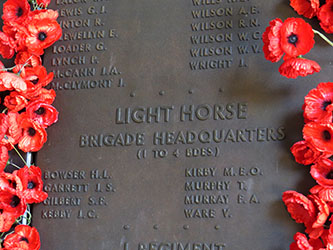 |
 |
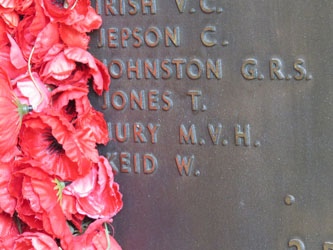 |
Australian War Memorial - Canberra. Here begins the names of the fallen from the 2nd Light Horse. (J Hawker) |
Australian War Memorial - Canberra. The 2nd Regiment of Light Horse starts here. (J Hawker) |
Australian War Memorial. Marshall Jury - 2nd Light Horse. (J Hawker) |
MOURNING DRESS
Photos like the one above show the mourning dress of the relatives. In Australia - as in other parts of the British Empire - the traditional mourning dress of black crepe for a year or more after a death had been in decline since 1914. Black does predominate in dress of the grieving relatives, but we would also see many men and women in ordinary clothes or perhaps with just a black armband and no bodily emblem of their loss. It was a time when the Government discouraged deep mourning as bad for the nation's morale.
Leslie Manson Juster
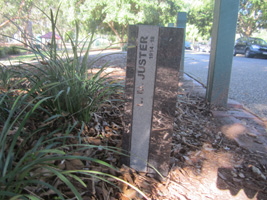 |
.jpg) |
 |
Pte Juster - 12 Bde Artillery |
Juster's tree (#22) - the original weeping fig was replaced. |
Flowers on the magnificent old weeping fig (#22) that was planted in 1917 and is still alive. |
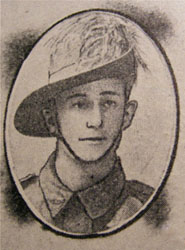 Leslie 'Les' Manson Juster was born on 23 December 1897 in Brisbane to Isaac James Juster and Anne Margaret Juster (nee Manson). His father Isaac had migrated to Brisbane from his home in Essex, England, in about 1883 and set up a wholesale and retail grocery and produce shop in Wellington Street East Brisbane in 1885. Isaac met Ann Manson in Brisbane. She had migrated from her home in Jedburgh, Scotland, aboard SS Roma arriving in Brisbane in May 1886. They married in 1890 and had a son Harold Victor in 1891 and Les in 1897.
Leslie 'Les' Manson Juster was born on 23 December 1897 in Brisbane to Isaac James Juster and Anne Margaret Juster (nee Manson). His father Isaac had migrated to Brisbane from his home in Essex, England, in about 1883 and set up a wholesale and retail grocery and produce shop in Wellington Street East Brisbane in 1885. Isaac met Ann Manson in Brisbane. She had migrated from her home in Jedburgh, Scotland, aboard SS Roma arriving in Brisbane in May 1886. They married in 1890 and had a son Harold Victor in 1891 and Les in 1897.
The family left their home in Wellington Road at Kangaroo Point after living there 11 years and shifted to Cracknell Road, Annerley, to a home they named 'Jedburgh'. The boys attended The Normal School in Edward Street, Brisbane (City). Les became apprenticed to an electrician.
1914 was a big year for the family. Son Harold married Elsie May 'Maysie' Ogden, and the parents travelled to England (aboard SS Beltana) presumably to visit family there and possibly in order for Mr Juster to carry out his trade as a tea merchant. They landed there the day war was declared. After their short stay they returned to Brisbane (aboard SS Borda) arriving in November 1914. Their son Les was in the Citizen's Forces, 9th Battalion, and he spent the next year training (part-time) at the Drill Hall at Annerley and in the camp at Lytton, as Australia became more and more committed to the war. Les was ready to serve his country.
In December 1915 Les Juster enlisted in the AIF (Reg. No. 20810, see photo to left). He had one year's experience with the Citizens' Forces and was now ready to serve his country. He was nearly 19 and was an 'electrical improver' (a part-qualified electrician, possibly not having completed his apprenticeship). Because of his age, parental approval was required - and given.
Les was placed with the 9th Field Artillery Brigade and departed Sydney aboard HMAT Argyshire A8 in May 1916 and arrived in England two months later. Apart from going AWL twice - for a day each time - Les kept out of trouble during his training. He left for France in December 1916 and joined his unit as a gunner on 6 January 1917. The 9th FAB was a unit within the 3rd Division Artillery. Back in Brisbane, his mother, after returning from England took a leading part in raising funds for the Disabled Soldiers' Association, and was an active member of the bridge circle formed for that purpose.
In February 1916 Les was transferred to the 12th FAB (46th Battery). The 12th FAB were are Frechencourt on the Somme River in Northern France. They had just taken a new position and there was much Australian action around the Butte de Warlencourt area where they set up. They successfully took Lagnicourt in late February and moved towards Bapaume for its defence against the Germans.
The Anzac artillery had just been reorganised in early 1917. The 12th FAB became the 12th Army Brigade and no longer assigned to any particular Division. In May we find them with the 3rd Australian Division at the Belgian border. They are a part of "I Group" in the Messines-Ploegsteert area just over the border. Their task was to cut barbed wire the Germans have used to protect trenches to the east of Messines. Cutting is achieved by a barrage of shells on the wire. This was is in preparation for "The Battle of Messines" the British had planned for early June.
Les's I-Group (45, 46, 47th Batteries, including Les in the 46th) manned a number of 18-pounders and howitzer in the area to the SW of Messines, just to the NE of Ploegsteert. It was near a farm known as Petit Pont Farm - just a farm on the Rue de Petit Pont (road). They completed calibration of guns and 'datuming' (measuring heights). Their HQ was a few 100 yards to the west at L'Ahouette Farm. The CO was Lt Col Furnivall.
On the night of 28/29 May, I-Group unleashed a barrage of shells on the German positions to support a party of 120 men entering the enemy trenches. In response the Germans shelled the 3rd Division artillery (see map). The shelling from both sides was intense. The Germans used thousands of 10.5 cm and 15cm shells (including gas shells) on I-Group's artillery in the Petit Pont area. From noon 31st May to noon 1 June the "T.17" area was shelled. It seems that Les was here on the 18-pounders when he was struck and wounded. He may have been with the 4.5" Howitzers in the "U.25" area as they were targeted from noon 1 June to noon 2 June. We will never know but it seems more likely that it was in "T.17". Either way, he suffered a terrible shell wound to the abdomen.
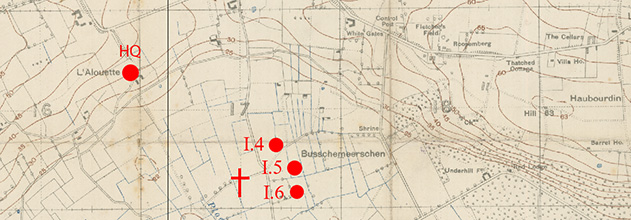 |
This is the trench map used by the 3rd Division Artillery in May 1917. I have added the locations of I-Group HQ and the location of the three 18-Pounder batteries I.4, I.5 and I.6. Les was manning one of the guns here when he was wounded. I have shown this with a red cross. He died of his wounds six weeks later (16 July 1917). This map is "Ploegsteert 28 SW4, July 1917". |
Les was taken to the Casualty Clearing Station and operated on. He was in a critical condition and had to be transferred to St John's Ambulance Brigade Hospital in Etaples. Here he underwent more operations. Les had several rigors and never rallied. He died at 2.20pm local time on 16th July 1917.
An oak cross was made and erected on his grave. The matron and sister at the hospital both wrote to his parents.
Les's family inserted a memorial notice in the paper each year on the anniversary of his death (Brisbane Courier, 1 June, 1925).
| He did but do his duty simply, bravely And in the doing, died |
In 1928, they wrote "His Duty. Nobly done." Les's mother Ann died in 1933, and his father Isaac in 1947.
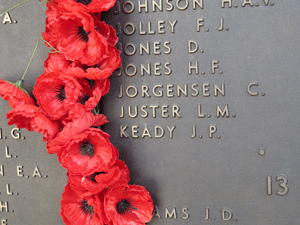 |
Australian War Memorial Roll of Honour October 2018 (J Hawker) |
Arthur Leslie Kenyon - lived across the road
 |
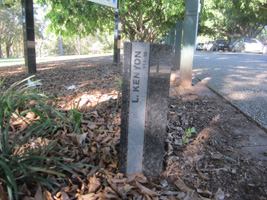 |
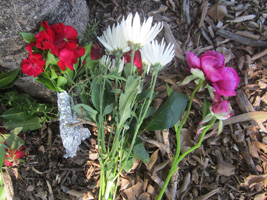 |
Tree 2 - a beautiful big old weeping fig was planted here in 1917. |
Yeronga State School flowers. |
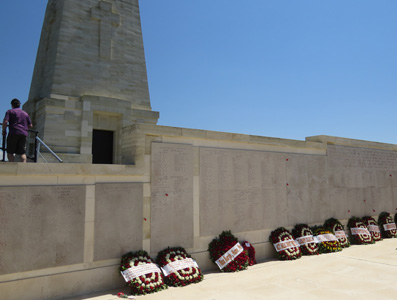 |
 |
| On Anzac Day 2013, the Secretary of Stephen's RSL - Jim Hawker - visited Gallipoli. He visited Les Kenyon's grave at Lone Pine Cemetery to the southern end of Anzac Cove on 26th April and placed a poppy in the memorial. (Jim Hawker) | This photo shows a close-up of the poppy beside Les Kenyon's name at the Lone Pine Memorial. (Jim Hawker) |
Arthur Leslie Kenyon was born in Brisbane on 21st January 1894 and was known as Les. His parents were John Clarke Kenyon (b 12 Nov 1860 - a merchant tailor in Queen Street) and Isabella Amy Kenyon (nee Atkinson, b 1866) who lived at "Hillcrest" on the corner of Christensen St and Park Road Yeronga directly opposite the school. It was in this home that their family of five boys and a girl were born. Les attended Yeronga State School as did his brothers and sisters.
This extract from Queensland State Archives Enrolment Register for Yeronga State School [ID 868280] shows that Leslie Kenyon was enrolled on 26 August 1902 at the age of 8 years 6 months. Father's occupation is "Tailor". He left in July 1905 (last column). |
Les began his secondary schooling at Brisbane Central School (now Brisbane State High School) in 1906 and in 1908 was awarded a bursary to attend Brisbane Grammar School.
Les became an insurance clerk in Brisbane and joined the 9th Infantry CMF (Moreton Regiment, Militia) where he became a 2nd Lieutenant. The Kenyons had lost two infant sons (Frank and Leonard) before Les was born. Leonard died as a 12 day old baby in 1896, and Frank died as a 6 month old baby in 1902. On 27 May 1915 Les joined the AIF. Les headed for the Middle East aboard HMAT Boorara (A42) as part of the 6th Reinforcements 15th Battalion.
.jpg) |
.jpg) |
Kenyon's Tree (#2) looking up Park Road to the school. |
Looking up Honour Avenue from beside Kenyon's tree (#2) on the left. |
Cpl Kenyon arrived at Gallipoli on 2nd August 1915. He was too young at 21 to be an officer on overseas duty so to ensure he was able to fight, he resigned his commission and returned to the ranks as a private. On 6 August, the Allies launched an offensive in an effort to try to break a deadlock at Gallipoli, during which the 15th Battalion attacked the Abdel Rahman Bair heights, which was known to the Australians as "Hill 971". Casualties were heavy right from the start. The following day after Pte John James Duncan was wounded (actually he was killed) Les was promoted to the rank of Corporal. On the afternoon of 8th August Les started in a charge on the foothills of Hill 971 at Kasa Dare by the regiment sent to draw Turkish fire while the English infantry attacked Hill 971. He was hit by bullet while on top of Hill 60. The battalion had to evacuate their position and leave dead and wounded where they lay. His friend Pte John McKenzie (2170) found him lying on his front at daybreak and when he tried to give him water he discovered the awful truth of his death. McKenzie had been with Sgt Kenyon since training at Enoggera, Brisbane in 1915.
It was not clear to authorities whether Les was killed or just missing as his body was not recovered. His parents were notified that he was missing in action and advertised in Queensland newspapers asking if anyone had information about Les Kenyon. Mrs Kenyon received a field post card from Les dated 4 August 1915. She wrote to the army on 3rd October asking if they had any information and asked if he may have been taken prisoner by Turkish forces. The army said they would let her know as soon as any information came to hand. A Court of Enquiry convened in Egypt on 19 April 1916 found that Les Kenyon had in fact died on 8th August 1915. This information was conveyed to Australian authorities and Mrs Kenyon on 5 May 1916.
 |
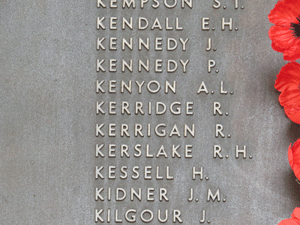 |
Australian War Memorial - Canberra. Here begins the names of the fallen from the 15th Battalion. (J Hawker) |
Australian War Memorial. Les Kenyon - 15 Bn. (J Hawker) |
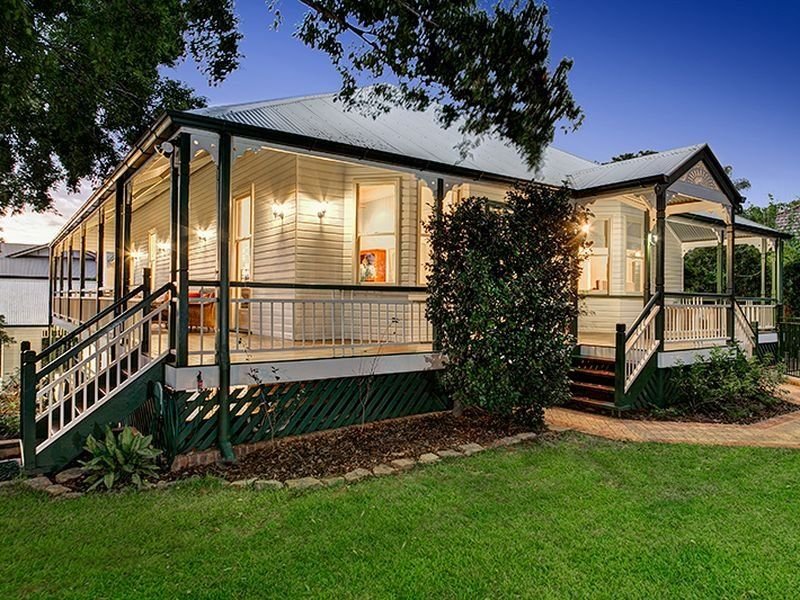 |
The Kenyon family home "Hillcrest" at 81 Park Road Yeronga sold for $1.6M in 2015 .It has been the home to just four families since it was built in 1905. The real estate ad talked about the laughter at the family gatherings obviously not knowing about the events of Gallipoli 1915. The original Hillcrest property, spanning 11.6 acres, was acquired by James Toohey in 1862 and used to sell cattle on their way to South Brisbane. Over the next 22 years the land was divided into seventeen sections and sold, with the portion at the top of the hill being sold to John and Isabella Kenyon in 1901. The Kenyons built Hillcrest in 1905. |
Thomas Joseph Kerby
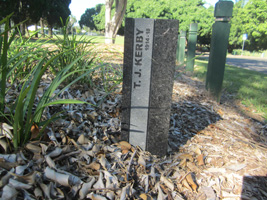
Tree 56 - was once a flame tree
but
died and needs replacing.
Thomas 'Tom' Joseph Kerby was born in Orange, New South Wales, in 1874 to parents Thomas Joseph Kerby and Bridget Kerby (nee O'Brien). He had just the one sibling, an older sister Theresa (b 1872). At the age of 26, Tom married Jane Green in Sydney (in 1900) and took jobs around NSW working mainly with horses. He was in Dubbo for a while, then Murwillumbah before moving to Brisbane. Here he took a job at a horse stable as a stud groom.
Tom and Jane had two daughters, Doris Ellis and Mary Theresa, and settled in to their new home at Tennyson Avenue, Yeerongpilly.
In February 1916 Tom enlisted in the AIF and was placed with the 49th Battalion (8th Reinforcements) - Regimental No. 3203. After some initial training in Brisbane he took a train to Sydney where he departed for England aboard HMAT Demosthanes A64 on 23 December 1916.
Tom arrived in England in March 1917 with the 8th Reinforcements and was sent to Codford for more training. After four months he was off to France to join the 49th Battalion on 26th July at the front near the River Lys in Belgium. From then until the 15th August the battalion was in training. Then it was off to the front line at Kemmel, six miles south-west of Ypres, and finally to Ypres on the 21st September 1917.
| Trench map [Westhoek 1/10000] used by the 49th Battalion for the battle of Polygon Wood on 26 September 1917. The original British front line is where the red arrow line begins. The arrow shows the direction of the advance of the 49th Bn first past the Green Line and then to their objective - the occupied German trenches at the Blue Line (J4d4.6 to D28a2.3) which they captured at 7.55am on the morning of the 26th. The red cross shows the approximate position of where Tom died (J4b1.9). |
The battalion took billets at Ypres and then began to prepare for the battle of Polygon Wood. At 5.30pm on the 25th September, the battalion left their billets and headed east along the Rifle Farm track towards the German trenches. By 8.15 pm that night they were at Westhoek Ridge at the British front line. Further west was the dreaded and hostile no-man's land. The battalion (as part of the 13th Brigade advance) began their advance. They reached their first objective by 4.30 am the next morning and then their main objective - the German front line trench (the Blue Line) at 7.55am that morning (26th).
During that advance there was heavy return fire and bombing from the Germans. Tom received a gunshot wound to the abdomen and died. The approximate location is marked on the map below. That morning 25 ORs (Other Ranks) were killed and 99 men wounded.
In November, back in Brisbane, his sister wrote:
| Oh God of eternal pity, keep in remembrance the souls of those who shed their blood for us. (Mrs Theresa Nicoll, Currumbin. The Queenslander 10 Nov 1917). |
His niece, wrote:
| Another hero gone to rest, to sleep forever with the blest. And now he reaps the great reward, meted out by Thee, O Lord. (Tessy Brayley, Currumbin. The Queenslander, 10 Nov 1917). |
A tree was planted in his honour in Yeronga's Honour Avenue during the second planting on 26th July 1918.
Tom's daughter Mary married Leo Gair in 1924 and she died in 1952. His other daughter Doris died in 1927. Tom's wife Jane died in 1948.
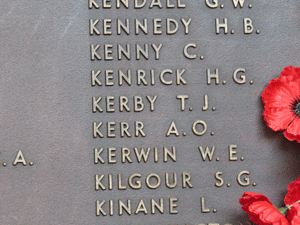 |
Australian War Memorial Roll of Honour October 2018 (J Hawker) |
Bertie Nugent Ketteringham
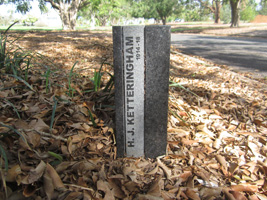 |
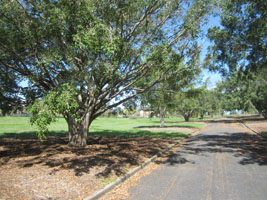 |
.jpg) |
Bertie Ketteringham's plaque. The initials have been transcribed wrongly. |
Tree 97 - a big old weeping fig was originlly planted in 1918. The road leads up to the Cenotaph. |
Bertie Ketteringham's tree today looking down the Avenue to the Park Road gates. |
The Ketteringham family lived at 68 Fernvale Road in Annerley, Brisbane. Bertie John Nugent Ketteringham was born on 19 March 1884 to William Toma Ketteringham and Madelaine Margaret Kinsella who married the following year. By the time the First World War started in 1914, the family consisted of the mother Madeline (Margaret Mary) Bertie 30, Phoebe 23, William 21, Charles 19, Percy 15, and Maurice 9. Bertie's father William had passed away in 1910, and he had lost others by this stage. They were Stanley (1888-1891), Constance (1886-1888) and Harold (d 1897). Phoebe died at the end of 1914.
Bertie's brother Percy enlisted in the army on 11 January 1916 he was just 17 years old and working as a postal assistant. He was quickly discharged as he was underage despite his mother giving him permission. As well, the army believed that an assault charge he made against a fellow soldier was fabricated and that Percy was unsuited to army life. He reapplied for enlistment on 3 January 1918 with the Australian Flying Corps and became a mechanic at Lavarack Barracks in Melbourne. He spent the year there and was discharged at the end of 1918. Percy stayed in Melbourne after the war, married Anne Davis in 1936 and died in Parkville, Melbourne in 1970 aged 72.
Bertie Ketteringham married Janet Draper Cooksley at St Stephen's Cathedral in 1909 but she died in 1912, aged 31. Bertie enlisted in the Mercantile Marine Reserve (Merchant Navy) and worked as a "Donkeyman" aboard HMS Eaglet. A donkeyman is the term used in the Merchant Marine for what would be called in the navy a "stoker" - a person who operates and maintains the small engines on board the merchant fleet. Bertie developed bronchopneumonia during the Spanish Flu pandemic and died in the Seamen's Hospital at Greenwich, London, on 3rd July 1918. The close quarters of a ship made ideal conditions for the spread of bacterial pneumonia.
.jpg) |
.jpg) |
.jpg) |
Some other views of Ketteringham's tree. |
Kids love climbing in these old weeping figs. |
View from the Villa Street side of the park. |
A tree was not originally planted to mark Bertie Ketteringham's death. When the Brisbane City Council installed new plaques in 2014 they included one for Percy Ketteringham near a previously planted tree at the very end of the original planting. Until 2014 there were 96 trees to mark the fallen but now there are 97.
By the time Mrs Madeline Ketteringham died in January 1944, she had seen the deaths of her husband (1910) and seven of her nine children: Constance 1888, Stanley 1891, Harold 1897, Phoebe 1914, Charles 1916, Bertie 1918, and Maurice 1925. The two who outlived here were William who died in 1954 and Percy 1970. They were all buried in the South Brisbane Cemetary. Bertie's wife Janet was buried at Nundah Cemetary, Brisbane.
Information Board
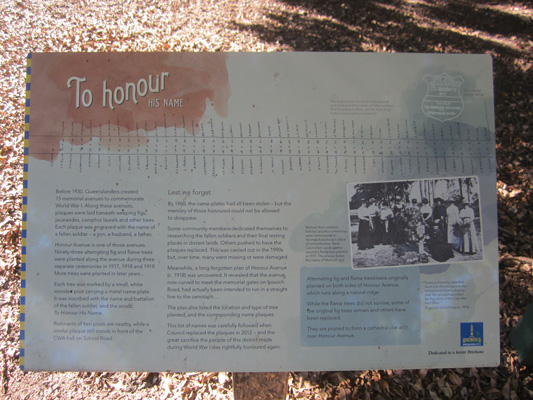 |
Information board prepared by the Brisbane City Council. Click image to enlarge. |
Walter Larsen
|
.jpg) |
Larsen's Tree (#57) is a replacement of the original, now missing a branch from a storm. The Brisbane City Council used cuttings from the original figs to propagate the new ones. |
The storms of November 2014 caused a lot of damage, particularly to Larsen's tree. It had to be replaced. |
 |
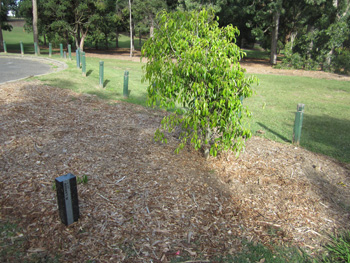 |
Walter Larson - forever remembered. |
In February 2015 a new weeping fig was planted to replace the damaged one. |
Walter Larsen was born at Tamaree, just outside of Gympie (to the north of Brisbane) in January 1897. His mother Alice Larsen (nee Lyons) was born in Brisbane in 1874, but his father Jens Peter Larsen migrated to Australia from Copenhagen with his parents sometime in the 1880s. Jens and Alice married in 1891. They had eight children starting with Peter (b 1891), then Florence, William, Walter, Harry, May, Andrew and Lily (b 1915).
The family lived at Gympie for some of the time but settled into a home in Frederick Street, off Venner Rd, Annerley. Walter obtained work as a carrier.
In February 1916 Walter joined the army (Reg. No. 2786) and began training in Brisbane and Fort Lytton camp at the mouth of the Brisbane River. He was placed with the 47th Battalion but eventually transferred to the 52n Bn, 6th Reinforcements, and departed Sydney in October 1916 aboard HMAT Ceramic A40 for England. Upon arrival he was sent for more training before being sent off to France in February 1917.
In France he joined his battalion at the front line in Flers. Two days after arrival he was in the front line trenches, his battalion having relieved the 49th Battalion. March saw them move to Buire for training then marching and training at Mametz, and then entering the front line again just to the north of Lagnicourt relieving the 19th Bn. Here they suffered many casualties and this would have been Walter's first real experience of the large number of deaths in trench warfare.
In April 1917, the battalion participated in the advance that followed the German retreat to the Hindenburg Line, and attacked at Noreuil on 2nd April. On the 10th the battalion made another attack on the German front line but was unsuccessful. Both side resorted to intermittent shelling and it was here on the afternoon of the 13th that Walter was wounded. He suffered a shell wound to his left thigh and had to be evacuated to the Casualty Clearing Station nearby but thence to hospital in England being admitted on the 24th April. His parents were notified by telegram (3rd May) and letter (10th May). Walter was discharged on the 1st June 1917.
In May 1917, back in Brisbane, his brothers Peter (R.3319) and Harry (R. 461) enlisted in the 41st Battalion at the same time. They departed Brisbane for England soon after.
Walter was given two weeks' furlough in England but then suffered a relapse of his old thigh injury that necessitated more recovery time. Eventually he was off to France and rejoined his unit on 26th November 1917 in Belgium. For the next three months the battalion trained and marched, providing working parties at the front for the general improvement of the trenches. However, at the end of February they were manning the front line at Locre. In March they were back to training. However, that was about to suddenly change: utilising troops freed by the collapse of Russia in October 1917, the German Army launched a major offensive on the Western Front at the end of March 1918. The Australian 4th Division was deployed to defend positions south of the River Ancre in France.
In Brisbane, the Stephens Shire Soldiers' Help Society held a meeting at the Walker Memorial Hall in Annerley on the evening of the 4th January 1918. Presentations of illuminated scrolls were made to Walter and Peter Larsen (in their absence, no doubt, Mr and Mrs Larsen received them).
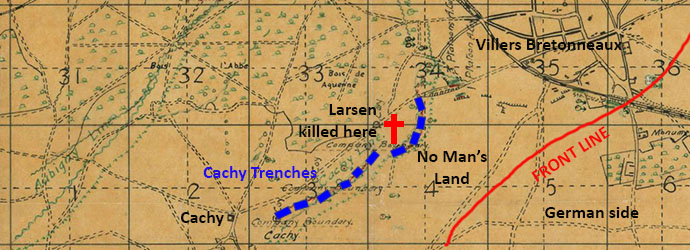 |
Trench map taken from the 52nd Battalion War Diary. This is the map used by the battalion for the action on the 4th and 5th April 1918. I've marked the approximate position of where Walter fell with a red cross. |
At Dernancourt, on 3rd April 1918, the 52nd Battalion prepared for a major attack (see map above). They took over the Cachy Switch trenches located between Villers Bretonneux and Cachy. On the 5th the battalion assisted in the repulse of the largest German attack mounted against Australian troops during the war. However, it was to be at the cost of Walter Larsen's life. In the advance from the trenches he was struck and killed.
As a side note, the German threat persisted through April, and on 25th April 1918 the 52nd Battalion participated in the now-legendary attack to dislodge the enemy from Villers-Bretonneux. In Brisbane, Mr and Mrs Larsen received the dreaded telegram, most likely from the hands of the local minister of religion. List No. 399 of casualties appeared in the papers and this time Walter was listed as KIA. As well, another planting of trees in Yeronga's Honour Avenue was done. On 20 July 1918, 31 trees were planted by relatives of the fallen soldiers. This time there was one for Walter Larsen. Mrs Larsen most likely did the planting.
A Memorial Service was held on Sunday, 2nd March, 1919, at the Albert Street Methodist Church to pay tribute to all of the members of the church congregation who had died in the war. Walter's name was read out during the service, and a poem recited in the soldiers' memory. It began:
| For manly courage under grievous loss; For faith of woman bowed beneath her cross; For Hope that bravely glowed 'neath stormy skies; For Love that suffered untold agonies. |
Brothers Harry and Peter, after serving with the 41st Battalion in France, returned home safely in early 1919. Mr Jens Peter Larsen died in 1939 and his wife, Alice, in 1940.
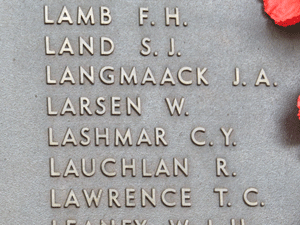 |
Australian War Memorial Roll of Honour October 2018 (J Hawker) |
Joseph Lightbody
 |
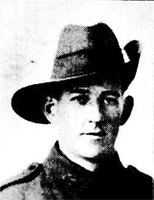 |
 |
Tree 23 - was a flame tree but has since died and replaced with ornamental grass. |
Joseph Lightbody The Queenslander 13 July 1918 |
Flowers beside a neighbouring weeping fig on Anzac Day 2014. |
Joseph Lightbody was born at Pimpama (50km south of Brisbane near Southport) on 15 September 1875 to William Lightbody and Jane Lightbody (née Myles). He had and older brother William (b1874) and younger siblings Isaac, Hanna and Mary. They lived at "Seaview" Southport on Queensland's Gold Coast. Here they attended the local State School.
Joseph worked as a farmer for a while but in 1895 at the age of 20 obtained a job as a tram conductor with Brisbane Tramways Company. In 1902 he married Louisa Riley and they soon had children Walter Joseph (b1905) and Hilda Vera (b1907).
After 20 years' meritorious service with the Tramways Company, Joseph retired to enlist in the army. He was described as "Very popular with workmates and held in high esteem by the travelling public". He certainly wasn't doing it for the money: His pay would drop from 2-17-6 as a conductor to 2-2-0 (six-bob a day) as a Private.
Joseph enlisted on 11 December 1915 and undertook training in Brisbane. He was placed with the 11th Reinforcements of the 26th Battalion AIF, and departed Brisbane on 3 March 1916 aboard HMAT Star of Victoria. After a few weeks in Egypt, Joseph was off to France on 30 May 1916 and joined the 26th Battalion on 2 August 1916 (as part of the 2nd Australian Division). He quickly became known as "Lighty" to his mates. The Battalion fought in its first major battle around Pozieres between 28 July and 7 August. After a short spell in Belgium, the 2nd Division came south in October to attack again in the Somme Valley. The 26th Battalion was about to take part in two attacks to the east of Flers, both of which were about to flounder in mud and slush.
Most of September 1916 saw the Battalion training in signals, scouting, bombs, bayonet drill and observation. By the 6th October they were in dugouts at Steenvoorde (Northern France) vacated by the 28th Battalion and providing support. Their first attack was on 13th October where they occupied the front line but after that they had garrison duties and at the end of the month took a train followed by a 7-mile march to Dernancourt. In November they were due to make a major attack. On the 13th they relieved the 19th Battalion on the right sector of the front line at Flers in the late evening.
That night, as was common practice, the Divisional artillery began a barrage prior to the men advancing. But the bombs were dropping short and killed almost no German soldiers in the enemy trenches. Enemy snipers were able to remain active as the 26th Battalion began their charge.
Joseph was part of a group that took the first trench (in what was colloquially known as Goose Alley), and was about 50 yards towards the second trench when he was struck in the stomach by a sniper's bullet. It entered his stomach on the right side and came out at the left hip. Two men picked him up and put him in a shell hole near the German barbed wire about 20 yards from the German front line. That was as close as the men got to the German front line all day. The mist helped save many of the troops but the failure of the artillery to neutralise the German snipers meant that a lot of Australian troops died. Ultimately, the soldiers couldn't take the next line of trenches and had to retire.
On the way back, a mate, Cpl Patrick Dillon (1080) stopped to offer Joseph help. Joseph was confused and didn't recognise him. He was gasping hard for breath and couldn't speak. Pat had to leave him there. His closest mate - Bob Lett (4457) - stopped too but the heavy shelling made it impossible to get him out. From the safety of their trenches they could see Joseph out in No Man's Land. In a second attack the soldiers passed by him again but a shell had exploded and his legs were blown off. The stretcher bearers recovered him in this state and took him for a quick burial. In the fog of war his location and identity became confused.
In fact, on the night of 13/14 November saw 150 casualties amongst the "Other Ranks" and two officers killed. The accuracy of the maps showing German trenches was believed to be a contributor to the failure of the attack.
Joseph's wife Louisa, was informed that he was missing in action, presumed dead. She heard from the Red Cross that the Germans may have come out in the night and took the wounded away, and this may have included "Lighty" (interview with Pte James Kennedy, 4449). The Red Cross checked and said there was no evidence that Joseph was a POW in Germany. The army's Court of Enquiry in June 1917 concluded that Joseph had indeed been killed on the 14th December 1916 as thought. Louisa wrote to the army on 8 August 1917 asking if he may still be alive, nevertheless. They replied that he was considered "killed in action" and sent her his effects on 15 April 1918.
Decades later Louisa was surprised to receive a letter dated 15 October 1936 to say that the War Graves Commission had found a body in a grave at Eaucourt L'Abbaye in France and had recovered Joseph's Identity Disc from it. This, they said, was conclusive proof it was her husband. He was reinterred at the Ovillers Military Cemetery at Ovillers la Boisselle "with every measure of care and reverence". Three years later the army sent Louisa his ID tags (25 November 1939). She died in 1962.
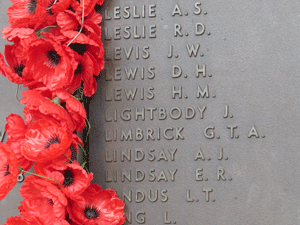 |
Australian War Memorial Roll of Honour October 2018 (J Hawker) |
Albert Lindsay
 |
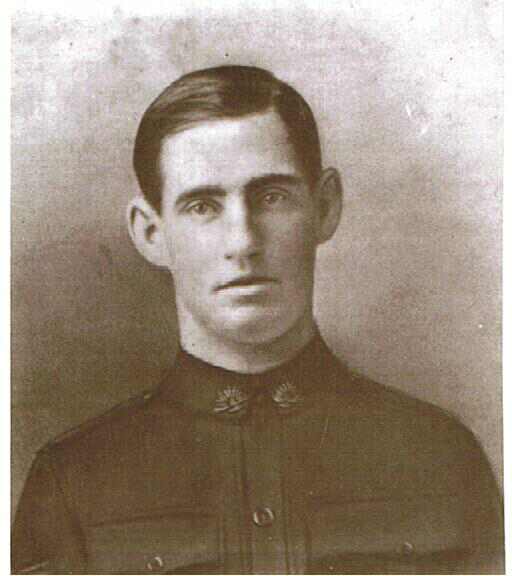 |
 |
Tree 24 - once a flame tree but died was replaced with ornamental grass. |
Albert Lindsay 1914 |
A nearby tree on Anzac Day |
Albert Lindsay was born in Brisbane on 19 November 1888 to John Saunders Lindsay and Emily Lindsay (nee Phillips). His father John was born in Cookstown Tyrone Ireland in 1862 and arrived in Brisbane with his father, brother and three sisters aboard SS Corlic in March 1875. John married 19 year old Emily Phillips in 1884 and they had five children in Brisbane: Emily (1885), Lilly (1887), Albert (1888), May (1890) and lastly Ruby who was born in February 1893. John's wife (Albert's mother) Emily died in August the same year. The family lived in the Brisbane suburb of Toowong (Annie Street) and the children attended the nearby Ironside State School.
Albert became a bricklayer and in 1913 married Jessie Robertina Clark Lindsay. She, by chance, had the same surname as Albert. Jessie was the daughter of Elizabeth Clarke and Robert Lindsay and was born in Stirlingshire, Scotland, on 3 March 1882. She migrated to Australia in 1904.
Albert and Jessie took up residence at Peach St Dunellen Estate (now Greenslopes) and had two children: Jean Mary on 20 April 1913 and James Robert on 6 December 1914. Albert enlisted in the AIF (Reg. No. 671) on 25 February and was placed with the 25th Battalion to train at Enoggera, Brisbane. In May he was part of an 25th Battalion football team from Enoggera Barracks that competed with the Wooloongabba Football Club (his old club) at the Brisbane Exhibition grounds (see photo).
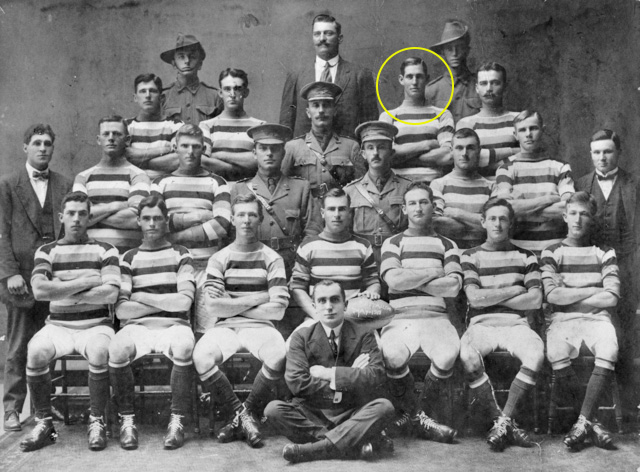 |
Studio portrait of the 25th Battalion Expeditionary Force football team, on the occasion of the game "Soldiers versus Woolloongabba" played at the Exhibition Grounds in aid of the Belgian Fund - 15 May 1915. Soldiers won 6-3. Albert Lindsay - one of the forwards -is circled in the second-back row. To the left is Lieutenant-Colonel David Day Dawson (7th Bde HQ). AWM |
Albert departed Brisbane aboard HMAT Aeneas A60 on 29 June 1915 for the Middle East and expected to go to France to fight the Germans. However, on 4th September 1915 the 7th Brigade (including the 55th Battalion) was sent to Gallipoli peninsular as part of the Anzac force to fight the Turks.
At Gallipoli the Brigade reinforced the depleted New Zealand and Australian Division. The 25th Battalion, however, had a relatively quiet time because the last major Allied offensive had been launched, and turned back, in the previous month (August). Albert was promoted to Acting Corporal while there (19 November). The 55th Battalion left the peninsular on 18 December 1915 and camped at the nearby island of Mudros for a month.
They began further training in Egypt but Albert was accidentally wounded while on guard duty from cartridges exploding in a fire (he was exonerated). However, he was soon out of hospital, promoted to corporal and proceeded to France with the 25th Battalion, landing on 19 March 1916. His was the first AIF battalion to arrive there. Now fighting as part of the 2nd Division, the battalion was about to take part in its first major battle at Pozieres in July.
On the 26th July the battalion moved from Warloy to Albert and bivouacked at Brickfields. The following afternoon they left for Tara Hill where they set up camp. At 7.30pm the following night the soldiers left Tara Hill and got into position for the attack on the German lines due to start at 11.55pm. The 25th Battalion was allotted the centre section of the line and their advance was proceeded by a heavy bombardment by their own artillery (designed to cut the barbed wire).
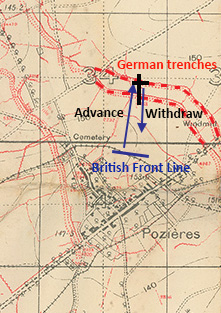 |
Caption for map to left: Section of map used by the 7th Brigade during the Battle of Pozieres (29 July to 7 Sept 1916). The 25Bn approached from the south to the jumping off line (shown in blue). Their objective was to capture the two German trenches (shown in red). The advance was turned back by a German counter-offensive. The black cross indicates where Albert Lindsay died and was buried. The battle was not a success.
At midnight the attack began. Five waves of men went over the parapet. Each of the four companies supplied a platoon for each wave. Their objectives were trenches OG1 ('Old German' front trench), and OG2, the support trench. See map. The right company (A-Coy) was met with heavy machine gun fire and uncut wire. The other three companies of the first wave (including Albert in C-Coy) met less opposition from the German first line (OG1).
Nevertheless, there was still plenty of uncut wire and this is where Albert was killed. The wire stopped them getting into the German first line so they were killed in No Man's Land between the front lines, right up against the German wire. Alex Morrison (685) was with him and he died too. Bill Anderson (560) ran past the bodies and made it to a trench. In it he found Harry Bostock (1888) who had been trying to bring in a wounded comrade and both were also hit and killed. Bill threw the bodies out so they could dig the trench deeper. The shelling was so severe that the bodies were blown up over and over again - many never to be seen again.
The third and fourth waves passed over the OG1 trench and headed for the second line OG2. There was heavy machine gun fire from the second line and casualties were severe. Then followed heavy artillery fire and trench mortar bombs. A small party of C-Coy made it to the second line. However, because not all companies could get through the wire, the second line couldn't be held had to be abandoned. Then the first line had to be abandoned as the men withdrew back to the British line, leaving behind 4 officers and 28 ORs (Other Ranks) killed, and 3 officers and 129 ORs wounded, and 4 officers and 175 ORs missing. It wasn't until the 31st (two days later) that a patrol could get into No Man's Land to recover the wounded and bury the dead.
 |
Australian War Memorial Roll of Honour October 2018 (J Hawker) |
Paul Thomas Henry Love
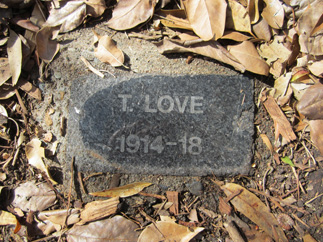 |
 |
25th Bn Infantry |
Love's Tree is No. 25. |
.jpg) |
 |
Beautiful big old weeping fig (Tree 25) was planted in 1917 and is still here today. Yeronga State School oval in background. |
Flowers from Anzac Day 2014. Pte Love's tree is close to the school gate. |
Paul Thomas 'Tom' Henry Love was born in Brisbane on 4th January 1895 to Paul Love and Elizabeth Love (nee Nunan). His father Mr Paul Love had emigrated from Eniskillen, Northern Ireland aboard SS Rockhampton in 1863 and landed in Keppel Bay - the port of Rockhampton, Central Queensland. He was a 20 year old who had spent three years with the Royal Irish Constabulary at Cork. Shortly after his arrival he joined the Queensland police, and did duty in various towns, firstly as a constable in Rockhampton where he met and married Mary McMullan in 1864 and they had a daughter Alice the following year. The family moved around Queensland while Sgt Love moved up through the ranks: Yaamba, Clermont, Tambo, Blackall, Springsure (where he was promoted to the rank of senior sergeant). His wife Mary died in 1889.
Paul moved to South Brisbane and it was here, while living at Alfred Street Annerley, that Mr Love met Elizabeth Nunan (Noonan). They had a son Paul Thomas Henry Love (the subject of this biography) in 1894. He was known as Tom or Tommy to all and sundry. The following year Mr Love retired and before he and Elizabeth married in 1898, they had daughter Norah. Following their marriage they had William, Lily May, Elizabeth and finally John in 1905. In his retirement, Mr Love was at a bit of a loose end so he became proprietor of the Anchor Hotel in North Rockhampton for a while (with his family) before returning to Brisbane. The children all attended the nearby Junction Park State School. Lily died in 1912.
Mr and Mrs Love separated acrimoniously in 1913 and this was a stressful time for all. Tom had joined the Senior Cadets and was disciplined for striking a superior officer (fined £1). Mrs Love moved out of the family home (on Tom's advice) to Tribune St South Brisbane where Tom helped support her on his fireman's wage. When the war began he decided to join and this he did on 21 March 1915 when enlistments for the newly created Brisbane-based 55th Battalion were being called for. He was put with C-Coy and began training.
On Thursday 17th June, the local citizens threw a farewell party for Tom and Norman at the Junction Tce residence of local businessman Mr Charles Luxton. His home was decorated for the occasion with evergreens, golden wattle and roses. There was a spirited rendering of the National Anthem and the two men were presented each with an inscribed watch and wallet on behalf of the residents of Junction Park who spoke of their pride in, and gratitude to, the men for the noble sacrifice they were making for their country, and wished them success and a safe return. At the invitation of Mr Luxton the neighbours remained to enjoy a pleasant musical evening. Mr Luxton's son Charles (Jnr) would later go overseas with the 26th Battalion.
Tom and the first draft of the 55th Battalion departed Brisbane on 29th June 1915 aboard HMAT Aeneas A60, bound for the Middle East. Once in Cairo training began but instead of going to France the battalion was off to Gallipoli, departing Alexandria on 4th September 1915. He was immediately struck down with dysentery but returned to duty two weeks later. At Gallipoli the 25th Battalion had a relatively quiet time because the last major Allied offensive had been launched, and turned back, in August before Tom arrived. He left the peninsular on 18 December 1915 with the evacuation of the 25th Battalion.
Tom was often being disciplined for disobeying commands, and with some short absences without leave he was duly penalised. Nevertheless, these were minor blemishes on a terrific record. After a hernia operation in Cairo in January 1916 he was kept in Egypt for many months recuperating. Finally, in August 1916 he was off to France and rejoined his battalion on the 28th. After a spell in a quieter sector of the front in Belgium, they came south into France in October to attack again in the Somme Valley.
In November, the 55th Battalion was at the Somme about 20 km east of Albert. They were billeted at Dernancourt when orders were received to occupy the German front line trenches just to the north of Flers about 20 km east of their billets. They took the trenches and managed to hold them. They were relieved and headed back to their camp. The next order came on the 12th November (1916). They were to move up to their own front line and relieve the 20th Battalion at 8pm - which they did. The next day they received the order to attack the German line at Gueudecourt and capture the main 'Gird' (Guede) Trench known as OG1 and its support trench OG2. This was to be done at 6.45am the next morning.
On the 14th, at 6.45am the attack began. The plan was to go forward in four waves, each about 30 yards behind each other, and capture the OG2 trench. The first wave at 6.45am was comprised of half of C-Coy and half of D-Coy. They went over the parapet and headed for the German trenches across No Man's Land. Artillery shells rained down and machine gun fire cut down the advancing troops. Nevertheless, the second wave advanced.
It was 7 am. This wave was made up of the other half of C-Coy and D-Coy. Tom was in this group. He was led by the CO of C-Coy Lt William Frederick Donisch, a school teacher from Dalby, Queensland. The first wave made it to the OG2 trench and was managing to hold it as Lt Donisch and his platoons (including Tom) ran across No Man's Land. 'Hopped' is a better description as they ran from shellhole to shellhole to avoid the machine guns of the formidable 4th Prussian Guards. When almost at the German wire Donisch and Tom and many others were struck by shells as they climbed out of the holes. Their men tried to extricate them from the wire but the enemy barrage was so intense they had to abandon them.
The Germans launched a counter offensive and the men scrambled out of the German trenches back across No Man's Land. The casualties were severe. Any man who fell in No Man's Land was destined to die there. Lt Donsich and Pte Thomas Love were reported as missing in action 14th November 1916 along with numerous other men. Casualties amongst the 55th Battalion were six officers and 188 ORs (Other Ranks).
As soon as possible, the fallen men in No Man's Land were buried where they lay. They found Tom's body with rifle loaded and bayonet fixed near where he fell. His shrapnel helmet was near by.This grave in a field about 1 mile east of Le Sars, 4¼ miles NW of Combles (see map below). A rudimentary cross was installed, with name, number, battalion and date of death inscribed.
Mr Love was informed of Tom being MIA a few weeks later. He waited for more news but none was forthcoming until he picked up the Brisbane Telegraph on 23rd April 1917 and read to his shock that Tom was now considered killed in action not missing. Mt Love expected to receive an official letter from the army but none came. He wrote a heated letter and sent them a clipping from the Telegraph containing Casualty List N. 289 and Tom's name. He soon received official confirmation.
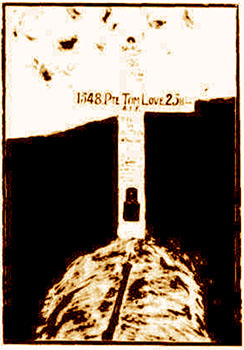 His mate Norman Bell-Booth decided to make a grander cross for Tom's grave. It was about 5 foot above ground with a 2'8" crossbar and made from 8" x 2" hardwood. Norman painted it white and duly inscribed it with black lettering courtesy of the engineers (see drawing). However, just as he was ready to install it he was called away for English leave. While he was away a friend carried it to the field, found Tom's grave, and erected it. When Norman returned he found the grave again and improved it. He placed the weather-beaten rifle and rusty helmet on the grave. In a letter to his parents Norman said "Tom got as far as any man in the attack before he fell, as the position of the grave reveals. If ever in our travels we come to this locality again, I'll always find a few spare hours to visit the old cobber's grave. Convey my sympathy to his father, mother, sisters, and brothers, and let them have this consolation - that he died like a man, fighting in one of the greatest battles the world has ever seen."
His mate Norman Bell-Booth decided to make a grander cross for Tom's grave. It was about 5 foot above ground with a 2'8" crossbar and made from 8" x 2" hardwood. Norman painted it white and duly inscribed it with black lettering courtesy of the engineers (see drawing). However, just as he was ready to install it he was called away for English leave. While he was away a friend carried it to the field, found Tom's grave, and erected it. When Norman returned he found the grave again and improved it. He placed the weather-beaten rifle and rusty helmet on the grave. In a letter to his parents Norman said "Tom got as far as any man in the attack before he fell, as the position of the grave reveals. If ever in our travels we come to this locality again, I'll always find a few spare hours to visit the old cobber's grave. Convey my sympathy to his father, mother, sisters, and brothers, and let them have this consolation - that he died like a man, fighting in one of the greatest battles the world has ever seen."
Caption for drawing to left: Drawing of the cross designed and erected by Cpl Norman Bell-Booth. The headstone reads "Sacred to the memory of an Australian soldier". The Queenslander 6 October 1917, p 28.
In December 1920, Tom's medal - the 1914/15 Star - was sent to Mr Love. His health was now failing and on the afternoon of February 19, 1921, he was stricken with a paralytic stroke and died four days later. Subsequently, as was his wish, the body was conveyed to Rockhampton, his two sons William and John accompanying the coffin, and the remains were interred within the grave of his deceased first wife Mary.
In 1923 Tom's mother Elizabeth applied for his other medals and was sent the remaining medal - a British War Medal. She later (1929) requested additional pension payments from the army as a result of Tom's death. She didn't apply for the pension until her husband's death in 1921 and the 10/- per week (recently 15/- pw) was not enough, given that she was now 57 and not working and too young to claim an old age pension. She died in 1940.
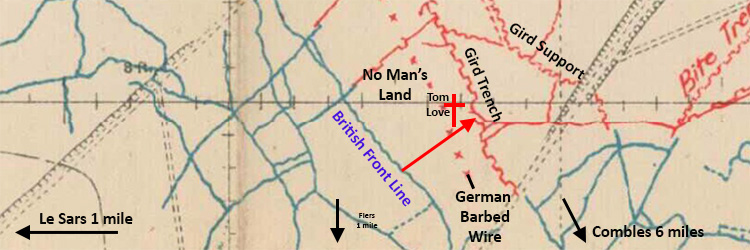 |
Section of the British trench map showing where Pte Tom Love died. The grid reference is M18C.7.9 on the Gueudecort 57C SW1 map 1:10000 correct as at 2 December 1916. The British front line trench where they 'jumped off' is in blue and they headed to the German front line OG1 Gird Trench shown in red. Between the two trenches (blue and red) is No Man's Land where Tom Love was struck down and died. I have marked this with a red cross. Their objective (of Tom and the C-Coy) was the second line of blue trenches known as OG2 - the Gird Supply Trench. The German barbed wire is marked with crosses. Tom Love and Capt. Donisch died on the wire. |
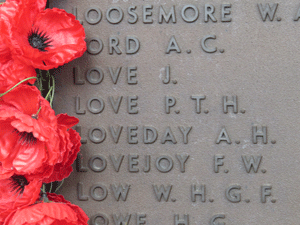 |
Australian War Memorial Roll of Honour October 2018 (J Hawker) |
Roland George Markham
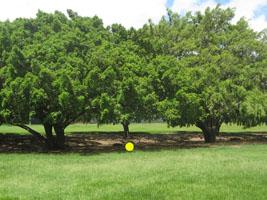 |
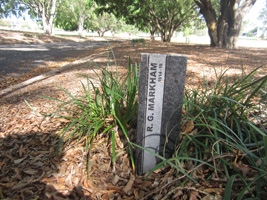 |
Tree 84 was a flame tree that died many years ago and it commemorated Roland Markham's service. I've put a yellow dot to show where the tree was (right between the weeping figs of Robert Hepworth (#82, on left) and Harold Mitchell (#86, on right). |
Memorial plaque installed by the Brisbane City Council in 2012. This is a beautiful shady area of Yeronga Memorial Park. However, the original flame tree (#84) from 1919 has died, probably from too mcuh shade. |
Roland George Markham was born in 1888 in Tiaro, Queensland, near Maryborough (about 230 km north of Brisbane) to parents George and Lydia Markham. His mother Lydia had previously been married to Irish-born Clement Lawless Pyne, a Queensland magistrate whom she met and married in Tiaro in 1869. Lydia too was from Ireland, coming to Queensland from Cork, and settling in Maryborough. They had a child John Paul Lawless Pyne, born there in 1877. Clement died in 1881. Lydia then met and married George Markham in 1884.
George Markham was a veteran cattle-man of Queensland. He was born at Pau, in the Pyrenees, in 1854 and came to Queensland in 1873 at the age of 19. He spent a few years gaining experience on Queensland cattle stations before accepting an offer to manage a property in New Caledonia. He spent several years on the island, and during his stay a revolt by the natives occurred, in which 300 Europeans lost their lives. Upon returning to Queensland, George Markham married Lydia and they had three children: Geoffrey (b 1886), Roland (b 1888) and Winifred (b 1892) - all of whom were born in Tiaro.
George Markham became inspector of stock and brands in 1892. Later he held this position in Rockhampton and district. Upon resigning from the Government service, Mr Markham entered the service of the Queensland Meat Export Co. as a cattle buyer and drover. He lived in Tiaro and was well known throughout the Burnett and Maryborough districts. He retired and the family moved to a home Karimba in Emperor Street, Annerley.
His son, Roland 'Rolly' George Markham, had become a stockman and drover and at the age of 29 decided to enlist in the army. In October 1916, Rolly joined in Brisbane and began training. He was placed with the 9th Battalion, 23rd Reinforcements and embarked for England aboard HMAT Kyarra A55 in November that year. In England he undertook more training and the following May (1917) proceeded to France where he joined his battalion at Bapaume, not long after the Germans had made a strategic withdrawal.
Roland fell sick in August 1917 and returned to hospital in England for treatment. Upon release he had a few days leave in London (where the photo below was taken) before returning to France to rejoin his battalion. Here he took place in an attack near Westhoek in mid-September 1917 and then was garrisoning the front line near Westhoek and Broodseinde Ridge in early November. He was to have another two weeks' leave in London in February 1918.
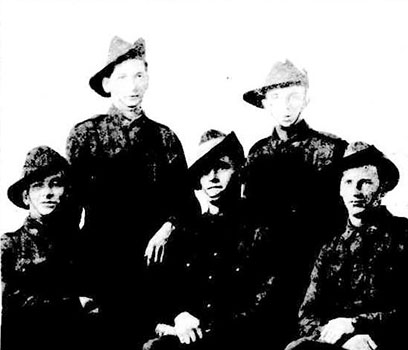 |
Roland Markham (front left) photographed in London in August 1917 after being released from hospital. He was snapped with four other Queensland mates while enjoying a week's leave. The Queenslander. |
After this the battalion moved back to Belgium for the advance to the Hindenburg Line, and in March and April 1918 helped stop the German spring offensive. On the 17th April they were in billets at Borre (about 10 km on the French side of the Belgian border), when the Germans attacked (see photo below):
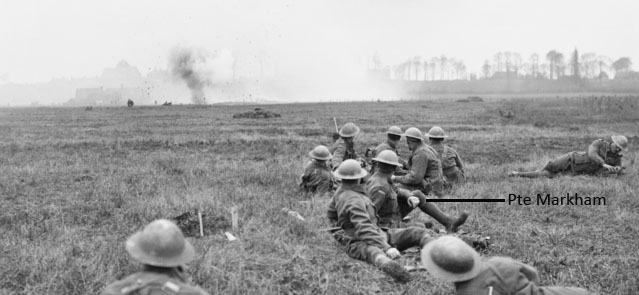 |
A photo of Pte Roland Markham (left arm resting on knee) at Borre, France, on 17 April 1918. After the shelling of No. 7 Platoon, B Company, 9th Battalion, in the reserve line at Borre, the men had to leave their billets and take up a position at a safe distance in the open fields. On the right, in front of the shell smoke, are some of the stakes of a newly erected wire entanglement). AWM E02088 |
Following this, Roland engaged the enemy in late April at Meterenbecque, followed by front line work at Klite Hill in June and July 1918.
Now down in Amiens, the battalion was about to participate in the great allied offensive of August 1918. On the 8th of August Rolly was at a little village of Le Hamel (about 10 km west of Amiens) followed by 'awful' billets at Bois de Accroche on the 9th. It was now time for their attack on the trenches about 7 km SE of Harbonnieres (see map).
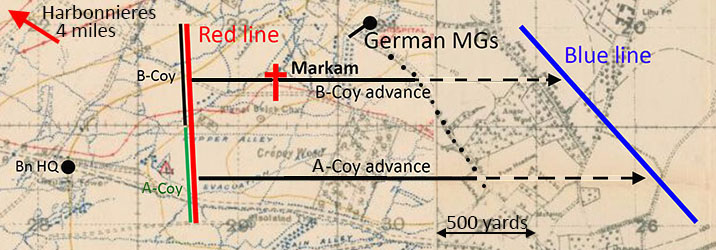 |
A section of the trench map used by the 9th Bn in the advance on German lines on 10th August 1918 [Map 62D SE and 62C SW, 1:20000, Edition 3A, June 1918]. The battalion had to pass the red line and capture the blue line. By 5pm on the 10th, the 9th Bn were holding the line on the road shown by the dotted line. I have marked on the map a red cross to show the approximate position of where Roland Markham was killed. |
The aim was to capture and control a line marked on the map as The Blue Line. At 6.30am on the morning of the 10th the Battalion moved off after a 15 minute artillery barrage designed to destroy German machine gun posts and artillery. The War Diary describes this barrage as 'wretched and scrimpy and without sting'. However, the battalion reached the Red Line without casualties. At 8am a general advance was ordered. Rolly's company, B-Coy, was at the left side of the red line, with A-Coy on the right. They were held up by terrific machine gun fire from the Germans from which there were heavy casualties. The main German MG position is shown on the map (at the top) at X24.a.3.0 and this was eventually silenced but not without further (severe) casualties. The battalion advance stalled, particularly as the artillery barrage was very heavy. Roland Markham was struck and killed somewhere between the Red Line and a point marked as X24.c.2.2 where B-Coy had established a strong point at noon.
This advance by British and empire troops near Amiens was the greatest success in a single day on the Western Front, one that German General Erich Ludendorff described as "the black day of the German Army in this war". Equally so for Roland's family.
Rolly was buried at Memorial British Cemetery about one mile SSE of Vauvillers on the Le Buisson road. A Memorial was erected to the members of the 9th Battalion who fell there on 10th August 1918. One of the names on the memorial is 7016 Pte Roland George Markham (see photo). All were later reburied at Heath Cemetery, a mile north of Harbonnieres.
 |
| The Memorial erected to the members of the 9th Battalion who fell on 10 August 1918 near Harbonnieres. You may be able to make out the name of Pte Roland George Markham sixth up from the bottom. See the original on the AWM website. AWM E03833 |
 |
The same area today: on Le Buisson road, a short distance east of the Rue de Lihons intersection. |
Rolly's mother Lydia died the following year (in 1919) followed by his father George in 1930, sister Winifred in 1942, and half-brother John Paul Lawless-Pyne in 1951.
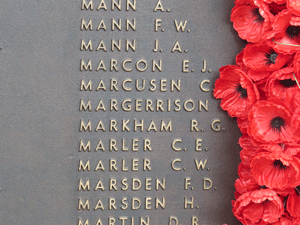 |
Australian War Memorial Roll of Honour October 2018 (J Hawker) |
James Leonard Matherson
 |
.jpg) |
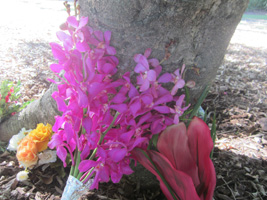 |
Matherson's Plaque. |
Matherson's tree (#58). A new weeping fig has replaced the original one from 1918. |
Flowers from some Year 5 students at Yeronga State School. |
James Leonard Matherson (No. 54 above) was not killed in the war but returned to Australia on 20th June 1918 and was discharged on 24th September 1918. He was born in Britain in November 1879, the son of John and Louisa Matherson. James was a butcher at St George, Western Queensland, who enlisted on 6 March 1917 in Brisbane. He was gassed on 13 April 1918 while in France and remained in hospital for two months.
Meanwhile, in Brisbane, the second planting of trees occurred on 20 July 1918 in Yeronga Park while Matherson was at sea. Letters to his mother advising of his wounding were sent to an old address (Annerley) although the army had been advised on 29 May 1918 of the new address (Newmarket). This confusion may have caused the belief that Matherson had died and he was recorded on the Stephens Shire RSL Honour Board as such. At the ceremony Councillor Stimson read out the names of those 31 soliders who had recently died and he included Private Matherson. Matherson was a widower (his wife May, née Brown, having died in 1915) and a tree was planted in Honour Avenue on 20 July 1918 by his young son - 7 year old John Leonard Henry Matherson. Young John had already lost his mother and now apparently had lost his father too. Pte. Matherson arrived in Australia a month later and was discharged on 24th September 1918 with trachoma - an eye disease - as a result of the gas shell poisioning. He became an engine driver and lived at Boxgrove Avenue Wynnum (Brisbane). He died in Queensland on 22 May 1933. A big mix-up it would seem.
Arthur Reginald Maxwell
 |
.jpg) |
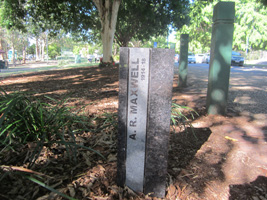 |
Tree 26 - A new weeping fig has been planted (some time ago) to replace the original Fig from 1918. |
Arthur Reginald 'Reggie' Maxwell was born in Maryborough, Queensland, in August 1895 to Arthur Frederick Marshall Maxwell and Isabel Maxwell (nee Bain) who were both born there as well and in the same year (1871). His parents married in 1891 and had children who grew up there: Frances, Charles, Albert (Reg), Victor and Ida. They attended Albert State School.
Mr Maxwell spent five years with the local militia - the 4th (Wide Bay) Infantry, commonly known as the Wide Bay Regiment (C-Coy). In 1910 or so the family shifted to Brisbane and took up residence in Clara Street, Annerley, just opposite Yeronga Park. Reg had done some work on a sheep station but found work as an iron bedstead maker at Mr May's Bedstead Works at Albion.
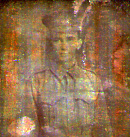
Reggie Maxwell.
(Sue Hamilton-Smith)
In July 1915 father and son decided to join the army: Arthur, now 44, enlisted on the 6th and Reg (age 21) on the 9th. Arthur was placed with 15th Battalion 9th Reinforcements, and Reg with the 9th Bn, 11th Reinforcements. Reg was the first to leave for overseas: he was off aboard HMAT Warilda in October and arrived in Suez in November. Arthur meanwhile was transferred to 30th Bn and departed aboard the HMAT Beltana in November, arriving in Suez mid-December and promoted to Lance Corporal.
Reg began his training in Egypt and in March was transferred to the same battalion (30th) as his father and they were both sent to Ferry Post at Ismalia (Suez Canal) to help man the front line canal defences. Arthur began to experience weakness and loss of muscle movement in his arms (paresis) and was transferred to the 15th Field Ambulance at Ferry Post before being sent off to the hospital in Heliopolis where spinal nerve damage was confirmed as the cause of brachial plexus (loss of function and sensation in his hands and arms). Arthur was sent home to Australia in June 1916 and discharged from the army.
That same month as his father was sent home, Reg left Ferry Post for Alexandria thence to France aboard HT Honorata arriving on the 23rd. He and the 30th Batallion were sent north to Hazebrouck and by 11th July (1916) were in the front line at Bois Grenier being bombed heavily by the Germans. The 30th Batallion marched north to Fleurbaix and received orders to attack enemy trenches 2000 yards to the NW (as part of an action by the 5th Division and 61st Division Anzac troops). The objective was to prevent Germans withdrawing troops from the front.
The plan was that in the evening of the 19th the troops were to advance in four waves: 31st Bn on the right, the 32nd on the left, 30th Bn as directed and the 29th in reserve. A-Coy of 30th Batallion had a special job. They had to wait until the German front line trenches were taken and then dig a trench across No Man's Land joining the Anzac and German front lines. At 6pm, the attack began, preceded by heavy artillery bombardment.
All four waves entered the first German trench by 6.15pm, and by 6.30pm the 1st and 2nd waves were in the German 3rd trench. A-Coy (including Reg Maxwell) began digging the trench across No Man's Land while under sustained artillery bombardment and machine gun fire.
At 3.15am on the 20th (July) the Germans launched a counter-attack. The Australians were unable to hold the German trenches and had to withdraw to their original line. The 30th Battalion returned mixed up with the 31st. The German artillery fire was very heavy and there was a large number of casualties. Reg was one of these. It seems he was killed by a shell in No Man's Land on the morning of 20th July. His Platoon Sergeant Doug Vincent found him dead with shell wounds. By 10am the counter attack was over and the 30th Bn was relieved by the 29th who were in reserve. When roll call was done that morning Reg was one of the 68 ORs missing. As well there were four officers and 51 ORs killed and six officers and 224 ORs wounded. The OC of A-Coy 2/Lt John Lees was killed and A-Coys Lt Orpen and Capt Allen wounded. The ground was so churned up by the bombing that many bodies were not recovered and had to be recorded as 'missing in action'. His body has never been found.
 |
The family was notified that Reg was missing in action. That same month (July 1916) Reg's mother Isabel lost her father (William Bain) in an accident at Torbanlea. It wasn't until the following year that a Court of Enquiry listed Reg as having been killed in action on the 20th.
Later that year (1917) his family inserted a notice in the Brisbane Courier (15 September 1917). It read "Gave his life for King and Country".
His father died in 1946, and his mother in 1957.
Pte Reg Maxwell remains one of the 'unrecovered' Australian soldiers of WW1. A descendant was DNA-tested in 2011, but no match was made. Reg's great niece Susan Hamilton-Smith provided the photo but made the comment that "Unfortunately the one photo that the family has (see above left - near the start) was also pronounced unrecoverable by the curators at the Australian War Memorial. It is silvered and quite orange, unfortunately really, because I have many clear photos and postcards of his parents, uncle, brothers and sisters, and quite a few were involved in WW1".
As a part of their history subject, North Mackay State High School students take on the research of a war veteran, and deliver a eulogy at their grave or memorial. In 2012 Year 11 student, Sarah Belton, visited Fromelles Cemetery to deliver a eulogy for Reggie Maxwell. A photo of his memorial plaque and of Sarah at Fromelles is shown below.
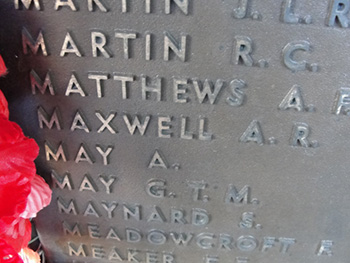 |
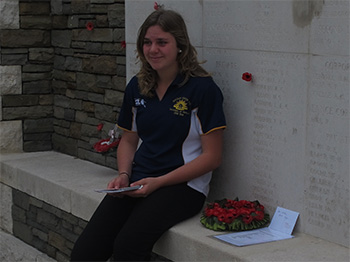 |
Memorial Plaque at Australian War Memorial, Canberra. (Susan Hamilton-Smith) |
Sarah Belton at the Fromelles Memorial 2012 |
 |
North Mackay State High School students at Fromelles in 2012. Sarah is front row second from right. |
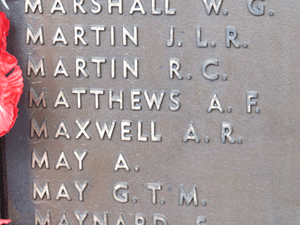 |
Australian War Memorial Roll of Honour October 2018 (J Hawker) |
Joseph McCabe
It is quite uncommon for three brothers from the one family to be killed in the war, any war, but we have two such cases here in Honour Avenue. One is of the Ormiston brothers - David, Andrew and John - whose tribute appears elsewhere on this page. The other is of the three McCabe brothers - Joseph, William and Frank. It is only William who is commemorated at Yeronga as the others didn't live in the Stephens Shire. But the brothers' stories intertwine and are presented here in their honour.
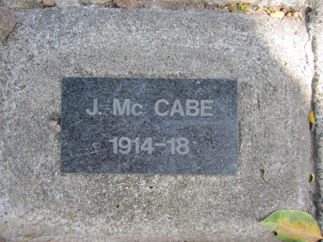 |
 |
Joseph McCabe was in the 26th Bn Infantry. |
He died in France on 6 June 1916 at the age of 37. |
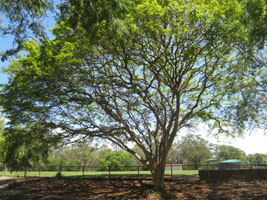 |
 |
 |
Tree 27 - A flame tree was originally planted here on Saturday 15 September 1917 but it died and was replaced with a Leopard Tree. |
Beautiful Leopard Tree bark on McCabe's tree. |
More Leopard Tree bark on McCabe's tree |
Joseph Michael McCabe was born in Bolton, Lancashire, England in 1878 to parents William Francis McCabe and Elizabeth McCabe (nee Kenny). His parents had come from Ireland to settle in Lancashire and brought William's widowed father Michael and sister Mary with them. There were eventually five children: Joseph, Hannah, and William were born in Lancashire but the family emigrated to Australia before the other three were born. Joseph was the first born and was only 24 hours old when the 1881 English Census was taken on April 3. Next was Hannah in 1884 and lastly William in 1885. William - the father - was a painter and decorator by trade and was to pass this on to the boys.
In December 1985 the family departed England aboard the SS Duke of Westminster arriving in Brisbane in mid-January 1886. They took up residence in what was once River View Tce in Annerley and the children were soon attending Junction Park State School. In 1888 a son James was born, followed by Bernard in 1891 and Francis in 1893. Now there were six children.
The boys did take up the same trade as their father: as painters and decorators. In December 1914 Bernard enlisted (Reg. No. 184) and was placed with the 5th Army Supply Coy (attached to the 1st Light Horse Brigade) followed by Francis on 9th January 1915 (15th Battalion, Reg. No. 1974).
Joseph married his fiancee a few days later. On the 13th January 1915 Joseph's marriage to Catherine Mary Ellenor Keating was registered in Brisbane. The date of the wedding is unknown. Three days later their first baby was born - a girl May Catherine.
The two enlisted brothers left for overseas in April that year. The following month (May) Joseph enlisted. He was placed with the 26th Battalion, 2nd Reinforcements (Reg. No. 1692) and began training in Brisbane.
Of the two brothers who had already embarked, Francis landed in the Middle East and was soon off to Gallipoli. He arrived in July and was killed on 8th August (1915) but listed as missing in action as no body was found. The family lived in hope that MIA meant he was still alive (and it took a year to confirm that he was indeed KIA - killed in action on the 8th April).
The other brother overseas - Bernard - by this time had arrive safely in Egypt. That month, back in Brisbane, Joseph had finished his training and was off overseas. He departed aboard HMAT Shropshire A9 on the 17th (August 1915) farewelled by his family including brother William who decided it was his time to enlist. He did so in early September (1915). By this time Bernard had arrived in Gallipoli with the 1st Light Horse.
Heartbreak ensued for the family in 1916 with the matriarch Mrs Elizabeth McCabe dying at her home in Cleveland on the 11th April. She was buried the next day at the Dutton Park Cemetery. She had escaped the torment of knowing a son had died in the war.
Joseph spent some time training with the 26th Battalion in Egypt before landing at Gallipoli on 12 September 1915. At Gallipoli, the 26th played a purely defensive role and at various times was responsible for the defence of certain Anzac posts. Joseph (and the 26th Bn) withdrew from the peninsula on 12 December. After another stint in Egypt, the 7th Brigade (including Joseph's 26Bn) proceeded to France as part of the 2nd Australian Division in March 1916. In concert with the 28th Battalion, on 6th June 1916 the 26th mounted the first trench raid undertaken by Australian troops on the Western Front.
August 1916 saw Joseph's 26th Battalion as part of the 7th Brigade's attack on the German lines to the north of Pozieres. At the start of the month the battalion was repairing communications trenches around Pozieres Village. On the 4th the men were in bivouac at Tara Hill a little to the south and began their march through Pozieres to the jumping off point. They had to endure a heavy barrage on the town by German artillery and casualties were considerable. The war diarist had written 'heavy casualties' but crossed it out after what came later. Return fire from the Australian artillery began at 5pm and lasted an hour. At 9.15pm the men were at the jumping off point and made their advance.
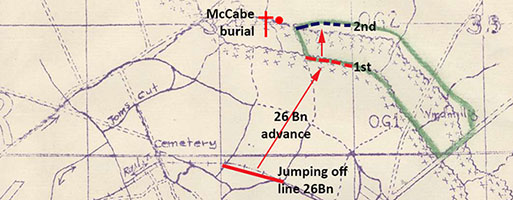 |
Map taken from the 7th Brigade War Diary. It is a hand-drawn version of the 62D SE 1:10000 trench map to which I have added details from the war diary. The battalion moved from Tara Hill, north to the Jumping Off lines (that I have drawn in red). At 9.45pm on the 5th August they advanced and took their 1st Objective (the lower green line), and then the 2nd objective (the upper green line). I have put dotted lines for the 26Bn's part of the objective. Pte Joseph McCabe was killed at the green line and buried a few hundred yards away to the left (where I have drawn red dot and a cross). |
The advance was successful and all battalions took their 1st and 2nd objectives (the German trenches; see map). On the morning of the 5th, at 4 am a strong counter attack by the enemy ensued and six men of the battalion were killed. One was Joseph McCabe who died where he fell. It was difficult enough to get the wounded out and the stretcher bearers were unable to keep up. The dead just had to lie there until the wounded were taken. The OC 26Bn Lt Col George Ferguson said "Our men rose to the occasion splendidly". Congratulations were also delivered by the Divisional Commander.
Joseph McCabe was taken away the next day and buried only a few hundred yards from where he fell (see map above).
Brother William was also at Pozieres, fighting alongside Joseph's battalion. The 47th Battalion suffered more casualties than did Joseph's 46th. William suffered 'shell shock' (in combination of the fighting and hearing of the death of his brother a few yards away) and was sent to hospital for six weeks. Upon his return in October he rejoined his unit.
A full year later William was in Belgium during an advance on Passchendaele. William was seconded as a stretcher bearer to HQ and was attending a wounded man who had been left in the field overnight. Out of the blue William was hit by a shell in his hip and side. He was carried back to the dressing station behind the lines. However, in the intensity of the battle the bearers lost course and as William had died they left him there for later. This was the 12 October 1917. He was declared 'missing in action'.
It was now time for the fifth and last brother to enlist. James enlisted that month (24 October 1917) and embarked for England in December as a member of the 4th Pioneers Battalion (4882). He trained in England and went to France in August 1918. The Germans were in some disarray by now. As far as William went, his body never found. He was declared KIA a year later by a Court of Enquiry.
Bernard spent most of the war with either the Egyptian Expeditionary Force, taking part in the Sinai and Palestine Campaign, or in England as a Driver for the Army Service Corps. He made it to France as a Driver for the last few months of the war. He returned to Australia in March 1919, and brother James came back in July. Now three sons and a wife dead, a devastated Mr William McCabe died on 21 January 1920.
Joseph's body remained buried in the makeshift grave at the front line until after the war. In 1928 the Commonwealth Graves Commission decided to consolidate all of these small outlying graves that were unsuitable for permanent retention. Joseph's remains - by now an unknown soldier as the cross had long since been blown away - were dug up and identified by the identity disk around his neck. The disk was sent to his wife Catherine in Brisbane in 1929 although it was almost unreadable. Only letters J, M and E were legible. His remains were reinterred with appropriate solemnity at the Serre Road Cemetery No. 2.
 |
Australian War Memorial Roll of Honour October 2018 (J Hawker) |
Allen George Marcus McWade
 |
 |
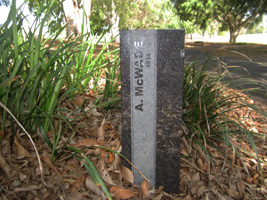 |
Allen McWade died in France on 11 August 1918 at the young age of 19. He was serving with 15th Bn Infantry. |
Allen McWade - 1915 |
Tree 87 - A flame tree was planted here in 1919 but died and was never replaced. |
Allen George Wade was born on 3 April 1899 at Toowong, Brisbane, to parents George and Maria (Mary) McWade. He had an older sister Dorothea (b1896) and subsequently had two more sisters Olive (b1901) and Linda (1910). He attended Dutton Park State School where he achieved highly and became proficient at the mandolin. This was followed by several years at Brisbane Grammar School during which time he was in the Brisbane Naval Cadets (4 years) under the command of Chief Gunner John Rogers, assistant to the Brisbane Sub-district Naval Officer. The Naval Cadets at this time had their annual camp at Cleveland and would often be presented to the Governor of Queensland during his inspections. On completion of his schooling Allen became an ironmonger.
Just after he turned 18 he enlisted in the army at Enoggera Barracks (6 August 1917). All of his male cousins (8 of them) had enlisted as soon as they were old enough too.
The 9th Battalion (26th Reinforcements) left by train for Sydney on 29 October 1917 and departed for England two days later aboard the HMAT Europides. At Sutton Veny in Wiltshire they trained for 4 months until being sent to France. Here Allen was posted with the 15th Battalion C-Coy up near Amiens. On 1 August 1918 he found himself in the trenches east of the village of Cachy. Enemy artillery was very active and was fearsome when combined with the machine guns and trench mortars. On the 6th August it was very heavy and many casualties were suffered.
The Great Allied Offensive was underway. On the 8th August all four Companies of 15th Bn marched out of camp at 1.30am. By 3am they were ready to advance towards enemy lines. Zero hour was 4.20am but the mist was so bad they couldn't see more than 10 yards ahead. Nevertheless, they pushed on and crossed their green line at 8.20am. While continuing the push towards the enemy front line they suffered many casualties but captured the line at 2.45pm. Casualties included one officer dead, 27 other ranks dead, 6 gassed, 27 other ranks wounded - but this included Allen McWade with gunshot wounds to the neck and arm. This battle became famous for achieving the greatest one-day success by British and Empire troops on the Western Front.
Allen was admitted to the 8th Stationary Hospital at Wimereaux, France, but died there on the 11th (August 1918). He was buried at the Terlinethun British Cemetery at Wimille, about one mile north of Boulogne. A casualty list was published in the papers on 2 September 1918. His mother wrote in a note to the army that her only son had lived for 19 years, 4 months and 8 days. Her husband signed it.
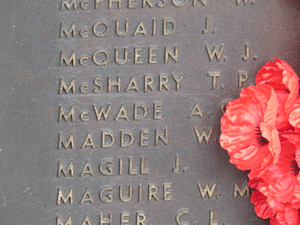 |
Australian War Memorial Roll of Honour October 2018 (J Hawker) |
John Alexander Meiling - d 11 October 1917
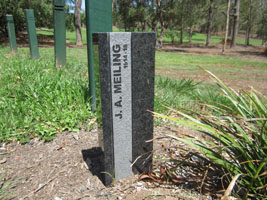 |
.jpg) |
.jpg) |
John Meiling's plaque and tree were where the new roundabout it. The flame tree died so there was room for a roundabout. The plaque is not in line with the others. |
John Meiling's tree (#59) - was a flame tree planted here on Friday 26 July 1918. The plaque is beside the yellow dot. |
Just past Meiling's tree is the eucalypt forest behind the school. It is made up of a magnificent stand of Tallowood (Eucalyptus microcorys). This photo shows one of the trees that blew down in the storm of November 2014. It measured 50cm across. |
John Alexander Meiling was born in Longreach, Queensland, in March 1897. His father, James Meiling, was born in Denmark, and his mother Margaret Meiling (nee Sanderson) was born in England. They married in Queensland in 1891 and had Rasmus Frederick, Elizabeth, John Alexander, and Margaret Catherine ('Maggie').
The children grew up in Maryborough and attended Albert State School in the town. No doubt he would have been friends with Arthur Reginald 'Reg' Maxwell and his brothers and sister who attended the same school at the same time. Reg Maxwell died in WWI and is also honoured in Yeronga Park.
It seems that Mrs Meiling died in 1906.
John's older brother (by 5 years) Rasmus enlisted in the army in March 1915. He was almost 23 and John, at this time, was 18. Rasmus (R.2168) left for overseas in June and ended up at Gallipoli, receiving a bullet in his back on 9th August 1915. Rasmus had damage to his 7th and 8th brachial nerves and lost the function of his right hand. He was sent back to Australia in October 1915 to rest.
On 10th January 1916, John attended the Drill Hall in Maryborough to enlist in the army. This was the same hall he used for his four years of army cadets. Of the nine men who presented themselves, only four were selected. John was one and was required to go to Enoggera Barracks in Brisbane to complete his enlistment - which he did on 20 January 1916. He was just 18 years and 9 months old.
After training in Brisbane for several months he was placed with the 42nd Battalion and proceeded overseas aboard HMAT Borda A30 on 5th June 1916, out of Sydney. In Brisbane, in August, Rasmus re-enlisted (R.10743) but after more medical tests the army decided he was medically unfit and he was discharged in October 1916.
After more training in England John departed in November 1916 with the 42nd for their first taste of France. They made their way from Le Havre up into Belgium to begin training at Outtersten, entering the frontline for the first time on 23rd December. The winter of 1916-17 was horrendous, and the 42nd spent much of it in the front line, the remainder being spent in Amentieres alternating between training and labouring in the rear areas.
In March 1917 the battalion headed for the Ypres sector of Belgium where they relieved the 44th Bn at Plogesteert. The 42nd participated in major battles at Messines on 7th June 1917, Warneton on 31st July, Broodseinde on 4th October. On the 7th they were resting. It was cold, with heavy rain. The ground was cut up from the shells. They had to prepare for another move to the Ypres front. On the 9th they moved from their camp at Brandhoek via Ypres to camp in tents on the western slope of Frezenberg Ridge. The weather was extremely bad.
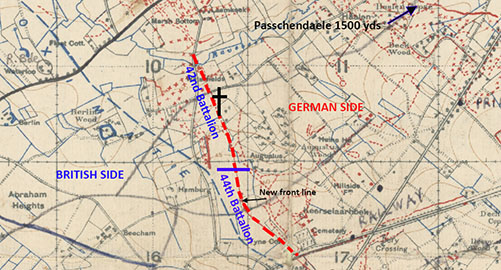 |
Trench map for Passchendaele - Map 28NE. The 42nd Bn occupied the trenches from the Ravenbeke River (at D10.d.5.2; see the blue line towards the top) down to Augustus Wood (thick blue line in the middle of the map). John Meiling died roughly where I have drawn the black cross. |
On the night of 10th/11th October the battalion was ordered to take over the front line occupied by the British 199th Bde (66th Division). The 42nd Battalion (including John) were to relieve the 2/6th Manchesters in their section of the line. The new line is shown on the map above. It goes through Augustus Wood to Roulers Railway. The Manchesters had been in the thick of the battle and suffered severely. The 42nd occupied this new front from Ravenbeke River to Augustus Wood at daylight. Every trench was filled with water and the line had to be abandoned for a fresh position. The enemy spotted the movement from their planes and put down a barrage of artillery fire which inflicted a good number of casualties. One casualty was John Meiling. He died on the battlefield where he lay.
Even though the battalion was in a reserve role, the battle of Passchendaele proved particularly costly. It lost over a third of its strength, principally from German gas attacks, and trench foot caused by the sodden condition of the battlefield.
John was buried at White House Cemetery, Ypres.
The Committee of the Albert State School heard of John's death and decided to erect a memorial to all of the past-students who had lost their lives in the war. The memorial, (including John Meiling's name), was unveiled in the school grounds on Friday 14th December 1917 (See Shirley and Trevor McIvor's photos below). The notice of John's death appeared in Lists 367-368 and published in the following day's paper.
 |
 |
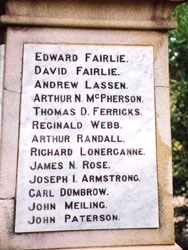 |
Maryborough Albert State School War Memorial. Source: Shirley and Trevor McIvor
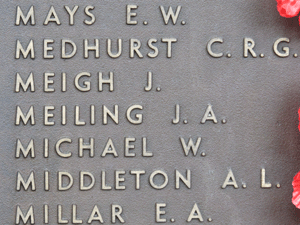 |
Australian War Memorial Roll of Honour October 2018 (J Hawker) |
Pte Harold Mitchell
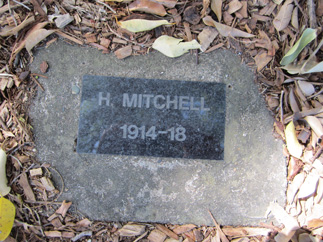 |
.jpg) |
 |
This is the spelling of Harold Mitchell's name that he used. It is spelt 'Michel' on the Cenotaph and the recent BCC plaque shown opposite. |
Tree 86 - a big old weeping fig planted in July 1918 still stands beside Mitchell's plaque. |
Mitchell's plaque. This is spelling from his birth registration but was not the name he was known by or the one the army used. |
Harold Mitchell was born as Arthur Harold Michel in Brisbane in 1892 to Heinrich Michel and Sarah Louisa Michel (nee Dyer). His parents had married in 1888 and settled into a home at 88 Prince Street, Thompson's Estate (now Annerley). He had two older brothers - Charles William Henry and Ernest Alfred - and six younger siblings: Cyril Walter, Florence Kazia, Redvers Buller, Ellen Jane, Vera Desiree and Edith Reta. They all chose to be known by the surname Mitchell, and Arthur Harold Michel became simply Harold Mitchell. Their father chose to be known as Henry Mitchell. He too was born in Brisbane and was 26 when Harold was born. Thir mother, Sarah, was born in England in 1871 and arrived as a 12-year-old girl aboard the Scottish Hero in February 1883 with her parents and seven siblings. She was 21 when Harold was born.
Harold attended Junction Park State School as did his brothers and sisters. He was employed as a storeman when he enlisted on 7 April 1917.
Harold ("Harry") departed Brisbane aboard HMAT Marathon on 27 October 1916 and arrived in England 11 weeks later. He was sent to training at Codford in Wiltshire and then travelled overseas to France departing 28 March 1917. He joined A-Company of the 47th Battalion in the field a week later. They were at Biefvillers, on the outskirts of the northern French town of Bapaume, about 50 km NE of Amiens. For April and May 1917 the Battalion, like most of the 3rd Division troops, was preparing for a major offensive in June at Messines Ridge in Belgium (although the men didn't know this at the time). Major Hubert Ford, the Battalion's diarist wrote on the 6th June:
| "Never before in the history of the Bn was so much preliminary work bestowed on a Bn and never was it more fitted for adventure such as this". |
Back in Brisbane, Harry's mother Sarah was getting letters addressed to Mrs H. Mitchell (her name, husband was Heinrich) about a soldier Pte James Mitchell (2934, 52Bn) who travelled aboard HMAT Marathon with Harry. But the letters were for Mrs Hilda Mitchell (James's wife) so Sarah returned them to the army. Nevertheless, she was upset every time an army letter arrived. As a side-note: James Mitchell had seven children and had applied for discharge. They granted this but it was too late; he had sailed to England with Harold on the Marathon and died of disease soon after he got there (12 February 1917).
Zero hour at Messines was 2am on the 7th June 1917. The objective for the 47th Battalion was to take Owl Trench and a particular section of the German "Huns' Walk" trench to the east of Messines marked on the maps as the "Green Line". At 7am that morning the men moved out of Bulford Camp into assembly formation to No-Man's-Land. At 11am, A-Coy, under Acting Captain Lt Dudley Frederick Salmon, the men steadied themselves for the assault at 11.30am. The time arrived and a creeping barrage of artillery shells began about 150 yards on their side of the objective. This curtain of falling shells moved forward at 30 yards a minute until it reached the green line. There it continued for 15 minutes and then was raised (started rolling past the line) and continued moving forward. This was the cue to begin the assault.
 |
The Trench Map taken from the 47Bn War Diary for June 1917. I've added a red arrow to show Harry's advance from Owl Trench to "Owl Support" on The Green Line (that cuts Huns' Walk). Harry died at some spot along this arrow. You should be able to make out the name "Owl Trench". The map co-ordinate is U4.a.55.90. |
C-Coy rushed forward to take Owl Trench (protected by the rolling barrage) while Harry's A-Coy waited 100 yards to their rear. When C-Coy took Owl Trench they signalled for A-Coy to come forward. Lt Salmon and his A-Coy platoons, including Harry Mitchell's, advanced through them and stormed the Green Line trenches. They took these trenches but at considerable cost: 68 ORs and two officers from the 47th Battalion died in the assault. One was Pte Harold Mitchell. He died at about 1 pm on 7th June 1917 and was buried in a shell hole near where he lay. In the fog of war no-one took note of who he was or where he was buried. When he didn't turn up for roll call he was listed as "Missing in Action".
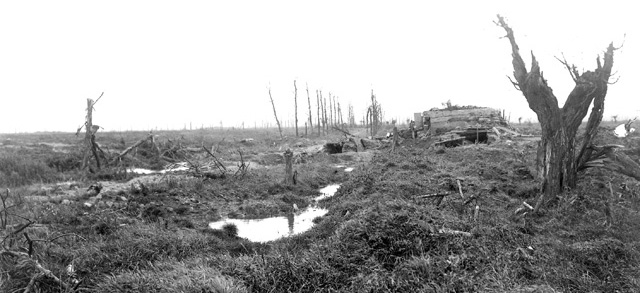 |
Owl Trench after the Battle of Messines in June 1917. Harry Mitchell, and Lt Dudley Salmon, and hundreds of other Anzacs were buried here in makeshift graves on the three days of the battle (7-9 June 1917). Many of the bodies were badly dismembered and graves were not marked because German counter-attacks made the area impossibly dangerous. Bodies were recovered later in, or after, the war. Note the German blockhouse ('pillbox') to the right. These were impregnable unless suffering a direct hit from a big shell. AWM 01295. |
Lt Salmon was wounded in the assault but was able to carry on. The next day, in the very trench that they had captured, a 5.9" German shell struck and killed Salmon and five others. He like, Harry Mitchell, was buried in a shell hole, marked with a rough wooden cross, and his body not recovered until much later. Lt Salmon was from Coorparoo, South Brisbane, not far from Harry's home. Dudley Salmon's last words were written down:"Oh, my mother".
A Court of Enquiry convened in the field on 24 November 1917 found that Harry was indeed killed in action on 7th June 1917 - and now no longer "Missing".
Harry was a nephew of Sgt Robert Oxford of the 3rd Bn Camel Corps. Sgt Oxford (2223A) was killed in Palestine on 6 November 1917 and is memorialised at the Cenotaph and at Tree 65.
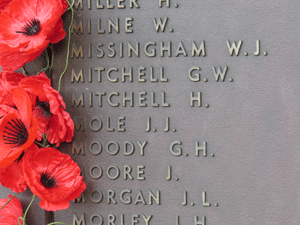 |
Australian War Memorial Roll of Honour October 2018 (J Hawker) |
Walter Morgan
 |
.jpg) |
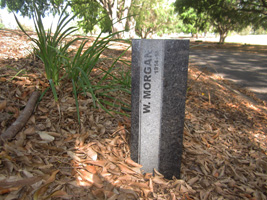 |
Walter Morgan was in the 9th Battalion Infantry and died in France on 10 August 1918. |
Tree 85 - a big old weeping fig was planted on Saturday 23 August 1919 to honour Walter Morgan's sacrifice. This magnificent tree still stands after providing shade for almost a century. |
Walter Morgan was born in the town of Kidderminster, Worcestershire, England (about 25km SW of Birmingham) in 1888 to Frederick and Jane Morgan. He had an older brother Frederick (b 1885), and a younger sister Alice (b 1889).
When he finished school Walter became an errand boy in his home town and then spent nine years with the 9th Worcestershire and County (Infantry) Regiment. Sometime after the turn of the century Walter emigrated to Australia with his sister Alice. They settled in Brisbane where Walter became a clerk and moved in to a home in Ferndale Street Annerley, only a short distance from Yeronga Park. It is not certain but it seems Alice may have married an Arthur Price in Kidderminster before coming to Brisbane. His other brother Frederick George stayed in Worcestershire.
 Walter joined the army in December 1914 and was placed with the 9th Battalion 2nd Reinforcements before being promoted to Sergeant as an acknowledgement of his military training with the Worcesters. He departed aboard the HMAT A48 Seang Bee on 13 February 1915 for the war in Europe. Like most of the early recruits, Walter thought he was going to England then France to fight the Germans but ended up in Egypt bound for Gallipoli. He was placed with C-Coy of his Battalion on 7th May at Anzac in Gallipoli and stayed with them for the entire time, finally departing in December 1915 and arriving back in Egypt (Alexandria) on 4th January 1916.
Walter joined the army in December 1914 and was placed with the 9th Battalion 2nd Reinforcements before being promoted to Sergeant as an acknowledgement of his military training with the Worcesters. He departed aboard the HMAT A48 Seang Bee on 13 February 1915 for the war in Europe. Like most of the early recruits, Walter thought he was going to England then France to fight the Germans but ended up in Egypt bound for Gallipoli. He was placed with C-Coy of his Battalion on 7th May at Anzac in Gallipoli and stayed with them for the entire time, finally departing in December 1915 and arriving back in Egypt (Alexandria) on 4th January 1916.
After some more rest and training in Egypt, the Battalion departed Alexandria for France, arriving at Marseilles on 3rd of April 1916. He boarded a train for 'destination unknown'. As they passed through the towns on their way north to a secret destination they were greeted at each station with flags, banners and much cheering. Finally, they arrived at St Omer at the northernmost part of France, right on the Belgian border (a trip of some 1000 km). They billeted there and then moved to Strazelle where training began. In the wet conditions their Australian boots fell apart.
On the 19th April 1916 they marched to Rouge de Bois just a mile from the front line. Walter's C-Coy became the Brigade Reserve company and they were billeted in the town, relieving the 17th Lancashire Fusiliers who had left the billets in a disgusting state. It is unknow what Walter thought of the British soldiers from his neighbouring county in England.
On the 20th April at 1.15pm the billets occupied by C-Coy were subjected to heavy bombing by the enemy. Some 50-60 high explosive (HE) shells landed on these billets. One bomb in particular struck a brick wall and killed Lt Fothergill and 24 others. Walter and four others showed great courage to help save the men. They were recommended for Meritorious Conduct awards, which were forthcoming as a "Complimentary". The next day Walter (by now know to all as "Chum") was promoted to Company Sergeant Major (CSM) Warrant Officer Class 2.
Walter was with the 9th Battalion for the rest of 1916. In December 1916 the 9th Battalion's Regimental Sergeant Major (RSM) Seymour Corfield (a sheep farmer from Winton, Queensland, and ex Manchester Regiment, ex Madras Infantry) was killed in action in on the front line at Flers. Walter succeeded him as RSM in February 1917. The following month he was promoted to 2nd Lieutenant.
The battalion continued their training and fighting in France throughout 1917, and in September Walter was granted a week's leave in London. The army by now decided more could be expected of Walter so upon his return to his unit, he was sent to Brigade training school in France and five weeks later rejoined his battalion in Belgium. He was showing great talent and was next off to Corps School (also in France at year's end where he was promoted to Lieutenant (on 1 December). Walter rejoined his battalion on 21 December 1917 and almost straight away was detatched for duty back in England with the 1st Battalion Training Brigade. He was made the Adjutant and carried out his duties well for six months before rejoining his unit on 4th August 1918.
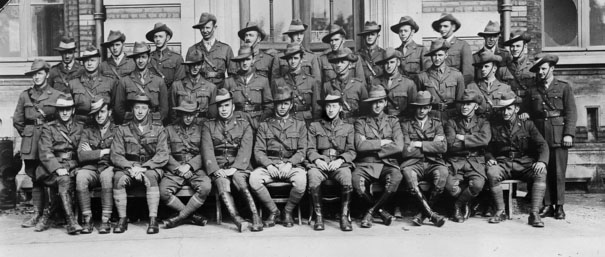 |
Outdoor group portrait of Australian officers in front of the Hospice at Rivery, near Amiens, France - August 1918. Lt Walter Morgan is in the front row, fifth from the left. AWM C04428 |
Now down in Amiens, the battalion was about to participate in the great allied offensive of August 1918. On the 8th of August "Chum" Morgan was at a little village of Le Hamel (about 10 km west of Amiens) followed by 'awful' billets at Bois de Accroche on the 9th. It was now time for their attack on the trenches about 7 km SE of Harbonnieres (see map).
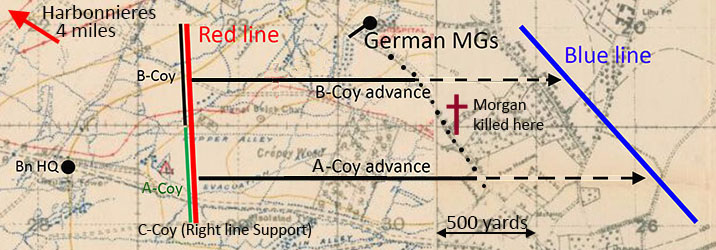 |
A section of the trench map used by the 9th Bn in the advance on German lines on 10th August 1918 [Map 62D SE and 62C SW, 1:20000, Edition 3A, June 1918]. The battalion had to pass the red line and capture the blue line. By 5pm on the 10th, the 9th Bn were holding the line on the road shown by the dotted line but heavy shelling later that night saw many men killed. I have marked on the map a red cross to show the approximate position of where Walter "Chum" Morgan was killed. |
The aim was to capture and control a line marked on the map as The Blue Line. At 6.30am on the morning of the 10th the Battalion moved off after a 15 minute artillery barrage designed to destroy German machine gun posts and artillery. The War Diary describes this barrage as 'wretched and scrimpy and without sting'. However, the battalion reached the Red Line without casualties. At 8am a general advance was ordered. Rolly's company, B-Coy, was at the left side of the red line, with A-Coy on the right. They were held up by terrific machine gun fire from the Germans from which there were heavy casualties. The main German MG position is shown on the map (at the top) at X24.a.3.0 and this was eventually silenced but not without further (severe) casualties. The battalion advance stalled, particularly as the artillery barrage was very heavy.
Remnants of the four 9th Bn companies by this stage were scattered between the two lines with C-Coy to the north. At 5.30pm an extremely heavy enemy barrage opened up for 30 minutes. Shells of all calibres rained down on the troops in the outposts. It was here that Walter Morgan was killed. Beside him was Lt William Forster Smith from Charters Towers. It was the evening of the 10th August 1918. They were found around 3am the next morning.
This advance by British and empire troops near Amiens was the greatest success in a single day on the Western Front, one that German General Erich Ludendorff described as "the black day of the German Army in this war".
Walter was buried the following day at Memorial British Cemetery not far from where he was killed.
Walter's parents were also dead by this stage and his Next of Kin was his older brother Frederick who was living in Kidderminster. The notice of Walter's death went straight to Frederick in England who informed Alice in Brisbane. Walter's mate George Allen sent a note to The Queenslander newspaper (14 September 1918) to say that his good friend Walter "Chum" Morgan had been killed in action.
Alice placed a notice in the Brisbane Courier (11 August 1919) on the anniversary of Walter's death. It said simply "Ever in Memory". Walter's body was reinterred in the Heath Military Cemetery about 2 km north of Harbonnieres. He lies there in peace today.
 |
Australian War Memorial Roll of Honour October 2018 (J Hawker) |
Vernon Eustace Morse
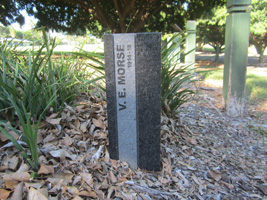 |
Vern Morse died in Belgium on 4 October 1917. Tree 60 - a flame tree was planted here on 26 July 1918 but it died and has not been replaced. |
Vernon Eustace Morse was born in Brisbane on 11 May 1893 - one of ten children of Ernest and Mary Morse. His father Ernest Tilly Morse had married Mary Brogden (b 1858) in South Leith, Oxfordshire, England and worked for Mary's half-brother in a bakery in Islington, London. This background would serve them well later on. By 1886 they had three children: Ernest Frederick (1882), Eva Maud (1885) and Ethel Tilly (1885), and decided to emigrate to Australia. Father Ernest arrived - by himself - in Australia in 1886 as an indentured emigrant and found work at Charleville, Queensland. His wife and three children arrived in 1888. Ernest became a pastrycook at a bakery at Stanley Street, South Brisbane. The family lived above the premises. More children were born: Ida Eugene (1889), Marjory Christina (1891), the twins Oswald Hector and Vernon Eustace (1893), Lillian Paradise (1895) and Daisy Jessie (1895).
After the Brisbane River floods of 1891 and 1893 - which saw their bakery go under water - they decided to become farmers. They bought land at Acacia Ridge, Browns Plains and called it Paradise Plains. Mary and the children did all the work; Edward decided to breed, race and gamble on horses - which was relatively successful. The children had little formal education: they rode horses to Coopers Plains State School after milking the cows and returned home the same way and did more milking.
The twins Vernon and Oswald became best friends with a local boy and schoolmate Alfred Ansell. The three made news in the papers in 1905 when they had an altercation with a snake. On 1st October 1905 the three boys were playing in the nearby Oxley Creek when they saw a snake and tried to kill it. The snake bit Vernon on the thumb and left two puncture wounds. Alfred, having done the Department of Public Instruction's compulsory First Aid Course at school, wnet into action. He was confident about dealing with snake bites, so he put a torniquet around Vern's thumb and wrist and cut the wound with a piece of sharp glass to let the poison out. They went home but Vern was scared that he would have to go to hospital if he told his parents so he went straight to bed. In the morning he was okay. Alfred was regaled as a hero and his first aid efforts written up in papers all over Queensland (see, for example, Rockhampton Morning Bulletin 9th October 1905). It is not certain how Vernon was regarded. One presumes not well. Alfred must have taken a liking to the twins' older sister Ethel, whom he married in 1913. In 1916 they Morse family had enough of farming life and moved to Fairfield.
 |
| The three childhood friends sign up - 1916. Back row: Alfred Ansell (left). Front row: the twins Oswald and Vernon Morse. (Jason Barber) |
The three young men decided to enlist in the Army and attended the recruiting office together on 14 September 1916. They were all marked down as 5th Reinforcements for the 42nd Batallion AIF currently fighting in France and given consecutive Regimental Numbers: Oswald 2705, Vernon 2706 and Alfred 2707. The men applied for 4 days leave from 2-6 November - which was granted - so they could bid farewell to their parents. The young soldiers left for overseas aboard the transport ship HMAT A55 Kyarra on 17th November 1916 and arrived at Plymouth 10 weeks later. They all trained at Sutton Mandeville in Wiltshire with the 11th Training Brigade and left for France together on 2 July 1917. As part of the 3rd Division AIF, the 42nd Batallion was focussed on the Ypres sector of Belgium. The three soldiers had joined the 42nd "in the field" after the major battle at Messines on 7 June 1917, but they were soon involved in the Warneton battle on 31 July.
At the start of October 1917, the 42nd was at the Belgian town of Poperinglie. The weather was cold, but fine and clear, on the 1st October and the batallion prepared for a major operation to the east of Ypres. The Germans planes were bombing the 3rd Division but there was just the one casualty in the 42nd's camp. The next day - 2nd October - the 42nd's war diary records that there were 43 officers and 977 ORs (other ranks) present for the battle. The batallion was entrained at Poperinglie and soon arrived at Ypres where they bivouaced to the east, near the cemetery. The 3rd October passed with little incident. Vernon wrote a letter to his mother and handed it in for posting. The battle was about to take place the next morning - the 4th October 1917. Vernon and Alfred Ansell were together in "C" Company of the batallion.
At 5.16 am on the morning of Thursday 4th October the batallion's artillery put down a fearsome barrage which moved forward until 6 am. It was met with an equally fearsome barrage from the Germans. At 6 am, the attack on the German lines began. The 42nd's barrage fell like a"wall of flames" on the appointed line (The Red Line). The rear troops sustained a fair number of casualties and to avoid more they moved forward up Hill 40 until the whole brigade was crowded into an area of 100 yards. An enemy machine gun kept them pinned down for 5 minutes. They had moved forward about 300 yards by this time. Pte Vernon Morse was in the line together with his brother Oswald, and a mate - Lance Corporal John Wilson Thomson (726, C Coy) a fettler from Scotland who had enlisted with the 42nd in Brisbane in 1915. At 6.30 am, as soon as they went over the top (out of the trench), Morse was hit in the thigh by one of their own shells that had fallen short. His leg was taken off and he dropped to the ground. Thomson continued moving forward under fire. Sgt Walter Duncan (3208, C Coy) was with Morse as he fell. Morse called out "my leg is broken - I can't move" and Duncan called for stretcher bearers who took him - still conscious - to the Casualty Dressing Station at the rear of the lines.
At 6.41 am, the rest of the 42nd leap-frogged the 43rd batallion and continued the attack. Vernon's brother-in-law Alfred Ansell was in a trench in Thames Wood - about 50 yards on the eastern side of the railway line from Zonnebeke going towards Passchendaele (see map below). He leapt from his trench and also "went over the top". At that very moment a German shell landed in the trench and struck Ansell with full force. One soldier said "he was badly knocked about" but it is evident from other eye-witness accounts that Ansell was torn apart by the bomb. The 42nd batallion took their objective (The Red Line) by 8 am. One hundred German prisoners were taken and nine machine guns captured. However, the 42nd batallion lost 3 officers killed, 2 officers died of wounds and 6 officers wounded. As for the "ORs", 220 were killed or wounded including Pte Alfred Ansell (KIA) and Pte Vernon Morse (WIA). Most of the casualties were in this Thames Wood area.That same afternoon his platoon mate, Pte James Sheridan (713) - a miner from Gympie - buried what they could of Albert. He was buried where he fell and a rough cross was erected to mark his presence. Sheridan was helped by fellow soldier L/Cpl John Wilson Thomson (726) who was with Morse when he (Morse) was hit. Thomson was wounded in action the very next day.
What happened to Vernon Morse is somewhat of a mystery. It seems that he was conscious when the stretcher bearers took him to the Dressing Station. It seems that his leg was still hanging by a thread and was amputated. Vernon's brother Oswald was with him when he fell. A friend of the brothers - Sgt Henry Greer wrote that Oswald "had taken it very hard" and thinks Vernon will lose his leg. It appears that Oswald later told fellow soldiers that Vernon died in hospital after the leg amputation. This was confirmed by the Red Cross but the army had no knowledge of Vernon's whereabouts and could not say officially that he had died of wounds. The army posted him "wounded, 4-10-17". On the 12th November By 28th December this had changed to "wounded and missing".
 |
Mrs Morse heard from reatives of men in England that Vernon had either died in France or was in hospital in 'Blighty' (England). She was reported to be greatly distressed. In March 1918 Vernon's personal effects were posted to Mrs Morse from London; they included her son's wallet, photos, cards, and a leather case. And then his "alottment" (pay) stopped. She was convinced that he was dead and kept trying to get details. On Sunday, 26th May 1918 the clergyman at the Memorial Service at Coopers Plains Congregational Church said that Vernon was amongst the dead. There was a quick retraction after Mrs Morse contacted him to set the official record straight. On 7 May 1918 the army reported the result of a Court of Enquiry into Vernon's whereabouts. They concluded that he was dead and issued a statement to that effect. A letter, dated 27 May 1918, was hand-delivered to Mrs Morse, around about mid-July, stating that her son was now "Killed in Action, 4 October 1917". The names of Alfred Erold Ansell and Vernon Eustace Morse are inscribed on the Ypres (Menin Gate) Memorial in Belgium.
On the 4th anniversary of her son's death - 4th October 1921, Mr and Mrs Morse placed a notice in the Brisbane Courier:
Under the flag of the five-starred cross, |
Mrs Morse's husband Ernest died the following year (12 April). She submitted another notice in the paper:
Sleep, dear Vernon, in a foreign land, |
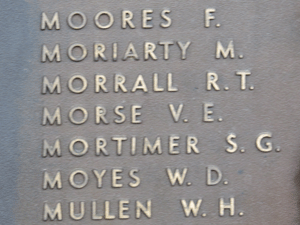 |
Australian War Memorial Roll of Honour October 2018 (J Hawker) |
Stanley Edward Burrell Nalder
 |
 |
Stan Nalder was just 23 when he died. He was with the 26th Bn in France when he was killed on 12 June 1918. |
Stanley Nalder was a student of Yeronga State School. |
.jpg) |
 |
.jpg) |
Nalder's weeping fig #61 - the new weeping fig was planted some time ago to replace the one planted on 26 July 1918. |
Flowers beside Nalder's weeping fig #61 - Anzac Day 2014. |
The original post for the Stan Nalder plaque is one of the two remaining posts left. The other one is for Charles Ruff (#69). |
Stanley Edward Burrell Nalder was born on 7 November 1895 in Brisbane to Henry Herbert Nalder and Agnes Alice Nalder (née Woods). He was one of 14 children: Frances, Francis, Robert, George, Eveline, twins Patience and Annie who both died at 12 months, Charles, Sylvia, Leslie, Stanley (himself), Clement, Percy and Gladys. They lived Lang Street, Fairfield, and later in Venner Rd, Fairfield. Henry, the father, was a blacksmith. Stanley attended Yeronga State School (as did the other children):
This extract from Queensland State Archives Enrolment Register for Yeronga State School [ID 868280] shows that Stanley Nalder was enrolled on 6 July 1903 at the age of 7 years 9 months. Father's occupation is "Smith". Stan left school in September 1909 (last column) at the age of 14 years. |
Upon leaving school Stan worked as a clerk for a grocer. He spent 2½ years with the Citizens Forces (9th Bn) and 1½ years on the Instructional Staff. His brother Robert Thomas Nalder enlisted in the 31st Bn AIF in July 1915, and headed overseas to England and then France where he received a gunshot wound to the thigh in July 1916 but recovered. Stan was next to enlist (1 March 1917). He was placed with the 25th Battalion with the rank of Sergeant due to his prior experience and departed Sydney aboard HMAT A20 Hororata on 14 June 1917 arriving Liverpool on 26 August 1917 and then on to training. Robert was sent back to Australia and discharged in December 1917.
Stan proceeded overseas to France that same month. The 26th Battalion had just finished their "stunt" at Ypres when Stan joined them on 1 January 1918. In April 1918, the 28th fought to turn back the German spring offensive.
Back home in Australia his younger brother Clement Louis enlisted in 9th Bn AIF in April and embarked for London on 3 June 1918 for training.
In June 1918 Stan and his 28th Battalion were just to the south of Morlancourt on the Somme in close support for the other three battalions (25, 27, 28) of the 7th Brigade. Each night the battalion supplied working parties of about 180 men to take Stokes bombs, Newton bombs, wire and so on to all parts of the 7th Brigade's front.
At about 11pm on the night of 12 June 1918, Stan Nalder - as Platoon Sergeant - was in charge of a party on "engineer's fatigues" taking barbed wire and stakes up to the front line at Heilly. As there were no communication trenches joining the front line to the rear trenches, Stan climbed over the parapet. He was shot through the head by a machine gun bullet. The soldier beside him - George Gibbins (6537) - later said "it went straight through his tin hat, not a murmur". Stand died instantly and was carried away by stretcher bearer Vic Wheeler (5428) and Ernie Travers (6628). Some men said that a shell exploded at the same time and wounded 10 of the 30 men in the platoon. He was taken to the Dressing Station and from there to a grave at the Franvillers Communal Cemetery Extension (Somme France). Stan was buried by some of his mates and prayers said by Burial Corporal Tom Honeywell (R340) from Brigade HQ. Pte Fred Gordon (375) and Bill Slater (173) mounted a large wooden cross on the grave.
The army contacted his parents who were now living in Wynnum. They were unable to locate his wife Florence as she had shifted - but they eventually made contact. The war had ended and Clement returned to Australia in July 1919. Florence remarried in 1921 to Joseph Perrott.
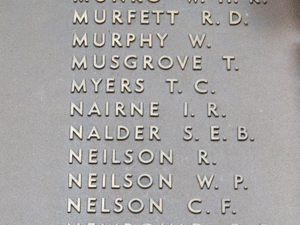 |
Australian War Memorial Roll of Honour October 2018 (J Hawker) |
John Neil - stretcher bearer KIA Gallipoli
 |
 |
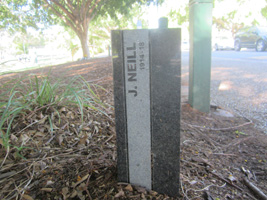 |
John "Jack" Neil (3523) was serving with the Australian Medical Corps - 7th Field Ambulance - when he was killed. |
Jack Neil - 1915 |
Jack was killed at Gallipoli on 4 October 1915. He was just 24 years old. |
.jpg) |
 |
 |
| Jack Neil's tree (#28) used to be a flame tree but it died and was replaced with a Lepoard Tree. | Yeronga State School - Anzac Day 2014 |
Lovely bark. The original flame tree was planted here on Saturday 15 September 1917. |
John Neil was born in Brisbane on 5th November 1890 to parents John and Ann Rebecca Neil (née Dawes). He was the oldest of six children: Bertha (b 1892), Maurice (b 1894), James (b 1896), Roy (b 1898) and Vera (1901). Just before the youngest child (Vera) was born his father died (1901). And then in 1905 his mother Ann also died. This left John at the age of 15 as the oldest of the six orphans. His aunt Kate Hamilton Neil stepped in to be a guardian. The children all attended Junction Park State School.
John lived at the Thompson Estate, off Ipswich Road, and had to care for his youngest sister Vera who was disabled ("crippled"). John trained as a teacher at Cathedral School for Boys. This school was the fore-runner to the Anglican Church Grammar School ("Churchie"), East Brisbane. His mentor was David Owen, Professor of Mathematics, and Miss Loney, Mistress of English. He was appointed a Master at the school and became an Assistant Acolyte at St John's Cathedral in the city.
John (or "Jack" as he was known) enlisted on 4 May 1915 at the age of 24. He was placed in the 7th Australian Field Ambulance (AFA) as a stretcher bearer. His sister Vera was still a minor so she was placed in the care of her grandmother. Earlier that year his brother James had also enlisted (as a driver in the Light Horse). James had already spent 6 months in the Militia - the Machine Gun Section of the 8th Infantry. On the 24th May 1915 the Troopship A11 Ascanius was ready to depart Brisbane for the Middle East. John was aboard, and so was his brother James. John quickly made friends with two other soldiers in the 7th Field Ambulance: Harry Bullions (3961) from Enoggera (Brisbane) and Gerry Schlencker (3547) a woolbroker who lived at Acanthus Street Highgate Hill - only a stone's throw from Jack. They arrived in Egypt 2 July, disembarked and proceeded by train to camp at Abbasia.
On 8th July 1915, Jack received a letter from one of his former Churchie students - young Ernest Brooks who had written to his former teacher apologising for not being at the wharf to see him off. The next day Jack wrote a letter of reply to Ernest telling all about his journey from Pinkenba, Brisbane, via Sydney to Fremantle, and then to Egypt via the Suez Canal. He describes the daily routines of the soldiers and their training schedules:
Cairo I was very pleased to have your letter (which arrived yesterday) and to know you are keeping well. As for not being able to see me off I am very sorry you were not on the wharf. I did not see young Crisp : the only boy I saw on the wharf was Ormerod. Yours is the first letter I have had from the school so you see I greatly appreciate it : and trust to receive many from you. Leaving Penkemba [Pinkenba wharf] on the Monday, we were in Sydney for a week sailing from there on Tuesday, 1st June direct to Fremantle in W. Aust. There we only stayed for 18 hours : and sailed thence to Cape Guardafui, round to Aden, through Bab-el-Mandeb, into the Red Sea, arriving at Suez about a week ago. There we had to stay for a few days. We should have gone through the Canal but an accident happened to a boat in front of us, which blocked the Canal, and we had to wait outside. Our officers therefore determined to land us at Suez, and send us by train to Cairo. It is a run of eight hours from Suez to Cairo, we leaving at 6 o'clock Saturday morning arrived at Cairo at 2 o'clock Saturday morning. We left the train and marched to our camp at Abbassia. It would take so long to write all about the place. However, as we have sickness in camp, we are not allowed out of camp ; so my letter this time will be very short. I shall drop you a p.c. from time to time. It is very hot here. We are up at 4.30, go on parade at 5.30 and drill till 9 : then have breakfast : the rest of the morning is spent getting lectures, bandaging etc : dinner at 1 o'clock. Off till 4, drill from 4 to nearly 7, tea at 7. So you see we have long days : and tramping about in the sand, which is deeper than your ankles, is not easy work. That is why we do our drill in the mornings and afternoons, and none during mid-day - it would be too hot. You can look all round you, and see nothing but sand. The winds, too, are hot : and the sand flies about everywhere. We are in tents, but have our meals in wooden huts. The natives are very interesting - they are real studies in themselves. They do most of the work in the shape of building huts, making roads, etc. As soon as I am able to do so I shall procure some views of Egypt, and send them on to you. We are about half a mile from Heliopolis hospital. It is a beautiful place, and is full of wounded. I will finish off now. Remember me to the boys. Tell them I am well and working hard, and that I do not forget them. With fondest regards and best wishes. Yours sincerely Jack Neil |
Source: Glenda Murrell, Manager, Records and Archives Centre, Anglican Church Southern Queensland
The 7th Field Ambulance left Alexandria for Gallipoli on 4 September 1915 and landed nine days later on 13th. Soon after his arrival at Gallipoli Jack experienced the heavy gun and rifle fire from the Turkish lines that Anzac position was familiar with. Jack carried out his stretcher bearer duties well and his Red Cross Badge and arm band may have given him some protection. Nevertheless, early in the morning of the 4th October Jack went with a party of other stretcher bearers, including his best mate Harry Bullions, to draw stores at Anzac. A shrapnel shell exploded close behind him. The cap of a shell pierced his stomach and killed him instantly. He was also wounded in several other places. Harry and his other mate Gerry Schlencker carried Jack down to the Casualty Clearing Station on the beach. He was pronounced dead and buried that afternoon on a consecrated spot at Walden Point Burial Ground, about ¾ mile to the left of the No. 2 Outpost (towards Suvla). Gerry erected a cross and Chaplain Captain William Charles Smith performed the service. The burial was made more than usually impressive by the guns from the warship opposite firing its heavy shells at regular intervals .
In late October Jack's next of kin (his aunt Kate) was told of his death by a local clergyman, and followed up with a telegram. Jack's younger brother Maurice, a station-hand at Rockhampton, felt moved to enlist and did so on the 19th (October). The 105th Casualty List was published on 8th November which detailed the deaths of 26 Queenslanders, including Pte John Neil.
In December 1915 Lieutenant-Colonel Huxtable, the Padre of the 25th Battalion, wrote to Jack's sister Vera. He said that Jack's death was the first in the Unit and :
"has resulted in a feeling of intense regret for the loss of one who was universally liked by his comrades. His work has always been good and full of promise, and I not only regret having to write so sad news to you, but I also regret the loss to the force of one who had proved of such great value. His loss, in time, will be softened by the knowledge that he has given his life in the service and for the safety of his country." |
Vera was puzzled as she had received letters from Jack a month earlier dated 9th and 10th September in which he said he had been approved for leave to Lemnos (Island) starting on 12th September. She wondered if he was really alive and just on leave. In January 1916 the Army wrote back to her to say that he was confirmed dead on the date stated.
After the war a reburial party recovered the remains of soldiers from the Walden Point Burial Ground and took them to consecrated grounds at the 7th Field Ambulance Cemetery, two miles north of Anzac Cove. They were unable to identify all soldiers and admitted to Vera that his exact burial place could not be stated with certainty - it was just in the cemetery.
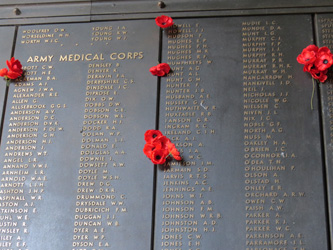 |
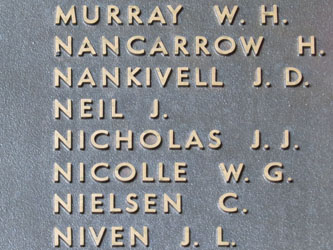 |
Australian War Memorial - Canberra. Here begins the names of the fallen from the Australian Army Medical Corps. (Jim Hawker) |
Australian War Memorial. John Neil - AAMC. (Jim Hawker) |
Jack's brother James was wounded in France in July 1916, and his other brother Maurice was wounded also in France in September 1918. Both returned safely to Australia.
Gallipoli Visit: For Anzac Day 2015, Year 10 student Phebe Mills from Merrimac State High School on the Gold Coast visited Gallipoli and honoured John Neil. Phebe was the recipient of the Queensland Premier's Anzac Prize and went to Gallipoli for the 100th Anzac commemoration. As part of her prize she was given the honour of researching two soldiers and to commemorate them at their grave site. While reseaching John Neil 3523, she came across this website and asked if I could put her in contact with descendants of John Neil. I was unable to help as I couldn't locate any either. If they do read this then I hope they come forward. Phebe said "I know this is a long shot, but my fingers are crossed".
My thanks to Phebe for the photos below:
 |
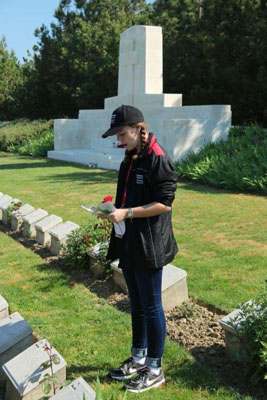 |
At John Neil's gravestone, Shrapnel Valley. (Mills) |
Phebe reading a eulogy in front of John Neil's gravestone. |
 |
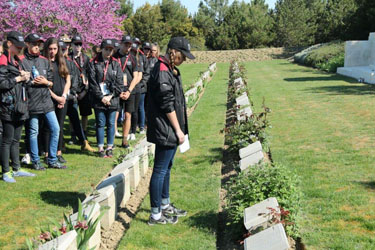 |
At the 7th Field Ambulance Cemetery, Shrapnel Valley. |
A moment of reflection. Day 6 of the trip. |
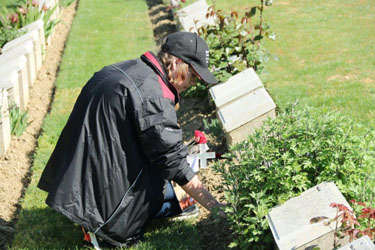 |
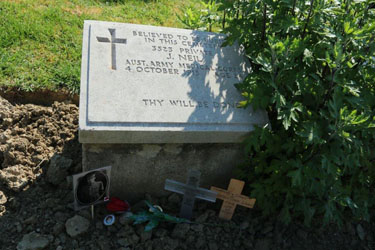 |
Placing a cross in John Neil's memory. |
He is remembered. |
 |
 |
Australian War Memorial - Canberra. Here begins the names of the fallen from the Australian Army Medical Corps. (J Hawker) |
Australian War Memorial. John Neil - AAMC. (J Hawker) |
Note: John 'Jack' Neil is linked to family that owned the land where the present Junction Hotel stands. Jack's grandfather John Neil Snr (1885-1900) was a builder, contractor, and publican and owned a quarry in the Ekibin – Wellers Hill area. In 1869 he purchased the wooden Junction Hotel and 2200 m2of the adjacent land which he subdivided into five blocks (corner of Ipswich and Annerley Roads). John Neil erected a hall on one of the blocks (Resub 3) in 1885/6 which was rented to Lodges, Societies and other social occasions for the people of the district. He built a home on another block (Resub 5) next to Ponsonby Street. He had a stables, blacksmith, saddler and wheelwright business operating on Resub 4. The wooden hotel on Resub 1 was damaged by fire and rebuit in wood only to be replaced by a brick and stone hotel with material sourced from his quarry. John Neil died in 5th April 1900 and the title for the 5 blocks transferred to his second wife Bertha Neil, née Wheeler (1851-1931) on 12 December 1900. She was the daughter of Mary Adlam and Robert Wheeler and married her first husband - Sam Bateman in 1875. After Sam's death in 1883 Bertha married John Neil in 1885. He died in 1900. Bertha Neil sold the hotel block (Resub 1) in 1924. She died on 30 September 1931 and title for Resubs 2-5 were transferred to the Public Trustee (obviously she had no will). Resub 4 was sold to the Brisbane City Council in 1935, and Lot 2 sold to Charles in 1935, Resub 3 to Robinson and Resub 5 (the hall) was sold to the RSL in 1938. In 1946 the RSL purchased Resub 2 beside the block they already owned.
Martin John Nolan
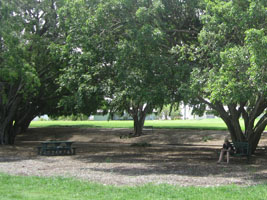 |
 |
Tree 88 - A flame tree was once here but died and has been replaced with ornamental grass. A picnic table is where the tree once was (between the trees of Harold Mitchell on the left and David Ormiston on the right). |
A new plaque marks the location of Nolan's tree. |
Martin John Nolan was born in Brisbane (Moorooka) in 1896. His father Michael Joseph Nolan married Margaret Cecilia Freney in Brisbane in 1890 and they had four children: Margaret Beatrice (b 1891), Amy Maria (b 1892, d 1892), James Michael (b 1894) and Martin. Their mother died in 1899 when young Martin was just three. He was named after his mother's father Martin Freney.
Sometime after Mrs Nolan's death, her husband Michael left and the children were taken in by her brother Ernest Patrick Freney and his wife Ethel at St Kilda Estate, Bower Street, Annerley. Martin attended Junction Park State School, just a stone's throw from home. In 1913 his unmarried sister Margaret Beatrice Nolan died (aged 22).
Martin enlisted in the 8th Battalion army reserve, trained at Oxley, Brisbane, and obtained work as a blacksmith. He was two years into an apprenticeship with his uncle James Freney when, on 5th October 1914, he joined the army (Regimental Number 1166). Martin was placed with the 9th Battalion, 1st Reinforcements. His brother James - who had been working for Messrs Robert Reid & Co., the wholesale softgoods importer in Rockhampton enlisted just four days after Martin. James was placed with the newly formed 1st Australian General Hospital which left aboard HMAT Kyarra A55 in November 1914. Martin left Australia on 22 December 1914 aboard HMAT Themistocles A32 departing Melbourne for England (but diverted to Egypt). They both arrived in Cairo at the start of 1915: Martin to begin training for what he thought was to be a war in France, and James to begin work at the hospital.
Martin and the 1st Reinforcements joined the 9th Battalion (C-Coy) in Egypt and continued training. The battalion departed Alexandria aboard the Malda on 2 March 1915 and was transferred enroute to the destroyer HMS Usk bound for Gaba Tepe, Gallipoli. The 9th Battalion was a part of the 3rd Brigade and they were to be the covering force for the Anzac landing on 25 April 1915. A-Coy and B-Coy of the 9th Battalion were the first ashore at Anzac Cove around 4.15 am. At 10 a.m. Usk approached the shore dropped off the greater part of C-Coy (Martin's unit) and D-Coy. Much shelling took place while the destroyer and its three hundred men approached the shore. One shell, bursting above the ship, injured some of the sailors but the infantry escaped hurt. The battalion was heavily involved in establishing and defending the front line of the Anzac beachhead.
Martin served at Anzac but was never keen on being ordered around. Absence from parade caused him to get 24 hours "FP No. 2". Field Punishment 2 usually involved extra fatigues. The following month he got this again - but for 96 hours for refusing to obey an order and using insulting language to an officer. The next month (July 1915) Martin was struck down with diarrhoea from dysentery. This disease struck the men in the trenches as there was no proper sanitation. It caused them to lose important salts and fluids from the body and could be fatal if the body dehydrates. Martin was taken to the field hospital at Gallipoli and then a few days later he was off to Cairo as it was so severe.
His brother James was working as a medical orderly at the 1st Australian General Hospital (1AGH) in Cairo when Martin was admitted on 16th August (1915). James must have had the same temperament as his brother for he was fined 7/6d (over a day's pay) for disorderly conduct (refusing to take orders for a nurse).
It was considered by the army that Martin needed to return to Australia for six months "change" before being discharged. It was considered that he was too young and needed 3 years to mature before being considered for reenlistment. Martin departed in October 1915 aboard HMAT Aeneas for Australia. Over in France his brother James had shifted from Cairo to Rouen in France as part of the 1AGH takeover of the old British No. 12 Stationary Hospital. Here he spent most of his time assisting in operating theatres and helping manage the wounded, sick and dead.
Back in Brisbane Martin obtained work with the post office as a letter carrier. He got himself in to a spot of bother with the police and was on remand for a court case adjourned until 1st September 1916. He was due to go to trial but decided to join the army again. On 8 September he re-enlisted in the 9th Battalion, now with the 16th Reinforcements. He was soon off to France aboard HMAT Boonah A36 departing Brisbane 21 October 1916.
Martin arrived in England for training and was sent to France in February 1917. He rejoined his unit in the field on 10th March when they were at Shelter Wood near Albert. The Battalion was demonstrating "Battalion in Attack" to the other battalions of the 3rd Brigade when Martin suffered a severe gunshot wound to the right leg. He was taken to the field hospital where his wound was dressed. His brother James by this time had been transferred from the 1AGH in Rouen to the 2nd Australian Casualty Clearing Station in Trois Arbres near Bailleul in France (about 100 km north). Eventually Martin was sent to England for recovery and, inevitably, more training. Finally, on November 17th, he was back in France with his unit. They were in Halifax Camp near Boulogne in northern France (near the coast).
The battalion then moved back to Belgium for the advance to the Hindenburg Line, and in March and April 1918 helped stop the German spring offensive. In August the battalion prepared for the great allied offensive of 1918 near Amiens.
On the 8th (of August) Martin was at a little village of Le Hamel (about 10 km west of Amiens) followed by 'awful' billets at Bois de Accroche on the 9th. It was now time for their attack on the German trenches about 7 km SE of Harbonnieres (see map).
The aim was to capture and control a line marked on the map as The Blue Line. At 6.30am on the morning of the 10th the Battalion moved off after a 15 minute artillery barrage designed to destroy German machine gun posts and artillery. The War Diary describes this barrage as 'wretched and scrimpy and without sting'. However, the battalion reached the Red Line without casualties. At 8am a general advance was ordered. Martin's company, C-Coy, was at the right side of the red line, acting in support of A-Coy also on the right. They were held up by terrific machine gun fire from the Germans from which there were heavy casualties. The main German MG position is shown on the map (at the top) at X24.a.3.0 and this was eventually silenced but not without further (severe) casualties. The battalion advance stalled, particularly as the artillery barrage was very heavy. Martin Nolan was struck and killed somewhere between the Red Line and a point marked as X24.c.2.2 where C-Coy had established a strong point at noon.
This advance by British and empire troops near Amiens was the greatest success in a single day on the Western Front, one that German General Erich Ludendorff described as "the black day of the German Army in this war".
 |
| A section of the trench map used by the 9th Bn in the advance on German lines on 10th August 1918 [Map 62D SE and 62C SW, 1:20000, Edition 3A, June 1918]. The battalion had to pass the red line and capture the blue line. By 5pm on the 10th, the 9th Bn were holding the line on the road shown by the dotted line. I have marked on the map a red cross to show the approximate position of where Martin Nolan (C-Coy) was killed. |
Martin was buried near where he fell but was reinterred in Heath cemetery anout 2500 yards north of Harbonnieres.
Martin's brother in the meanwhile had leave in London and Paris and upon rejoining his No. 2CCS in Hazebrouck heard of his brother's death. He was given furlough back to Australia, leaving in September 1918, and upon arrival in Brisbane was discharged from the army (24 January 1919).
Although James was Martin's next of kin, Martin's war medals had to be given to his father Michael. The problem was that James had been overseas with the army for 4 years 108 days and had no idea where his father might be, and told the army so. The army advertised in the local papers for the father's whereabouts but in the meantime he was located by James (November 1920). The medals and scroll found their way to the rightful recipient.
James's health was not that good. He had a persistent cough since 1919 and it was getting worse. Cough elixirs were not efficacious. Nevertheless, he married Vivian Ida Rigby in 1927. James obtained work as a commercial traveller with the wholesale merchants Sargood & Gardiner in Rockhampton, but continued to have a persistent cough, shortness of breath, and lassitude. He was diagnosed by blood test with advanced active pulmonary tuberculosis.
When he was no longer able to work (1930) James applied to the army for a pension on the grounds that his TB was the result of war service, from working with TB patients in the hospital and CCS. The army rejected his claim. James died on 10 August 1931 in the Ardoyne Red Cross Home at Corinda. His widow appealed to the army to reconsider the pension application and a tribunal made a favourable decision in April 1933. They reimbursed Mrs Nolan £15 for the cost of the funeral.
Michael Joseph Nolan outlived them all: his wife and all four of his children predeceased him. He was somewhat of a pauper though, living in a hut at a slaughter yard at Southport when he died of natural causes in 1932. He was said to be over 70 years old but no-one knew his details: his birth or parents' names.
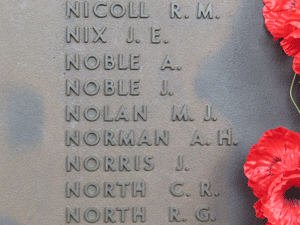 |
Australian War Memorial Roll of Honour October 2018 (J Hawker) |
Ormiston Brothers - Andrew, John & David
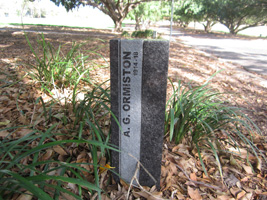 |
 |
 |
Tree 62 - a big old weeping fig still stands here today to commemorate Andrew Ormiston. |
Tree 89 - a plaque and weeping fig commemorate John Ormiston |
Tree 90 - plaque and weeping fig commemorates the service of David Ormiston. |
.jpg) |
.jpg) |
.jpg) |
Tree 62, for Andrew Ormiston - planted 26 July 1918. This is at the roundabout next to the tennis courts. |
Tree 89 for John Ormiston - planted 23 August 1919 |
Tree 90 for David Ormiston - planted 23 August 1919 still stands quite majestically here today and provides a shady spot to sit (see seat in photo). |
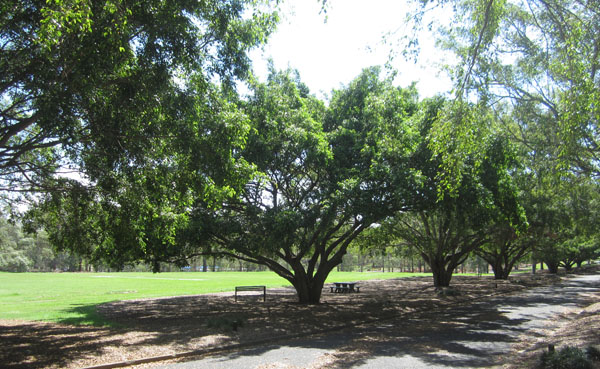 |
Pte David Ormiston's tree (#90) in the centre. This beautiful big weeping fig planted in 1918 has provided shade to countless users of the park over the past century. Pte Martin Nolan's tree (#88) was a flame tree but died and was roughly where the table and benches are today. The next big weeping fig is that of Harold Mitchell (#86) and then Robert Hepworth (#82) and in the distance is the tree for John Gnatz (#80). |
 |
 |
 |
|---|---|---|
Andrew Graham Ormiston |
John Wightman Ormiston |
David Ormiston |
The Ormiston family lived in the home "Fernside" on the Dunellen Estate between Logan Road and Ipswich Road Annerley at the beginning of World War 1. Parents Christiana and Thomas Ormiston had seven sons and one daughter. As if losing one son in war was not tragic enough, it is almost incomprehensible to imagine what they had to experience: of their four sons old enough to enlist, three died overseas while on military duty, and the fourth returned to Australia after spending a year in a London hospital recovering from gunshot wounds. The boys' Dad, Regimental Sergeant Major Thomas Ormiston, was a founding member of the instruction team at the RMC Duntroon and as such was training young soldiers to be officers during World War 1.
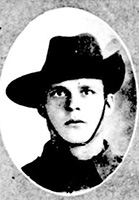
David Ormiston
(Queenslander June 1915)
The first to enlist was the third eldest, David - a painter, born in Edinburgh January 1894, who enlisted in the 49th Bn in Brisbane in September 1914. He left for Gallipoli three weeks later. Next to go were the second eldest and the youngest sons (respectively) - John Wightman aged 22, a butcher born in February 1892 in England, and Andrew Graham aged 17, an apprentice machinist born in May 1897 in Edinburgh, both of whom enlisted in the 25th Bn in Brisbane in February 1915 (in fact Andrew was the youngest soldier in the battalion). John left for Gallipoli in late June, and Andrew followed in August. The last to join was Thomas - a truck driver born in January 1891, also in Edinburgh, who enlisted in the 31st Bn six months later - 26 August 1915 - two days before his brother Andrew embarked.
All brothers moved to France during 1916 after the evacuation of Gallipoli. Andrew suffered a terrible gunshot wound in 1917 and was later killed in action on the 25th May 1918 and buried at the Ribemont Cemetery in France. Less than two months later John was killed also in France (17 July 1918) and was buried at the Adelaide Military Cemetery in France. David was wounded twice in France and died from gunshot wounds on 9th of April 1919 while on unapproved leave. He was buried in St Pierre Cemetery, France. The oldest brother, Thomas, served two years in France before being wounded by gunshot. He was sent to hospital in England and upon recovery returned to Australia in July 1919.
If you are a relative of the Ormiston brothers and have more information to share, please contact me.
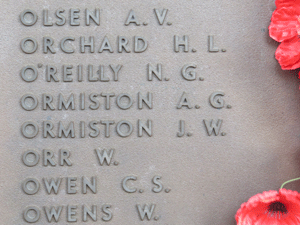 |
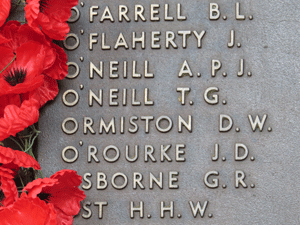 |
Australian War Memorial Roll of Honour - October 2018 (J Hawker) |
|
Henry Ernest Orth
.jpg) |
 |
Pte Orth's tree (Tree 63) was a flame tree that couldn't survive (probably too shady under the figs). It has never been replaced. Ornamental grasses mark where it was. |
His new plaque. |
Henry Ernest Orth was born in Brisbane on 9th August 1894 to John Orth and Anna Elizabeth Orth (née Berger). His father John had emigrated from Prussia (Germany) in about 1857 with first wife Anna (née Schroder) and infant daughter Martha to take up position at Boondooma Station (near Gayndah, Queensland). Second daughter Mary and first son Caspar were born there soon after. Wife Anna died and John (now aged 57) remarried to Anna Berger (20 years) in 1887 in Glen Innes, NSW.
John and Anna moved to Brisbane and became quite wealthy as produce and poultry merchants in South Brisbane, which he later sold to his son Caspar in 1887. John and Anna had children John William, Anna, Henry Ernest, Herbert, Gertrude, Alice and Lillian. It is not clear where the children attended school but it was most likely Coorparoo State School given that they lived at Beatrice Street, Dunellan Estate, South Brisbane (now Greenslopes). John had extensive property investments in South Brisbane but the flood of 1893 incurred great losses. He died 5 September 1903 a poor man. Anna had to work hard to support the family of six children.
Henry obtained work as a farm hand, possibly at Rockhampton, and enlisted in the army on 22 April 1915 aged 20. He was placed in the 9th Battalion, 10th Reinforcements (3091) and departed Brisbane aboard HMAT Warilda on 3 October 1915. He travelled to Egypt and joined his battalion at the Tel-el-Kebir Training Camp on 7 January 1916. In February, back in Brisbane, his mother married John Gilbert (2 Feb 1916)
The 9th Battalion left for France in March 1916 and headed up to Fromelles for a stint as Brigade Reserve and some time in the front line. Throughout this time the battalion was subject to bombardment by the enemy and had many casualties. In April, while in Reserve, Henry came across some French wine and had a bit too much to drink. For this he was sent away from the front for 45 days and lost 55 days' pay.
Henry rejoined the Battalion in August 1916. He had missed the Pozieres "stunt" where 462 men from his Battalion were killed, missing or wounded. Nevertheless, the Battalion continued with drill practice and marching and ended up in Ypres at the start of September. Here, they were in and out of the front line, suffering terrible bombardment and casualties. This continued for all of October and by mid-November they were at Fleurs with more training and front line work. Christmas Day came and went without a break from the shelling and deaths. Finally, on 30 December they were relieved by the 11th Battalion (trench-foot men out first) and were billeted in huts at Bazentin. It was freezing; snow was falling. The War Diary says "the men were badly in need of sleep and rest".
Henry had time to write home:
I write these few lines to let you know that we received the parcel all right and we all wish to thank you very much for your kindness and generosity. We were in the trenches at Christmas time, so our sports, Christmas dinner, &c., were postponed until we came out. We held the sports yesterday, finishing the day with a liberal spread supplied from regimental funds. I was mess orderly for the day, so drew a ration, amongst which was the parcel. Knowing that the gift parcel was from friends in Queensland was half the pleasure in receiving it. I can assure you that we enjoyed everything that was in that parcel. We are in the middle of winter just now, and it is very cold. The Australians are standing the wet weather better than I thought they would. I would not mind being back in Queensland now. I expect it is very warm over there at present. |
Early 1917 saw the battalion continuing the offensive in France. On the 26 February they were still at Bazentin but making a charge for the front line. Henry displayed his courage and it was duly noted in the War Diary (March 1917):

After a two week break at rest camp in August 1917, Henry was back with the battalion late September when they were over the border in Belgium at Ouderom.
More training ensued and at the end of October they were ordered to take up positions on Anzac Ridge and Westhoek Ridge. On 5th October the 9th Battalion relieved the 8th Battalion in the support line. Rain was light and shelling was severe. On the night of the 7th they moved into the front line to relieve the 11th Battalion. The enemy was shelling the whole area. They held the front line all day of the 8th even with a very heavy barrage at dusk. The 9th October was "X" Day for the 10th Battalion to make a raid. There was heavy shelling of the front line and Henry was killed. The battalion was relieved that night but it was all over for Henry and 32 of his mates - total casualties for his battalion were 150.
In Brisbane, John's mother Anna Gilbert, entered deep depression over the death of her son in Belgium. Added to this was the death of her husband John Gilbert from a heart attack on 28 September 1921. She now became a widow for the second time. It is said she remained depressed for the next 26 years of her life. She died in 1952.
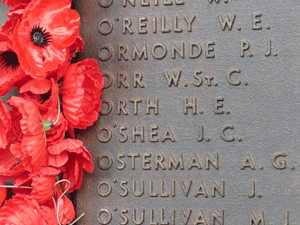 |
Australian War Memorial Roll of Honour October 2018 (J Hawker) |
Arthur Orton
 |
.jpg) |
 |
Pte Orton - 47th Bn - died in a London Hospital from wounds suffered in France. |
A new weeping fig has replaced the old one. Not too impressive now but will grow massive. |
Arthur Orton's tree (#29) was a weeping fig. It died but was replaced with a new one a little while ago. The Brisbane City Council takes cuttings from the original figs to propagate the new ones. |
Arthur Orton was born in Brisbane on 28 September 1888 to John Orton and Elizabeth Orton (nee Payne). His father John was born in Nuneaton Warwickshire England in 1856 to Edward and Mary Orton (nee Rayner). His mother Elizabeth was born in Crockerton Wiltshire in 1860 to George and Elizabeth Payne (nee Wall). They married in Derby, England, and had the one child there - Annie Laura - born in 1884 and christened at St Barnabas, Derby. John Orton seems to have been in business with his brother Joseph selling bicycles from their Orton Bros. shop.
The following year they migrated to Australia aboard SS Bathurst arriving in Brisbane on 5th November 1885. They settled in Annerley (Annerley Rd and Palmerston St) and had children Lydia (1887), Arthur (1888), Mary (1891) and Elizabeth (1895) who all went to Dutton Park State School. Mrs Orton died in Brisbane in 1903.
Annie married William Smale in 1909 but died in 1910. Lydia married in 1911. Arthur obtained work as a postman and in September 1915 enlisted in the army. He was 27 and placed with the 15th Battalion (1-23 Reinforcement) AIF. Arthur was off to the Middle East aboard HMAT Wandilla A64 in January 1916 arriving in early March. He was sick with mumps as he disembarked and was sent straight to the hospital. A week later he was well enough to rejoin his Training Battalion (4th Bn). His father was kept informed of his progress.
Arthur completed his training and was off to France in June arriving at Marseilles on the 9th. Arthur and the 47th entered the trenches of the Western Front for the first time on 3 July. He was with them for its first major battle at Pozieres. Initially, the battalion provided working parties during the 2nd Division's attack on 4th August, and then, with its own division, defended the ground that had been captured. Arthur came down with rheumatism on the 18th September, bad enough to be hospitalized, and then topped it off with a recurrence of mumps that occasioned an admittance to hospital at St Omer 40 km SE of Calais on the coast near England.
Arthur didn't get better. He was diagnosed with nephritis anaemia (kidney disease with loss of blood) on the 14th October and admitted to the Birmingham War Hospital in England dangerously ill the next day. Two days later (17 October 1916) Albert died of nephritis. He was taken to his uncle Joseph's home in Friargate Derby where he was prepared for burial. Albert was buried on 21st October.
A year later Mr Orton placed a notice in the Telegraph (17 October 1917): "Death divides but memory lingers." This may have also been a nod to his wife's death 14 years earlier.
 |
Australian War Memorial Roll of Honour October 2018 (J Hawker) |
Otterspoor Brothers - Frank & Harry from Holland
 |
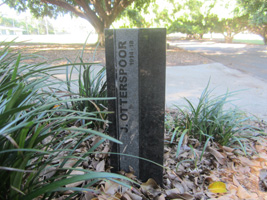 |
Frank Otterspoor's plaque beside tree No. 30. |
Servanus (John) Otterspoor. Tree 64 was flame tree but never survived. It has never been replaced. |
.jpg) |
 |
Frank Otterspoor's tree (No. 30) - a lovely weeping fig that looks like it is a replacement for the original. |
Flowers left at Frank Otterspoor's tree by the Year 5 students of Yeronga State School - 2014. |
Three Otterspoor brothers - all born in Holland - served in the Australian Army in WW1. They were the twins Servanus (Junior) - known as "John", and Arnold - known as "Harry" - born 18 November 1892, and Frank born in 15 November 1894. They were the sons of Servanus (Snr.) and Hendrika Johanna Otterspoor (née Van Kesteren) from Utrecht, Holland. The family arrived in Brisbane on S.S. "Gneisenau" on 26 August 1912. Aboard with their parents were Arnoldus (Harry), Franciscus Jacobus (Frank), Engelina (Lina) b. 5 July 1897, Theodorus b. 28 February 1903 and Hendrika Johanna (Rika) b. 24 Nov. 1905. The oldest son John - imbued with a strong anti-militarist sentiment - fled Holland in 1911 to get away from the dreaded Germans and headed for Cleveland, Ohio in the USA where he trained as a engineer. The family settled in to the house "Estor" in Ipswich Road, Brisbane. Hendrika became pregnant again and she wanted to go back to Holland for the birth, so husband Servanus left first, then Hendrika travelled with the three youngest children (Lena, Theo and Rika), leaving Arnold and Frank in Brisbane. Jeannetta Aletta - the youngest child in the family - was born in Holland on 26 November 1913.
Son John left the USA in 1914 at the age of 20 and came to Brisbane, Australia and obtained a job as an engineering draughtsman.When the war began, the first to enlist was Frank - who worked at Smellie and Co. engineering in Brisbane and had become a renowned violinist. On the 18 July 1915 he enlisted in the 31st Bn AIF and was straight off to France. The second to enlist - exactly one month later - was Arnold (known as "Harry"), aged 23, an engineering fitter at the Cannon Hill abattoir who joined the 11th Light Horse and was also off to France soon after. By July 1916 Frank was dead - killed in the field at Pozieres, France. His father asked for the inscription on his grave at Rue-Petillon Military Cemetery, Fleurbaix, France to read:
Your loving child I still remain Oh Blessed Parents You whom I loved with all my heart; And though I died that all might live From you dear ones I'll never part. |
|---|
The above verse that Servanus wrote for his son Frank's gravestone was not allowed; the family has the letter telling him it was too long. John became naturalised in 1916. He married Trijntje Koolhoven (née Haarsma) in Brisbane the same year. She had married Pieter Cornelis Koolhoven in Leeuwarden, Friesland, the Netherlands on 24 December 1910, at age 23, but divorced in 1915 and come to Australia. Her marriage certificate lists her as a "verpleegster" (nurse) which explains why she was training to be a nurse at the Diamantina Hospital in Brisbane. It seems that her nursing qualifications from the Netherlands were not recognised in Australia so she had to retrain. John enlisted in February 1917, at the age of 25, with the 4th Australian Pioneers. He was killed in action at Villers-Bretonneux, France, on 22nd May 1918 by an aircraft bomb. His wife Trijntje said of her husband "He died for his principles - he was anxious to help crush German militarism".
Harry (Arnold) was still in France at the time but by September 1919 was declared medically unfit for service and discharged in Australia the following month. The following year (17 April 1920) he married local (Brisbane) girl Ivena May ("Ivy") McNeilly who lived in the family home "Rockmount" directly opposite the Mary Immaculate Church on the corner of Ipswich Road and Ferndale Street, Annerley, Brisbane. They had daughters Pearl and Daphne. Pearl became a nurse with the Australian Army Medical Women's Service (AAMWS) in WW2. Harry became an active committee member of the South Brisbane RSL. The Otterspoor family came back to Australia on S.S. "Orvieto" with the three youngest children in 1920. John's wife Trijntje was finally registered as a nurse in 1919 and she remarried in 1927 (to George Lees Paxton) and had a son James the following year. Trijntje Paxton (44) and her son James (4) migrated from Brisbane to London aboard the Strathaird arriving 20 May 1932 and, as a nurse, was able to stay at the British Royal Nurses Club at Queens Gate until they were settled. Servanus and Fredrika bought a 39 acre farm at Boundary Road Coopers Plains and lived there until their retirement in 1933. Servanus died in 1950. Grand-daughter Daphne said recently that it was difficult to find the arrival details of her grandparents in Australia. Servanus Otterspoor was recorded as Otterspoor Servanus, so his son Arnold (her father) was recorded as Arnold Servanus. My thanks also to Alexander Brands - great-nephew of Trijntje Haarsma - for help in completing this entry.
 |
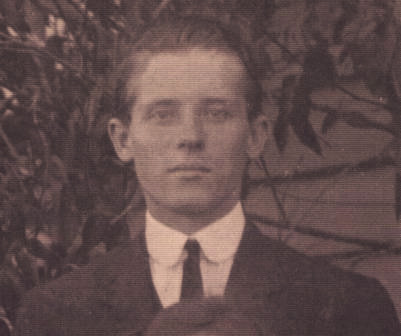 |
Frank Otterspoor - 1915, Brisbane |
Servanus (John) Otterspoor - 5 March 1916, Brisbane. |
 |
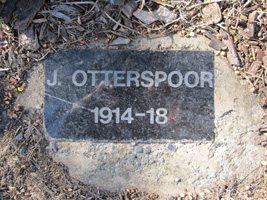 |
|---|---|
The old plaque for Francis Jacob Otterspoor |
Servanus (John) Otterspoor |
 |
 |
Australian War Memorial Roll of Honour - October 2018 (J Hawker) |
|
Arthur Robert French Oxford
.jpg) |
 |
Arthur Oxford's tree (#65) is a huge original weeping fig planted on the 26 July 1918. |
Arthur Oxford's plaque |
Arthur Robert French Oxford was born in Bournemouth, Hampshire, England, on 31 March 1882 to parents James Oxford and Elizabeth Oxford (née Harvey). The family migrated to Brisbane when Arthur was 18 months old. They departed London as "Bounty Immigrants" on 14 September 1883 aboard the Darra and arrived in Brisbane on 28 December that year. The family consisted of the father James (32), his wife Elizabeth (32), James John (7), Harriet Lucy (6), Herbert (4), Arthur (18 months) and the infant Lillian (perhaps his twin) who died on the voyage.
The family settled into Duke Street, Thompson Estate, Annerley and the children attended the nearby Junction Park State School.
Arthur joined the Moreton Bay Regiment (Queensland Militia) and trained with them for two years in "E" Company. He joined the 5th Queensland Imperial Bushmen (Reg. No. 192) and travelled to South Africa for the Boer War, departing March 1901 aboard the class steamer Templemore. He served with distinction. From April 1901 to March 1902 he was in east Transvaal, Free State and promoted to Sergeant on 1 July 1901. He was present at their defeat at Mokari Drift (27 September 1901), and Natal border campaign including stand at Onverwacht (4 January 1902) where 13 died and 17 wounded. Arthur was captured and released. He returned to Australia aboard the St Andrew in April 1902 where he then obtained work as a machinist and cooper.
In 1906 he married Ellen Jane Dyer and they had children Robert Dyer (1908) and Harold Alfred (1911). He also became involved with the Imperial Order of Rechabites, being Chief Ruler for a while, and attended the Methodist Church in Coorparoo.
Arthur joined the AIF in Brisbane on 23 September 1915 and was placed with the 5th Light Horse Regiment (15th Reinforcements). On 11 March 1916 he embarked HMAT Orsova, Sydney for Egypt. At Maadi Camp in Egypt, he was transferred to the 2nd Light Horse in April 1916 and then to the 2nd Regiment "Double Squadron". Finally, in February 1917 he joined the Reserve Company of the Imperial Camel Corps (ICC) and was attached to Brigade HQ as a Gas Instructor (3rd Anzac Bn, ICC). While on patrol in Tel Khuneilfe in Palestine (then in Turkey) on 6 November 1917 he was struck in the heart by gunshot and died.
Arthur was buried in a small consecrated "Camel Corps" section of the cemetery there by Chaplain C. Scott-Little and one of his friends placed a simple wooden cross on his grave. Arthur's body was later exhumed and buried in the Beersheba War Cemetery (now in Israel) - Plot C, Grave 42. His wife remarried on 14 December 1918 (to Robert Murphy) and she was granted a small pension to provide for the children.
His sisters and brothers-in-law inserted a notice in the Brisbane Courier 6 November 1920: OXFORD.-In sad but loving memory of our dear brother, Sgt. A. R. F. Oxford, killed in action at Palestine, 6th November, 1917.
lf the grave could only open, |
Arthur's nephew Harold Mitchell also from Annerley died while serving with the 47Bn in Belgium. He is memorialized with a plaque at Tree 86.
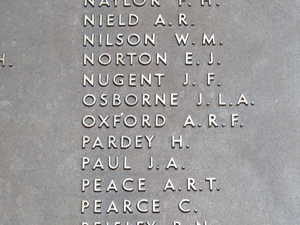 |
Australian War Memorial Roll of Honour October 2018 (J Hawker) |
Lt William Lumsden Packman
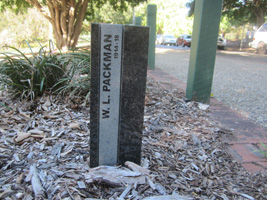 |
 |
Lt Packman - 4th Bde Artillery - died in France. |
Packman's tree (#8) was a flame tree but you can see it is no more - and hasn't been replaced. |
Of the 97 men from the Stevens Shire who died in the Great War and are commemorated in Honour Avenue, just four were officers. One such man was William Lumsden Packman. He was born in Falkirk near Glasgow on 31st January 1895 and attended Falkirk School and later Science & Arts School, Falkirk. His father - Thomas (b 1865) and he (William) migrated to Australia in 1911 to set up a business. His mother Ellen Packman (née Lumsden) - emigrated to Australia with their five other children (Peggy, Jim, Ella, Nell and Thomas) and arrived aboard the Orsova on 5th February 1912. Thomas Packman was co-owner with John Gilchrist of Gilchrist & Packman a joinery business at Camelon in Falkirk and had two of his sons William and James apprenticed to him. The younger children were enrolled at Yeronga State School (Ellen, aged 13, and Thomas, aged 10, in 1913).
On arriving in Brisbane Thomas began started up a carpentry business behind his home "Poolewe" in Crichton Street Yeerongpilly (near Yeronga School) with the boys still apprenticed to him. Thomas was also a Lay preacher at the Mowbraytown Presbyterian Church in East Brisbane and Superintendent of the Moorooka Congregational Sunday School near his home. Son William served part-time with 3rd Battery Australian Fortress Artillery (AFA) and served as an artilleryman in the Citizen Military Forces, Brisbane. On the 24 September 1915, William enlisted into the Australian Imperial Forces - at the age of 20 - to serve overseas with the artillery. The 2nd Division artillery had four brigades and William was posted to the 22nd (Howitzer) Brigade in the Divisional Artillery Column (DAC). At the time he was working as a carpenter with Richard Ashley, a builder and contractor of Douglas Street Yeronga, who organised a huge farewell for him on 3rd November where he presented William with a gold wristlet watch and a promise of employment upon his return.

Lt William Packman.
(Mowbraytown Research Action Group)
Later that month, William, now a Corporal, sailed with his brigade aboard A39 HMAT Port Macquarie from Melbourne to Egypt and his potential was soon recognised. He was made Sergeant of the 2nd DAC during the journey and the brigade landed in Suez in mid-December where it joined the 2nd Division and the more experienced men that had survived the Gallipoli campaign. He was made Sergeant in the 22nd Howitzer Brigade when it was newly formed on 10th March 1916 and was assigned to the 104th Battery. He was quickly promoted to Warrant Officer 2nd Class. At Alexandria, on 18th March the four brigades of the 2nd Division embarked for France to support the Australian war effort that had moved from Gallipoli to the Western Front. At this time his brother James had enlisted in the army back in Brisbane (3rd March) with the 21st Howitzer Battery in Australia.
The four brigades arrived at the port of Marseilles a week later, the brigades travelled 800 kilometres North by train to Le Havre where William was promoted to 2nd lieutenant of his brigade. They then continued by road hauling their 18-pounder guns to Armentieres, near the French-Belgium border, arriving on the 8th of April, 1916. William was transferred to the 19th Battery which also entailed a change of Brigade. He was now in the 4th Field Artillery Brigade and would stay with them until the end - just changing batteries (19th, 12th, DAC, HQ) as need be. He was attached to 4th Field Artillery Brigade HQ on 18th June while they were at Le Petit Mortier in the Somme. The brigade was about to become involved in the battle of the Somme. This offensive was partly designed to relieve the pressure on the French at Verdun. The brigade was deployed near Pozieres, in late July 1916, where they were involved in constant and bloody action against the German forces.
On August 1st, 1916, with the Australian casualty list spiralling, William was promoted to Lieutenant. He was with a group of three officers on the 8th August heading for an observation post when a German salvo of 5.9" shells caught landed next to them and were badly shaken. One officer was taken to hospital. In September William's brother James headed off from Australia to England aboard the troopship Mashobra with the 21st Howitzer Battery training in readiness to go to France. Aboard the ship with the 21st Howitzer Bty was Sgt Major Daniel McVey who would later become brother-in-law to James Packman by marriage to his eldest sister Margaret (Peggy) in 1919. Back in France, the brigade continued its crawl across French countryside: Bouzincourt, Senlis, Warloy, Vadencourt Wood.
On the 15th of November 1916, William was now with the 12th Battery. They were in the Delville Wood at Flers (Somme, France) and the brigade's gunners were laying down barrages all day and receiving enemy shells in return. At 1.15 pm three German shells landed nearby and the 12th Battery returned a salvo of 50 rounds. More shells landed nearby and Lt William Packman was struck and severely wounded. He was taken to a field ambulance near Montauban but died the same day from his wounds. Five other officers and 32 ORs in the brigade died that same month. William's gravesite is located at Bernafay Wood British Cemetery, six miles east of Albert, France. He was aged just 21yrs 1 month old. His death took place just three days before the official end of the battle of the Somme. Nature had prevailed on this occasion. The French winter of 1916 created such severe conditions that this battle concluded in a stalemate.
It wasn't until four months later that his brother James arrived in France where he suffered a severe cartiledge in his knee and was sent back to hospital in England and thence home in July 1917. Their father Thomas Packman wrote of his son William: "Being a member of the Highland Society of Brisbane and the first member to die for King and Country, a memorial was erected by his fellow members to his memory suitably inscribed and the motto Dìleas da-chèile (Loyal to both in Gaelic)". The Highland Society has since disbanded and the present whereabouts of this memorial is unknown. His other son James - now a returned war hero - was honoured at a reception in the Stephens Shire in January 1918.
William's personal effects were returned to his father and amongst them was the gold wristlet watch given to him on his departure from Australia in 1915. It returned home safely. A beautiful ornate honour roll was erected in the Mowbraytown Presbyterian Church in East Brisbane that is still in place at the church building today.
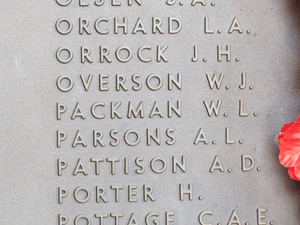 |
Australian War Memorial Roll of Honour October 2018 (J Hawker) |
Andrew Paxton
 |
 |
|
Pte Paxton - 25th Bn - died in Belgium. |
Plaque from 2012 |
.jpg) |
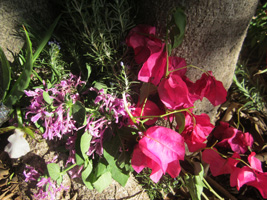 |
Tree 66 - a beautiful big shady original weeping fig. |
Flowers from Year 5 Students - 2014 |
Andrew Paxton was born on 18th May 1897 in Brisbane. His father James Nimmo Paxton was born in Scotland in 1864, and his mother Lydia Paxton (nee Grant) was born in Brisbane in 1873. They married in Brisbane in 1894 and had children: Margaret, Andrew, Walter, Violet, Henry, George and Bertha.
The family moved into a home Caldmore in Ipswich Road, Junction Park, Brisbane, and the children most likely attended the nearby Junction Park State School. Andrew became a hairdresser and continued to live at his parents' place. He enlisted in the army on 26th February 1916 and was placed with the 25th Battalion, 14th Reinforcements.
In July (31st), the Stephens Shire Soldiers' Entertainment and Help Society held a function at the Walker Memorial Hall at Annerley for returning and departing soldiers. Such functions were a regular occurrence and well attended by locals farewelling or honouring the hundreds of soldiers who lived in the area. Andrew was presented with a silver medal and praised for his contribution and given best wishes for a speedy return. A week later he embarked aboard HMAT Itonus A50 (8 August 1916) from Brisbane.
Andrew had an appendicitis attack while aboard the ship and was operated on by the ship's surgeon. A telegram was sent home to his father advising of the illness. Andrew was put off in Dakar in Senegal to recover at a French hospital there. After two weeks he was put aboard the next troopship HMAT Clan MacGillivray and made his way to England in late October 1916. His wound was inspected in London, drained, and he was allowed to rest for a while, followed by training. In May 1917 Andrew proceeded overseas to France and he joined his unit in mid-June.
The 25th Bn was the first AIF battalion to arrive in France. By now they were at Pozieres (as part of the 2nd Division) ready to take part in their first battle between 25th July and 7th August at Pozieres - in the course of which they suffered 785 casualties. After a spell in a quieter sector of the front in Belgium, the 2nd Division came south in October to attack again in the Somme Valley. The 25th Battalion took part in two attacks to the east of Flers, both of which floundered in the mud.
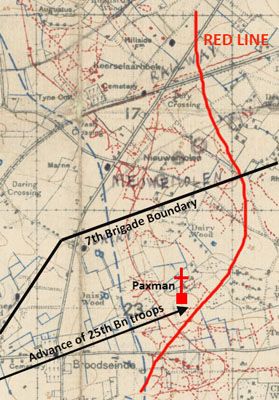 Next battle was at Bullecort. Although it acted in a supporting role at the second battle there, the 25th Battalion did not carry out a major offensive role again until 20th September 1917, when it was part of the 2nd Division's first wave at the battle of Menin Road in Belgium. The came the assault on German lines at Broodseinde Ridge in early October as follows (see map to the left).
Next battle was at Bullecort. Although it acted in a supporting role at the second battle there, the 25th Battalion did not carry out a major offensive role again until 20th September 1917, when it was part of the 2nd Division's first wave at the battle of Menin Road in Belgium. The came the assault on German lines at Broodseinde Ridge in early October as follows (see map to the left).
At the beginning of October the 25th Battalion was in bivouac in the Belgian Chateau at Ypres. They had to move forward to what was called Esplanade Saps (trenches) where they took over from the 28th Battalion. They moved into the lines on the 2nd October and prepared for the attack. At midnight on the 3rd/4th they were ready to go and at 4.30am the advance began. Andrew was a part of this advance which followed about 50 yards behind a rolling artillery barrage.
The 25th Battalion made it to the red line (see map) at 7.35am and began consolidating. Men were being struck down by shrapnel and machine gun fire as they advanced, but once at the red line they could dig in. Andrew was shot in the groin by gun fire - probably from a machine gun as he was advancing to the red line. I have marked a possible location with a red cross on the map opposite. He was taken away by stretcher bearers soon after and they had him off to the No. 44 Casualty Clearing Station at Poperinghe in Belgium right on the French border.
Mr and Mrs Paxton received a telegram that Andrew was seriously ill. Andrew didn't survive the injury and died in the CCS on the 7th October. He was buried in the hospital cemetery - The Nine Elms War Cemetery. On the 19th October a notice was published in Brisbane Courier that Andrew was seriously ill, but by this time he had died. The Casualty List No. 348 was published in Brisbane papers on 10th November 1917 finally listed him as having died on 7th October 1917. In the Broodseinde Ridge battle of 4-10th October 1917, the 25th Battalion lost 40 men killed, and 195 wounded.
In 1919, Andrew's aunt and uncle placed a memorial notice in the Brisbane Telegraph on the anniversary of his death - 7 October. It read:
| In our hearts your memory lingers; Sweetly tender, fond, and true; There is not a day, dear Andrew That we do not think of you. Inserted by his loving aunt Mary and Herbert Love. |
In 1920 Andrew's parent were asked what they wanted as an inscription on Andrew's headstone. Mrs Packman said she wanted an open Bible with the words:
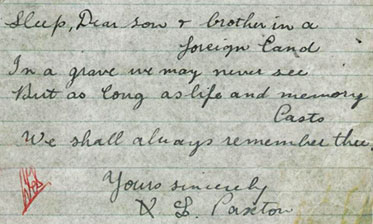 |
Mr and Mrs Paxton moved from Annerley to Tambourine Mountain, to the south of Brisbane, in the 1920s. James Paxton died in 1942 and was buried in the Mount Tambourine Cemetery. His wife Lydia died in 1953 and was buried alongside him.
 |
Australian War Memorial Roll of Honour October 2018 (J Hawker) |
Harry Pillinger
 |
|
Pillinger's Tree (#31) was a flame tree but died in Brisbane's climate and has never been replaced. Ornamental grasses (Dianella caerulea Lucia) have been used in their place. |
If you look back over the fence from where Pillinger's flame tree was, you can see the original Yeronga State School buildings. |
Harry Pillinger was born on 24 June 1895 at home in Tingalpa, Brisbane. His father Edward Pillinger was born in Berrow, Worcestershire, England in 1862 and arrived in Brisbane aboard SS Royal Dane on 16 January 1873 with his mother, four sisters and two brothers. His mother Sarah Ann Pillinger (nee McCullough) was born in 1865 in Ireland and arrived in Brisbane aboard SS Scottish Hero on 24 February 1883 with both parents, four brothers and two sisters.
Harry's parents married in 1885 and settled in to a home in Tingalpa then Mt Gravatt where Mr Pillinger established a farm and farm supplies business. They had children: Sarah, Isabelle, Annie, Alice, Harry and Alexander. By the time the children were school age the family had moved into 'Glenville' in Cracknell Road, Annerley where the children attended nearby Junction Park State School.
Harry became a bank clerk and worked for the Commonwealth Bank in the city. He had served in the Citizens Forces (9th Infantry) for two years, training at the drill hall at the corner of Dudley Street and Annerley Road, when he decided to enlist. On 5th November 1915 he joined the AIF (Reg. No. 10453) and was placed with the 6th Australian Field Ambulance (6th AFA) as a stretcher bearer.
The 6th AFA was a unit within the Australian Army Medical Corps (AAMC) of the 2nd Division AIF and wasn't attached to any particular brigade or battalion. However, the 2nd Division was comprised of the 5th Brigade (17 Bn, 18 Bn, 19 Bn and 20 Bn), the 6th Bde (21-24 Bns) and the 7th Bde (25-28 Bns). Hence, whereever these infantry battalions fought the 6th AFA was only a mile away ready to receive the wounded.
Harry and the 6th AFA travelled to Sydney and departed aboard SS Hawkes Bay on 20th April 1916. They arrived in Egypt and were quickly sent on to England for training, arriving at Salisbury Plains in early May. On 16 July (1916) the AFA was sent to France to begin their work with the 2nd (Anzac) Division. Harry was only allowed to take necessities so he left his kit in England. He did take a diary though. The camera, on which he had recorded (with permission) his passage through Gibraltar, was left behind.
On 11th August 1916 Harry joined up with the 6th AFA in the field . The 2nd Division was at Pozieres. The 'stunt' that ended on 6th August resulted in 6846 casualties and Harry came in at the end of it.
 After a brief rest the 2nd Division attacked again and sustaining another 1268 casualties. In early September the Field Ambulance was shelled daily and they were pleased to be withdrawn. They went from the Somme to Ypres (for rest) but were recalled to the Somme for the final stages of a British offensive. This time they joined the British Fourth Army who were holding a sector south of Pozieres near the village of Flers.
After a brief rest the 2nd Division attacked again and sustaining another 1268 casualties. In early September the Field Ambulance was shelled daily and they were pleased to be withdrawn. They went from the Somme to Ypres (for rest) but were recalled to the Somme for the final stages of a British offensive. This time they joined the British Fourth Army who were holding a sector south of Pozieres near the village of Flers.
The battlefield had been reduced to a slough of mud but the 2nd Division was required to mount a number of attacks, with the 7th Brigade attacking the German trenches on 5th November. Harry was placed with the C-Coy stretcher bearers. The Division's 6th AFA was incredibly busy. On that night they dealt with 366 wounded soldiers as bombs rained around them. The following day, 6th November, was much the same even though a part of the German trenches was captured and held.
On the 7th the soldiers of the 5th Brigade stormed the trenches German artillery saturated the British/Australian forward area with high explosive shells. They were landing right beside the stretcher bearers who were being sent out to recover the wounded. The bearers were working in teams of up to eight per stretcher as it was incredibly hard to carry a stretcher through the knee-deep mud. Instead of two or four men they were using six or eight.
Sgt Bob Robertson 3350 of the 6th AFA sent a team of six out from the 6th Ambulance station at Thistle Dump (see map) towards the German front to collect wounded men from McCormack's Dump. Amongst their number was Harry Pillinger. They had collected one soldier and were just making their way back to Thistle Dump when a HE shell landed beside them. Two 6th AFA bearers were killed on the spot (Harry Walters 1121, and Tom Thwaites 3226) and four were wounded (Harry Pillinger, Bill Mackalt 8446, Bill Platt 126 and Charles Callaghan 3318). Harry was severely wounded on his left thigh and buttock. Richard Herron 8372 called for help and more bearers came out to get them. Bearer Alf Eddy 9831 and Eric Rigby 1614 helped take him back to Thistle Dump for treatment. Eric Rigby knew Harry well; they were clerks together in the Commonwealth Bank.
Captain Wil Fenwick dressed the wounds and sent Harry on to the Advanced Dressing Station at Longueval. Harry died that day from haemorrhage. The OC of the 6th AFA reported in the War Diary for that day: "Everything going well. Two ambulance bearers killed. Five other bearers wounded."
Walters and Thwaites were buried at Thistle Dump Cemetery the next day. Harry was buried at Dartmoor Cemetery in the same grave as another 6th AFA bearer Harry McLean 8788 who had been killed elsewhere the same night.
Although the soldiers had taken the German lines, they were exhausted and a counter-attack from the Germans saw them ejected from their gains a few days later.
Caption for map above: Section of the map used by the 2nd Anzac Division AIF during the campaign at Pozieres in November 1916 (Map 57C SW3 1:10000, 3 Sept 1916). I have marked the location of McCormack's Dump and Thistle Dump and the likely route between them. Harry Pillinger was killed close to McCormack's. The German line (in red) is only approximate; it varied depending on the success of the attack or counter-attack.
 |
 |
The Commonwealth Bank Honour Roll (and close-up showing Pillinger's name) on the wall at its Head office at 161 Pitt Street Sydney. |
My thanks to Ross Proctor for corrections to the field map above. Ross is a distant relative of Thomas Thwaites and his half-brother William Percival Durant of the 6th FA.
 |
Australian War Memorial Roll of Honour October 2018 (J Hawker) |
The Reedman Brothers - Victor, Leslie and Ernie - of Fairfield
 |
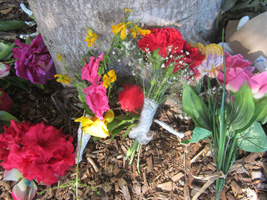 |
 |
Vic Reedman's Memorial - Tree 32 - A flame tree that is no more and has not been replaced. |
Flowers from Yeronga State School students near the Vic Reedman tree. |
Wilfred ("Leslie") Reedman - Tree 67 - a flame tree that died and has not been replaced. |
The Reedman family of Florence Street Fairfield (Brisbane) had six sons, three of whom went to war but only one returned. Leslie and Victor were killed by shell wounds in Belgium and France respectively, and Ernie was invalided back to Australia paralysed in one leg. Leslie and Victor are commemorated in Yeronga Memorial Park. The oldest of Alice and Arthur Reedman's sons was Wilfred Leslie Norman ("Leslie", b Sept 1895) and by the time he enlisted on 18 September 1915 he had spent two years with the Citizen's Military Forces while working as a cabinet maker for the furniture store Trittons in George Street Brisbane. He trained in Australia with the 3rd Training Battalion.
In December of that year (1915) the oldest son - Ernest Walter ("Ernie"), age 24 - also joined the army. Ernie was a labourer who worked at Dunwich on Stradbroke Island near Brisbane. He joined the 10th Reinforcements, 25th Battalion, and headed off to England in March the next year (1916). Leslie followed a month later. While aboard their ships their younger brother Victor Allan Claude had joined the army. Eighteen year old Victor was a draper's assistant who had served with school cadets for the past four years as well as six months with the Citizens Forces. Being so young he needed his parents' consent to join - which was given.
The two older brothers Leslie and Ernie both arrived in France in August and the youngest - Victor - departed Australia two months later (7 October 1916) aboard troopship A40 Ceramic with the 52nd Battalion. By this time Leslie was in France and had already had succumbed to trench fever (from lice in the trenches; not deadly but debilitating) and was back and forth to England. The youngest brother Victor meanwhile had arrived in France on the 2nd January 1917 and was sent to the battlefield of Flers (near the Somme). The Battle of the Somme was just over but for the remainder of the winter of 1916-17 the 9th Battalion garrisoned the line east of Flers. From there they kept pressure on the Germans by means of small attacks and raids. However, the main battle was against mud, rain and frost-bite. Bread could not be cut with a knife, hands were frozen numb within seconds if exposed, boiling tea quickly became ice, and German shells, no longer cushioned by the mud, exploded with more deadly effect.
On the 13th January 1917 the 9th Battalion were continuing to make progress with their trench digging despite the continued enemy shelling. The next day - the 14th January - Victor was removing overburden from the parapet in what was called Hay and Forage Avenue of the Flers trenches. This was difficult as there had been heavy snow and rain the night before and the ground was frozen. His party was caught in shellfire. Sadly, Victor was hit and he died of wounds instantly - after just 12 days at the front. Seven others were injured. Victor was buried in Bulls Road Cemetery at Flers. His parents were informed and Mrs Reedman wrote to the army on 1st February 1917 asking for details "as we have two other sons fighting in France". There is no record of an answer.
For the rest of 1917 the remaining sons Leslie and Ernie served in France. The oldest - Ernie - was taken sick again with trench fever in mid-year and was hospitalised in England. He had become friends with a young Irish woman Emma North Stewart and when he was given a fortnight's furlough upon discharge from hospital he travelled north to marry Emma. Ernie was then assigned to the 7th Light Trench Mortar Battery in France. Leslie meanwhile continued to serve in France and on the 20th October 1917 was sent to Broodeinde Ridge at Passchendaele (near Ypres) in Belgium as part of reinforcements following the hugely successful battle of Broodeinde Ridge two weeks earlier (where 9 VCs were awarded). Just two weeks later - on the 4th November a shell exploded in the trench Leslie was in and a fragment hit him in the head and rendered him severely wounded and unconscious. He was taken away to the Canadian Casualty Clearing Station but died the next day. He was buried in the Lijssenthoek Military Cemetery, the second largest war cemetery on the Western Front.
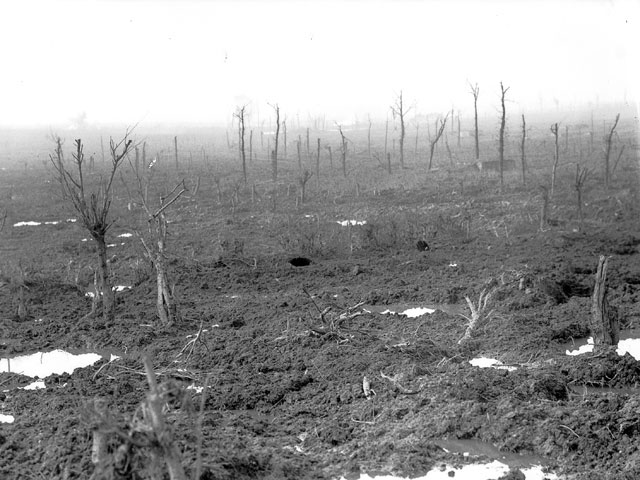 |
|---|
Photo of the Broodeinde Ridge battlefield on the exact day Leslie Reedman was killed - 4th November 1917 (AWM - e01147). |
Oldest Reedman brother Ernie continued fighting in France until the end of the war without further mishap. He returned to Australia in July 1919 followed by his emigrating wife and child. After the war Ernie worked for the Tramways Department like his father - and died in Brisbane in April 1945.
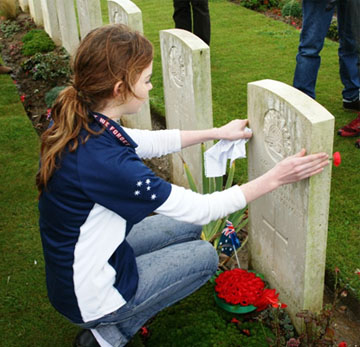 |
Student, Megan Mabin, in 2008, at the grave of her relative, 19 year old Victor Reedman, buried at Bulls Rd Cemetery, Flers. [Mike Goodwin] |
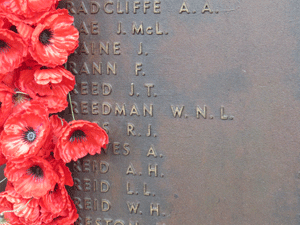 |
 |
Australian War Memorial Roll of Honour - October 2018 (J Hawker) |
|
William John 'Jack' Rigby of Yeronga
.jpg) |
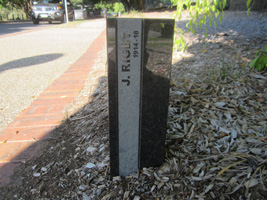 |
 |
Tree 1 - The first tree to be planted in Honour Avenue was Rigby's weeping fig. It didn't survive and has been replaced. The City Council takes cuttings from the original figs to propagate the new ones. |
Rigby's plaque. Mr and Mrs Rigby were present for the installation of the first plaque and planting on 15 September 1917. |
Yeronga students' flowers. Close to the school so Lieutenant Rigby gets lots of them. |
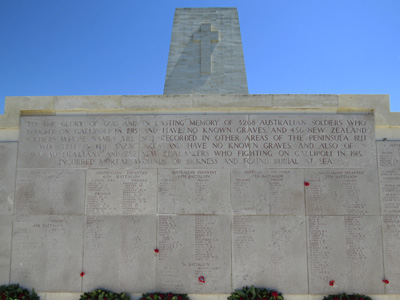 |
 |
| On Anzac Day 2013, the Secretary of Stephen's RSL - Jim Hawker - visited Gallipoli. He visited John Rigby's grave at Beach Cemetery to the southern end of Anzac Cove on 26th April and placed a poppy in the memorial. (Jim Hawker) | The cemetery was in use from 25 April 1915 and contains 285 Australians, 49 British, 21 New Zealanders, three soldiers from the Ceylon Tea Planters' contingent and 21 unknowns. This photo shows a close-up of the poppy beside John Rigby's name (bottom left). (Jim Hawker) |
William John (Jack) Rigby was born on 9 December 1891 in Brisbane to parents William and Julia Rigby. Jack's father William Alfred Rigby was born in Cheshire, England, in 1855 and migrated to Auckland, New Zealand, in about 1883. Here he met and married Jack's mother Julia Mitchell at Kaikohe near the pretty village of Rawene. Julia's father John Richardson Mitchell, had served with the British 58th Rutlandshire Regiment and took part in the 1845 battles against northern Maori. He was severely wounded in the campaign and wrote a lively diary of his experiences, which he shared with his younger brother. The "Old Captain" was a big influence in the Mitchell family, and the name 'Rawene' was important to the family. It was here in Rawene that children Julia Lyllis (1886) and Elizabeth Ethel (1887) were born. William, Julia and the two children migrated to Toowong, Australia, where William took up an appointment as manager of the South British Fire and Marine Insurance Company.
Son William John (Jack) Rigby was born at their residence of St Olaves at Yeronga. St Olaves was taken from the name of a church in Cheshire, England. The family purchased a huge parcel of land in the area - seemingly from Hyde Road to Yeronga Street - near the railway station, and only a few minutes walk from Yeronga Park. The St Olaves property was inundated in the great flood of 1893. While they built a home 'Rawene' in Shottery Street between Kadumba St and Days Road, the family rented a nearby house 'Wyetah' at 25 Belfast Street (built 1888). The new home in Shottery St was named Rawene (pronounced Ra-we-ne) in memory of their earlier days in New Zealand. It was a huge federation style house with wide verandahs. They had further sons George Henry (1894), Gordon Alexander (1898) and Hubert Stanley (1900). Jack was a student at Yeronga State School followed by just over two years at Brisbane Grammar School (1906 -1907) where he represented the school in Interstate Rugby. Jack was also in the school's 3rd cricket XI in 1906-07 - where he topped the batting averages and took 10 for 23 against Junction Park State School. The other children also were enrolled at Yeronga State School (George in 1900, Gordon in 1903, and Hubert in 1908). The boys all went to Brisbane Grammar and the girls to a school in Ann Street in the city, possible under the tutelage of a Miss Burduph.
Jack was enlisted in the Cadets for three years and Senior Cadets for one year. After school he obtained a job as a clerk with the South British Insurance Company in Brisbane where his father was the manager. Jack also volunteered for army duty with the Australian Garrison Artillery (3 years) and a further three years as a Lieutenant with the 9th Battalion Citizens Military Forces. His brother George was a student at Brisbane Grammar School from 1909 - 1911 and was then employed by Wills Gilchrist & Co. Ltd as a clerk.
 |
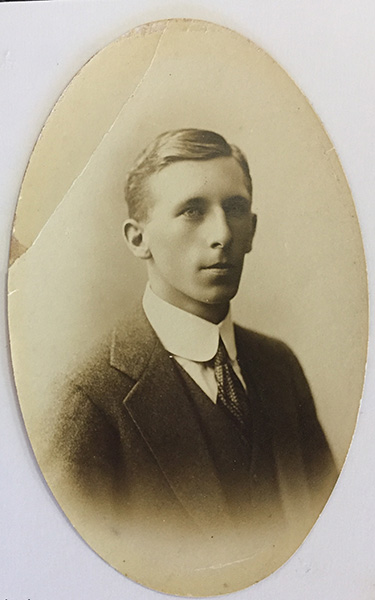 |
 |
| Jack Rigby 1914 (Noelene Blatch) | ||
On 15 August 1914 Jack enlisted in the AIF, and George 3 days later when Jack was made a Lieutenant. Many members of the Queensland militia (CMF) joined the army and were allocated to the 9th Battalion, the same battalion name as they served with. It was among the first infantry units raised for the AIF during the First World War just within weeks of its start. After preliminary training the advance party of the battalion - including Jack and his brother George - departed on 24th September 1914 aboard HMAT A5 Omrah and arrived in Alexandria on 5th December. There they joined the 3rd Brigade and began training in preparation for action somewhere in the Mediterranean. George was a Corporal in C-Coy but after restructuring of the Corps in Egypt, he was transferred to A-Coy. Brother Jack was 1st Lieutenant in B-Coy.
The battalion boarded HMTS Ionian on the 1st March 1915 and sailed the next day at noon. Sailing orders were opened by the OC of the ship. They were headed for the Greek island of Lemnos but the weather was terrible and the sea was very rough. Most of the men and officers were seasick. The ship reached the Lemnos at 7pm on 3rd March and docked in Mudros Harbour the next day. While at Mudros Harbour the 9th Battalion was quartered on board the SS Malda from 8 April through to 24 April. On the morning of the 24th April A and B Companies were transferred to HMS Scourge. This was to be the last time the brothers would see each other. During the next night A and B Companies transferred to the destroyer Queen. C and D Companies stayed aboard the Malda for their journey to Anzac. The ships took the soldiers two miles north of where the landing was planned. Instead of landing at Gaba Tepe - a beach with gentle slopes inland - they arrived at a beach with dauntingly high cliffs overlooked by Turkish soldiers. The 3rd Brigade was the covering force for the ANZAC landing. Famously, A & B Coys were the first ashore at Gallipoli at 4:28 am, 25th April. Jack (B-Coy) went ashore under sporadic fire from the Turkish soldiers. The second wave arrived aboard the Malda 30 minutes later to dismbark C and D Companies (including George) to suffer the same fate.
The 3rd Brigade consisted of four infantry battalions - the 9th, 10th, 11th and 12th Battalions - and they had all become mixed up in the confusion of the landing. The 9th Bn should have been on the right (the southern end). The Company Commander for B-Coy was Major Sydney Beresford Robertson. He led his men, including Jack Rigby in charge of a platoon, up Plugge's Plateau under withering fire from the Turks, and there they found themselves mixed up with men from the 11th Bn. They were ordered to advance to what was called Baby 700, a hill just to the east of a feature called The Nek. Here they were ordered to dig in, but they increasingly became exposed to Turkish fire and whenever they did try to advance further a hail of bullets tore into them.
Robertson, who had already been wounded "twice or thrice", was again shot and badly wounded as he raised himself above the scrub line yelling to Jack "Carry on, Rigby" (as recounted by Charles Bean). That he was wounded "twice or thrice" comes from Bean's account, which is of limited accuracy. Bean's remark about Robertson saying "Carry on, Rigby" is demonstrably untrue, thanks to Sergeant Coe's account [reference: Alan Tonks, see papers at end].
Jack Rigby continued on until he was killed, which was on the afternoon of that first day of the landings. Probably about 2:30 pm. Of the four officers who were photographed together aboard a ship on their way to Gallipoli (see earlier) three were dead, including Rigby and Robertson. Lt Frank Haymen was wounded in the morning but fought on, finally being killed at 3.30 pm that afternoon on '400 Plateau'. Lieutenant Lance Jones, also in that photograph, was badly wounded. After a few days of heavy fighting the remnants of the 9th Battalion gathered near the beach for rest and regrouping. According to the unit war diary, of around 1038 men who had made the landing, only 9 officers and 280 men remained fit enough to return to the front line on 30 April. The remainder had either been killed or were missing or wounded.
That day 25th April - Jack's brother George was wounded at about 4 pm by bullet in the calf of his left leg and a second bullet wound to his arm (according to a single hand-written line of a medical entry in his file). He was evacuated to hospital the next day (26th) and never fully recovered, being permanently disabled for life.
Lt Jack Rigby was one of the first Queenslanders to die in the war, certainly the first from the Stephens Shire, and occupies the No. 1 position in the Honour Avenue row of trees. Of the members of Jack's 3rd cricket XI from Brisbane Grammar School, nine served in WW1, five served at Gallipoli and four landed on 25th April with Jack.
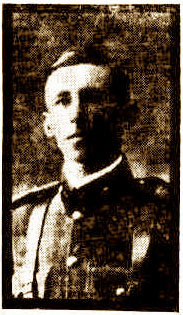 |
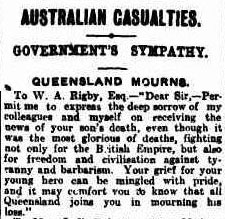 |
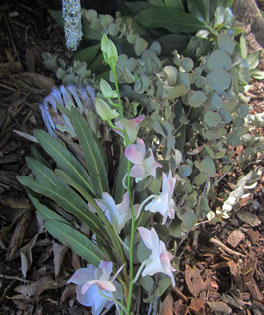 |
Lt William "Jack" Rigby |
Letter from the Governor of Queensland to Mr William Rigby. Brisbane Courier 10 May 1915 |
Flowers placed around the base of the Rigby tree by Yeronga State School students on 24 April 2014. |
His brother George embarked on HMAT A44 Vestralia at Suez on 18 October 1916 and returned to Australia crippled and discharged from the AIF in Brisbane on 27 December 1916. The third son, Gordon Alexander, had to wait until October 1916 to be old enough to enlist. He too had attended Brisbane Grammar School (1912-1914) and was employed as a clerk with Queensland Trustees Ltd. He joined the 1st Field Artillery Brigade as a Gunner and served in France and Belgium with the 101st Howitzer Battery until the armistice and returned to Australia in June 1919. Their 4th son Hubert (b 1900) was too young to join.
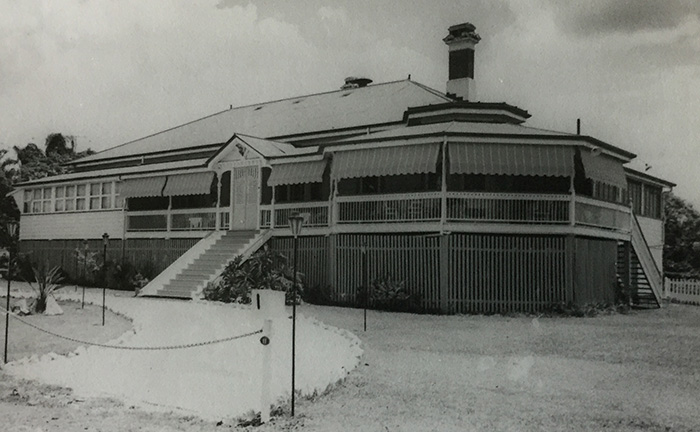 |
| Rawene I (Nolene Blatch) |
Despite the contribution already made by the Rigby sons, their eldest sister Julia Lyllis Rigby became a staff nurse and departed for military service in India on the 2nd June 1917. She was farewelled by a party of 80 people at the Yeronga Hall and headed for the Colaba War Hospital in Bombay. Here she tended to the injured from the Mesopotamian conflict - mainly around Basra (now southern Iraq) where the British and Turkish soldiers were fighting. She reluctantly resigned in July 1918 when she became married. Jack Rigby's mother Julia planted the very first tree in Honour avenue in memory of her son on 15th September 1917. His tree was Number 1, right against the Park Road gates - a weeping fig. Julia's husband (Jack's father) William Alfred died of throat cancer on 8 May 1822 aged 67. Julia decided Rawene was too big for her so she subdivided the block and built a new smaller home ('Rawene II') on the northern end of the block where the tennis court was. This was on the corner of Kadumba and Shottery Streets. The original house - Rawene I - was left to Lyliss but she later sold it. It became the 'Golden Pyramid' reception lounge but was destroyed in the 1973 mini-tornado that hit Yeronga.
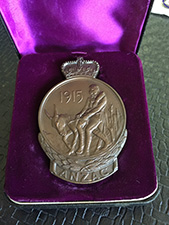 |
 |
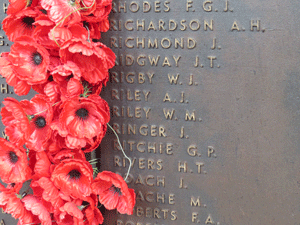 |
| Jack's Anzac medal (Noelene Blatch) | Australian War Memorial Roll of Honour October 2018 (J Hawker) |
|
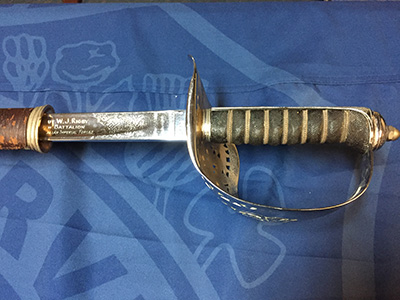 |
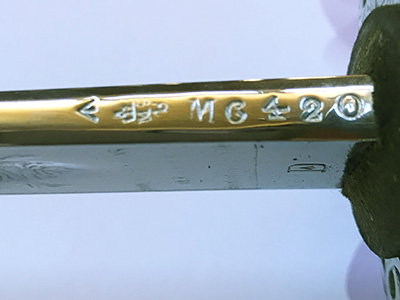 |
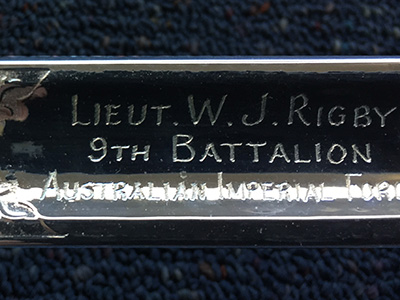 |
| Sword, Infantry Officer, Pattern 1897 made by Robert Mole in Birmingham in 1915 | Edge of blade - Serial No. MG420 | Engraving - perhaps done later back in Australia |
My thanks to Alan Tonks and Noelene Blatch (grand-daughter of Jack's brother George) for additional details.
"Carry on, Rigby" - papers by Alan Tonks.
Alan Tonks has researched Jack Rigby's history in detail and I am pleased to be able to share these with you.
Please click on the link below each of the three documents to get a pdf download.
 |
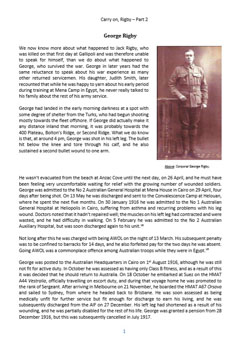 |
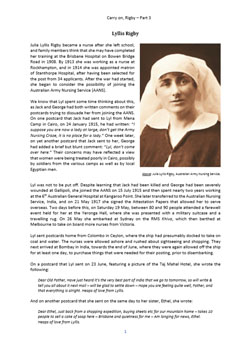 |
| Carry on, Rigby - Part 2 | Carry on, Rigby - Part 3 |
Llewellyn Robson
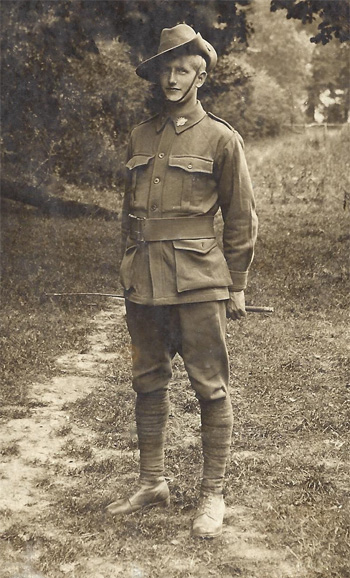 |
| Llew Robson photographed at the village of Shipton in the district of Hambleton in north Yorkshire, on the 12th of August 1916 before he was transferred to Grantham for machine gun training. |
Llewelyn 'Llew' Robson was born on 10th August 1891 in the village of Derwenlas Isygarreg (pop. 400) in county Montgomeryshire (now Powys) in Wales. His father Thomas Robson Robson (b 4 Feb 1850) married Mary Robertson Bains (b 1 August 1854) on 27 December 1881 in Durham, England. Mary was a school teacher and Thomas was a solicitor's clerk. They had three other children besides Llew: Helen Bains, Thomas Robson Robson (Jnr), and Lillian.
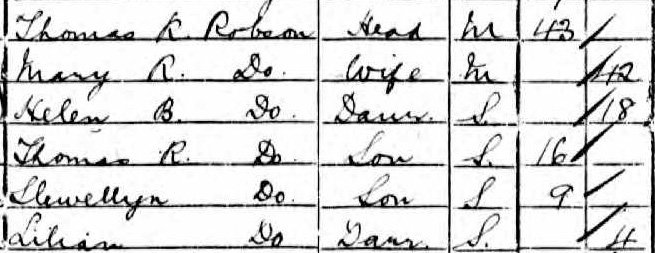 |
Robson family entry in the 1901 England Census. Llew was 9 years old. |
The family moved from Durham to Wales in the early 1890s but spent most of their time living in England and by 1901 had moved to London where Llew attended St Mark's College, Chelsea. Thomas Robson Robson (Jnr) trained as a toolmaker but went to sea, serving as 3rd engineer on vessels sailing between Europe and South America. When his sister, Helen, contracted pulmonary consumption (tuberculosis) in 1909, he urged the family to migrate to Australia as moving to a warm climate was apparently the only medical advice then given for this ailment. The two brothers worked their passages to Australia and jumped ship on arrival in Brisbane. Thomas subsequently nominated both of his parents and his sisters to travel to Australia, precipitating a family split with his mother and sisters departing Liverpool on the SS Dorset (17 Feb 1912) and his father electing to remain in England. Interestingly, the parents' ages were significantly understated in the nomination record, presumably to take advantage of, or circumvent, a regulation. Unfortunately, (particularly for Helen), this voyage from Liverpool to Brisbane was described by the ship's Captain as being, 'altogether the worst for bad weather that he had ever experienced', with the ship suffering structural damage and being forced to hove-to four times. Even worse, Lilian contracted the disease during the voyage, leading to her death in 1913, followed by Helen's in 1914.
Llew worked as a milkman before enlisting in the army in December 1915. He was placed with the 7th Machine Gun Company. The 7th MG-Coy was a unit in the 7th Infantry Brigade, made up of men from the battalions of that brigade, namely the 25th, 26th, 27th and 28th).
The Company departed Sydney aboard HMAT Honorata A20 in May 1916 and when they arrived in England were sent to Grantham for training. In September Llew was sent to France and eventually taken on strength with his unit on 12th November 1916.
The 7 MG-Coy was at Montauban Brigade camp when Llew arrived. They were reorganising and cleaning their gear, resting and drying their clothes. A few days later they were 6km north in the front line at Flers relieving the 5th MG-Coy. It was here that Llew received the devastating news that his mother Mary had died on the 3rd of January 1917.
Back in France, it was the same for most of the first half of 1917: the Brigade found itself in supporting roles. In May 1917 at the second battle of Bullecourt, they penetrated the German line but met determined opposition. From June to September the Brigade, and hence the 7th MG-Coy, did relief work, fatigues, training and practice. Llew was granted leave in the UK from 9th to 22nd September 1917 so missed a major operation at Ypres that finished on the 21st.
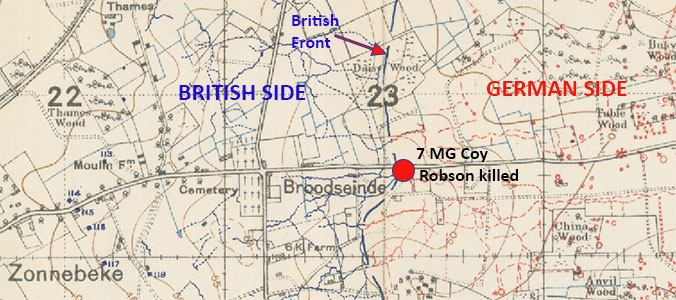 |
Trench map used during the Battle of Broodseinde Ridge (blue is British, red is German). The 7 MG-Coy is shown by the blue dot I've added. It was at D23.d.1.6. Lew is likely to have been wounded here on the morning of the 11th as these were the only guns of the 7th MG-Coy in action after 9.45 am on the 10th when the rest were withdrawn. |
Nevertheless, he was back for The Battle of Broodseinde Ridge (a part of the Third Battle of Ypres) beginning on 4th October 1917. Its aim was to capture the ridge or higher ground at Zonnebeke that overlooked Ypres. The 7th MG-Coy was to be relieved on the 10th October but they were asked to join the 6th Brigade in the front line. Two guns and crews were attached to the 24th Battalion in their position as shown on the map at D23.d.1.6. It was around here that Llew was struck by a shell and severely wounded. He suffered gunshot wounds to his eye, left thigh and right abdomen and was taken to the No. 44 Casualty Clearing Station at Nine Elms close to Poperinghe.
On 13th October 1917 Llew died of his wounds and was buried the same day at Nine Elms. Church of England chaplain Rev. L. T. Pearson officiated (see map).
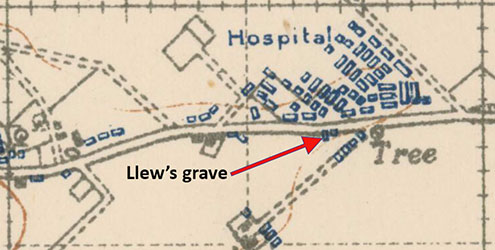 |
Location of Llew's grave as shown on an original trench map from 1917 (Poperinge 27, L10.b.33.45). The hospital is the Nine Elms. |
In Brisbane, after enlisting and being discharged medically unfit, (intending to join his brother in France after the death of their mother), the only surviving sibling Thomas Robson Robson (Jnr) married (Annie West) and had a son Llew, named in honour of his beloved brother. Thomas by now had lost contact with his father. The army sent Llew's medals to his brother, rather than to his 'lost' father.

Tree 68 - A flame tree
was planted here
but died and has not been replaced.
Ornamental grasses look nice.
As well as a memorial plaque and tree being planted in Yeronga's Honour Avenue in Llew's honour, a memorial plaque was also placed in the Anzac Park War Memorial at Glen Innes (NSW). The connection is not clear. This is intriguing and makes one wonder whether perhaps a returned battlefield mate arranged it. Thomas (Snr) died in Fulham, London, on 26 April 1931. Thomas (Jnr) died on 31 July 1947.
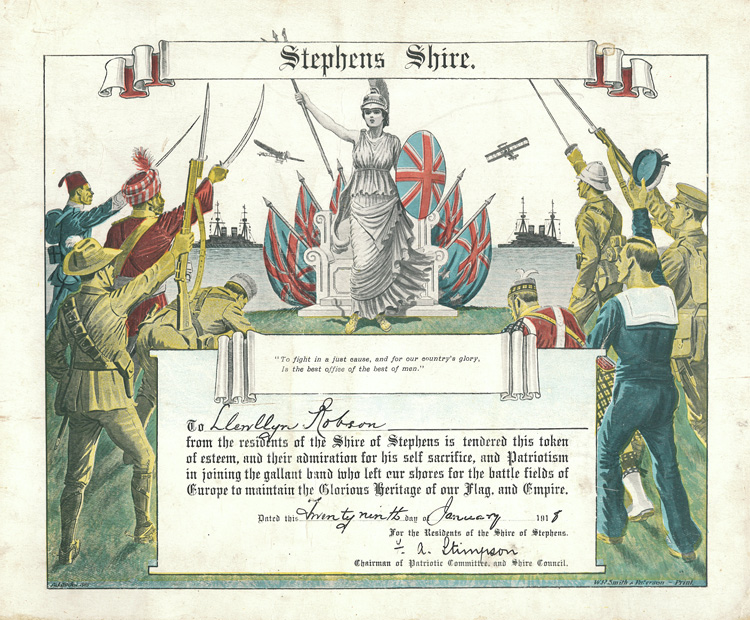 |
Memorial Certificate presented to the family of Llewellyn Robson by the Stephens Shire in 1918 |
My thanks to Graham (Llewellyn) Robson, great nephew of Llewellyn Robson, for additional information.
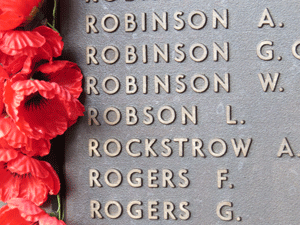 |
Australian War Memorial Roll of Honour October 2018 (J Hawker) |
Charles David (Chas.) Ruff
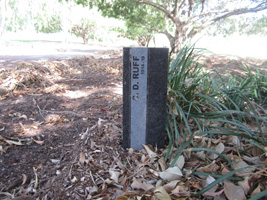 |
.jpg) |
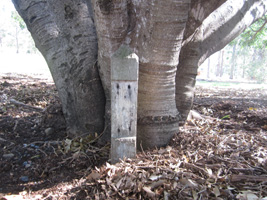 |
Plaque from 2012. Note the Dianella caerulea Lucia ornamental grass being used. |
Tree 69 - a huge weeping fig remains from 1918. |
The original post for the Charles Ruff plaque is one of the two remaining posts left. The other one is for Stanley Nalder (#61) |
Charles David Ruff was born on 12th August 1891 at his parents' home at Mt Gravatt, off Ipswich Road, in Brisbane. He was one of six children. His father Charles Henry Ruff, a carpenter, was born in Brisbane in 1858 and married, in 1887, Jane Jamieson, born in 1858 in Falkirk Scotland. He had an older brother John Henry "Harry" (b 1888) and a younger sister Jessie Jane (b 1893).
Charles received his early education at Douglas-Gomoron State School near Toowoomba, before attending Mt Gravatt State School. Following that, Charles and brother Harry attended Smith-Premier & Kerr's Business College where they studied to become clerks.
Charles graduated from the College in 1909 and took employment as a clerk with Howard Smith and Co Ltd, a major shipping company operating out of Melbourne but with offices in Brisbane. In 1910 he visited the Head Office (by ship, naturally) possibly with the prospect of promotion.
Charles was a keen artist and also excelled in sports: he was a 100 yard sprint champion, and played football with the Coorparoo Football Club, also being Honorary Secretary.
On the 14th January 1916 Charles enlisted (5400) in the army at the age of 24. A month later his brother Harry also enlisted (5401). Given that their Regimental Numbers are sequential, is is likely that they both enlisted on the same day. They were both placed with the 25th Battalion, 14th Reinforcements and began training at Enoggera in March.
Also, on the 28th July 1916, Charles married 22-year-old Edith Elizabeth Belford from Toowoomba at the St John's Presbyterian Church in King St Annerley. They set up home in Lewis St, nearby in Wooloongabba. The following month both brothers departed from Brisbane for England aboard HMAT Itonus (8 August), and after some training in England departed in December 1916 for France.
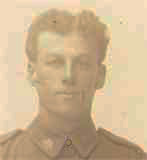 On 10th January 1917 they joined the 25th Battalion at Bernafray in northern France (about 10 km east of Albert and 2 kilometres south of Longueval). For the next three months the 25th Battalion relieved other battalions in the front line - such as at Deville Wood, Fricourt, Le Sars and Noreuil. It was here at Norueil in April that the battalion was relieving the 22nd Battalion when, on the 22nd, they were heavily bombed with gas shells and Charles was wounded.
On 10th January 1917 they joined the 25th Battalion at Bernafray in northern France (about 10 km east of Albert and 2 kilometres south of Longueval). For the next three months the 25th Battalion relieved other battalions in the front line - such as at Deville Wood, Fricourt, Le Sars and Noreuil. It was here at Norueil in April that the battalion was relieving the 22nd Battalion when, on the 22nd, they were heavily bombed with gas shells and Charles was wounded.
He suffered a shell wound to the left arm and was taken to hospital in London where he stayed for two months. His parents were notified by telegram and a notice appeared in the Queensland newspapers several weeks later. Following this, Charles had some 'disability' furlough in London followed by time at the training base at Deverill, Wiltshire.
In mid-November 1917 Charles returned to France to rejoin his unit at Steenvoorde in Belgium on the border with France. They were in billets there but soon moved to other billets in Neuve Eglise nearby in Belgium. It was here that his photo was taken as a member of the football team of the 25th Battalion.
 |
Group portrait of the 25 Battalion Football Team taken on 27 November 1917 at Neuve Eglise, France. Charles Ruff is in the back row, far left. The officer is Lieutenant Colonel William McIntyre Davis. AWM EO1348 |
Charles also found out that his brother Harry had been gassed just 17 days earlier. Harry was back in England at a war hospital in Carlisle, England. From Neuve Eglise the 25th Battalion prepared for the Spring Offensive (on April 18th). Following this Charles undertook relieving work (cable burying and trench digging) and by early June 1918 was about to fight a major battle at Morlancourt. This was known as Third Morlancourt, an attack carried out on 10 June 1918 by 7th Brigade of the 2nd Australian Division against the southern portion of the Morlancourt spur which overlooked the village of Sailly-Laurette on the Somme. The objective was to capture the enemy lines between Morlancourt and Sailly-Laurette (see map).
At 9.15pm the attack was launched under cover of an accurate artillery barrage. The first wave of troops consisted of A-Coy who were to take the middle section of the trenches, with the D-Coy on the left and C-Coy on the right. The troops kept 75 yards behind the rolling barrage and once they had advanced 125 yards, the second wave (B-Coy) began to advance.
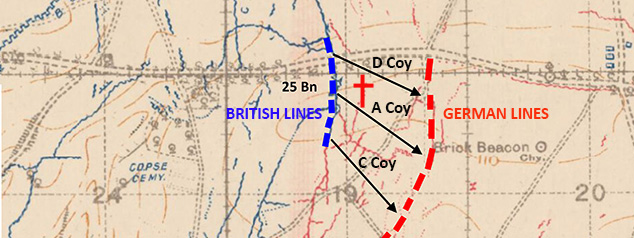 |
Section of trench map 62D NE (1:20000) Edition 2E (trenches correct to 28 May 1918). The map was updated just two weeks before Charles was killed. I have marked a probable location of his death with a red cross. |
The shelling was intense on both sides and when Charles was in No Man's Land he was struck and killed. It is not known if it was from a bullet or a shell but he died where he fell. The operation was considered a complete success and resulted in the taking of 325 German prisoners at a cost of 400 Australian casualties. Stretcher bearers recovered Charles's body and he was buried in Beacon Cemetery, Sailly-Laurette, France.
Charles's brother Harry had been released from hospital in England in June 1918 but was given two weeks' furlough in England. It wouldn't have been long before he heard of Charles's death. Harry stayed on in England training until September 1918 and was then sent back to Australia.
Charles's mother Mrs Jane Ruff died at her home in Beatrice Street Coorparoo on 10th June 1919. Mr Ruff died in 1932 and Harry in 1954. Charles's wife Edith moved to Sydney and died in 1978.
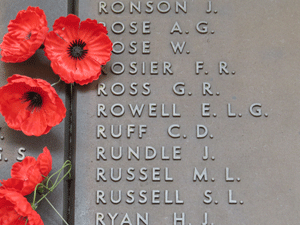 |
Australian War Memorial Roll of Honour October 2018 (J Hawker) |
Olley Carl Rush
 |
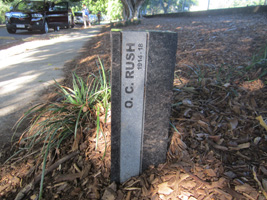 |
The replacement plaque served well from 1993 to 2012 when it was replaced with the one to the right. |
Pte Olley Rush - 12th Machine Gun Coy - died in France. His best mate Bazil Colefax is also remembered directly opposite him in Honour Avenue (Tree 6). |
.jpg) |
 |
Olley's mother Emily, father Edwin, and his sister Vera were present on 15 September 1917 for the planting of Tree 5 - now a big old weeping fig that has survived for nearly a century. |
Flowers from Anzac Day 2014 at Olley Rush's tree. |
Olley Carl Rush was born in 1984 at Moss Vale, New South Wales, to father Edwin Sibon Rush and Emily Jane Trindall Rush (née Simpson). He had 10 brothers and sisters: Emily (b1886), Muriel, Edwin, William, Olley, Ernest, Vera Ivy, Reginald, Alfred, Laurel and Amy (b1905). The family lived at Braemar about 18km north of Moss Vale (130km SW of Sydney).
Olley's family shifted to Hyde Road, Yeronga. He became good friends with Bazil Colefax as they were in the same athletic club - the East Brisbane Harriers. The Harriers would compete in various carnivals but the main one was the Queensland Amateur Athletics Association annual carnival. Both Olley and Bazil competed with distinction. Olley was a railway porter, Bazil a labourer.
On 12 August 1915 Olley enlisted in the army in Brisbane (3834). He was placed with the 12th Reinforcements, 15th Battalion. As a matter of interest Bazil Colefax enlisted two days later (Reg. No. 3714, 14 August) and they were both in the same batallion. The other runner from their club to enlist was Charles Cantrell (3311) but he went to the 19th Bn. The Chairman of the East Brisbane Harriers was forced to close the athletics season early as three of his top runners were off to the war. In September the Club had a farewell evening for the three soldiers and presented them each with a 'wristlet watch'. By this stage Olley's sister, 19-year-old Vera Ivy Rush, became a close friend of Bazil and they were married on 6th November. It was a rush as Bazil was about to head off to war (in just over 2 weeks in fact).
Olley and Bazil took a train to Sydney and embarked aboard HMAT Suffolk on 23 November 1915 for the Middle East. Upon arrival at the Tel-el-Kebir Training Camp (100km N or Cairo) he joined with the 15th Battalion and was then immediately transferred to the newly-formed 47th Battalion (as was Bazil) but Olley was put with the 12th Machine Gun Company (12 MG-Coy). After three months training, the 47th were off to France (2 June 1916) aboard HMT Caledonia along with 27 Officers and 980 ORs (including Bazil Colefax). They arrived Marseilles on 11 June ready to head north to the Western Front.
The army knew that Olley Rush was a good athlete so one of his jobs was to become a runner, taking food up the communications trenches to the men at the front line. He was also on the Lewis Gun. On the morning of 6th August, about 5am, Olley was in the Black Watch trench, in the second line of defences, with Frank Rose (762) and Fred Sommerfeld (3859). He had just finished a watch on the Lewis Gun and was resting in their dug-out. Frank Rose went off to get them some Bully Beef when a German 9.2 inch shell struck nearby and buried Olley. He was killed by the concussion, as was Rose. Sommerfeld was wounded. They were dug out by Ernie Radford (3883) and Gustav Berg (2458).
Of the three athletes from the East Brisbane Harriers, Olley Rush was now dead, Bazil Colefax was dead three days later (9th August - about a mile south), and Charles Frederick Cantrell (3311, 49th Bn) would last four more weeks when he was shot in the head on 4th September while crossing No-Man's Land at Moquet Farm on the Somme. Ernie Radford, who helped dig Olley out of the trench, was killed three weeks later (26th September). Gustav Berg survived the war.
Olley Rush and Fred Rose were buried the next morning by his mates about 50 yards from the gun. But Olley's exact grave was not marked. It was unconsecrated ground but was marked by a simple wooden cross. It was a choice of Grave 10 or 11 in the cemetery where all of the 12MG Coy were buried. The army recovered a wristlet watch from the body in Grave 10 and sent it to Vera for identification, which she did.
Mr Rush received a letter from Olley's commander from the 15Bn. Major Frederick B. Hinton wrote: "your son was untiring, cheerful, and energetic man - capable, and with a good knowledge of his work, and as a man he was always a gentleman in character and bearing. He always bore himself as a gentleman, and his private life was clean and wholesome". A mate, William J. Barnes wrote "We ourselves feel the loss deeply, as he was a good pal, and was highly thought of in the company".
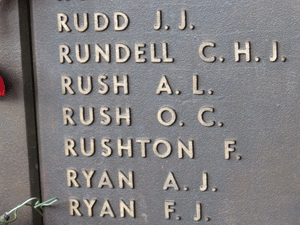 |
Australian War Memorial Roll of Honour October 2018 (J Hawker) |
George Charles Seabrook
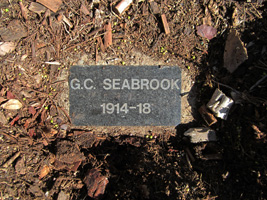 |
 |
|---|---|
This plaque from 1993 remains in the ground near the Cenotaph. |
Seabrook's plaque for 1993 beside the palm tree near the Cenotaph. It should be removed. |
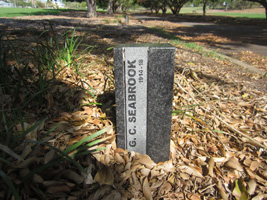 |
.jpg) |
The new plague in the original position. |
Tree 70 - a big old weeping fig from July 1918. |
George Charles Seabrook was born in Leyton, London on 15th July 1890 to parents James Charles Seabrook and Annie Seabrook (nee McPherson). He was one of eight children and emigrated to Australia in 1910 at the age of 20. George worked as a bread carter in Brisbane and on 22 March 1916 married Elizabeth Mary Johnson (who sometimes called herself Dorothy or "Dollie"). They lived at Blackburn Street, Moorooka, and in July that year had their first child James Charles Seabrook.
A year later, on 27 June 1917, George enlisted in the AIF and was placed with the 10th Reinforcements, 49th Battalion. When he departed Australia for England on 1st August 1917 he may, or may not, have known that his wife was carrying their second child. Nevertheless, he departed Sydney aboard HMAT A7 Medic and took the roundabout route to Halifax, Nova Scotia, where he was transferred to SS Orissa for the final leg to Liverpool, England. He was sent for training at Codford but developed bronchitis which delayed his departure for France.
With the collapse of Russia in October 1917, a major German offensive on the Western Front was expected in early 1918. And so George was about to step into this. He proceeded overseas on 30 January 1918 and joined his 49th Battalion on the 17th March in the Locre Sector on the France-Belgium border. He was completely unaware that his wife Dollie (Elizabeth) had delivered a baby girl - named Dorothy - and that he was a father for the second time. He also didn't know that she was desparately sick in hospital and that the baby was not well. He was not aware that their son James Charles - now 2 years old - was in care. For the rest of March he was in training and moving from one town to the next. On 23rd March they celebrated a belated Christmas with a sumptuous meal and games. He wrote to his mother saying he didn't like it much. She seemed surprised as he was always full of fun - dancing and singing and playing games.
The 4th Division (which included the 49th Battalion) moved to defend positions around the Dernancourt on the River Ancre. A large German attack was predicted on 5th April, and the 49th were to be a part of a critical counter-attack late in the afternoon. At noon all companies of the 49th Battalion had moved into position.
Zero hour was 5.15pm and right on time the 49th moved forward in artillery formation to occupy the ridge. The barrage successfully dislodged the enemy with the exception of three of their machine guns. From then until 5.30pm enfilading fire from German machine guns in the vicinity of the Casualty Clearing Station (approximately E10 on the map) was severe. George was lying prone taking cover from the German machine guns when he was struck by a bullet in the head. He didn't even move; he was killed instantly. His mates in the Company - George Wilson (969) and Henry Brooks (4988) were beside him when he died. It was 5th April 1918. George was buried almost where he fell - in a makeshift cemetery on the road from Buire to Amiens (D17.b.5.8). Sergeant John Duncan (1813) helped bury him but said "things were so hot we couldn't mark the grave" [Red Cross File].
A week later (13 April 1918), one of his closest mates, Fred Hansen, from the same Company, and from Moorooka, wrote to Georges's wife "Dollie" (Elizabeth) saying how her husband died and where he was buried. However, Dollie didn't get the letter; she was in hospital sick from complications with her pregnancy and birth. Her baby daughter Dorothy Seabrook was born on 7th March but things were not going well for mother or child. The doctors at the hospital thought it wise that she not be told of her husband's death until she had recovered. Three weeks later (9th May) a Casualty List appeared in the Brisbane Courier carrying the name of George Charles Seabrook, killed in action, 5/4/18. This also was kept from her. Baby Dorothy died on 3rd June 1918. Fred wrote to Charles' mother (19 June 1918) pasing on Dollie's love. Sometime after this Dollie was told of her husband's death.
In England, by 11 July 1918, George's mother was beside herself worrying about him. She had been informed that he had been killed but that no grave had been found. She took this to mean he could be alive and was anguished about her son, and her daughter in law in Brisbane. She knew Dollie was still sick but didn't know that baby Dorothy had died and believed that the two children were in care. She wrote to the Red Cross wondering if she could go to Australia to bring the family home. Dottie finally wrote to George's mother in England in February 1919 but said that she had nothing from the Army since Xmas 1918.
In 1920, George Seabrook's remains were exhumed and reburied on consecrated ground at Dernacourt Communal Cemetery, 2 miles SW of Albert. His wife was informed. Elizabeth Seabrook married Wilhelm Carl Kratzmann in 1924 and they raised their son James along with another seven children including Stella, Joan and Jack.
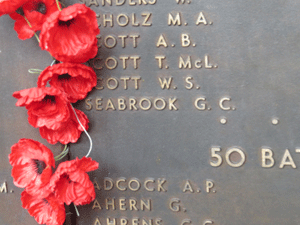 |
Australian War Memorial Roll of Honour October 2018 (J Hawker) |
Roy William Sheppard
 |
 |
Yeronga students' bouquets |
Plaque beside tree 33 - weeping fig |
.jpg) |
 |
Tree 33 - a big original weeping fig |
Close to the school so gets lots of flowers on Anzac Day. |
Roy William Sheppard was born in Maclean, on the north coast of New South Wales, in July 1895. His parents John Thomas Sheppard and Elizabeth Mackay (b 1868) had married in Kempsey NSW in 1890 and had another son Arthur in 1897.
Mrs Sheppard separated from husband John in 1900 and shifted to Brisbane. Here she married Boer War veteran Charles Luxton (b 1877) and resided at Junction Terrace, Annerley.
Roy worked as a railway porter, and brother Albert as a dairyman. On 20th August 1914 at the age of 19, Roy joined the army in Brisbane and was destined to train as a gunner with the Brigade Ammunition Column. To keep his parents in the dark he listed his 32 year-old step-sister Violet Luxton from South Brisbane as next-of-kin. His parents found out and saw that he was immediately discharged (being underage he needed their permission). He tried again a year later but this time both brothers enlisted. On 21 July 1915 Roy and Albert visited Enoggera Barracks and signed up: Albert was given number 1561 and placed with the 9th Bn (11 Reinforcements), and Roy was given No. 1562 and placed with 31st Bn (1st Reinforcements).
On 9th November 1915 Roy departed Brisbane aboard HMAT Wandilla bound for the Middle East. Albert was training in Sydney and ready to go but was told the Brigade was overstrength and that he wouldn't be leaving quite yet and was placed with the Reserve Coy. Albert was despondent that his brother had left so he (Albert) absented himself from the Broadmeadows Camp. He hadn't reported for duty by the following February (1916) so was struck off strength as a deserter.
Roy arrived in Suez in December 1915 to be taken on strength with the 31st Battalion (A-Coy) and after several months training was off to France arriving in late June 1916. By the 11th July the 31st Battalion was at Bois-Grenier near Armentieres on the Belgian border. The 8th Brigade was preparing for a major assault on German lines on the 19th July. As they waited in billets at Fleubaix they were nevertheless shelled by the Germans. Many casualties were recorded even before the attack. At 5.58pm on the 19th, the first of four waves of troops from the 31st Bn climbed over the parapets and were off across No Man's Land. When they had advanced 30 yards (6 pm exactly) it was the second wave's turn to go. Roy was in A-Coy and these companies were in the first and second waves. Roy was in No Man's Land dodging bullets and shells.
The shelling was horrific as the men jumped from shell hole to shell hole as they crossed between the lines. Nevertheless, they made it and entered the German front line trench and dealt with any enemy encountered. Then they continued towards the second line but all they could find were water-filled ditches so getting protection from enemy fire was difficult. There were not enough shovels and sandbags to use. After several hours the Germans began a counterattack and the Australian line was broken. It was now about 2am on the morning of the 20th. A high explosive German shell landed next to Roy and he was struck by fragments. One struck him in the head and pierced his eye. He also received severe wounds to his leg and arms.
Men started to withdraw from the German lines at the flanks and this created panic amongst the others. Company sergeants had to keep many men in position at the point of a revolver. The situation had become hopeless as the Germans advanced and the order to withdraw was given. It was 5.45am on the 20th. Roy was stretchered out of Non Man's Land as soon as it was safe.
 |
Roy was unable to be treated properly in the war zone so he was sent to England arriving at the Tooting Military Hospital in Church Lane, Tooting on the 22nd. For the next few weeks his injury stabilized and they thought he was starting to recover. However, an infection of his mastoid (the lining of the air sac inside his skull near the ear) eventuated and he became dangerously ill. The infection became worse and he died from a mastoid abscess (now known as mastoiditis) on the 23rd October 1916.
Roy was buried in the Wandsworth Cemetery on the 26th October.
Six weeks later, in Brisbane, his 39 year-old step-father Charles Luxton joined the army. Charles had served 15 months with the 4th Queensland Imperial Bushmen at the Boer War in South Africa. He was No. 254 Farrier Sergeant and blacksmith. The Luxtons held a farewell party at their residence in Junction Tce Annerley on Saturday 6th January 1917. Stephens Shire dignitaries were all present and wished him well. The Brisbane Courier reported that one of his sons - Roy - had been killed in action in France and that his other son Albert had been severely wounded and was in hospital in England. It would seem that the correct statement to make was "Two of his sons served in the army. One, Roy, had been severely wounded in France and was sent to hospital in England but died of his wounds." Albert doesn't appear on the Embarkation Roll for Australian troops leaving for the war. He was struck off from the 9th Bn for absenting himself a year earlier so his war service after that is unknown.
Charles embarked aboard HMAT Wiltshire in February 1917 and trained in England until December. He was taken on strength with the 26th Battalion in Belgium in January 1918 and given two periods of leave in England over the next 18 months. While on his second leave he was transferred to the Mechanical Transport Coy in England as Artificer and Blacksmith (June 1919). By now the need for troops had reduced so he was placed on indefinite leave awaiting a transport ship to Australia. This became available in January 1920 and he returned to Brisbane. He and Mrs Luxton would now lived at Catherine Street, Annerley, in a home they named "Fleurbaix" after the battle that consumed their son Roy. In April 1920, Roy's remains were reinterred to a different grave in Wandsworth Cemetery.
Roy's medals were sent to Mrs Luxton as she was unable to give the whereabouts of his father -whom she hadn't seen for 20 years. Mrs Elizabeth Luxton (Sheppard) died in 1955.
 |
Australian War Memorial Roll of Honour October 2018 (J Hawker) |
James Spiers
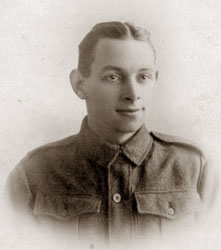 |
James Spiers - at the outset of war. |
 |
.jpg) |
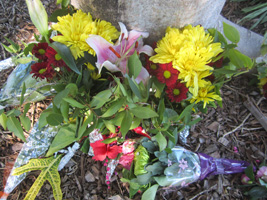 |
Replacement plaque installed in 2012 by the Brisbane City Council. |
Tree 34 is a replacement of the original weeping fig. His son David planted the original. |
Tree 34 - Anzac Day Flowers. |
James 'Jimmy' Spiers was born in April 1892 in Northumberland, England, to Robert Hume Spiers (b 1864) and Mary Spiers (nee Blake, b 1867). His father was a seaman and marine engineer in Wallsend and they had children James, Andrew, Elizabeth, Robert and David who attended school in Newcastle Upon Tyne. James followed in his father's footsteps and became an engineer working at the Wallsend Shipyard. Andrew had five years as a warehouse assistant with Arthur and Co. in Newcastle.
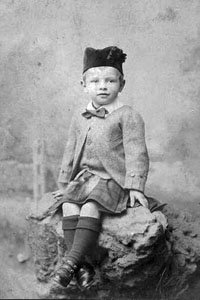
James Spiers as a young boy.
(Andrew Whittaker).
Younger brother Andrew was the first to enlist (4 June 1915) and he was placed with the 31st Battalion Headquarters (Reg. No. 2). James then enlisted on 10 August 1915 (Reg. No. 2801) and was placed with the 15th Battalion, 9th Reinforcements and embarked in early September aboard HMAT Ayreshire A33 bound for the Middle East. Andrew left Australia in November that year.
James, after a short (very short) period of training and expecting to go to France, embarked for Gallipoli on October 30, joining his battalion two weeks later. The campaign was coming to an end and the war diary for the months merely says "Moved to Hay Valley and did Divisional and Brigade fatigues". From the beginning of November until the 13th the battalion was held in reserve when they then embarked for Mudros and thence Alexandria on Christmas Day.
In Egypt James was transferred to the 47th Battalion infantry (12th Brigade) while in the Tel el Kebir Camp and after some more training was placed with the 11th Field Artillery Brigade (FAB) as a gunner in the 43rd Battery. Meanwhile, brother Andrew had been promoted to Company Quartermaster Sergeant (CQMS) then Regimental QM Sergeant.
The 11th FAB left Egypt in early June 1916 for Marseilles then up to Le Havre on the northern France coast near England. They made their way inland to billets at Caestre by mid June and then further SE to Fleurbaix on the 4th. For the next two weeks they cut wire with their howitzers and maintained harassing fire on the enemy. On the 23rd they moved into Belgium (Armentieres) to provide barrages for the front line. Most of late 1917 saw them bogged in bloody trench warfare in Flanders (Belgium) in the Ypres area mostly around Dickenbush (Dikkenbus).
1917 saw a move 100km south to Flers to support operations there. In January the 41st Bty received a direct hit from German shells and 43 Bty lost it ammunition dump although no one was killed. February and March saw much the same - registration of guns, training and harassing fire. In mid-March the 11FAB moved 30 km west via Albert to Behencourt (near Amiens) for more of the same.
April 1917 was to be a big operation to break the Hindenburg Line. The 11th FAB move back past Albert to Bapaume (38 km). Wire cutting began on the 10th and the main barrage on the 11th to support the advance of the infantry. The troops took the front line but couldn't hold it so withdrew. They planned to have another go so on the 12th, 13th and 14th they used harassing fire and cut barbed wire with the shells. The big operation planned for the 15th was postponed due to the weather. However, the enemy was not deterred and launched a huge attack on a long front resulting in heavy 11th Brigade losses.
The four 11th FAB batteries were on a stretch of road between Noreuil and Ecoust St Meir beside what was called Sunken Trench. Both these villages are connected by road to Bapaume about 6 km to the south west (see map). They were about 500 yards outside of Ecoust. It was early morning of the 15th April when the batteries, including James Spiers as a gunner on the No. 4 gun of 43rd Bty, was asked to help the right flank who were being pressed by the German artillery. This necessitated the 43rd Bty going out into the open. Sgt Stan Read was in charge of the No. 4 gun and directed them to pull the gun out of the trench on to the road. They were spotted by a German balloon which directed heavy artillery fire on to them.
The gun received a direct hit from a HE shell and blew it apart killing all of the gunners as well as the 11th FAB battalion commander Major Raymond Pybus. The other three guns continued firing. As well as losing Major Pybus, they lost Lt Emil Clarke and 12 ORs (gunners) and six ORs wounded. They also lost the gun and 3000 rounds of ammunition.
 |
Trench map "France 57C NW 1:20000" with trench overlay correct to 13 April 1917 (two days before James Spiers died). There is a pencilled cross on the map that says in pencil 'battery position'. |
Men came back at night to get the bodies ready for burial in the morning. These included Sgt Arthur Neill 3113 who was on the next gun about 10 yards away, Sgt Don MacPhail 1790, Sgt Roy Turton (252) and Henry Forsey 2637. The two officers Pybus and Clarke were taken away for burial at the Bapaume Communal Cemetery. The 12 gunners were buried beside where they fell - in a single grave about 100 yards away. A large cross was erected with all names inscribed: Sgt Edwin Stanley 'Stan' Read 2996, Sgt John Marsland Guthrie 1769, Gnr William Adams 302, Gnr Norman Henry Cooper 3718, Gnr Albert Day 3039A, Gnr Tom James King 2052, Gnr Andrew Watt 3952, Gnr Harry Rowan Agney 4726, Gnr William John James 3785, Gnr James Spiers 2801, Gnr Frederick Joseph Wallace 14662 and Gnr Alphonsus Bernard Hennessy 3757A.
The attack on the Hindenberg Line was postponed again.
During the time that James Spiers was in the Bapaume area his brother Andrew was with the 52 Battalion (12th Brigade) not far away. Andrew participated in the attack at Noreuil on 2 April and stayed in the area until the 15th (when James died) where the battalion was sent north to Becourt for rest. James was transferred to the 50th Battalion in August 1918 and had a bad eye trauma when he caught shrapnel in his eye. After recovery he was sent home with permanent eye damage in May 1919.
Three months later - 23 August 1919 - a weeping fig was planted in Honour Avenue to commemorated James Spiers' sacrifice. It was the third planting of trees.
James Spiers' grand nephew Andrew Whittaker offered this reflection (in 2015): "My great-uncle was one of the men honoured with a planting. My grandfather, David Spiers, assisted in the planting of the tree. Although Jimmy died 43 years prior to my birth, he remained a strong presence in my family - he was the talented eldest son lost far too early. The feeling of deep loss and sadness which arose every time his name was mentioned must have been felt by far too many families here and abroad. I am sure my great-grandfather never recovered from his loss. Terribly sad still."
James's father Mr Robert Spiers died in 1954 and his mother Mrs Mary Spiers in 1960.
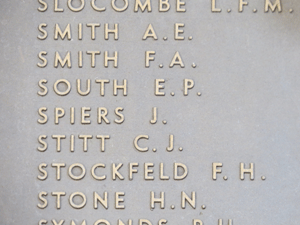 |
Australian War Memorial Roll of Honour October 2018 (J Hawker) |
Frank Straiton
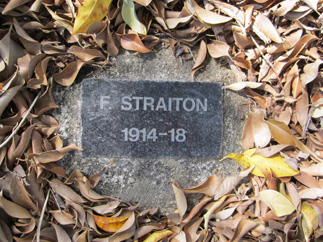 |
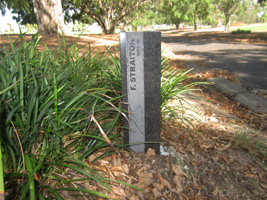 |
26th Bn - Frank died in France during the Battle of Bullecourt near Mont St Quentin.. |
Tree 91 - flame tree that has died but not been replaced. Note the Dianella caerulea Lucia ornamental grass being used. |
Frank Straiton was born in Brisbane on 16th May 1895. His unmarried mother, Elizabeth Straiton, born in Brisbane in 1880, was the daughter of Walter Straiton and Helen Straiton (nee Hutton) from Scotland. His father, James, left straight after he was born and was never seen again.
Frank was raised by his mother and her parents with whom she lived. She had siblings Margaret Gill (b 1875), James William (b 1877), and Henry Hutton (b 1881). Because of the public opprobrium faced by unwed single mothers at the time, it seems that Frank may have been presented to others as Elizabeth's brother instead of her son.
In 1903 Elizabeth Straiton married 31-year-old George Soden and set up their home "Artmoor" in Junction Street, Thompson's Estate, Annerley. The children attended the nearby Junction Park State School. Frank joined the Citizens Forces (Army Reserve) and became a corporal in the 8th Infantry, and after passing his School of Instruction exams at Enoggera Barracks, became a corporal (June 1914) and later a lieutenant (April 1915). Meanwhile, he obtained a job as a ledger keeper with the Royal Bank of Queensland (later The National Australia Bank) and was posted to various branches: Boonah, Toowoomba and Brisbane. While at Boonah he started seeing 27-year-old Minnie May Elliott and she remained his girlfriend thereafter.
On 19 September 1916, at the age of 21, Frank applied to join the army. He listed Mrs Elizabeth Soden as his sister and next of kin. Of course, Mrs Elizabeth Soden was his mother but they both worried about how his illegitimacy may appear to his girlfriend Minnie. Mrs Soden said she wanted to protect Frank from this as she didn't want Minnie to think "less of him". This caused great confusion in the army as they replaced 'sister' with 'mother' and vice versa on many occasions - usually with added question marks. He wrote out his will in April 1916 and left equal shares to Minnie, Elizabeth and his sister Margaret Gibb Thackeray (widow of William Thackaray who died in 1897).
Nevertheless, Frank was off to war. His Regimental No. was 6170. Frank departed Brisbane on 27 October 1916 aboard HMAT Marathon A74 as part of the 26th Battalion, 17th Reinforcements. He became friends with Glasgow-born Robert 'Robbie' Arthur Holloway (R.6083) aboard the ship and would remain friends for life. Frank and Robbie arrived in Plymouth six weeks later and began training, although pleurisy knocked Frank out of action for two months. Eventually, he departed for France and joined his battalion (and caught up with Sgt Holloway) on 2nd April 1917.
On that day the battalion was at Contalmaison in northern France. They had been in the front line at a railway embankment opposite the Hindenburg Line (due south of Bullecourt) for a battle in late April and now were back there again, having relieved the 21st and 23rd Battalions. The following day (3rd May 1917) the battalion took part in an attack on the Hindenburg Line. Their job was to hold the railway embankment from which the attack was being launched. They did so successfully and dug in.
Later that year (1917) the focus of the AIF's operations switched to Belgium. There, the 26th Battalion fought in the battle of Menin Road on 20th September, and participated in the capture of Broodseinde Ridge on 4th October.
Like most AIF battalions, the 26th fought to turn back the German spring offensive in April 1918, and in the lull that followed mounted "peaceful penetration" operations to snatch portions of the German front line. On the 24th September 1918 Frank and Robbie Holloway had leave to go to England for three weeks which they did so with gusto. They were out of harm's way when the 26th Battalion participated in the great offensive that began on 8th August. Frank and Robbie came back on the 12th while the battalion was still in the thick of it. That same day the battalion was relieved by the 23rd Battalion and they took a bus to Bussy for rest and training.
 |
Trench map from 1918 on which I have marked the location of Frank Straiton's death and burial. The 26th Bn lined up on the left side of the red line and advanced towards Mt St Quentin as shown. Frank was probably killed by machine gun fire from the location shown. Map 62C NW, 1/20000, 6 March 1918. |
A final episode in the Bullecourt battle was to take place on 2nd September - being an attack east of Mont St Quentin. They had bivouacked in the forward area - a railway embankment south of the Mont and on the 2nd jumped off at 5am. They moved through a thick enemy artillery formation and machine gun fire was extremely intense but pressed on. German bombing was particularly intense in the map reference area I.15.c & d (see black asterisk map above). Particularly heavy MG fire was coming from their right flank - right at D-Coy and played across the low ground at distances of 1500 yards. The most destructive MG fire was from St Denis and The Copse at I.17c.
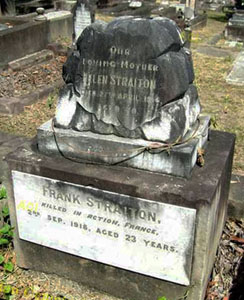
Frank's empty grave at Dutton
Park Cemetery. (Roma Waldron).
From hospital Robbie wrote to Frank's 14-year-old sister Miss Helen Soden in Brisbane, and to a cousin in Scotland. Franks' death was so hard for Elizabeth - having to pretend that she was his sister but was really his mother. She asked questions that probably only a mother would ask. She wrote in April 1919 "I would like to know if death was instantaneous or if he lingered" and "I am anxious to know if he suffered in any way".
Frank was later reinterred to Peronne Communal Cemetery. Robbie never returned to Australia. He applied for discharge in England and was granted it. He went back to work for his father at Holloway and Sons, Leather Merchants in Glasgow. Elizabeth applied for Frank's medals but the army said they had to go to his father, or eldest son, then mother. She wrote to say that his father disappeared after his birth and hasn't been seen since; and she had to admit that she purposely made a false claim on the enlistment form about her relationship to Frank and that it was to protect Frank's girlfriend Minnie from knowing the truth. The army relented and sent her the medals.
Frank's sister Helen married Albert Snell in 1933 and she died in 1965. His mother Elizabeth died in 1949. Minnie May never married. She died in 1974 at the age of 86.
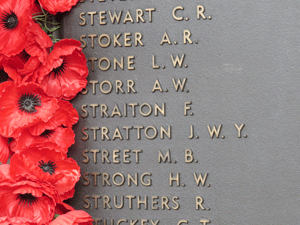 |
Australian War Memorial Roll of Honour October 2018 (J Hawker) |
Jack Edward Sunners
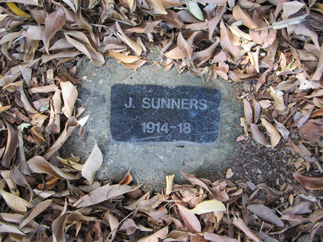 |
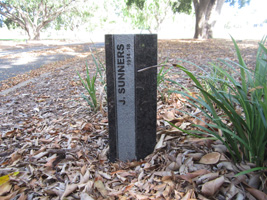 |
|---|---|
Jack Sunners - 3rd Division Ammunition Column - Australian Field Artillery. |
Tree 92 - A flame tree was originally here but died and was not replaced. Some nice ornamental grass (Dianella caerulea Lucia) marks the spot. |
John 'Jack' Edward Sunners was born in Brisbane in 1894 to William 'Willie' Reginald Sydney Sunners (b Newcastle NSW 1866) and Kathleen Eileen Woods Feehan (b 1868). His mother already had a child William Almora Feehan who adopted the name Sunners when she married her husband in Brisbane in 1894.
Jack was born in 1894, then Warner Reginald Frank in 1897, Vivian Outridge in 1901 (died 1901) and finally Frank Outridge in 1904.
He attended Brisbane Central School and then began an engineering apprenticeship with the bicycle and engineering repair shop of Gustavson and Sons in Elizabeth Street, City. While part-way through it he transferred his indentures to Smith and Ball, marine engineers and metal workers (Acme Engineering Works) in Margaret Street, City. There he completed his five year apprenticeship.
Jack obtained employment as an engineer with the Intercolonial Well Boring Co Ltd at Yeerongpilly. This was not far from where he was residing - with his younger brother Almora at 'Beauwater' Villa Street Annerley (next to Yeronga Park).
Jack enlisted in the army on 10th January 1916 and was given Regimental No. 21279. He departed Sydney for England aboard HMAT Argyleshire on 11th May 1916 arriving at Plymouth two months later. For three months he trained as a gunner with the 36 Bty 9th Field Artillery Brigade (9th FAB).
In early October he was then transferred to the newly formed 3rd Divisional Ammunition Column (3rd DAC). Each Division had an Ammunition Column to keep ammunition up to the guns by moving it from "Third line" storage up to the Front ("First Line"). In Jack's case it was as part of the 3rd Division of the army which comprised the 9th, 10th and 11th Infantry Brigades (hence his enlistment in the 3rd Brigade Field Artillery). It was a mammoth task involving motor and horse drawn transport, heavy and light rail and tramways. Ammunition dumps and transport near the Front Line were high priority targets of the enemy's guns, and later, aircraft.
.
Jack proceeded overseas to France in the No. 2 Section of the 3rd DAC in December 1916. He arrived at billets in the Steenwerck area right on the Belgian border in northern France. For the next two months he cleaned up the billets (which were full of mud) and tried to fix up stables for their horses. Jack was then detached from the 3rd DAC for placement in the 3rd Divisional Train located at La Creche a few miles south of Steenwerck - starting 28 February 1917. This unit was still within the 3rd Division but was a unit of the Army Service Corps. It had the task of buying and distributing food to the 102 other units in the division. In March they distributed 8 tonnes of vegetables alone to the troops in the divisional area.
In April he returned to the 3rd DAC at nearby Nieppe for two months. He spent his time driving ammunition to the front line during The Battle of Messines (7-10 June). Nevertheless, he was back to the 3rd Divisional Train in late June 1917 - still at La Creche and still driving vegetables, meat and other foodstuff to the troops in the forward areas.
For the next eight months Jack continued his 3rd Divisional Train work at Le Creche. The Division saw action in The Third Battles of Ypres, which included The Battle of Broodseinde (4 Oct) and The First Battle of Passchendaele (12 Oct). In March 1918 Jack came down with pharyngitis - a throat infection that if not treated promptly can get into the blood and lead to sepsis. He was treated at the 5th Australian Field Ambulance and was well enough to return to duty 9 days later.
For the rest of 1918 the 3rd Division participated in many now-famous battles, all of which the 3rd Divisional Train acted in a supporting role by providing food for the troops and supporting units. For instance upon his return he was supporting The First Battles of the Somme, 1918 which included The 9th Brigade's Battle of the Avre (4th April), the 11th Brigade's capture of Hamel (4th July) and The Battle of Amiens (8-11th August).
The AIF was beginning to see more success. Next followed The Second Battles of the Somme 1918 including The Battle of Albert (21st -23rd Aug) and The Second Battle of Bapaume (31st Aug - 3rd Sept), and finally The Battle of the St Quentin Canal (29th Sep - 2nd Oct) in the Hindenburg Line.
On October 25th the army offered a five week training course at their ordnance workshops at Calais for men who were experienced mechanics, particularly in cycle mechanics or wheelwrights. This suited Jack but it was not to be.
 |
Jack worked with the 3rd Divisional Train in the area shown by the circle centred around Allery. Food was delivered by truck and horse and mule teams to quartermaster stores in the area. The units receiving the goods ranged from the 42nd Infantry Battalion, to the 3rd Division Concert Troup and Royal Australian Engineers. There were well over 100 dfferent units relyng on the Train for supplies. Jack contracted influenza as he moved around the area. |
The exhaustion and poor health took its toll on many men, including Jack. The next month - November 1918 - saw Jack come from the 3rd Divisional Train to be admitted to No. 50 Casualty Cleaning Station with influenza, where two others had died of the same illness. Jack was admitted on the 28th November and then quickly transferred to the 10th General Hospital at Rouen France ex 28th Ambulance Train. He was admitted 'seriously ill' on the 1st December 1918 and then deteriorating to 'now dangerously ill' the following day. A letter was immediately sent to his mother at her old London Street, Chermside, Brisbane address but was returned unopened. She had moved but left no forwarding address.
Within the week Jack was dead. He died of pneumonia as a result of the influenza on 8th December 1918 and buried the same day at St Sever's Cemetery Extension at Rouen.
The army tried to send a message to Mrs Sunners but she was still uncontactable. The army has strict regulations about disposing of a soldier's belongings. The Next of Kin (his mother Kate Eileen) was to get his belongings and his father William was to get medals. Her husband had left for Sydney to take work aboard the Burns Philp Island Steamers ship SS Marsina and was also out of reach. The eldest son Almora William was in Melbourne but he was only entitled to the medals if Jack's father AND mother couldn't be found. Eventually her younger son Warner advised the army that he had his mother's address and collected Jack belongings on her behalf.
Mrs Sunners' brother John Feehan had a son Jack (46th Bn, R.4488) who was killed in action on 3rd April 1918.
Mrs Sunners also returned to Sydney and died in 1938 at the age of 70. Mr Sunners died in 1942. Jack's brother Warner died in 1971, and Almora in 1977.
 |
Australian War Memorial Roll of Honour October 2018 (J Hawker) |
John Paterson Taylor
 |
.jpg) |
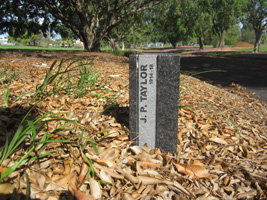 |
Taylor was in the 38th Coy Service Company |
Taylor's Tree 93 - A big original weeping fig planted on 23 August 1919 is still here. |
Ornamental grass (Dianella caerulea) is used next to the new plaque. |
John "Jack" Paterson Taylor was born in Sydney in 1877 to John Simpson Taylor and Mary Jane Taylor (nee Sutton). He had a number of siblings: Ella (b 1879), Annie (b 1880) Jane (b 1880, d 1881), Olive (b 1882), Myrtle (b 1884), Violet Valonia (b 1885), Lily (b 1887) and Daisey (b 1888). He was raised in Wagga Wagga, NSW, and attended school there.
Jack took up employment as a commission agent working as middlemen between vendors and buyers throughout country NSW before marrying Mary Jane Coronel in Goulburn NSW in 1907. After their marriage they moved north to Brisbane in 1907 and set up home in Chatsworth Heights, Coorparoo. They soon had a son - John Coronel Taylor - born in 1909.
Jack joined the Queensland Police Force on the 5th February 1909. He was stationed at New Farm before transferring to the Water Police in 1911. He injured his back lifting a boat and after being laid up for six months was transferred to Roma Street Station. While on duty in 1912 he was assaulted by a sailor which caused him more pain even though the sailor was jailed with hard labour for six months. After another back strain incident he decided to join the army.
On 17th February 1917 Jack enlisted and was sent to Liverpool, Sydney for training. At first was placed with the Field Artillery as a Gunner but sustained another injury to his back and was transferred to the Australian Army Service Corps (AASC) as a driver in December that year. As part of the AASC, 1st Anzac Mounted Division, 14th Reinforcements, he was sent overseas aboard HMAT A38 Ulysses on 19 December 1917.
Jack arrived in Palestine in May 1918 and began training with the ASC as part of 38th Company. He was working as a driver at their camp at Wadi Auja - a deep gorge leading down to Jordan Valley. Temperatures were reaching 100°F/37°C in the shade when he arrived, and the dust was so bad that they couldn't see the lead animals in their teams. There were snakes, malaria mosquitoes, flies and crawling insects. The Commanding Officer of the Division said "the Jordan Valley won't be remembered as a summer resort".
In May 1917, the AASC in the Jordan Valley consisted of 25 officers, 460 Other Ranks (including Jack), 370 Natives, 1005 animals and 197 vehicles. The average weekly attendance at sick parade was: Whites 113, Natives 62.
In June 1918 the heat was getting worse (up to 119°F/48°C) and men were getting sicker. They spent some time in Bethlehem and camped at Solomon's Pools which was a nice change, even though the temperature stayed at 108°F/42°C. In July they were back in the Jordan Valley and still delivering food and supplies to men in the front line. Men were dropping like flies; in July alone 102 men were in hospital with heat stroke.
September saw Jack bivouacked at a place called Sarotia where he slept under some Australian eucalyptus trees. October 1918 was to be a fateful month for Jack. The ASC had moved to Damascus. It was filthy and people lay dead and dying in the streets; there were starving people everywhere as they couldn't get food in due to enemy activity. Coping with hygiene was difficult. Dead horses were disembowled and left in the sun to dry for four days; the skins sold and the carcasses then stuffed with straw and burnt. Sanitation was a huge problem and no wonder men were sick. On the 3rd October, the 38-Coy moved out of Damascus to Dumar where the 3rd Brigade was operating. Not only did the ASC have to feed their own troops (3rd Bde) but also the 20000 Turkish and German prisoners of war interred nearby.
The troops were getting very sick. This extract from the War Diary from 11th October 1918 makes it clear:
 |
On 31st October Jack became ill with dysentery and on 14th November was evacuated to the 74th Casualty Clearing Station in Palestine as "dangerously ill". His wife in Brisbane was notified. However, Jack continued to deteriorate and was sent to the Abbassia School Hospital on 16th November, and then the 87th General Hospital at Alexandria where he died on 21st November 1918. Jack was buried the same day at the Military Cemetery at Hadra, Alexandria. He was 41 years of age.
Jack Taylor was the oldest of the thirty Queensland Police Officers who died in active service during World War I. Nineteen police servicemen died in trench warfare in France and Belgium, but Jack was the last police casualty of the war.
Turkey had agreed to an armistice, so the ASC was no longer needed in this area. It moved to Tripoli about 60 miles SW along the coast, although the 38-Coy moved to Homs instead and stayed a lot longer. They were all sent back to Australia soon after.
Jack's father died in 1927 (in Goulburn, NSW) and his mother in 1928. Jack's son John Coronel Taylor also enlisted in the army (QX606) becoming a Captain in the 2/3 Field Ambulance in WWII, and being Mentioned in Despatches in 1941.
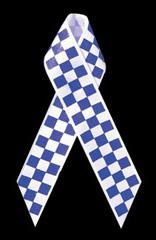 |
 |
Jack Taylor was one of the thirty Queensland Police Officers who died in active service during World War I. |
Flowers and a message left by Myla Grace Taylor from Yeronga State School - Anzac Day 2014. I wonder if she is related to John Paterson Taylor. |
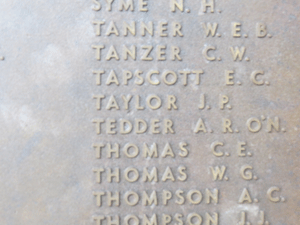 |
Australian War Memorial Roll of Honour October 2018 (J Hawker) |
William 'Bill' Temple
 |
 |
 |
Tree 9 - lovely big old weeping fig originally planted in 1917. |
Bill Temple, 1916. 3rd Pioneers |
Yeronga students' flowers at the base of Bill Temple's tree. |
.jpg) |
.jpg) |
.jpg) |
Tree 9 - Temple's tree still standing from its planting in 1917. |
The school groundsman looks like he's done some heavy pruning. |
Lovely gnarled branches. |
William 'Bill' Temple was born in Springburn, Glasgow in 1895 to parents William and Mary Hart Temple (nee Anderson). The four children were: Ellen 'Nellie' Erskine, Elizabeth 'Lizzy' Hooks, William (Jnr), George Hart, Archibald Erskine and Mary Hart (Jnr). They attended the Wellfield Public School in Glasgow.
In November 1911, the family of six (excluding Mr William Temple Snr who it appears may have died prior to this) migrated to Australia aboard SS Essex arriving in Brisbane in late-February 1912. An older sister Ellen 'Helen' Erskine Temple (b 7 June 1891) came to Brisbane at some other time.
Bill became a baker and worked for Mr John Paine at his Moorooka bakery. He decided to join the army and enlisted on 5 January 1916. Mr Paine organised a send off for him a week later and gave him a wrist watch on behalf of the other workers. After training with the 11th Depot Battalion in Australia Bill was off to England with the 3rd Division Pioneers (Engineers). He left Melbourne in June 1916 aboard HMAT Wandilla A62 and, apart for a slight indiscretion in Capetown, arrived in England in late July in good health and spirits.
Before he left Brisbane the local citizenry of Stephens Shire held a send off at Moorooka (13 September 1916). A number of returned soldiers were given certificates of appreciation and the 11 men who had left or were about to leave were given medallions. Bill undertook some more training in England and was off to France in November (1916). After a short stint in France with the 3rd Pioneers, Bill was selected to return to England for training in Signals. He did so and was back at the front in July 1917.
The 3rd Battalion Pioneers were at Messines near the Belgian border at this stage (early July). It was here, in early June 1917, that the division undertook its first major engagement of the war when it was committed to the fighting during the Battle of Messines. That was over and now Bill's Company, C-Coy, was doing trench construction and maintenance. On the 12th July they were sent to general trench work after being relieved by A-Coy (3rd Pioneers).
The 3rd Division AIF had the task of holding the front line after winning it at the Battle of Messines. Bombing and sniping by the Germans continued and several men were killed up until the 22nd July. On the 23rd, Bill had been seconded to 11th Brigade HQ as a signaller. He was in the trenches at Warneton that day and while running messages was hit by a shell. Some said he was killed by concussion and others said 'blown to pieces'. L/Cpl Bernie Cody (1126) was with him at the time and was buried by the dirt from the same shell. He survived, Bill Temple did not. Bill was buried nearby (on the top of Hill 60) and Frank Malthouse (855) erected a cross on the grave.
The news of his death was published in the Brisbane Courier on 10th August. The following year Bill's family inserted a notice in the paper:
| He left us with a happy smile, not thinking death as near, but now he sleeps in foreign soil, our boy we loved so dear. Some may think he is forgotten, when they see us smile, but they little know the sorrow, that smile hides all the while. Somewhere in France they have laid him, our hero so brave and true, only a lad in khaki, fighting for me and you. To have in our hearts of those we leave behind, is not to die. Brisbane Courier 23 July 1918 |
Of the 11 men who were farewelled by the citizens of the Stephens Shire in September 1916, three were killed in action. Apart from Bill Temple, we find that Lew Robson (246) and John Gnatz (2314) also died. Their stories are on this webpage. John Gnatz's brother William also fought overseas but returned to Australia in 1919. He married Bill's sister Elizabeth Hooks Temple in 1921. Bill's mother Mary Hart Anderson Temple died in 1945, aged 79.
 |
Australian War Memorial Roll of Honour October 2018 (J Hawker) |
James Thomason
 |
 |
Tree 35 was a flame tree but like the rest of the flame trees - it died and has not been replaced. |
Flowers near Thomason's plaque. |
James Thomason was born in Cheshire, England, in August 1888 to John Thomason and his wife Margaret Alice Thomason (nee Lewis). His parents were married in England and migrated to Australia in September 1911 aboard the ship Durham from London. The family of three set up home at "Ironside", Chatsworth Heights Estate, Mt Pleasant, off Logan Road, Brisbane. Mt Pleasant became known as Greenslopes in 1914.
James enlisted in the AIF on 18 May 1915 at the age of 26 years. He was placed in the 25th Battalion 1st Reinforcements and departed Brisbane on 29 June 1915 aboard A80 HMAT Aeneas. The 25 Bn trained in Egypt during August, and by early September was manning trenches at Gallipoli. The 25th Battalion, however, had a relatively quiet time because the last major Allied offensive had been launched, and turned back, in the previous month. James and the 25 Bn left Gallipoli on 18 December 1915 during the final evacuation. After further training in Egypt, the 25th Battalion left Alexandria on 14 March for France, landing on 19 March 1916. They were the first AIF battalion to arrive there.
In August 1916, now fighting as part of the 2nd Division (previously 7th Division), the 25Bn took part in its first major battle at Pozieres between 25 July and 7 August in the course of which it suffered 785 casualties. After a spell in a quieter sector of the front in Belgium, the 2nd Division came south in October to attack again in the Somme Valley.
On 24 November 1916, James was transferred to the 7th Machine Gun Company (that is, one of the MG Coys of the 7th Brigade, attached to the 25 Bn). They had been at Dernacourt in France training earlier that month and spent most of November and December in training and refitting with some attacks on th eGerman front line. The unsuccessful attack on 5th November was blamed on the Vickers machine gunners not being agressive enough. The CO said (22 Nov) that they "must make opportunity whenever possible". By the start of the new year (1917) they were at Montauban where they attacked the German front line. The War Diary for February is missing but they appear to have continued as before and had moved to Le Sars at the start of March.
Between 2nd and 12th March they had been covering no-man's-land with indirect fire (killing 30 Germans). After resting at Gordon Camp they moved to Vraucort about 60km NE of Amiens where a German raiding party stormed one of their machine gun outposts at dawn only to suffer heavy casualties. Two days later they were in Lagnicourt after a 2 km march to the NE. The Company began a reconnoitre of the area in preparation for an attack by the 5th Division on the 25th. The attack started at 5am on the 26th March (1916) and was subjected to heavy defence by the Germans. Of the 7th MG Company, seven men were wounded, one died of wounds and one man was killed in action. That man was James Thomason. He died on 26th March 1916 at Lagnicourt, France. The Company was relieved by the 13th MG Coy the next morning at 5am.
James hadn't married before he left and had no children. He had no siblings. His father died in 1943, and his mother in 1946.
Thomas William Turner
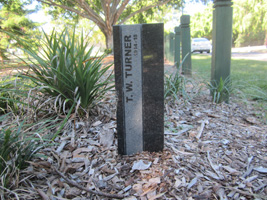 |
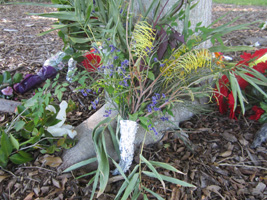 |
Tree 36 - a flame tree that died and was not replaced. Note the Dianella caerulea Lucia ornamental grass being used to mark the spot. |
Flowers near Tom Turner's tree. |
Thomas 'Tom' William Turner was born in Manchester in 1895 to Edward Alfred Harry Maguire Turner (b 1876) and Annie Turner (nee Mullin, b1875). They had children Thomas, Edward, Rebecca, Lily and John in Manchester, although Edward died at the age of 3.
The family migrated to Australia aboard SS Themistocles arriving in Brisbane on 18 January 1912. They settled in to a home in Alice Street (now Ponsonby St), Annerley and Tom, now living at Billington Estate, Wynnum North, obtained work as a house painter. He was not married.
Tom enlisted in the army in August 1915 (Reg. No. 3147) and was placed with the 26th Battalion, 7th Reinforcements. He departed Brisbane in December aboard HMAT Itonus A50 bound for the Middle East. After training he was off to France and joined his battalion in the north on 25th April 1916. They were at Morbecque near the Belgian border. The month was spent marching to various towns - Hazebrouck, Outtersteene for billeting. and then into the nearby trenches to relieve troops serving there.
May and June 1916 saw the 26th Battalion rotating in and out of the front line trenches mainly relieving the 28th Battalion. In July 1916 they were at Messines, cleaning and repairing the trenches. German artillery was bombing these trenches and they lost several men each month. By mid-July the 7th Brigade had shifted 140 km south to Longueval, near the Somme, for training, and then 30 km west to Warloy for more training and practice. It was now 27 July and they began preparing for a big action at Pozieres. This was to be their first major battle.
The battalion bivouacked at Tara Hill for the night of the 27th and in the evening moved along Sausage Valley to their jumping off positions along the railway line at Pozieres. They were ready at 11pm but green German flares started lighting up the sky. This meant the Germans knew an action was about to take place and all should be prepared. Nevertheless, at 11.10pm the troops moved off in four waves. They passed hostile listening posts in No Man's Land (that were connected to the main trenches by underground tunnels). The Germans were quite aware of the movements of the Brigade.
Each of the four waves made it to the German wire in front of the first trench (OG1). Some of the wire was not cut by the earlier bombardment and the troops had trouble advancing. They had to find their way around the wire and the battalions became mixed. The 26th and 27th battalions crossed ('overlapped'). Some men from the 26th Battalion made it into the trenches, but not many.
The advance had stalled, partly from the wire defences but also from the German machine guns. Someone ordered a general retirement but this was not official but, nevertheless, many troops started back to their own lines. The officers tried to stop this but it became obvious that the advance was not going any further so a general withdrawal was ordered.
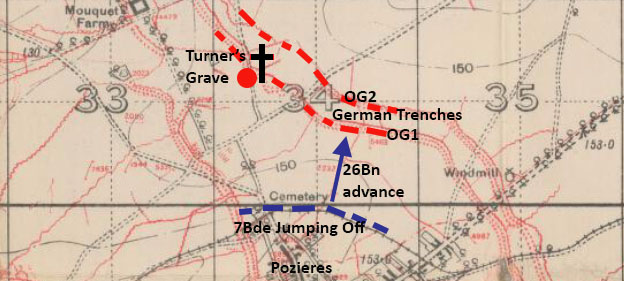 |
The trench map used at Pozieres in July 1916 (Posiered 57D SW 1:20000, 4th April 1916). I have marked on it the Jumping Off points along the railway track used by the 7th Brigade (in blue), and the location of the German trenches (in red). Tom grave is shown by the red dot - right on the German wire. He was reinterred to Serre Road No.2 Cemetery about 12 km NW of where he was killed. |
It was about now that Tom Turner was killed. He was right on the German wire when he was hit. He had to be left there until a burial party came back the next day. The red dot of the map marks exactly where he fell and was buried - right up against the German wire. The action was considered unsuccessful. The next day men were back at their lines at Tara Hill doing fatigue work once again.
In Brisbane, a sister Mary was born in 1917. After the war Tom's body was recovered and reinterred in Serre Road Cemetery No. 2 at Hamel. Two identity discs were found on his body and these were sent home to his parents in the mid-1920s. The ship that brought them home was the same ship - Themistocles - that the family had arrived on in 1912.
By this time Tom's mother and father were not in good health. They spent some time in hospital. His mother developed rheumatic fever, his father had been out of work for most of the year, their 21 year old daughter Lily had developed paralysis, and their 17 year old son John was also out of work. Mr Turner appealed to the army for help with an army pension. They referred him to the Soldiers' Comforts Fund.
Mr Turner died in 1960 and his wife Annie died in 1966.
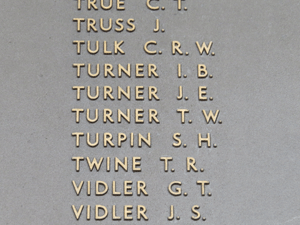 |
Australian War Memorial Roll of Honour October 2018 (J Hawker) |
Jeffrey Frederick Raoul Ulcoq
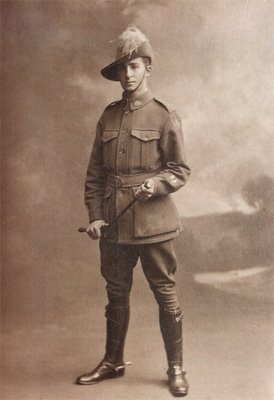 |
Studio portrait of Jeffrey Ulcoq - 1915. (AWM P09399.002) |
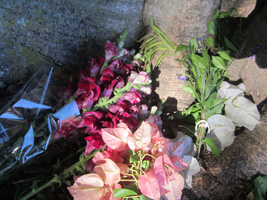 |
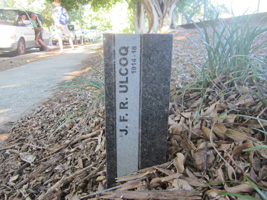 |
Flowers near Jeff Ulcoq's tree. Tree 7 was a flame tree but is no longer there. Like all flame trees in the park it couldn't take the Brisbane climate. |
This is the correct spelling of the Ulcoq name. The Cenotaph has it as "Uncoq" which is wrong. The Honour Board in the RSL Meeting Room has it correct. |
Jeffrey Frederick Raoul Ulcoq was born in Mackay in 1896 to Anthony (Francois Antonie) Ulcoq and his wife Frances Maud Ulcoq (née Haggard). His grandfather Antonie was a sugar pioneer in Queensland who came out from the Mauritius where he was undisputed king of sugar production. Grandfather Antonie gravitated to the sugar region of Mackay in Queensland to further his sugar business interests (with his wife Cecile). Jeffrey has sisters Cecile Debonaire, Maud Marguerita and Nita Marie, and brothers Eugene Oliver, Arthur Louis and Rene Antonie, most of whom had moved to the Yeronga area as young adults. Their father, now a successful banker, died in 1911 and their mother on 27 July 1914 (aged 69; she was born in London). Jeffrey was enrolled at Yeronga State School in July 1904 at the age of 8 years; as was his brother Eugene in the same year.
Jeffrey's older brother Oliver enlisted in the AIF 47 Bn on 26 August 1914, just one month after their mother's death. He departed Melbourne in September 1914 aboard HMAT Omrah and was sent to Egypt for training and then to Gallipoli. On 16 July 1915 Jeffrey enlisted in Brisbane and was placed into the 5th Field Artillery Battalion (FAB) as a gunner. Meanwhile, at Gallipoli, Eugene sustained a gunshot wound to his head on 12 August 1915 and had to go to hospital in England. The family was informed. Six weeks later a younger brother Rene Antoine joined the army (on 23 September 1915). He was placed with the 2nd Division Field Artillery as a bombardier. He departed Melbourne for England on 16 November 1915.
Two days later Jeffrey departed Sydney (18 November 1915) aboard HMAT Persic and arrived Suez in December. He was was sent to England for training. He was wounded in France and returned to England to recover. He did recover from his Gallipoli head wound but received a gunshot wound to his chest in France in August (1916) and was immediately back to hospital in England. Jeffrey departed England on 28 September 1916 to join the 5th FAB in the field in France. While he was with the 105th Battalion at Butte de Warlencourt at the Somme in France he was involved in a terrible accident.
On 5 March 1917 Jeffrey had just visited the cookhouse to ask the paymaster Cpl Les Hobson (8899) if the pays were done. It was about 7.30pm. Les said that the pay would be available in the morning. With that Jeffrey Ulcoq turned on his heel. Unbeknownst to him, a box of Mills bombs was buried under the mud and not visible above the surface. The bombs were all rusted and the box rotten as they had been there for some time. The pressure of his heel broke the corroded pin and ignited the bombs. The explosion blew his foot almost totally off. His friend Albert McFadyen (11624) was also injured in the explosion with severe damage to both legs and back. Jeffrey Ulcoq died instantly and his head rested on the opened lid of the box. An inquiry into the circumstances of his death on 10 March found that it was an accident and no-one was to blame. His next-of-kin Arthur was informed. Albert McFadyen was taken to hospital in England but recovered and returned to France in September that year and eventually returned to Australia.
Brothers Eugene and Rene also returned to Australia. All three brothers are memorialised on the Honour Board in the Stephens RSL Club Room. However, Rene Ulcoq is spelled as "Robert" but perhaps that is what he called himself.
 |
Australian War Memorial Roll of Honour October 2018 (J Hawker) |
Robert Alfred Whitton - died 25 October 1918
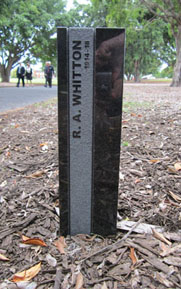 |
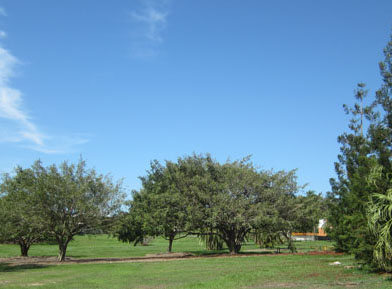 |
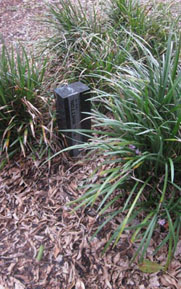 |
Plaque installed by the Council for Anzac Day 2012. You can see the guests from the ceremony walking down Honour Avenue. |
Originally, no tree was planted for Pte Robert Whitton as he did not die from wounds received in battle. At the the third planting of trees on 23 August 1919, 21 names were read out and Whitton's was not amongst them. The gap between these two big weeping figs is where the plaque and flame tree should have gone and was eventually placed. |
My how the ornamental grasses have grown. This photo was taken in January 2015. (John Huth) |
At the time of his enlistment Robert Alfred Whitton was a gold miner who lived in Charters Towers with his wife Edith May and their three infant children Robert, Trixie Louvain and Walter Clark. They lived in their own home in the suburb of Queenton near the Queen Cross Mine where Robert worked. He quit his job in May 1916 and the family shifted to Brisbane.
Robert was born in Kimberley, South Africa, on 14 February 1880 to parents Robert and Hannah, and he grew up there. In 1899, at the outbreak of the Boer War, he joined the Kimberley Regiment and fought with the British forces. At the end of the war in 1903 he joined the South African Police and worked with them for the next five years. In 1908 he migrated to Australia and settled in Charters Towers to work at the gold mine. He met Edith May Thompson and they were married there in June 1911.
Robert came to Brisbane with his family and moved into a new home at Brisbane Street, Annerley, off Ipswich Road. His wife's family also lived in Annerley. Robert enlisted in Brisbane on 14 July 1917 and was given the Regimental No. 18994 and allotted to the Australian Army Medical Corps. The AAMC Reinforcements were to be sent to London for training and he departed Sydney aboard the troopship SS Feldmarschall on 19 June 1918. The end of the war was only five months away but who was to know? While aboard the ship he had his three standard vaccinations (23 July, 30 July and 3 August).
Upon arriving in London on 26 August 1918, he was sent to the west of London to the AAMC Training Depot, Parkhouse, Salisbury Plain, and began training. He was soon taken sick with a headache, cough, chest pains and a fever of 103.4°F. He was transferred to the nearby Military Hospital at Fovant on 19 October 1918 where he was diagnosed with influenza and bronchopneumonia. A week later - on 25 October 1918 - Robert died of his illness.
He was buried with full military honours at St George's Parish Churchyard. The Regimental Band and Firing Party came from his 2nd Australian Training Brigade and six Unit comrades acted as pallbearers. Amongst the mourners were two officers and 50 non-commissioned officers, as well as many men from his Unit. His wife Edith applied for his Victory Medal but was denied this as the Army said he didn't serve in a "theatre of war" before the Armistice on 11 November 1918.
On the first anniversary of his death his wife wrote in the Brisbane Courier:
Our loved one is gone but not forgotten, And, as dawns another year, In my lonely hours of thinking, Thoughts of him are always near. |
No tree was planted by the Stevens Shire Council for Pte Robert Whitton as he did not die from wounds received in battle. At the the third planting of trees on 23 August 1919, 21 names were read out and Whitton's was not amongst them. It seems that Cr Stimpson, of the Stephens Shire Council, had decided that trees were only for "the memory of those that had fallen" (his words). Stimpson was widely condemned for his self-serving approach to the names in the memorial - even adding his own name before being forced to remove it. Robert Whitton was a serving soldier who died during the war while on service in England. It is pleasing to see the the Brisbane City Council installed a plaque in his memory just before Anzac Day 2012 (see photos at top).
.gif) |
Australian War Memorial Roll of Honour October 2018 (J Hawker) |
Harry Gilmore Wilson
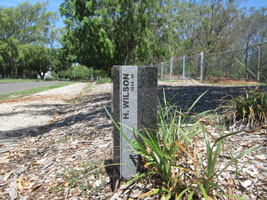 |
.jpg) |
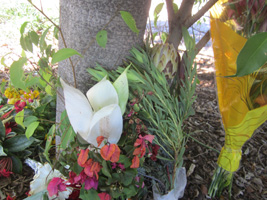 |
1st Field Ambulance - Australian Medical Corps. Harry died in a small hospital at Puchevillers, France. The Dianella caerulea Lucia ornamental grass looks nice. |
This small weeping fig (#37) is a replacement for the original one planted on 15 September 1917. |
Students' flowers placed beside the small weeping fig (tree #37). |
Harry Gilmore Wilson was born at Yeerongpilly, Brisbane, on 13 January 1892 to Benjamin Gilmore Wilson and Esther Wilson (nee Cribb). His parents had married in Brisbane in 1888 and had four boys and two girls: Benjamin, Esther, Harry, Lindsay, Kenneth, Clarissa and Esther. They lived in "Wilderness" in Cracknell Road Annerley, off Ipswich Road. The family had been in Queensland for many generations and owned considerable pastoral land. Mr Wilson owned an ironmongery in Queen Street City where he imported all sorts of kitchenware, including pots and pans, crockery and cutlery.
The four boys all attended Brisbane Grammar School and university and, apart from the eldest, Benjamin, all volunteered for service in the AIF.
The second and third sons decided to enlist and serve together. Harry attended Brisbane Grammar School (BGS) from February 1906 to June 1908 and then took a degree at Hawksbury Agricultural College in NSW. He was a farmer-grazier at Rosewood 60km west of Brisbane. Lindsay was born in June 1893 and attended BGS from February 1907 to December 1912 before taking (and postponing) a degree at Sydney University. The two sons enlisted on 20 September 1915 and were given consecutive Regimental Numbers: 8676 (Lindsay) and 8677 (Harry). They were both placed with the 8th Reinforcements, 7th Australian Field Ambulance (7AFA) and departed Brisbane aboard HMAT Kyarra on 3 January 1916.
Upon arrival in Alexandria, Egypt, they were transferred to the 1st Division AFA to work in the hospital at Serapeum in Alexandria. The 1AFA was preparing for a stint in France and by the end of March 1916 they were in northern France, just a few miles from the Belgian border, following the 1st Division around the battlefields. It was not only injuries from fighting they had to deal with; a big problem was disease. On 1st April they opened a hospital at Strazeele on the Belgian border but had to close it down after a smallpox outbreak. For April, June and July 1916 they moved from place to palce, often relieving other units and sometimes seeing their ambulance drivers being seconded for service as drivers with the ammunition columns of the infantry.
On 20 July 1916 the 1AFA had just moved from Vadencourt to Warloy (near Amiens) and took over the Auxiliary Field Hospital from the British 2nd South Midland Field Ambulance. The hospital was a collection of 16 marquee tents that could accommodate 150 patients. They readied themselves on the 22nd July for the heavy casualties expected the next night when the Division made their advance at Pozieres. As the casualties rolled in it was necessary to take wounded men from the dressing station at Becourt Chateau to the hospital at Warloy - and this was the job of the AFA Drivers like Harry Wilson.
At 9am on the 23rd July, Major Edward Ramsden M.O. left Warloy Hospital with his driver to go to Becourt Chateau to administer to the wounded. Harry was there waiting to transport more wounded back. He was standing beside his car when a German shell came in and exploded next to him. His head, leg and chest were severely wounded and 1AFA Staff Sergeant Tom McIlveen (54) was on hand to organise things. He sent Harry to the Dressing Station where he was patched up by Pte Edward Jerrom (778), and sent on his way to Warloy Hospital 15 km to the west through Albert. It was obvious he was in dire trouble not only because of the shell wound but he had a compound fracture of his left leg. Harry had to be quickly sent on the extra 11km to the 3rd Casualty Clearing Station at Puchevillers (about 19km NE of Amiens). But it was too late; he died the same day. He was buried at Puchvillers Cemetery under the supervision of Rev. A. H. Broughton.
 |
| Trench map (1:10000) for the Pozieres area. Each big square is 1000 yards and you can see that the German front line trenches (in red) are about 400 yards from the British trenches (blue). The Becourt Chateau is only 1000 yards from the German line. I have marked with a red cross the likely location of where Harry Wilson was struck by the shell. He was taken from the Becourt Chateau through Albert (3km to the west) and on to Warloy (a further 11 km to the NW). He was then transferred to the Puchevillers CCS (11 km NW) where he died the same day (23 July 1916). |
Harry's brother Lindsay was working with the 1AFA as well. He too was a Driver in B-Section. When he heard of Harry's death he organised to send a cable to his father in Brisbane. The cable was sent on 5th August 1916, just 13 days after Harry died. It was a complete shock to his father as he had not heard anything officially from the army. There was a flurry of telegrams between the army and the Red Cross, both most agitated at how Mr Wilson knew of his son's death. They sent a chaplain to visit him in the afternoon of 8th August.
In August 1918, the youngest son - Kenneth - enlisted. Ken was at Brisbane Grammar School from February 1910 until December 1915 and was now studying medicine Sydney University (St Andrew's College). He was placed with the 29 General Reinforcements and stayed in Sydney until being demobilised three months later - at war's end. The other brother, Lindsay, returned to Australia in 1919.
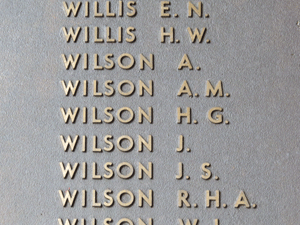 |
Australian War Memorial Roll of Honour October 2018 (J Hawker) |
Sgt Roy Alexander Wilson
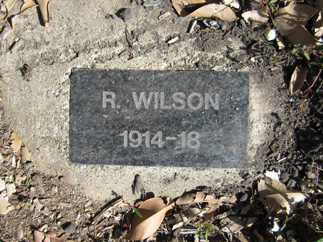 |
 |
 |
The 1993 plaque. |
Flowers placed beside Wilson's plaque. There is no tree there any more as the original flame tree (#71) died. |
41st Bn - died in Belgium. |
Roy Alexander Wilson was born in Brisbane on 11 November 1894 to Robert and Jessie Kennedy Wilson (née Aitken). He attended Ipswich Grammar but the family shifted to Bowen Street, off Ipswich Road and opened a ironmongery (hardware) shop at Charlotte Street, Brisbane City in October 1914. Roy was employed as a warehouse assistant. On the 29th November 1915, Roy (or Robert as he is registered in the Queensland BMD Index) enlisted with the 41st Battalion AIF. He left Australia aboard the Demosthenes on 13 May 1916 and arrived in England 10 weeks later. Here he began training at the Signal School at Chelsea (see photo below).
 |
L/Cpl Roy Wilson (left) at Lincoln's Inn Fields in November 1916 while attending the Signaller's School at Chelsea, London. Also shown are 838 Private James Ernest Cousin from Toowomba, Qld; and 942 L/Cpl William Frederick Newnham from Toowomba just before the three Queenslanders departed with the 41st Bn to France. From the collection of Mr Alfred Thomas Sharp. AWM J00728. |
His course finished on 24th November and he departed Southampton that day. The 41st Battalion arrived in France on 25 November 1916. As part of the 3rd Division AIF, it entered the front line for the first time on Christmas Eve and spent the bleak winter of 1916-17 alternating between service in the front line in Belgium, and training and labouring in the rear areas. Wilson undertook training at the Trench Mortar School and later did a Bombing Course.
On 6 July the entire staff of the 41st had been lost in a mortar-attack and Lt Col Alexander Heron from Queensland was given command. At the end of the month the 41st were involved in a terrible struggle known as the Third Battle of Ypres which lasted until 12th October. Towards the end of that time the 41st was among the battalions which spearheaded the attack on the strategically important Broodseinde Ridge; it also participated in the unsuccessful assault on Passchendaele. However, most of the 3rd Division AIF were bogged down in the impossible quagmire of the Ravebeek Valley and incurred 3200 casualties (131 from the 41st Bn).
Enduring continual rain, flooded trenches and heavy shelling many of the battalion's platoons dwindled. It was always snowing, wet and the visibility was bad. On the 13th October, both sides were engaged in collecting wounded and refrained from shooting at stretcher bearers as they struggled in the mud and slush. That day Lt Col Heron wrote in his war diary "the men are very knocked up owing to privations and only by encouragement prevented from going sick". He said that "Feet, in spite of all precautions, in a bad way owing to wet weather". The following day - the 14th October - a shell struck Roy Wilson while he was on the slope leading down to Ravebeek River.
It is said that the whole valley was full with dead and dying. His body was not recovered and he has no known grave. He is memorialised on the Menin Gate, Ypres. Roy was also honoured during the second of three planting ceremonies at Yeronga Memorial Park on Saturday 20th July 1918, attended by his mother and father. His was tree and plaque number 71, near the rear of the Yeronga State School oval. Sadly, his father too died early the next year.
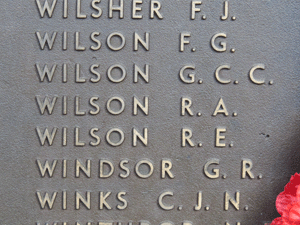 |
Australian War Memorial Roll of Honour October 2018 (J Hawker) |
Frederick John Joice Woodhouse
Frederick John Joice Woodhouse was born in Mackay, North Queensland, in 1894 to Joseph Woodhouse and Elizabeth Ann Woodhouse (née Joice). His parents had come out from Portadown, County Amargh, Ireland in 1887 and Joseph obtained a job with the Queensland Police in Ipswich. He was transferred to Mackay where Frederick was born. At this stage Frederick had just the one sibling - an older brother Edmond Samuel Flavelle Woodhouse, born in 1893. Elizabeth Woodhouse died in Mackay on 11 December 1895, aged 23. From here, the father and two sons moved to North Bundaberg, then Cairns and back to Brisbane in 1897 where the father Joseph retired due to ill health. Joseph married his second wife Margaret Murphy and she gave birth to 4 boys and 2 girls: Joseph 1897, Robert Dunlop 1900, David 1901, Therese 1903, Vincent 1907 and Louisa 1910.
In 1908 or thereabouts, Fred obtained work as an ironmonger, firstly with 'Perry Bros.' in Albert Street in the city and later with 'Podmore and Hall, Ironmongers' around the corner in Adelaide Street. His older brother Edmond became a clerk.
Frederick and Edmond decided to enlist. Edmond enlisted on 4 September 1914 and headed off to the Middle East on 19th December 1914 as a Relief with the 2nd Light Horse. Four days later Fred enlisted in the AIF (23 December) and was placed in the 25th Battalion "A" Coy. He already had 2½ years' experience with the Citizens Military Forces 9th Infantry. Fred went into camp on Xmas Day and embarked for the Middle East aboard HMAT Aeneas from Brisbane on 29 June 1915. He was promoted to Lance Corporal aboard the ship.
Brother Edmond was sent to Gallipoli after finishing training in Egypt. So too was Fred; Fred arrived there on 4 September and stayed until 18 December 1915 before being evacuated to Mudros and and getting back to Alexandria on 9 January 1916. By this time his brother was in France. Fred too was sent to France but illness (hernia) saw him in England in September 1916. After recovering from his operation he was back in France with the 25th Battalion on 13 March 1917. Fred was promoted to Corporal and sent back to England to train at the Signal School.
Back in Brisbane their parents Joseph and Margaret decided it was time to rename the street they lived in at Annerley in honour of the Anzacs. They lived in Dairy Street, Annerley just a few hundred metres from Yeronga Park on the top side. There were six houses in the street and all had sons fighting overseas. Joseph petitioned the Stephens Shire Council to rename the street from Dairy Road to Anzac Street and the Council seemed to have no problem with this. However, the Council became anxious that they may be breaching rules about the use of the Anzac name without permission seeing it was forbidden to be used as a brand name. Joseph Woodhouse wrote to the Federal Government and they assured him they had no objection. The Council had other ideas and in 1916 asked residents for alternative names. Only two were put forward: Franklin Street in honour of the long-time resident George Franklin, and Amargh St, put forward by Joseph Woodhouse to commemorate the land of his birth - County Amargh, Ireland. At an extremely heated Council meeting on 13 February 1917, the Stevens Shire Council voted overwhelmingly in favour of Franklin Street. Joseph Woodhose was livid and reports from the time describe his behaviour at the meeting in a very biased and unflattering way.
Back in France, Fred rejoined his battalion on 26 February 1918 up near Albert.
In early April 1918, the 25Bn was at Lavieville, about two miles west of Albert. The battalion had working parties go out each night to help build the defences. The plan for mid-April was that the 25Bn relieve the 27Bn on the front line, and this was progressing well. On the evening of the 16th D-Coy of 25Bn was in the front line with A-Coy in Reserve. At 8.30pm A-Coy moved forward to relieve in the front line.
During this relief on the night of 16/17th April the enemy heavily bombarded the support line, roads, tracks and valley immediately in the rear with HE (high explosive) and shrapnel. "A", "B" and "D" Companies were caught in an enemy barrage that inflicted a number of casualties. Two men were killed and seven wounded, including Cpl Fred Woodhouse who had shell wounds to the chest and right arm. Four men volunteered to be stretcher bearers and did heroic work under fire to get the wounded to safety. Fred Woodhouse made it to the 20th Casualty Clearing Station but died of his wounds on 18 April 1918.
Later that year Edmond received his commission and became Lt Edmond Woodhouse of the 43rd Battalion AIF. He was wounded by gunshot on 24 August (right shoulder, elbow) and was sent to England for treatment. The war came to an end and Edmond returned to Australia on 15 February 1919.
Joseph Woodhouse died on October 29, 1931 aged 66.
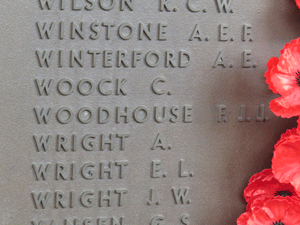 |
Australian War Memorial Roll of Honour October 2018 (J Hawker) |
Henry Femister Wriggles
img044 (267x200).jpg) |
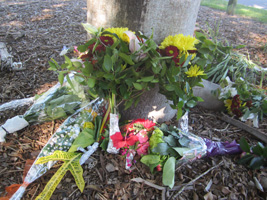 |
 |
The original weeping fig (#38) was replaced with this newer one. Cuttings from the original figs were used to propagate the new ones. |
Yeronga State School students laid wreaths at Henry Wriggles' tree (#38) - Anzac day 2014. The original weeping fig looks like it may have been replaced a long time ago. |
The new plaque - 2014 |
 |
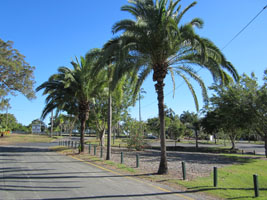 |
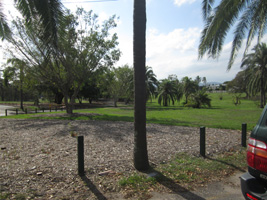 |
The old granite plaque from 1970 |
In 1990 several plaques were placed beside trees that lined the driveway from Villa Street. They were never there in the original plan. |
A plaque for Henry Wriggles was placed beside this tree in the 1990 restoration. It is still here even though a new plaque for this soldier was placed at its original position - Tree 38. |
Henry Femister Wriggles was born in Cairns, North Queensland, in 1894 to Henry "Harry" Wriggles and Mary Wriggles (nee Femister) of Ipswich (Queensland). His parents were married in 1884 and Mr Wriggles worked as a railway locomotive foreman with the Government Railways. They had four children: Ethel (b 1885), Lilly May (b 1886, d 1890), Elsie (b 1892, d 1893) and Henry.
Henry attended various schools as the family moved around Queensland. From Cairns, they moved to Charters Towers, then Townsville where Henry did most of his primary schooling. Then Henry was off to Ipswich where he attended Ipswich Grammar, probably as a boarder. Ipswich was well known to Mr and Mrs Wriggles: Mr Wriggles' father James was an early railway engineer in Ipswich, and Mrs Wriggles' father was the well-known businessman Alexander Femister.
Henry did his apprenticeship as an engineering fitter with the railways and obtained a job at Maryborough where the family was now living. While there, Henry spent three years in the Infantry with the Citizens Forces. When the family moved to Brisbane father and son both worked for the railways at Wooloongabba. They all lived at "Benarabee" in Annerley Road, Dutton Park. In this time Henry spent 18 months with the Fortress Engineers at Fort Lytton (part time). When war was declared in 1914, Henry was called up to do garrison duty there on the very same day. However, the next year, after 5 years with the railways in Brisbane, he decided it was time to enlist in the army.
On 2nd December 1915 Henry enlisted in the AIF and was placed with the 41st Battalion (No. 548) at Enoggera Barracks, Brisbane. He spent three weeks getting organised and then was off to join the battalion where they were training at Bells Paddock at Samford to the west of Brisbane. The unit took a train to Sydney and departed on 18 May 1916 aboard HMAT Demosthenes bound for England. They arrived in Plymouth in June and were sent to Larkhill Camp for four months training. At the end the men had some leave. Henry wrote home to his mother that he had "very happy leave in London and other places in England".
In November the 41st Battalion proceeded to France with Henry assigned to B-Coy. They disembarked at Le Havre, had a rest and took a train to Bailleul in northern France (on the Belgian border). It was difficult to get billets so they stayed in assorted farmhouses along the Steenwerck Road just to the south. This was the time to begin specialist training and Henry was selected to become a Lewis gunner. It was cold and rainy in the daytime and snowstorms and frost at night. The hand carts for the Lewis guns were a failure as the wheels kept falling off.
In December 1916 the battalion marched 30 km south to Armentieres and into the trenches at the Divisional front where they relieved the 35th Battalion. Enemy shelling was heavy and many casualties occurred. For most of January and February 1917 the men were patrolling and sniping when they weren't in the front line. They rotated in and out of the line with the 35th Battalion every four days or so.
Henry's fatal day was approaching. On 11th February they formed a raiding party of about 50 men to attack an enemy trench. The barbed wire had not been cut by their trench mortars so they withdrew and suffered many casualties while doing so. It was mainly from machine gun fire and shrapnel. But Henry survived that. Another raid was planned for the night of 26/27 February 1917. Three officers, six NCOs and 40 ORs (including Henry) crossed No Man's Land and, at the same time, their artillery barrage started to pummel the German front line. The raiding party advanced but met uncut barbed wire again. To get through they had to cut it by hand and this left them exposed for 15 minutes.
As the advance proceeded under their artillery barrage, supported by machine gun fire and Lewis gun fire, the Germans retaliated. It was Henry's job, with his partner, to take a Lewis Machine Gun and to harass the enemy machine guns in their trenches. The map shows the location of Henry's Lewis Gun and the section of the trench they had been ordered to silence. The men successfully achieved their objective but at a cost: three ORs were killed, one of whom was Henry Wriggles while on the Lewis Gun. He was struck by shrapnel from a High Explosive (HE) shell from a 77mm German gun. The map below shows the location of Henry's death.
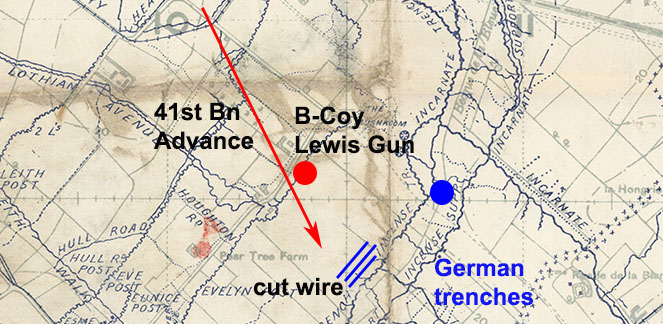 |
Section of the Bois-Grenier Trench Map 1/10000 showing the German trenches in blue. A blue dot marks the section of trench Henry had to harass with his Lewis Gun. He was located at the red dot. The section of barbed wire cut by mortar fire is marked with blue lines. The direction of advance by the raiding party is shown by the red arrow. The communications cables were laid across Mushroom Farm (where the label "B-Coy" is written. You can tell how close they all were given that the squares were 500 yards across. Henry was 700 yards from his target. In earlier trench maps the German trenches were shown in red and British in blue. That was reversed by 1917. |
Henry was buried at Bonjean Military Cemetery at Armentieres, France.
In Australia his parents placed a notice in the paper in memory of their son the following year. It finished with the words "A hero who played his part". Every year until her own death in 1939, his mother would put the same words in a memorial notice to mark the anniversary of his death. His best mate Henry Joseph Brown put a notice in as well, and did this annually until into the 1950s. As the family were keen church-goers, their Congregational Church at Vulture Street Brisbane (next to the Blind Dance Hall) made an honour roll for the parishioners who enlisted. Among the names was that of Henry Wriggles. Major H. R. Carter, late 2IC for the 15th Battalion said "Sweet and glorious is it to die for one's country" (paraphrasing a Latin poet). The board was unveiled on 9th April 1919. In 1935 Mrs Wriggles paid for three stained glass windows in memory of Henry and her other children. The church was sold in 1975 and is now the St Nicholas Free Serbian Orthodox Church.
 |
Australian War Memorial Roll of Honour October 2018 (J Hawker) |
Henry (Harry) George Wright
 |
 |
 |
|---|---|---|
Flowers near Harry Wright's plaque. |
Tree 39 was originally a flame tree but has since died and not replaced. |
Henry George Wright who was born at Nambour, Queensland, on 29 May 1891 to Leonard Wright and Martha Theodora Wright (nee Taylor). He had eleven brothers and sisters: Daisy Maud (b1884), Lizzie Alice (b1886), Leonard Frederick (b1888), Harriet (b1890), Ethel (b1893), Edward (b1895), Clifford West (b1899), Mabel Grace (b1902), Harriet (b1905) and Edna Hayward (b1907).
Their father Leonard was born in Sevenoaks, Kent and emigrated to Australia on the Earl Dalhousie arriving Brisbane in February 1881, aged 17. Their mother, Martha Theodora Taylor, was born in Cheltenham, Gloucestershire and emigrated aboard the Earl Dalhousie at the age of 19. Leonard and Martha married on 15 December 1883 and set up home in Alice Street, Coorparoo, Brisbane.
Henry enlisted at Brisbane on 3 August 1915 at the age of 24 years and was placed with the 11th Reinforcements of 9th Battalion and given the Regimental No. 3528. He embarked at Brisbane on 21 October 1915, aboard HMAT A48 Seang Bee, bound for Egypt. On 29 February 1916 at Zeiton, a suburb of Cairo, Henry was transferred to the 49th Battalion and undertook training at the Tel-el-Kebir camp 100km NE of Cairo.
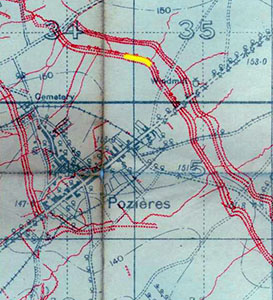
On 5 June 1916, he travelled to France with the 49th Battalion and by the 21st the battalion was at the western front. They continued training for their next 'stunt' which was to be at Pozieres. From the 7th to the 13th August they had shifted to the Tara Hill trenches about 3km NE of Albert where they experienced heavy shelling while trying to repair the damaged ones. On the 13th they left Tara Hill and travelled another 3km NE for Pozieres and entered the front line at 7am to relieve the 14th Battalion. The trenches were bad because of the heavy shelling, so the men began deepening them further.
On the morning of the 14th June at 6am B-Coy replaced C-Coy in the front line. It was during this time that Henry was shot in the head. He was taken to the 13th Field Ambulance with a penetrating gunshot wound to the head and died that same day at the 3rd Casualty Clearing Station at Gezaincourt, about 28 km north of Amiens. Mrs Wright wrote to the army asking if he died quickly or in pain. The Red Cross replied that they were unable to say other than it was a penetrating scalp wound to the brain. One would have expected him to be unconscious and not to wake.
On the trench map opposite I have drawn a yellow line at the location where Henry died. It is a section of the front line trench they were manning.
Henry was buried in the Puchevillers British Cemetery, some 19 km north-east of Amiens. It would have been a great relief for the parents to know that he had been buried on consecrated ground and given prayers by chaplain Rev. A. S. Broughton.
 |
Australian War Memorial Roll of Honour October 2018 (J Hawker) |
CWA Memorial - Thomas Markey
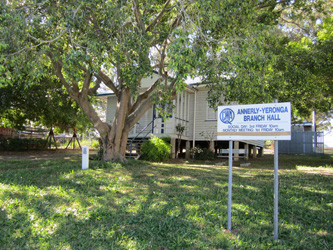 |
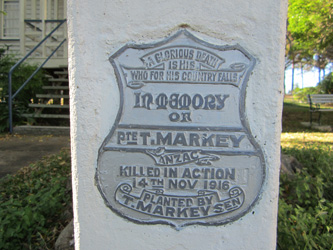 |
|---|---|
This memorial to Pte Thomas Markey was erected by his father Thomas Markey Snr, on the School Road side of the park, now outside the Country Womens Association Hall as can be seen in the leftmost photo. |
|
Pt Thomas Markey (Reg. No. 1713, 25th Bn) was killed in action on 14 November 1916 at Bapaume, France, and buried at the Warlencourt New British Cemetery. He was 36 years old, born in Ireland, and had already suffered gunshot wounds a few months earlier. Markey enlisted in Brisbane and it would seem logical that he be honoured along with the other war dead in Honour Avenue. It would seem that address at the time of enlistment was Carl Street, Thompson Estate, South Brisbane which would entitle him to be included with the Honour Avenue names. However, Carl Street is sometimes considered to be part of Wooloongabba and outside of Stephens Shire, this disqualifying him from the memorial. His father had a postal address of Ipswich Rd Annerley but there was much confusion about who was his next of kin.
Ultimately he was rejected for inclusion in the Honour Avenue memorial and instead relegated to a separate position along School Rd (still in Yeronga Memorial Park). His brother John "Jack" Markey (No. 2214a, 3rd Bde Trench Mortar Bty) died in hospital in France of trench nephritis - an illness that is caused by cold and damp conditions in trenches (it was a serious problem for the Allies, leading to 35 000 casualties in the British and 2000 in the American forces and hundreds of deaths - including Jack). Jack didn't enrol in the army while in the Stevens Shire so missed out on even a School Road memorial plaque.
THE REST OF THE TREES
Additional trees were planted after 1919 with the expectation of more lives being lost. But such was not the case for Stephens Shire. The trees below are between the last named tree (Ketteringham No. 97) and the end of the bitumen road near the Cenotaph. They are mostly weeping figs. Odd-numbered trees are on the Villa Steet side, whereas the even-numbered trees are on the School Road side of Honour Avenue. Go to trees to see a full listing and photos of all the trees.
.jpg) |
.jpg) |
.jpg) |
| Tree 98 | Tree 101 | Tree 101 again |
.jpg) |
.jpg) |
.jpg) |
| Tree 109 | Tree 110 | Tree 113 |
.jpg) |
.jpg) |
.jpg) |
| Tree 114 | Tree 117 | Tree 118 |
.jpg) |
.jpg) |
.jpg) |
| Tree 121 | Tree 124 | Tree 125 |
.jpg) |
.jpg) |
.jpg) |
| Tree 126 | Tree 129 | Tree 130 |
ANZAC DAY 2012
Anzac Day - 25 April - is probably Australia's most important national occasion. It marks the anniversary of the first major military action fought by Australian and New Zealand forces during the First World War.
The Anzac Day Memorial Service in Yeronga Memorial Park, held on Wednesday 25th April 2012, was organised by the Stephens Sub-Branch of the Returned Services League. It included ex-servicemen from WW2, Korea, Malaysia, Vietnam and other conflicts and their relatives, including relatives of WW1 soldiers. Also present were contingents from the 219 Squadron Air Training Corps (flag bearers), Cadets, Scouts, Girl Guides, students from local schools and the 2nd Division Church Brigade. Jim Clarkson from the Stephens Sub-Branch was Ceremonial Co-ordinator, and Parade Marshals were Lewis Dickson and Kenneth Smith. There were also a number of jeeps on display, supplied by the Military Jeep Club of Brisbane. Photos by Richard Walding except where marked YSHS which were provided by Yeronga State High School.
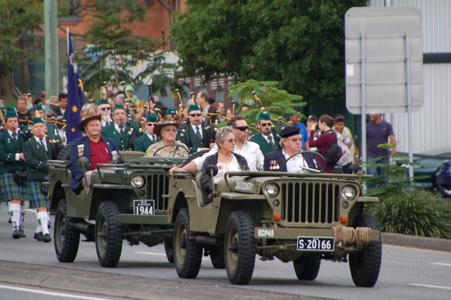 |
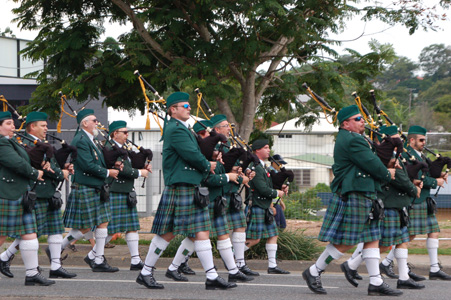 |
The parade began at the Stephens RSL at Annerley and processed along Ipswich Road to Yeronga Memorial Park. Jeeps provided by The Military Jeep Club of Brisbane. (YSHS) |
The Queensland Irish Pipe Band lead the way. (YSHS) |
 |
The Queensland Irish Pipe Band generously gave their time to perform at the service. (YSHS) |
 |
| Each year at the Cenotaph in Yeronga Memorial Park, the ceremony follows a pattern that is familiar to generations of Australians. The service began at 7.30 am. The program included an introduction by the chairman John Strachan OAM, President of the Stephens Sub-Branch, followed by hymns, prayers by Rev. Ian Mundy, an address by Group Captain Chris McHugh, laying of wreaths, a recitation, the Last Post, two minutes silence, the Reveille, the national anthem, a benediction by Rev. Mundy and closed with an address of appreciation by the Chairman John Strachan. The service concluded at 8.45 am. |
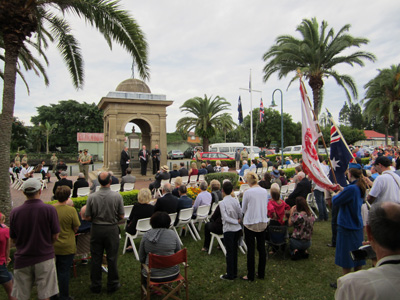 |
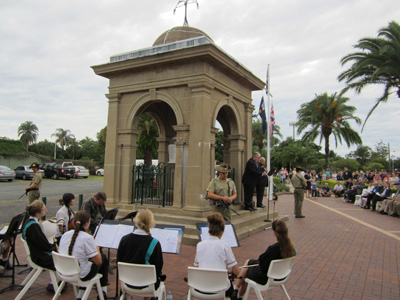 |
| Devotionals were provided by Reverend Ian A. Mundy, Associate Chaplain, Anglican Church Grammar School. | The guest speaker was Mr Chris McHugh CSC, CEO of the RSL Queensland Branch and former RAAF pilot. Group Captain McHugh was awarded a Commendation for Distinguished Service in the Queen's Birthday Honours for distinguished service in Iraq. |
 |
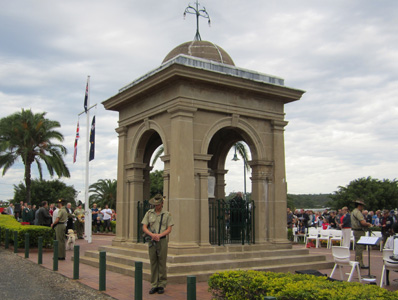 |
| The Yeronga State High School Orchestra provided the music for the singing of the hymns - which included O God, Our Help in Ages Past, Nearer my God to Thee, Abide with me, and Onward Christian Soldiers. | The cenotaph provided the focus for the memorial service. |
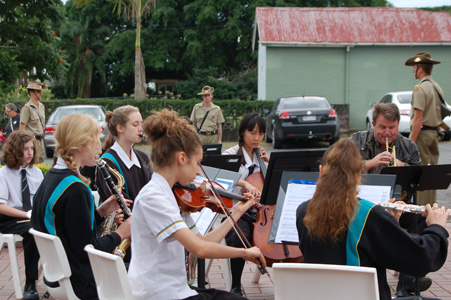 |
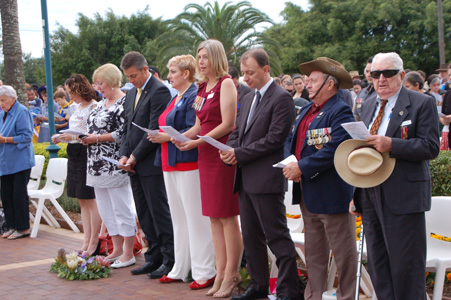 |
The Yeronga State High School Orchestra. (YSHS) |
Invited guests. (YSHS) |
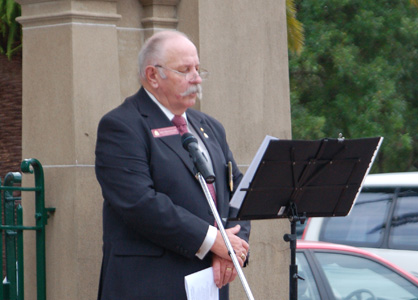 |
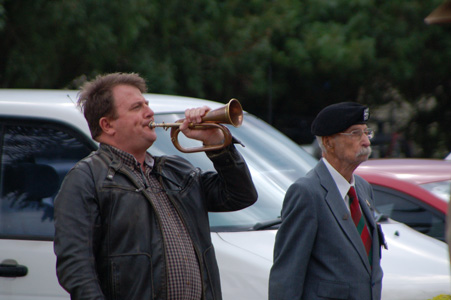 |
John Strachan, President of the Stephens Sub-Branch, reads the "Ode of Remembrance" - an ode taken from Laurence Binyon's poem "For the Fallen". The line "Lest we forget" is added to the end of the ode, which is repeated in response by those listening. (YSHS) |
After the recitation of the "Ode of Remembrance", the conductor of the Yeronga State High School Orchestra - Mr Phil Ryan - played of the Last Post . (YSHS) |
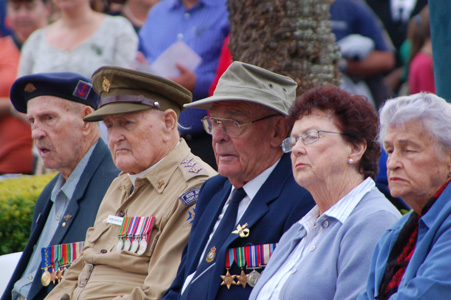 |
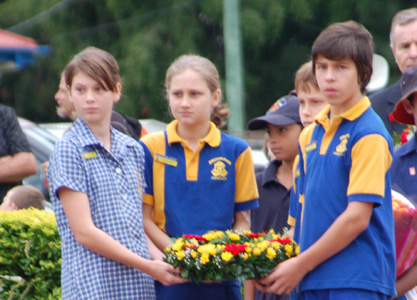 |
Invited guests. (YSHS) |
Students from Junction Park State School. (YSHS) |
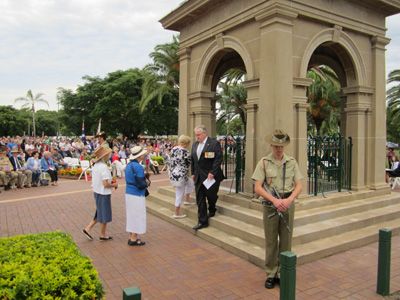 |
 |
| Guest speaker Mr Chris McHugh departs the cenotaph after laying a wreath. | The Queensland Irish Pipe Band at the service. |
 |
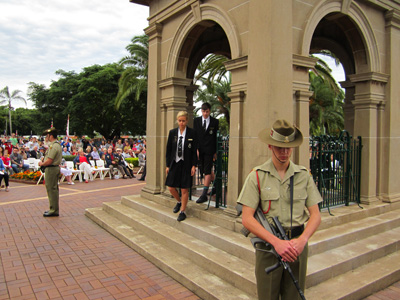 |
| Representatives from Yeronga State High School approach the cenotaph with their wreath. Yeronga High has participated in Anzac services in the park since the school's inception in 1961. | The Catafalque Party was provided by the 11th Close Heath Coy, Gallipoli Barracks, Enoggera, Brisbane. It is the role of the Catafalque Party to mount a guard over the Catafalque (in this case the raised platform of the Cenotaph). The party consists of four sentries, a waiting member in reserve and a commander. |
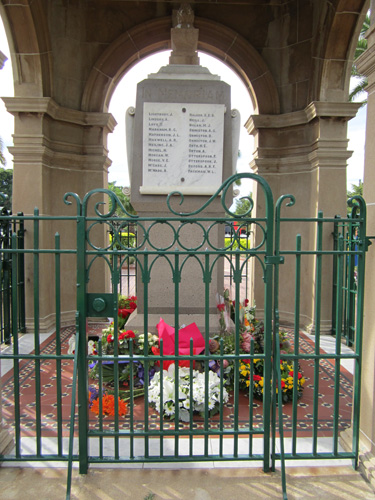 |
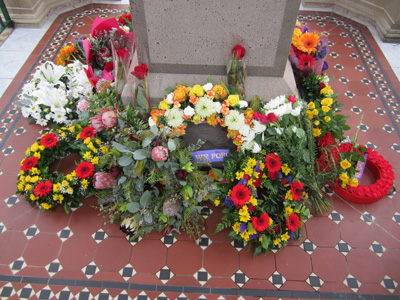 |
 |
| Wreaths were placed inside the cenotaph. | The red wreath to the front left was laid by students from Yeronga State School. |
 |
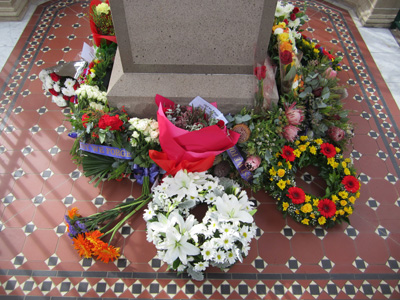 |
| Soldiers remembered by relatives included Alfred Russell, Harold Stanhope, William Love, Cedric Sterling, Mervyn Daniell and the three Ormiston Brothers - David, Andrew and John. | The red and yellow floral wreath on the right was laid by the Captains of Yeronga State High School. |
 |
Students from Yeronga State High School after the Service. (YSHS) |
REMEMBRANCE DAY 2012
 |
Remembrance Day marks the anniversary of the armistice which ended the First World War (1914 -18). Each year Australians observe one minute silence at 11 am on 11th November, in memory of those who died or suffered in all wars and armed conflicts. As in past years, RSL Branches throughout Australia conduct these services. At Yeronga Memorial Park, the Stephens Sub-branch of the RSL conducted the service.
 |
Ninety-seven crosses were planted in the lawn for Remembrance Day 2012. Each cross marks one of the Stephens Shire fallen soldiers. |
After a welcome by the President of the Stephens Sub-Branch of the RSL, John Strachan OAM, Rev. Ian Mundy gave his Devotional.
DEVOTIONAL I read this true story in the reminiscences of an elderly Englishman, who was a schoolboy in an all-boys school, during the Second World War. The class all loved and admired the history teacher, who was giving a lesson about the Battle Of Waterloo. He described how the Duke of Wellington had given the famous order, 'up, guards, and at 'em', and the British troops, having spent all day on the defensive, advanced on the French, driving them into the hands of the Prussians, who'd arrived on the battle-field just at that moment. 'Hurrah,' shouted one of the exited schoolboys. 'Who was that?' asked the teacher. It was the first time they had ever seen him angry. The culprit owned up, but the teacher waved to him to sit down, with an apology. When he had recovered his composure, the teacher explained: war, in his opinion is created by ruthless politicians and/or heads of state. The armed services are the sanitary people sent in to clear up the mess. The teacher hoped that the current war, which he called 'this lunacy', would be over before his pupils became involved and were turned into willing cannon fodder by government propaganda. Doubtless some of you will disagree with what the teacher said. But listen to how the teacher arrived at that position. He pointed to a desk in the second row: 'today we were told of the death in action of the lad who used to sit in that desk,' he said, 'he was a lad of great promise, and now he's been obliterated.' The teacher then pointed to an empty place, reminding them that it had belonged to a boy who had been a brilliant athlete, who had been killed by shrapnel from a bomb while acting as a courier just behind the front lines. What a waste, he said, and the children were astonished to see tears trickling down their teacher's face. So that's the extreme anti-war position to which that teacher had been driven. As I said, you may not agree with him, but I hope you can sympathise with how he was driven to it. The opposite are those who hunger for battle. They probably call themselves patriots, yet those who oppose them are not unpatriotic. Probably most of us would claim to be somewhere in between. The man who described this, in his memoirs, continued that he had never forgotten that lesson. His teacher never taught him to hate, because hatred destroys reason and warps the soul. He said he weeps whenever he hears the Remembrance Day words, 'they shall grow not old…' he wonders what the slain might have achieved if they had been spared to live long and productive lives? What might the handicapped and maimed have accomplished if they had remained uninjured? In his opinion excessive nationalism kills; xenophobia murders; bigotry slaughters; racialism massacres; chauvinism represses. 'Blessed are the peacemakers' was his rule of life. That's all I want to quote from this elderly writer. But my hope is that on each and every Remembrance Day, those who agree with him, and those who disagree, can meet and weep together at the terrible side-effects of war. Whether you are a patriotic pacifist or a patriotic militarist or somewhere in between, there's no point in hating those who take the opposite opinion, because that merely perpetuates the tensions that create wars. Jesus calls us to reconciliation. Today, let's all honour those who died as a result of war; pray for the wounded and bereaved; honour our veterans remembering that some gave all and all gave some; and support those who sincerely struggle to bring peace and justice to al the hurting peoples and places on the earth. Amen. |
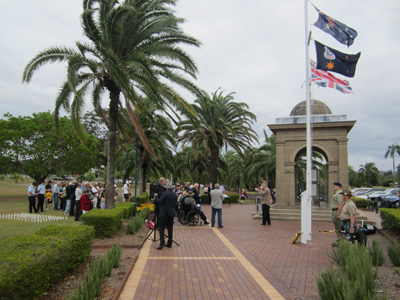 |
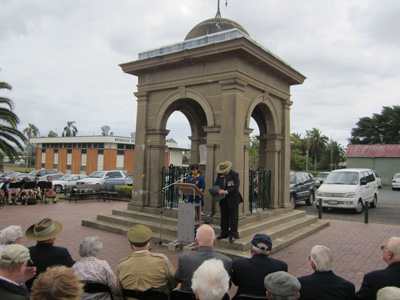 |
Singing Abide with Me.The Stephens RSL Sub-Branch placed a plaque to the unknown soldier, which is set at the base of the flagpole. |
A Year 7 student from Junction Park State School reads her bursary-winning essay. |
 |
 |
The 97 crosses. |
Rev. Ian Mundy gave the Benediction (see below). |
BENEDICTION Go forth into the world in peace; be of good courage; hold fast to that which is good; render to no one evil for evil; strengthen the faint hearted; support the weak; help the afflicted; give honour to all; love and serve your country. And the blessing of God almighty, the Father, the Son and the Holy Spirit, be upon you and remain with you always. Amen. |
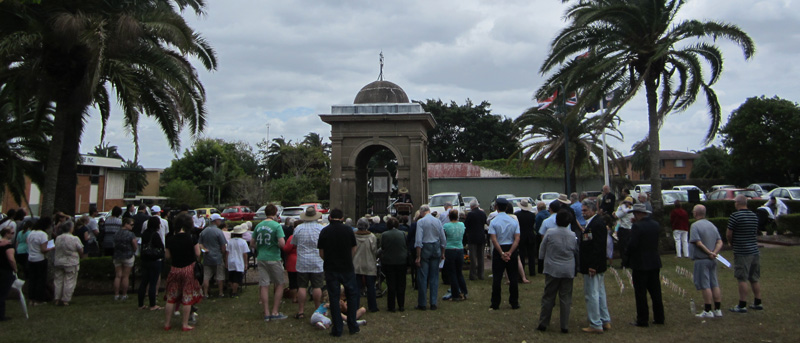 |
The ceremony was conducted by Stephens RSL Sub-branch President John Strachan OAM, shown here making his address. After the Ode came the playing of The Last Post (played by Mr Phil Ryan) and two minutes silence, followed by the Rouse and laying of wreaths and poppies. Hymns Abide with Me and O God Our Help in Ages Past, and the Royal and National Anthems were sung, accompanied by the Yeronga State High School Concert Band (conductor Mr Phil Ryan). |
RSL PRESENTATION
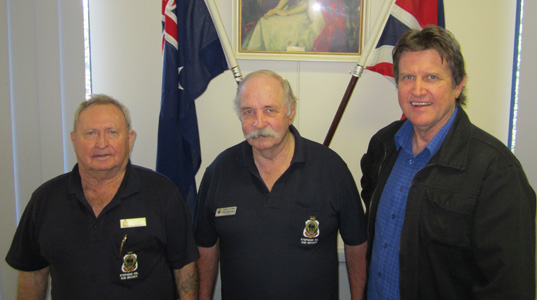 |
Dr Richard Walding (right) was invited to give a presentation about his research to the Stephens Sub-branch of the RSL at their monthly meeting on 12 May 2012. He is shown here with Ron Viles (Secretary, left) and John Strachan (President, centre). |
My thanks to Jim Hawker (Secretary of the Stephens RSL Sub-Branch) for his assistance.
If you have any feedback on this webpage, including photos or details of any soldiers mentioned, please email me -
Dr Richard Walding - at waldingr49@yahoo.com.au
See my Manly War Memorial web page.


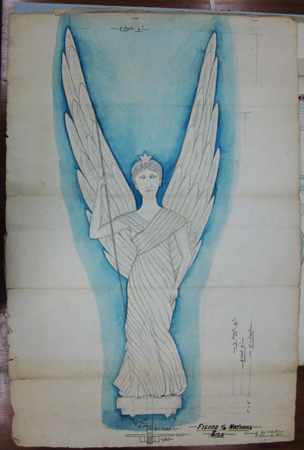
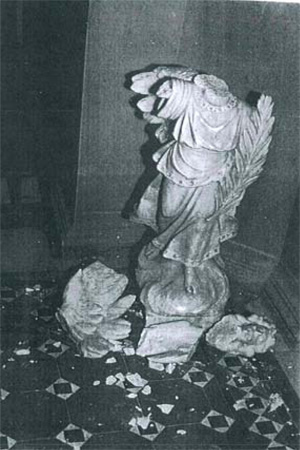
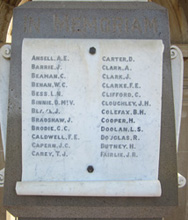


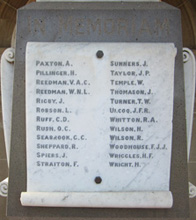

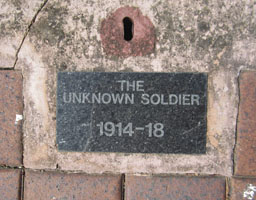

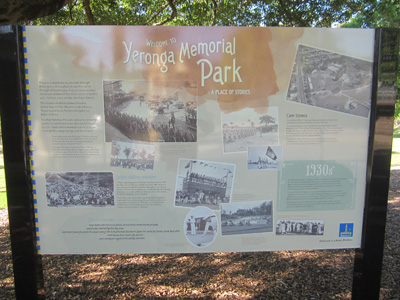
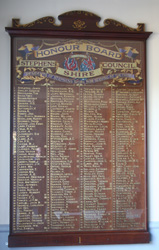
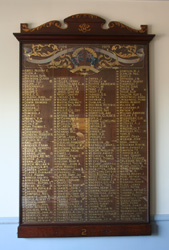
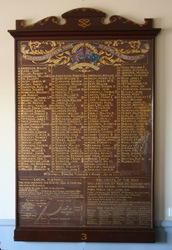
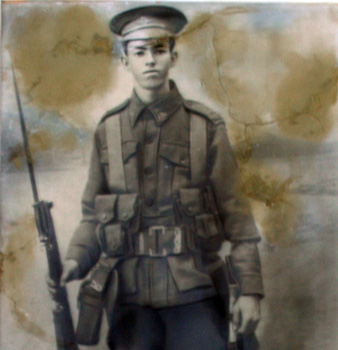
.jpg)

.jpg)

